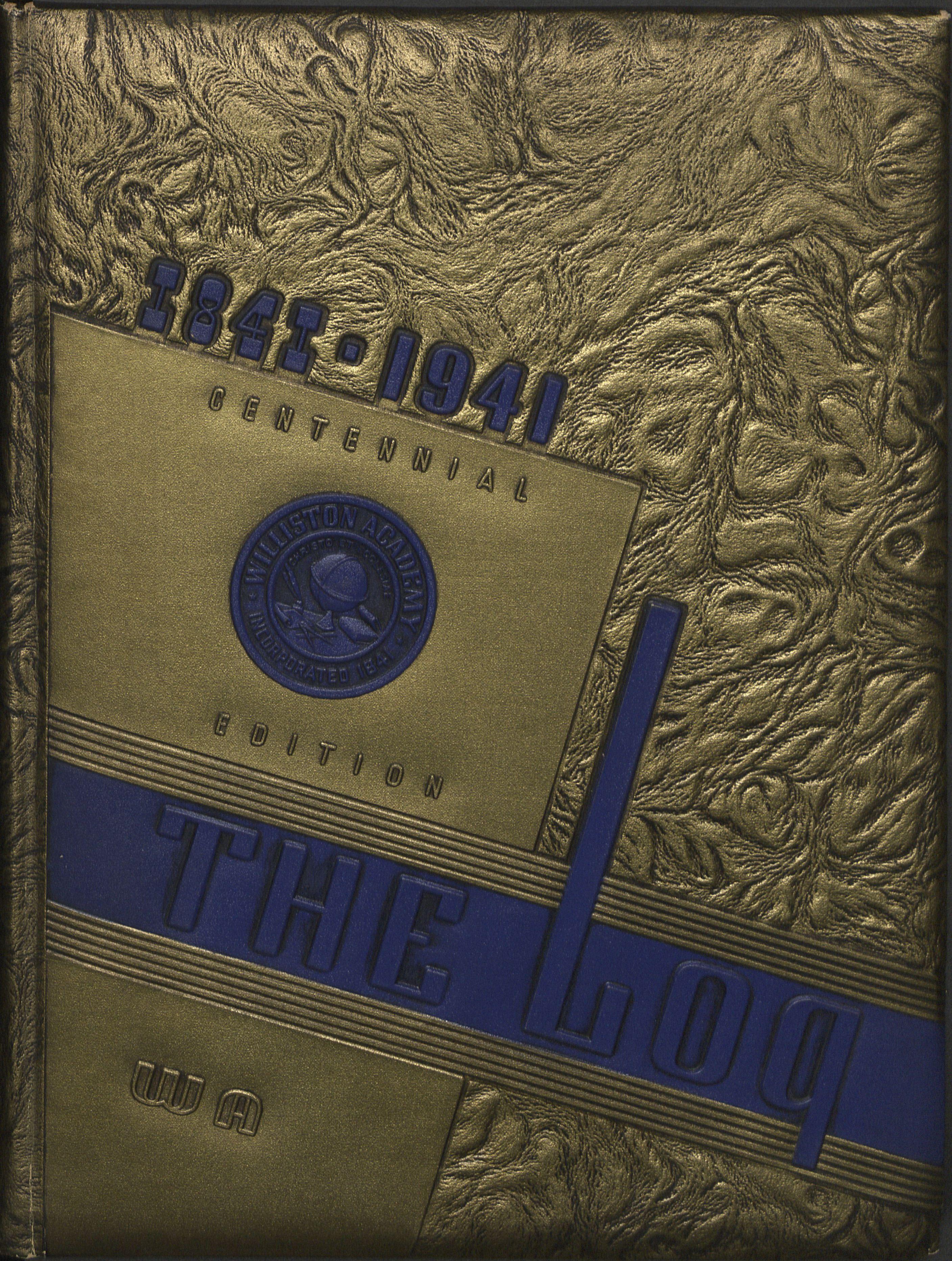
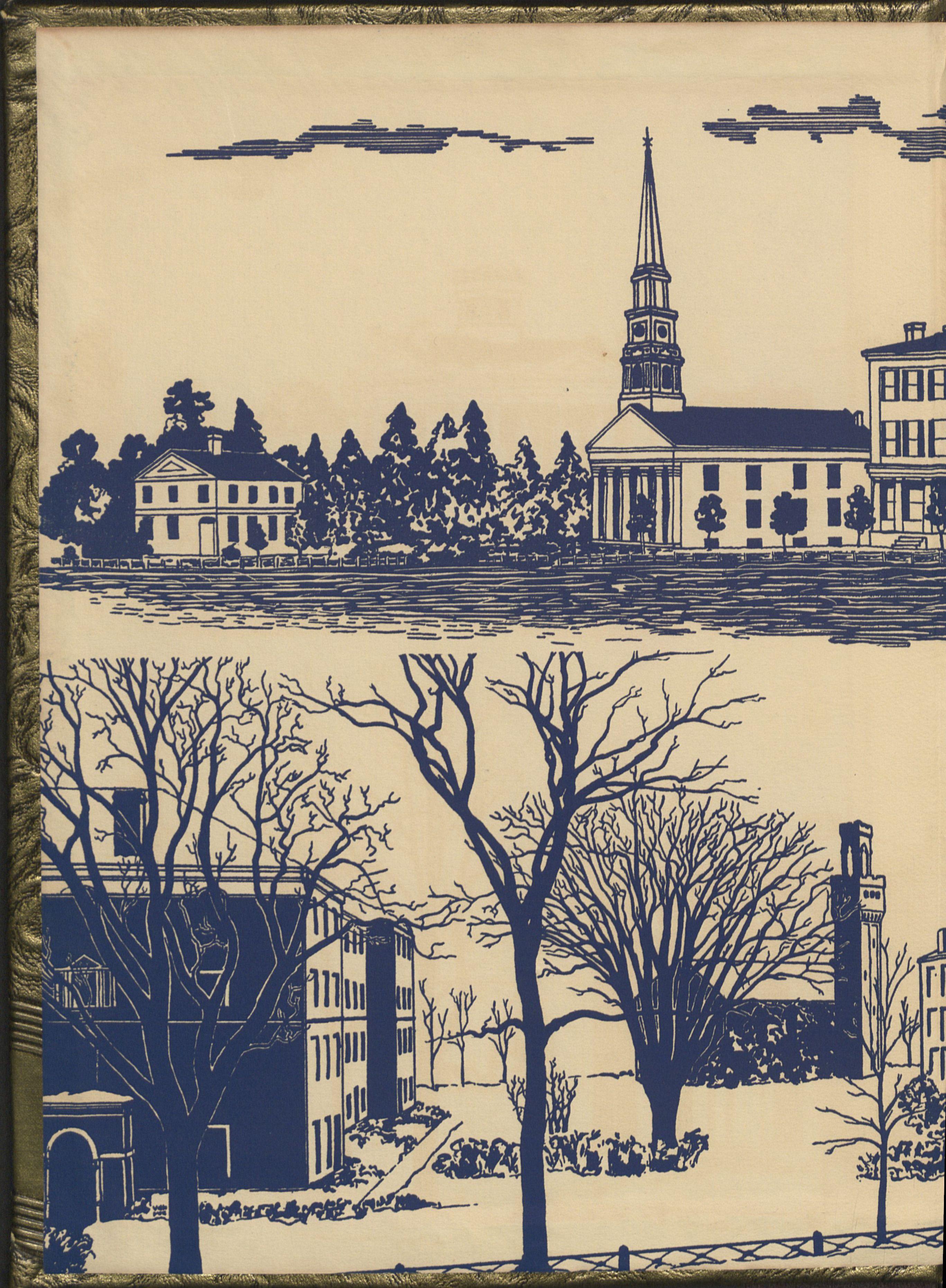
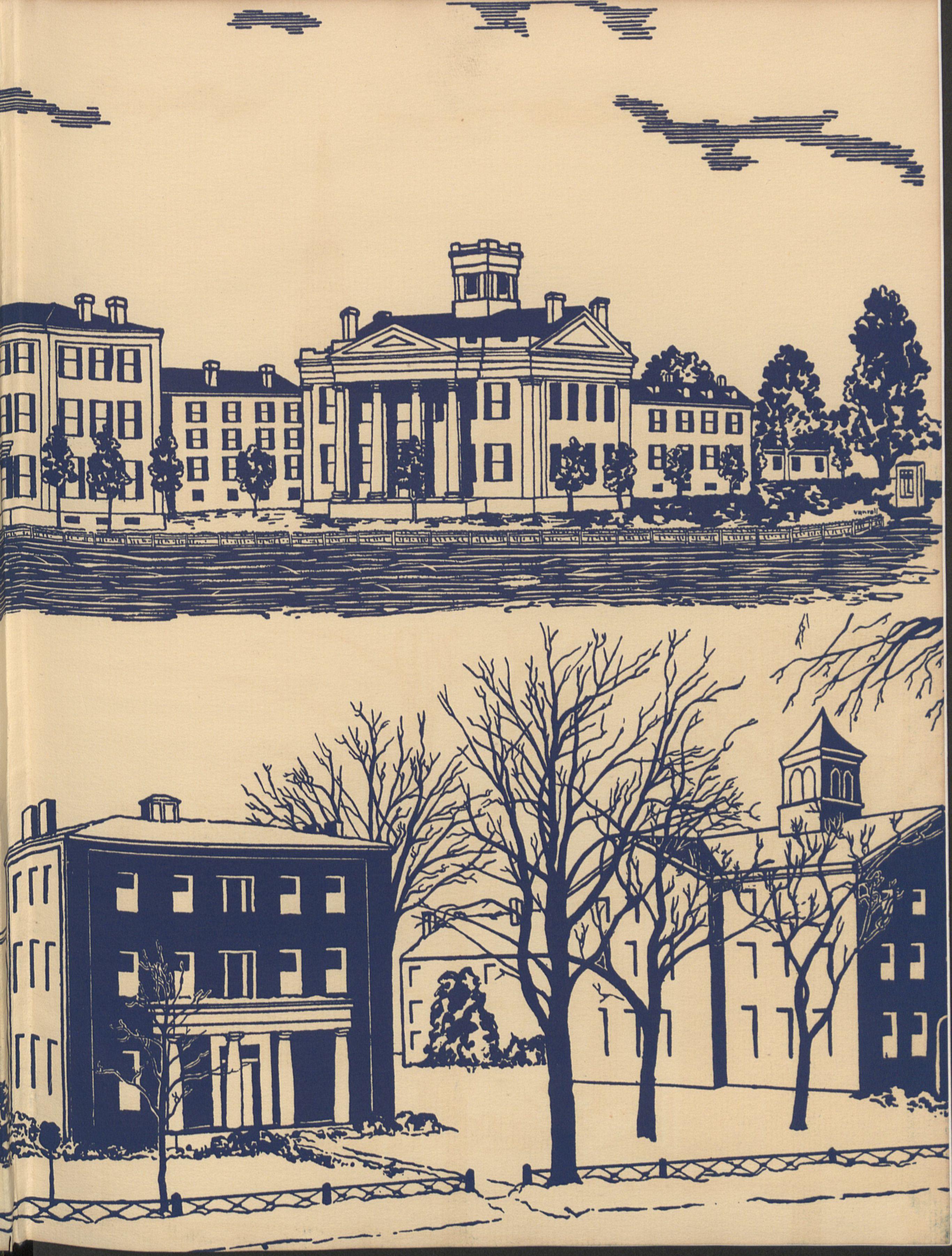
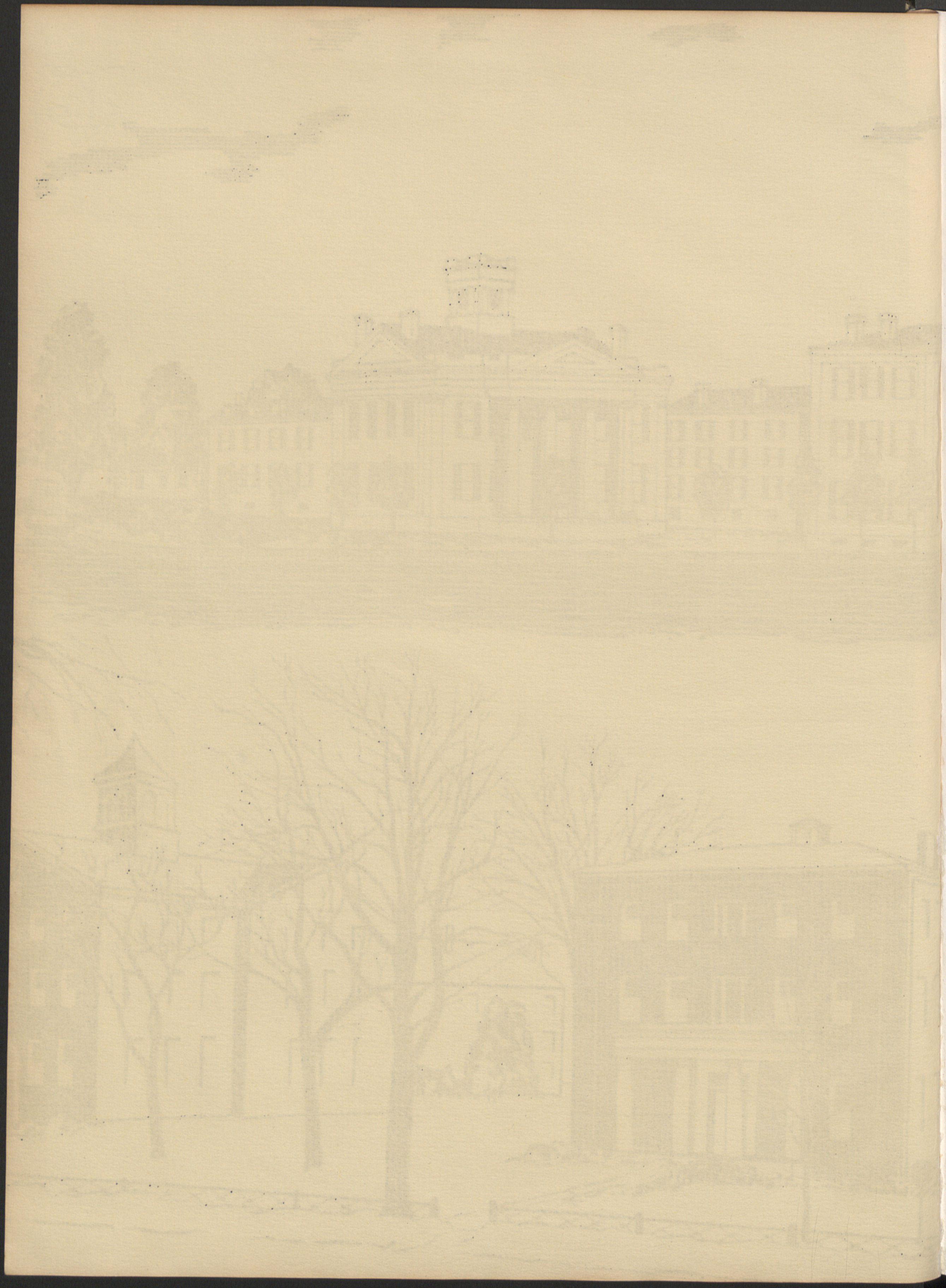
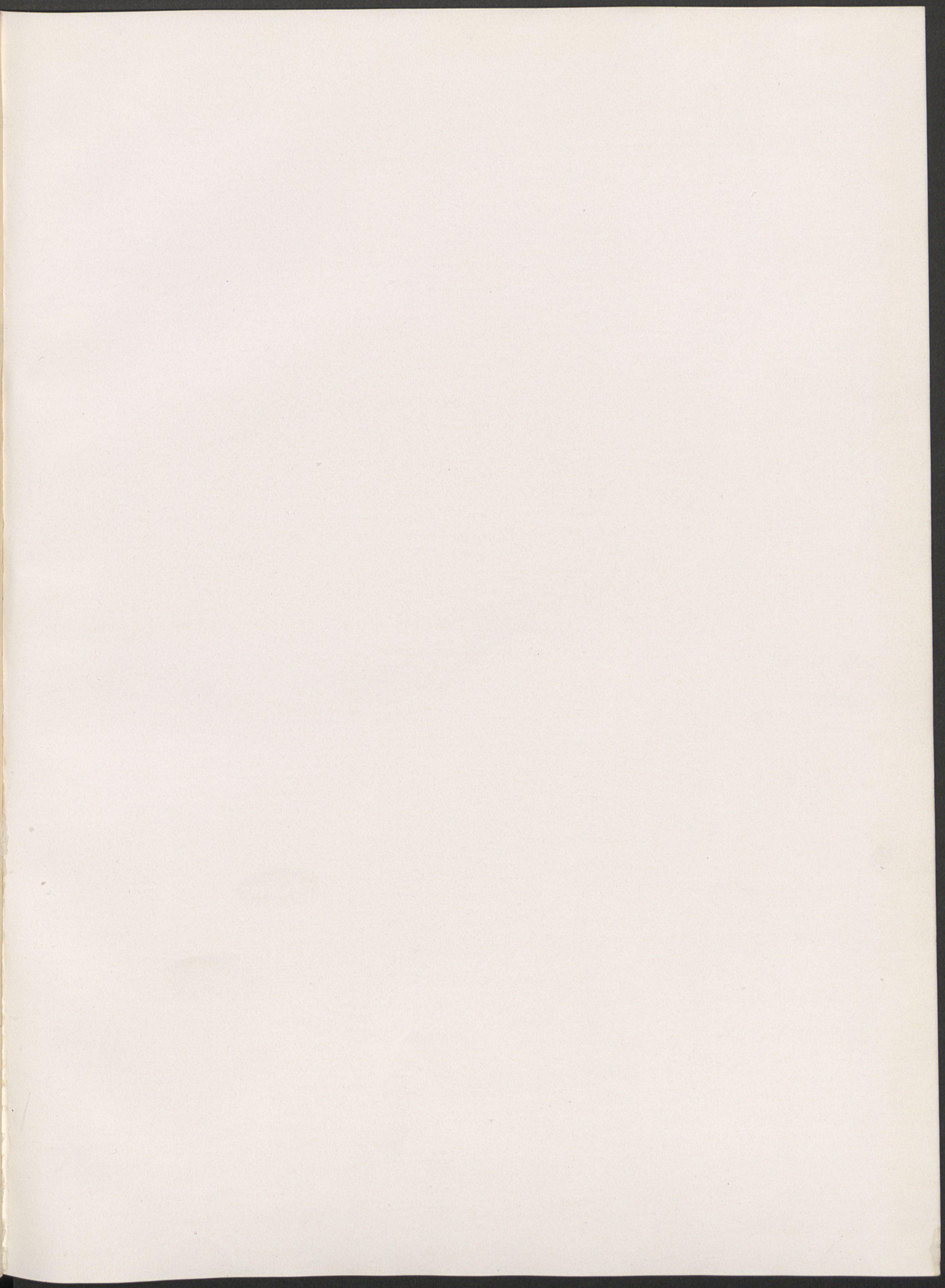
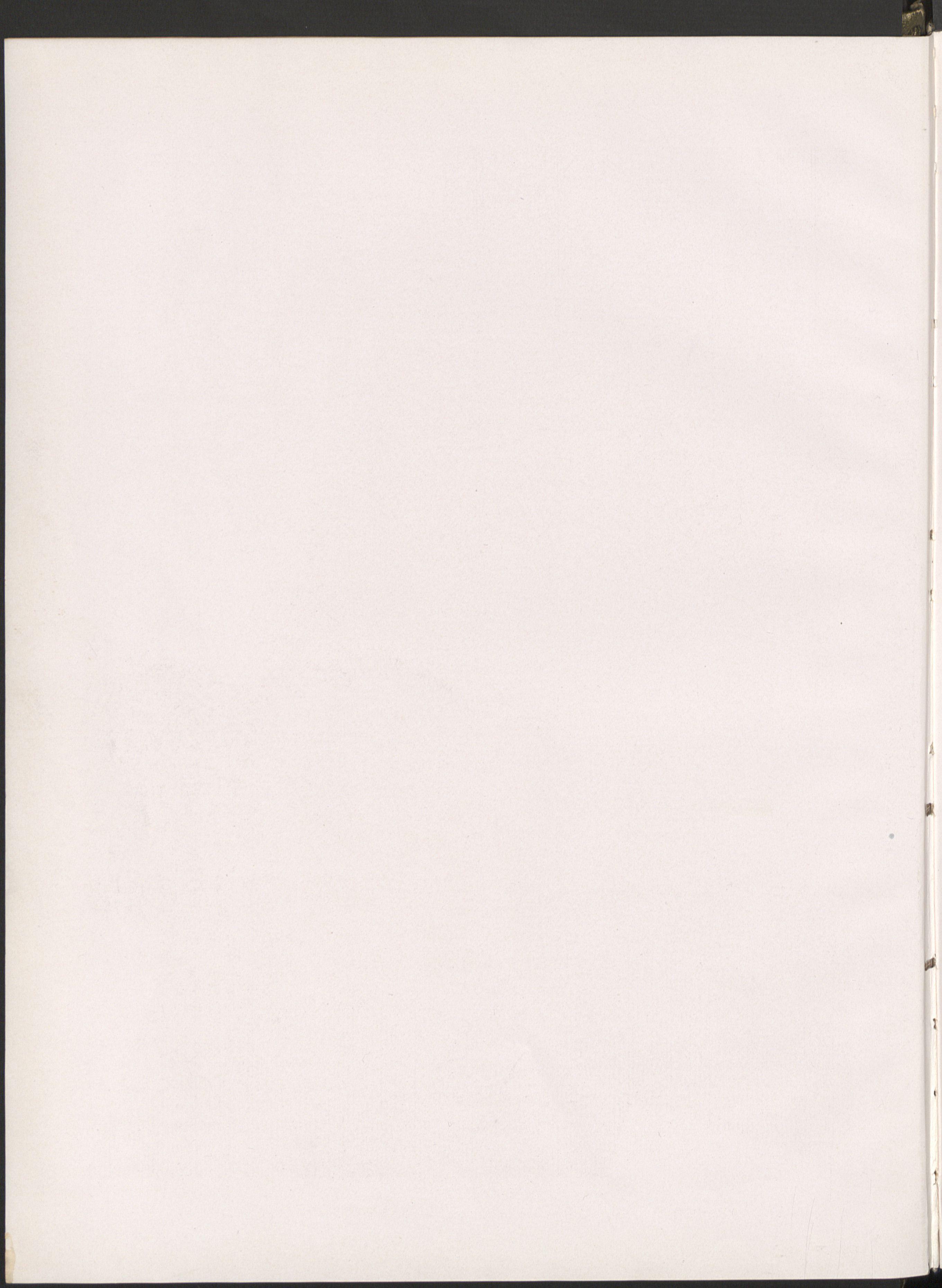
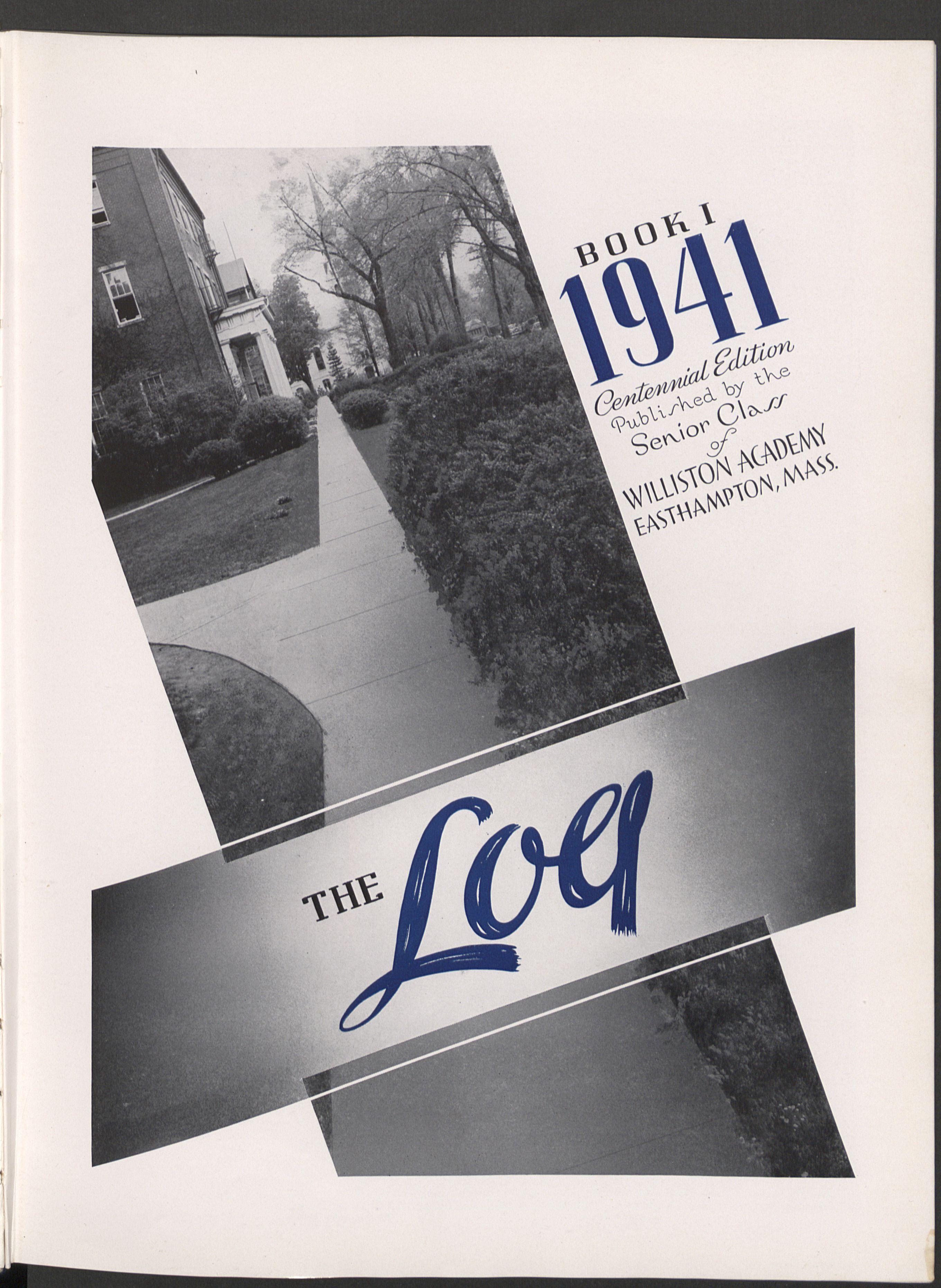
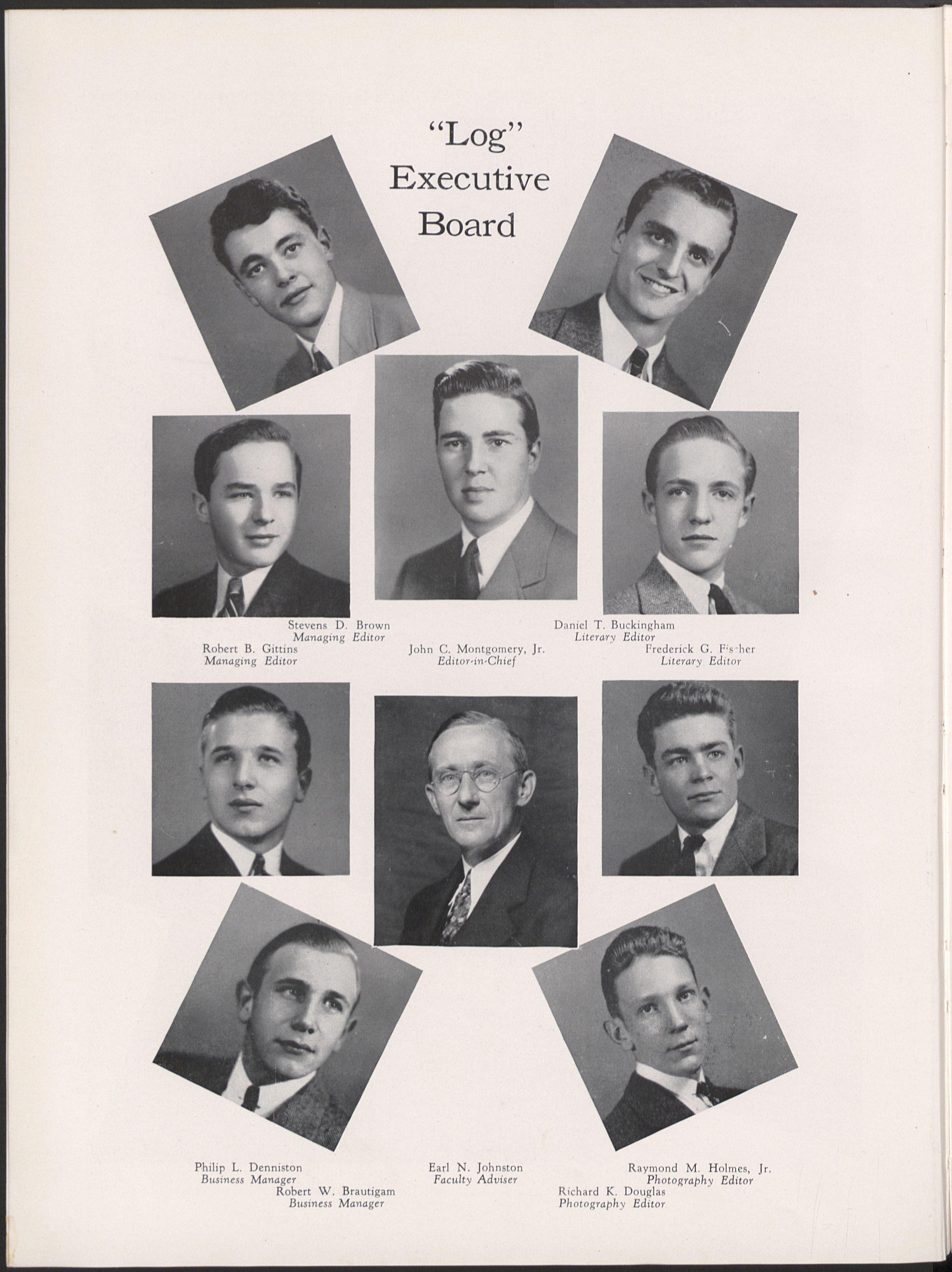









B. Cronmiller, Art Editor
M. Barnard
C. Curran
B. Hopkins
E. Johnston
K. Kingsbury
S. MacMillan
H. Mason
W. McClelland
J. Simpson
E. Crowell
L. Collins
R. Finsthwait
J. MacNaughton
W. McCarthy
H. Peden

J. Spaulding
J. Teal!
S. Young
A. Bosworth
D. Piper
W. Rosati
H. Smith
W.Tyre11
W. Van Cott
G. Bernhard
A. Denslow
D. Ferree
E. Georgi
C. Harris
J. Lee
J. Williams

The year 1941 holds a great significance in the life of Williston Academy, for it is at this time that we are cele, brating the centennial of the school. Thus, it is no more than proper that the "Log," our yearbook, should attempt to play its part in the program by portraying in brief form the history of one hundred years at Williston.
Let us, then, in this edition delve first into that part of the book which we shall call Book I, dealing intimately with the progress of the scholastic and athletic achievements as well as many interesting sidelights in the progress of Williston since 1841.
Since the theme of our book is Centennial, throughout its pages may be found things equally suggestive of both the old and new Williston and equally interesting to both alumni and students.
It is the sincere hope of the "Log" board that our efforts may be well received, and that because of our work in the production of our book, Williston may be drawn nearer to you as the years roll on and your memories of old "Sammy's" campus and life become dulled.

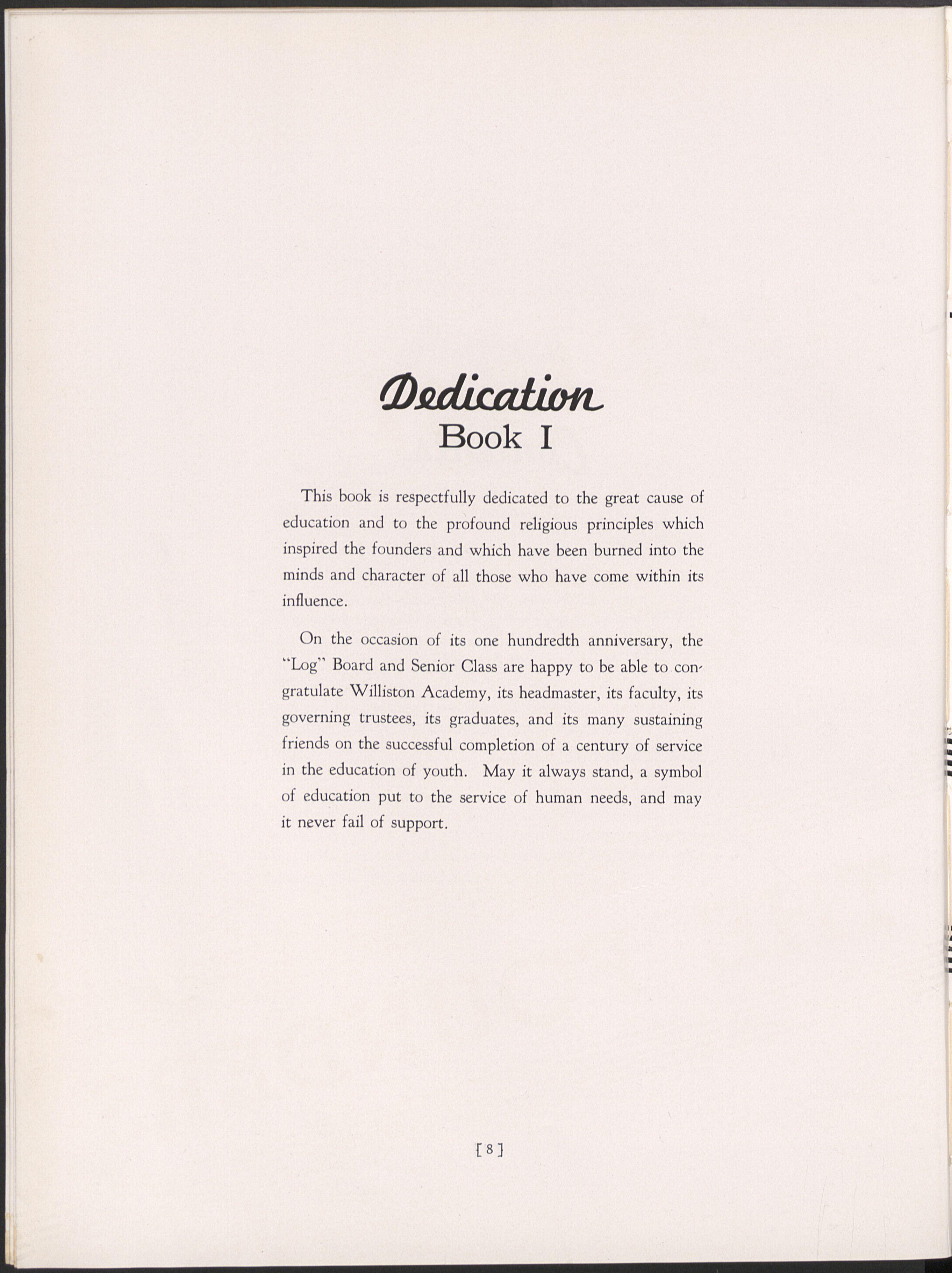
This book is respectfully dedicated to the great cause of education and to the profound religious principles which inspired the founders and which have been burned into the minds and character of all those who have come within its influence.
On the occasion of its one hundredth anniversary, the "Log" Board and Senior Class are happy to be able to cone gratulate Williston Academy, its headmaster, its faculty, its governing trustees, its graduates, and its many sustaining friends on the successful completion of a century of service in the education of youth. May it always stand, a symbol of education put to the service of human needs, and may it never fail of support.

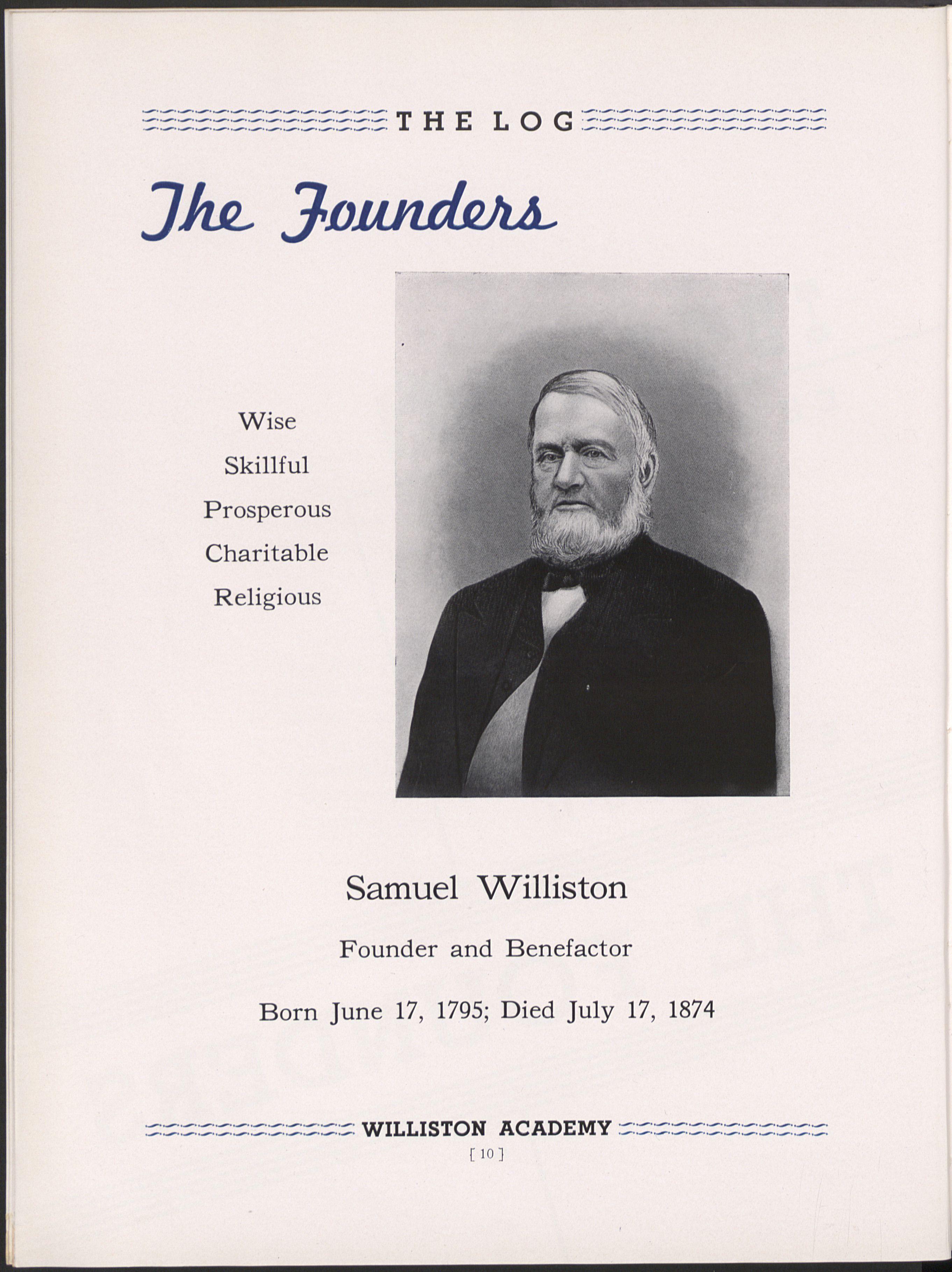
Born
Founder


31 Park Street, Easthampton
Samuel Williston (1795-1874)
Samuel Williston was born in Easthampton, the son of Rev. Payson Williston, who was the son of Rev. Noah Williston, pastor of a church in West Haven, Conn. Although he was the third son, he became the eldest son because of the death of his brothers.
Samuel was one of five children; the others were Joan, Nathan, Sarah, and Maria. At first he went to the public schools, and then his father tutored him for college. During the summer he worked for his father. His public schooling ended at the age of ten. At the age of sixteen he went to visit his sister Maria in Vermont and later attended Westfield Academy for one year.
Hearing about Phillips Academy, his father sent him there at the age of nineteen. Having no money to buy a coach fare, Samuel had to make his way the best he could. His father gave him letters to the preachers on the road and he spent the nights at their homes. He lived with a farmer about a mile from the school. It became very difficult for
1 9 4 1

him to keep up his studies as well as work his way through. Before the end of the year his eyes had failed him, and he had to return home. Thus ended his formal schooling and ended his ambition to become a minister. From this time on he became dependent on others for his learning.
Mr. Williston taught school in Easthampton, Southampton, Northampton, and Springfield. Later on he labored on farms and worked as a clerk in several stores. Still he was not satisfied; but, at the age of twentrtwo, he decided to become a farmer and his father aided him financially and gave him land. He and his father were very close, the relationship being more like that of two brothers.
His father advised him to seek the friendship of Emily Graves who lived in the neighboring town of Williamsburg. He took his father's advice—they were married three years later in 1822. Because Mr. Williston was so poor, there was no elaborate wedding and the wedding trip was Williamsburg to Easthampton. For twentrone years he and his bride lived in the parsonage with his father. The two families lived in perfect harmony all these years.
In the year One 77tomand Eight Hundred and Porty.enr.
AN ACT//revAevv, 7//&147//
Be it *acted by the Senate and Boum of Repreeerstatieee,in Gams,Cowl arianided and by IA. authority of the earner- ./.)///wit.i.• /•!orvm,",/NA‘vo; iffe'Awes Adv0.47 ///, 14i , IhNwov•IdAwot/ %Yd., nvd/rve.o •/4$744., dr," 0094Orraell, .:47X14/0 6/4//1.41,w /;64inveseaw owcow/ V :4 (iviVerli,v, ,vfe,fv",i /.4..444 /vd/•velYwr wirawka,,.0//,:rd //vg•ivirAie/16444.VA: ae4v1 iv. I
4a, >,arewm,tell..4no, itv+ven/e.owilaieriI /A le,Lvar"

Gradually they became more and more in debt. Something had to be done. Samuel decided to sell all his sheep so that he could pay off the mortgage and all his debts. It was his wife, Emily. who started making the cloth-covered buttons. The manufacture of cloth-covered buttons in America began in this Easthampton parsonage. At first, Mrs. Williston was the employer and the employee, the business manager and the office force, but soon the business became so large that her husband joined her. Gradually all the families about the town began to make them also. Then, instead of doing the work herself, she devoted all her time in directing the others. Mr. Williston became the buyer and the salesman. Because the business steadily increased, it was extended for miles around. He later installed machines and built three more mills for the manufacture of cotton yarns. This was at the time of the Civil War. Because he was getting older and could not attend to all the details, this enterprise failed and he lost half of his fortune.
Mr. and Mrs. Williston had four children born to them, but all of them died. Later on they adopted three daughters and a son. They never, however, got over the loss of their own children.
1 9 4 1

Mr. Williston aided both Amherst and Mt. Holyoke Colleges, but he wanted to found a secondary school. He therefore consulted with William S. Tyler, a teacher at Amherst, and decided to form an English College. Because his finances were not too good, he could only spare thirty thousand dollars at the start, but this was increased before the end of the second year. He continually gave money to the school from time to time after this.
Because he was a very religious man, he did not believe that anyone should do work on Sunday. On one of Mr. and Mrs. Williston's trips to Europe a strange incident occurred. On the day that the boat was to sail there was a violent storm. The vessel did not sail as scheduled, but on the Sunday it cleared up. The captain and the crew were anxious to set sail, but Mr. Williston would not go because it was Sunday. Finally, the captain agreed to wait until Monday. The boat reached London a day before all the others which had sailed on Sunday. This little story clearly shows what a man of convict tion Mr. Williston was.
Being an extremely charitable man, Mr. Williston gave over a million dollars to many different organizations. Over half of this amount was given to Williston Academy and Amherst College. He gave both to Protestants and Catholics alike. For many, many years he was a trustee of Amherst and Mt. Holyoke Colleges.
Williston Academy had another founder and her name was Emily Graves Williston. She was the child of a farmer of the town of Williamsburg. Because there were no higher schools for young ladies at that time, her schooling was limited to the public schools of the town. Studying after she was married, however, made her a very cultured woman.
One day Rev. Payson Williston exchanged a service with the pastor of the Williams, burg church. It was at this time that he met Emily Graves and became interested in her for his son Samuel. Mr. Williston became acquainted with her and this friendship ripened into love. After three years of engagement, they were married—she at the age of twentrfive and he at the age of twenty-seven.
Mr. Williston owed the beginning of his fortune to her wisdom and skill, to her ingenuity, to her industry, and to her charity. She was his wise adviser and silent, but not inactive, partner in all his enterprises that were successful. Mrs. Williston was extremely active throughout her life with the duties of a good Christian woman. At the time of her death a Springfield paper printed the notice with the heading, "What one woman can do." Professor William Tyler of Amherst said at the time of her death,"Mrs. Williston was a rare example of inflexible firmness united with singular gentleness and grace; a firmness, based on moral and Christian principle, which nothing could turn aside from what she deemed the path of duty; united with a gentleness, born of Christian love, which is long suffering and kind, which thinketh no evil and seeketh not her own, which beareth, believeth, hopeth, endureth all things."

Pictured above is the old desk which Samuel Williston once used in his factory here in Easthampton, probably soon after the founding of Williston Seminary. A heavy,set affair, with many small drawers and cubbrholes, it serves as a helpful hint as to what type of man the founder was. Although the desk may now look as though it had seen better days, as it probably has, it is still in excellent condition and will probably be in use for many years to come.
When the desk was first located this year, there lingered some doubt in our minds as to its authenticity in regard to Mr. Williston. These doubts have now been entirely dispelled through the finding of a passage in the diary of Granville A.Matthews, whose descendants are now in possession of the desk, from which is quoted:
Entry for Monday, May 21, 1877
Bought the "desk (which Mr. Williston used at the office) with furniture, including chair, of Mrs. W.for $5.00."
Also found has been a receipt dated May 23rd, which says: "Received of G. A. Matthews five dollars ($5.00) loaned him the 21st inst. to pay Mrs. Williston for desk."
(Signed) Mrs. Harriet Leonard.
From all this, then, we gather that Mr. Matthews desired to buy the desk from Mrs. Williston, but found himself financially unable to do so. For this reason, therefore, he borrowed the money and purchased the desk. Thanks to him, we are able to have this desk within reach.
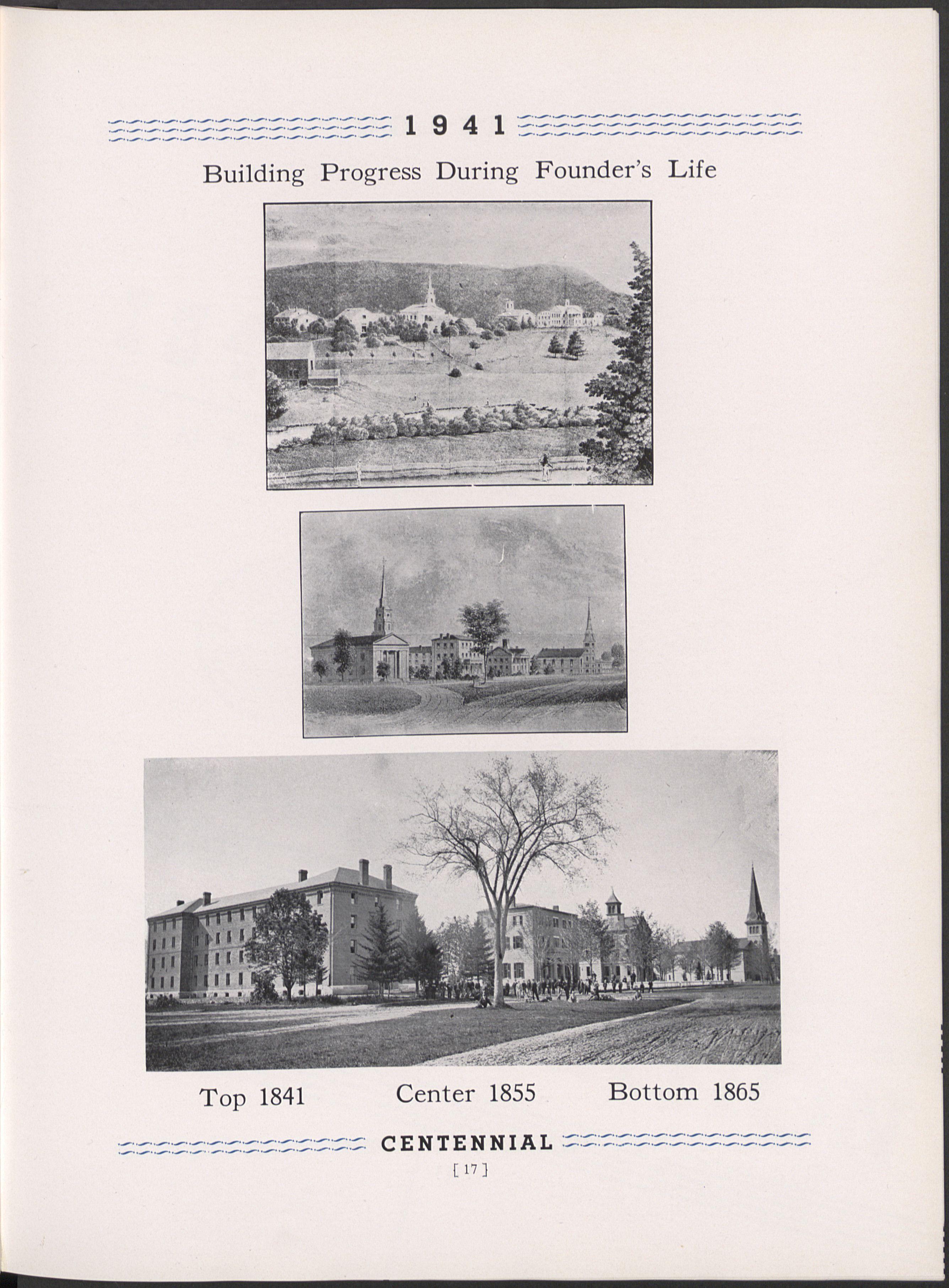
Written for the Semi•Centennial in 1891 by Irving Bruce, Class of 1878
God preserve our Alma Mater, Williston, forevermore; In the sunshine of thy favor, Guard her, keep her, we implore. Crown her still with strength and honor; By thy grace renew her youth; In the light that never faileth Lead her on from truth to truth.
May her foster children ever Loyal service yield to Thee; Minding still her ancient watchword, Christ() et Ecclesiae; That, where'er our warfare lead us, Though the battle bear us down, And we win no wreath of laurel, Hers may be the victor's crown.
Here today upon her altars We present our sacrifice; Though tomorrow widely sundered, Still may this our prayer arise. God preserve our Alma Mater, Williston, forevermore; In the sunshine of thy favor, Guard her, keep her, we implore.

WILLISTON ACADEMY [18)

John P. Williston (Founder's Brother) Trustee 18414871

Familiar with half a century of the history of Williston.
Rev. John H. Bisbee Trustee 1850-1891
Rev. S. G. Buckingham, D.D. Trustee 1850-1898
Rev. Aaron M. Colton Rev. Gordon Hall, D.D. Trustee 1854-1881 Trustee 1855-1879
A. Lyman Williston, '53 Trustee 1873-1915
Trustees have always held one of the most important positions in the running of any institution, and the Williston trustees have been no exception. Their job is a difficult one, for upon their shoulders falls the burden of making the decisions which are so necessary and important to the successful continuance of the school.
At this time, therefore, it is our wish to make the reader a little better acquainted with these trustees and thus we list them in the chronological sequence in which they have been elected:
Hon. Samuel Williston (Founder
Rev. Emerson Davis
Rev. John Mitchell
Rev. William Bement
Luther Wright, M.H.
John P. Williston
Rev. Heman Humphrey
Hon. William Bowdoin
Rev. Mark Hopkins, D.D.
Rev. William S. Tyler, D.D.
Hon. Joel Hayden
Rev. Sumner G. Clapp
Rev. George E. Day
Josiah Clark, M.H.
Rev. George C. Partridge
Rev. David Coggin
Rev. John H. Bisbee
Rev. Noah Porter, D.D.
Rev. Rollins S. Stone
Hon. William Hyde
Rev. Aaron N. Colton
Rev. Wellington H. Tyler
Rev. Gordon Hall, D.D.
Marshall Henshaw, D.D., LL.D.
Rev. Samuel T. Seelye, D.D.
M. Fayette Dickinson, Esq.
Rev. Sol. Lyman
Rev. S. G. Buckingham, D.D.
)Hon. R. B. Hubbard
Rev. Nehemiah Adams, D.D.
Col. Will S. Clark
Hon. Horatio G. Knight
Hon. Edmund Sawyer
Odell G. Webster
James M. Whiton
M. F. Dickinson, Jr.
A. Lyman Williston
Joseph W. Fairbanks, A.M.
Rev. Alexander R. Merriam
John C. Hammond
Prof. Richard H. Mother, D.D
Prof. Tracey Peck
Prof. Judson Smith, D.D.
Prof. Henry M. Tyler, A.M.
Rev. Wm. Gallagher, A.M.
George W. Cable
Dr. Edward Hitchcock
Richard S. Barnes
William F. Whiting
Rev. Charles H. Hamlin
George Hanis, D.D., LL.D. (President of Amherst)
Robert L. Williston
Rev. Joseph H. Sawyer
Prof. John M. Tyler, Ph.D.
Robert P. Clapp, LL.B.
*On present board

Rev. Charles F. Carter, D.D.
Gilbert F. Kennedy, LL.B.
Philip L. Ames, A.B.
Judge William L. Day, LL.B.
*Judge Thomas Swan, LL.B.
*John L. Hall, LL.B.
*Archibald V. Galbraith
*William Pitcher
*Philip L. James
*Edward L. Shaw, LL.B.
*Dean Herbert E. Hawkes, Ph.D.
*Edward E. Whiting
• *Major Thomas J. Hammond (Judge), LL.B.
*Rev. James G. Gilkey, D.D.
*Prof. Julius S. Bixler, Ph.D.
*Wallace R. Lane, LL.B.
*Charles W. Walker
*Carl A. Gray, B.S.
*Ogden D. Miller, Ph.B.
*Herbert Howe, M.A.
*George S. Stevenson, A.M.
*Lauren D. Lyman,'12
*J. H. MacNaughton,'09
*Daniel Mungall, J.D., '06
*F. J. Scribner, B.D.,'05
This article was designed to give the reader an idea of the headmasters of Williston. We shall, therefore, say nothing concerning Samuel Williston, except to mention the fact that he himself was never headmaster, because he did not think himself sufficiently educated.
The first headmaster of Williston was Luther Wright, who was principal from 1841 to 1849. His was, perhaps, the most difficult job of all—that of getting the school started. He graduated from Yale in 1822, and, after teaching in several schools, he was asked by Samuel Williston to become headmaster of his new school. During the eight years of Luther Wright's principalship, seventeen hundred different pupils were enrolled. One-fourth of the total were ladies.
After serving the school for eight years, Mr. Wright resigned and retired at the close of the school year in 1849. He was then fifty-three years old and at the height of his maturity and efficiency. Mr. Wright's self-sacrifice was admirable, but incompletely and inefficiently directed. The majority of the board of trustees were college men and urged,

therefore, higher education, but Mr. Wright welcomed anyone and everyone into the school when practically none expected to go to college. Mr. Wright had developed a better school, but one not essentially different from those already existing.
After Luther Wright, Josiah Clark was headmaster for fourteen years from 1849 to 1863. During this change, the trustees strove to find someone who would further the founder's purpose of making the school an English College. Josiah Clark was born in Leicester in 1814. He graduated from Yale in 1833 and had a master's degree when he came to Williston. He was principal of Westminster Academy, teacher at the University of Maryland, and both associate principal and principal of Leicester Academy before coming to Williston.
Although Mr. Clark held the diploma of a theological seminary and had pursued the full four-year's course in divinity, he did not attempt the role of a preaching principal. He remained a teacher and conducted a class in the study of the Bible on Sunday. Mr. Clark was saturated with the classics and delighted in teaching them. He taught Latin to one group for two hours in the morning, and in the afternoon he taught Greek for two hours to the same group.

MARSHALL HENSHAW
"Josiah Clark was not a maker of text-books. He was himself a living text-book. He did not content himself with giving to his pupils printed directions for procedure; he walked with them through the Paths of knowledge. The boys learned to discriminate by seeing him discriminate, learned to admire by seeing him admire. He won the hearts of all excepting the unresponsive and the incorrigible."
Mr. Clark became convinced that he could not satisfy Mr. Williston, whose ideal seemed to him to be unattainable. He resigned the office in 1863.
Marshall Henshaw succeeded Josiah Clark in 1863. He was born in Bethany, Pennsylvania. He was a graduate of Amherst College in the year 1845. Before becoming headmaster, he taught at Amherst College, Union Theological Seminary, Dummer Academy, Hopkins Academy, Pinkerton Academy, Rutgers College, and Williston. He was more versatile in attainments and his intellectual interest than either of his predecessors. With Josiah Clark a good recitation was a joy for the day, hut with Marshall Henshaw a mangled translation was highway murder. "Be Accurate" L
was written all over his classroom. That was the one thing that he tried to impress on the boys. Dr. Henshaw was a great drill master and it is said that the boys used to tremble when they got up to recite in one of his classes.
Dr. Henshaw asked that the school be made a boys' school. This request was granted and in 1864 Williston became exclusively a boys' school. To further the school Dr. Henshaw renewed the recommendation of Josiah Clark that provision be made for the physical education of the students. The gymnasium was built in 1864, the first of its kind in America.
A marked change occurred during the administration of Dr. Henshaw. Instead of having 95% of the pupils coming from Hampshire County, as it was when Luther Wright was principal, only 10% came from there at the closing of Dr. Henshaw's principalship. The school had ceased to be local and had become national.
In 1874 Samuel Williston died. The whole school was saddened by his passing. After the death of Mr. Williston, the school was controlled by five trustees to whom Dr. Henshaw was responsible. The second year after Mr. Williston's death some of the trustees wanted a change. Perhaps, also, Dr. Henshaw did not like being responsible to the trustees,
but whatever the reason, he resigned in 1876.
In 1876 Dr. James Morris Whiton became headmaster. He was a graduate of Yale in the class of 1853. After graduating from Yale, he taught for ten years at Hopkins Grammar School in New Haven, Connecticut.
He had a wide and accurate knowledge of the ancient classics, and he was a ready and forceful speaker and writer. Dr. Whiton's administration opened auspiciously, but at the close of its first year the treasury showed a deficit five times greater than any annual deficit that the school had known. As Principal Whiton's second year drew to its close, the deficit was reduced to one-half, but it was still too large to continue. After the school year in 1878, Dr. Whiton resigned.
Dr. James Whitcomb Fairbanks was elected headmaster in 1878. He was a graduate of Williston in the class of 1862, the first and only alumnus of the school to occupy the office of headmaster. He graduated from Amherst College in 1866. Dr. Fairbanks had been continuously engaged in teaching in public schools, and he had been principal of a high school when he was called to Williston.
Baseball was played in the spring and fall until 1880, when a football team was organized. The Willistonian began at this time and was printed by the Adelphi, a debating society. The paper was

printed each week of the school year, and it is believed to have been the first issued weekly by a preparatory school. In 1880 Dr. Fairbanks persuaded the boys to organize a branch of the Y.M.C.A.
Dr. Fairbanks resigned in 1884 after bringing much betterment to the school life without changing the courses any.
From 1884 to 1886 the school was run by the teachers, because a suitable headmaster could not be found.
Dr. William Gallagher was elected headmaster in 1886. He graduated from Boston Latin School in 1865, Harvard University in 1869, and Chicago Theological Seminary in 1874. Dr. Gallagher taught at Boston Latin School and Girls' Latin School (both in Boston) before coming to Williston.
The year 1891 was the fiftieth anniversary of the founding of the school. Many celebrations were planned and it was a very successful year. In 1895 the hundredth anniversary of the birth of the founder was celebrated. Many alumni came back for this as they did for the fiftieth anniversary.
Dr. Gallagher completed ten years of service in 1896. Less than a month afterwards he was elected principal of Thayer Academy. He decided to ac-

JOSEPH H. SAWYER
cept, and he resigned his headmastership at Williston. He had maintained and promoted the best traditions and standards of Williston, and the trustees accepted his resignation with deep regret.
Joseph H. Sawyer became principal in 1896. He was born in Davenport, New York. He graduated from Amherst College in 1862 and taught at Monson Academy and Williston before becoming headmaster.
Two traditions of long standing were broken by this appointment. The first was that all the preceding principals had been teachers of Latin and Greek, while Dr. Sawyer was a teacher of mathematics. The second was the fact that all his predecessors had been Younger men, and had retired at or before the age when he was beginning.
Dr. Sawyer resigned in 1919 because of old age. The school owes a tremendous debt of gratitude to him, for it was he who pulled the school through its most difficult years.
In 1919 Archibald V. Galbraith was elected to succeed Dr. Sawyer. He was born in Boxford, Mass. His experience was wide and varied before coming to Williston. He graduated from Harvard in 1899, attended a summer course there in 1903. and he
studied at the University of Munich in 1905. In 1899 he was elected to Milton Academy and served there for one year. He taught mathematics and was director of athletics. Mr. Galbraith taught at William Penn Charter School from 1900 to 1903. At the end of that year he was elected head coach of baseball at Harvard. From Harvard he went to the Middlesex School as instructor of German, mathematics, and athletics. In 1919 he was elected headmaster of Williston.
Mr. Galbraith has brought many improvements to the school, and he was instrumental in starting both the new gym and Galbraith Field. He favors extracurricular activities and has made them an important part of the school life.
Mr. Galbraith is very active in organizations pertaining to teaching. He is an ex-president of the Association of Mathematics Teachers of New England and is a member of the Headmasters' Association of the United States.
In the one hundred years of its history Williston has had only eight headmasters, an average of about twelve years of service apiece. The school has been fortunte in obtaining such fine leadership throughout its years, for without able leadership no school can survive.

Col. William S. Clark, LL.D. Class of 1844 Teacher, 1848-1850 and 1864-1868 Trustee, 1863,1882
Marquis F. Dickinson, Esq. Class of 1858 Teacher, 1862-1865 Trustee, 1872-1915
Edward Hitchcock, Jr., M.D. Class of 1845 Teacher, 1850,1852 and 1854-1861 Trustee, 1890,1911
Rev. Judson Smith, D.D. Class of 1855 Teacher, 1864,1866 Trustee, 1885-1906
Rev. Henry M. Tyler, D.D. Class of 1861 Teacher, 1865-1866 Trustee, 1890,1911

Among the faculty at Williston in the past one hundred years have been many very famous men in their various fields. These men, although they may not, for the most part, be nationally known, have done a great deal toward setting Williston on the high scholastic level where it rests today.
Although we do not realize it, the faculty members at any school have a great deal to do with our eventual success or failure in later life, and for this reason they should be chosen as carefully almost as the President of the country. For the most part, according to all records yet found, the men who have been in charge of selecting the Williston masters have held these same views, and thus made wise choices throughout the years.
Our conception of teacher in the year 1841, at the time when Samuel Williston was searching for them, would probably be entirely misshapen, for most of us picture old men, too weak or fearful to do anything else, as the average master of the time. His dress alone was perhaps enough to frighten most scholars, no matter how diligent or industrious, from the doors of learning, while his manner, that of a learned gentleman, would have appalled the larger majority.
At the opening of the school, however, Mr. Williston clearly wished to have it understood that the teachers who came to teach at Williston must be good, and must really work to hold onto their positions. The word position may in this case be somewhat ambiguous, for the remuneration of a teacher was sometimes less than the allowance doled out to the modern school boy of today. There can be no doubt, then, that one must have had a great deal of courage in his convictions actually to wish to become a schoolmaster in 1841.
Throughout the years, since that time, the same general care has been exercised to a marked degree in the hiring of the men who are to guide the minds and thoughts of the school boys. Williston's scholastic standing, as high as the best in her class, proves this without a doubt.
It may be noticed, on perusing the lists of past Williston teachers, that a great many of them have been men who later on in their lives may have become famous, not because of the fact that they taught at Williston, but because they were brave enough, in spite of the harshness of the life of a school teacher, to follow the path of their desire to teach, and thus learned how to lead others in education.
To these men, some tribute, no matter how great or small, should be paid. They have contributed a great deal toward making Williston all that it is today, besides helping to make possible the continuance of the school from its earliest date. If, by any chance, men had been chosen in that first year who were not suited to teach, who could not get along with the students, or who could not pull with others, there can be no doubt but that Williston Academy, because of the decrease in students and the loss of money, would have closed its doors, and would have failed miserably in its purpose.

George Parsons Tibbets, A.M. Teacher of Mathematics 1890-1926

Mr. Morse, a man loved and respected by all who knew him, was one of the most influential teachers that Williston has ever had the good fortune to obtain. Alumni Secretary, Registrar of the school, and Secretary of the Faculty, he was the man who organized and commanded the campaign which finally led to the building of the Recreation Center, a cause for which he should long be remembered and honored.
At this time it is no more than proper to list the names of all of these masters who can be found in the records. Williston is proud of them, for without them she would be nothing.
Marshall Henshaw
Russell M. Wright
Joseph Sawyer
Edward P. Smith
William C. Peckham
Joseph T. Tracy
William P. Morgan
A. L. Strong
A. R. Hallett
Edward G. Coy
Charles Parkhurst
Hon. Ephram Wright
Charles Todor
David Hill
Anson D. Morse
Herbert Adams
Stephen French
H. E. Alvord
John Richardson
Asa B. Copeland
Charles F. Eastman
James M. Whiton
Robert Keep
Roswell Parish
George Washburn
Joseph E. Adams
Edward H. Knight
Mark Beal
Joseph W. Fairbanks
Charles A. Buffum
Erastus Smith
Rev. W. Gallagher
Luther Elliott
Irving Bruce
William Mother
Henry Mandeville
W. H. Langdon
C. N. Butler
H. H. Waggoner
F. J. Partel
C. N. Coe
A. L. Funk

George P. Tibbets
Rev. Samuel Seelye
Sidney N. Morse
Frank A. Delabane
William A. Jackson
Frank Leach
Robert G. Leavitt
Eugene W. Lyman
Alexander Rosa
A. R. Brubacher
Harry Teator
Chauncey Goodrich
Charles Booth
Clinton Strong
William Hilliard
Irving Weeks
George Gleason
Harry Lowry
Arthur Staff
William Walker
Henry Kelley
L. R. Bowdish
Harry Stevens
Edmund Brown
George Denman
Rev. W. Wordsworth
D. C. McAllister
John D. Churchill
D. E. Wilder
Walter Gilmour
Brady Jordan
Prescott Dickinson
Henry Knowles
Lawrence Smith
Arthur Clough
Sergeant A. L. Graham
W.L. Huston
R. G. Elliot
C. F. Ahlstrom
D. T. Kyte
R. W. July
L. A. Atwell
George Wurfl
John Kaemmerlen
Abram Friedman
R. L. Stevenson
Paul Gerrish
J. J. Hance
Roland Godfrey
Waldo Buckingham
Edward Young
Clifford Crowther
Trentwell White
Robert Pellissier
Edward Gardener
George Innis
Thurlow Gordon
Donald Bruce
Samuel Hicks
W. M. August
George H. Hero
Frank Roberts
Bogard Snowden
Lawrence Wright
Edward Brown
Frank Pierce
Albert Cristy
Leslie Long
James P. Reed
Alan Fairbanks
George Rogers
H. W. McElroy
Stanley MacConnell
William McDonald
Edwin Cranston
Wilson Stapleton
S. C. Cobb
W. H. Jansen
A. B. Peterson
R. B. Taylor
E. A. Tompkins
A. M. Hayes
R. N. Cobb
T. R. Licklider
C. W. Tozier

The Williston Homestead, for many years the home of Samuel and Emily Williston, was built on what is now the New Campus in 1843. Until this time, the two younger Willistons had been living with the Reverend Payson Williston, Samuel's father, in the house where Samuel was born.
By 1843 Samuel had become one of the most prosperous and well-known men in the district, and his Seminary was well on the road to success. For this reason, he felt that he needed a home which would better befit his station as a successful man, and goaded by Emily, he built the house on Park Street.
It is said that when the house was new it was the finest home in all Easthampton, certainly a feather in the cap of the Willistons. Mr. and Mrs. Williston took up residence there in 1843 and lived in the Homestead until their deaths.
Mrs. Williston, before her death in 1884, gave the home to the school, and since that time it has been continually in usc as a residence for the headmaster of the school.
At the present time the Homestead, besides being the home of Mr. and Mrs. Galbraith, is best known for its social function on Saturday evenings throughout the school year, known as "Open House."

WILLISTON ACADEMY I
The first building constructed by Samuel Williston for his school was the Old Chapel Hall, better known as the White Seminary because of its painting, constructed on the site of the present South Hall.
The corner stone was laid on June 17, 1841, by the Reverend Payson Williston, father of the founder.
The raising of the wooden frame was begun on July first and was followed by the dedication on December first. On December 2, 1841, the two-story building was ready to receive officially the first students of Williston Seminary.
In 1844 the boys' schoolroom was moved to a new building, our own Middle Hall, to give opportunity for a special schoolroom for young ladies, since Wil-

Liston had intended that the school should be coeducational.
Catastrophe befell the Old White Seminary when, in 1857, a fire broke out in the dormitory section. Since the students' rooms were then warmed by individual wood-burning stoves, the exact origin of the fire was unknown. The whole building, including a chapel on the second floor, burned to the ground because of the fact that the village had nothing but a hand engine for fighting the flames.
Insurance was collected, and Samuel Williston added enough more to make possible the erection of another building on the site of the destroyed one, this new building our present South Hall.
Because of the large increase in the enrollment of the school in 1843, and because of a lack of sufficient classroom space since the opening of the school, it was decided by Mr. Williston and the trustees that a new building was necessary to the advancement of the Seminary.
Accordingly, in that year, the ground was broken beside the older White Seminary for the erection of Middle Hall, an imposing red brick structure which still stands on the old campus. In order to assure perfection in equipment and furnishings, Mr. Williston added the sum of twenty thousand dollars to the original grant of thirty thousand.
This new building, intended particularly for the accommodation of classical students, also provided rooms for the use of the teachers in mathematics, natural philosophy, astronomy, and chemistry. These rooms were in every respect fitted for the purpose for which they had been designed. Laboratories were built, more room was made for classes, and eventually the Headmaster'soffices and the business offices were located there.
Since that time, a faculty room, the school bookstore, and the Adelphi Gamma Sigma room have been established in Middle Hall, making it perhaps the most important of all the school buildings.
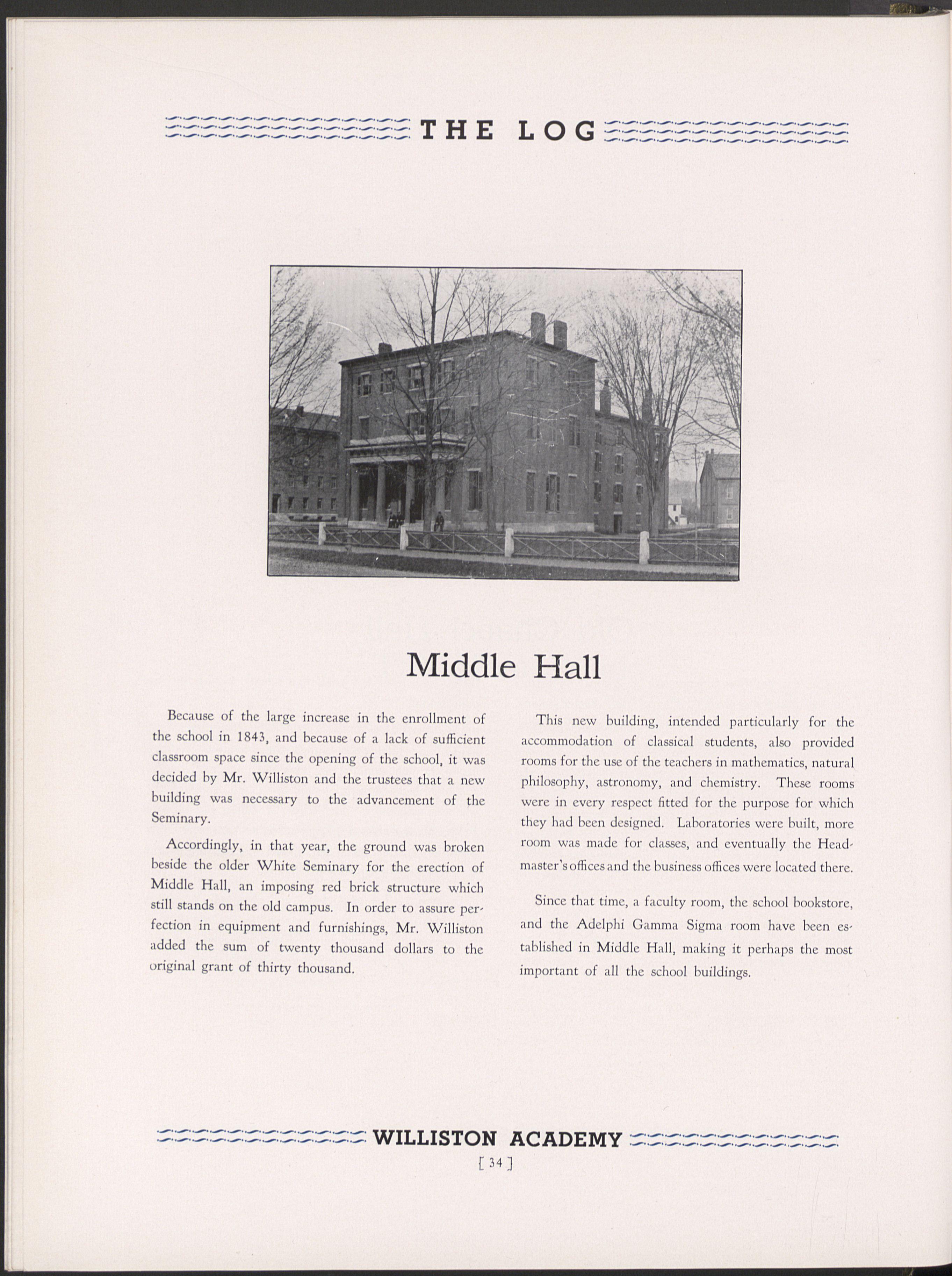

South Hall, home of chapel, classrooms, alumni office, and several boys, was built in 1857 on the site of the original White Seminary on the Old Campus.
On March 4, 1857, early in the morning, a fire broke out in the dormitory section of the White Chapel, and in a very short time that whole structure was in ruins. Of course this accident necessitated the construction of a new building; our present South Hall.
Although it was believed that the origin of the fire was unknown, many people believed that carelessness was the hidden cause. This could not have been true, however, for Mr. Williston received $10,000 in insur,
ance, which enabled him to make a much finer building out of the planned South Hall.
For many, many years South Hall was the seat of the headmaster's office, but this was changed some time ago, for the feeling was that Middle Hall, because of its position on the campus, was more central and thus better suited.
Even so, South Hall is today all important to Willis, ton, for ever since its construction, chapel and classes, as well as many outside activities, have been held there beneath its roof.
The Old Gymnasium was built in 1864. The tower and main architecture were modeled after that of an ancient government building in Florence, Italy. This building was the first preparatory school gymnasium in this country. The Williston Bulletin of 1865 describes it as "an elegant brick building over two stories high, costing more than $20,000."
The erection of this building also brought a new innovation with it; namely, compulsory physical education. Until this time there had been no classes in physical education, although there were numerous supervised athletics. The old gym boasted "a bowling

alley, bath tubs, and a sprinkling room." In addition there was a large basketball court and equipment rooms.
The shrubs around the old gym were nearly doomed in 1867 when a body of students petitioned to have the trees removed in order to have a better baseball field. No action was taken.
Since the erection of the new Recreation Center in 1930, the old gym has been used only as a storeroom and as a carpenter's shop. The old landmark still stands firm and proud after three-quarters of a century of service to Williston, the most sacred of all the old campus buildings. WILLISTON ACADEMY

In order to relieve the pressing need for more room for students' living quarters, it was decided in 1865 to build a new dormitory on the Old Campus which should be called North Hall.
At this time, however, the only available site for thc new building was taken up by the First Congregational Church, situated next to Middle Hall on the western end of the campus. This obstacle was finally overcome because of Mr. Williston's influence in the church, and that building, at Mr. Williston's expense, was moved to a different location, on the north side of the park.
The new building erected contained forty rooms for students, including both single and double rooms. Provision was also made for two recitation rooms on the ground floor. In more recent years a drawing room has been constructed in North where would-be artists while away the time. Also for many years North Hall was the seat of some of the most popular fraternities in school.
North Hall is one of the best known buildings on the campus, outstanding because of its size, beautiful in spite of its age, and dear to the hearts of all because of the memories which it contains.
Payson Hall, our present dining hall, was formerly an inn. It was run by landlord Hill and was called "Hill's Mansion House." This building was acquired by Williston Academy in 1908, but prior to that time about thirty boys boarded there. These boys attended Williston Academy.
There were no masters living in the building before it became Williston's property, though landlord Hill acted as a partial supervisor, and reported students' misdemeanors to the headmaster when he was forced to do so. On April 7, 1881, a serious insurrection broke out when a number of boys who boarded at the Mansion House invaded North Hall. They broke doors and windows, and caused a great disturbance by flying a flag with a large "'82" on it from the flag pole atop the old gym tower. For this act several students were

dismissed and the remainder forbidden to room in the Mansion House.
Payson used to serve as an infirmary for Williston students. This, however, has been discontinued since the building of the infirmary behind Ford Hall.
The building now serves as a dormitory for about thirty boys and three masters, and is used as a dining hall for students from North and South Halls.
In 1916, Payson, through the efforts of Mr. Sawyer, became the home of an experimental Junior School. Although the Junior School was at once a success, the upper school needed Payson for its own use. Conse, quently, the Junior School was moved to its present site on Main Street.
Twenty-five years ago, when Dr. Joseph H. Sawyer was headmaster of Williston, the trustees of the school felt the need for a new dormitory. It was decided that this new "Residence Hall," as it was to be called, should he situated on what is now the new campus on the same tract of land as the Williston homestead. This new dorm was to house the boys then living at Payson Hall, and that building was to be put into use as a Junior School.
Through the generous gifts of Mr. John Howard Ford, it was possible to begin work on the new dormitory in 1915. The VVillistonian of September 29 of that year proudly announced that the new residence

hall for fifty boys and three masters would be ready for occupancy by the beginning of the next term, and that it had been built at an estimated cost of about $100,000.
Finally the work was completed, the company having toiled faithfully throughout the winter, and the building was ready for inspection by the commenceS ment of 1916. It was announced that "An inspection tour of the Residence Hall will be made, and a reserved buckwheat cake consumed."
Thus is the history of Ford Hall. Today it is still a handsome Georgian building, the nucleus of the new campus.
In 1864 Samuel Williston had the foresight to construct a gymnasium for Williston Seminary. This gymnasium was not only one of the first in the country; it was one of the best equipped. From 1864 until 1930 it was in constant use, and it still stands today, an old building whose tower lends an atmosphere of dignity and charm to our old campus.
As the years went by, however, a definite need was felt for a newer and better equipped gymnasium to satisfy the demands of an increasing student body and to keep pace with a swiftly moving world. Finally, through the unceasing efforts of Mr. Sidney Nelson Morse, plans were made in 1926 for the construction of a new gymnasium. It was decided that it should join Ford Hall on the new campus, the next step in the construction of the eventual complete school on
the Old Homestead property.
Through the generous contributions of alumni, and from funds already set aside, work was begun on Tuesday, May 28, 1929. On Alumni Day, June 12, the site was officially dedicated by Mr. Galbraith, Headmaster of Williston, in an impressive ceremony.
Finally, in 1930, the Recreation Center, as it was called, was officially opened for the use of the students. Immediately an enthusia'stic student body took posses, sion, the normal athletic year began, the Glee Club gave concerts, and the new gymnasium took its place as a functioning part of Williston life.
It is a handsome building with an excellent swimming pool and a large gym floor which does triple duty as basketball floor, dramatic club theater, and dance hall.

WILLISTON ACADEMY
In constant use since the school first opened its doors, the field behind the old campus buildings has always been connected very closely with the athletic achievements of the students.
The first school year, 1841, found the fellows playing wicket and football on it,. and they have been doing so to some degree ever since. With the building of our old gymnasium, the importance of the field was raised a great deal, for, until 1901, all of the sports of the school, whether interscholastic or inter-class, were held on this historic spot.
When the Sawyer Field was built and firmly estab-

lished in 1901, however, the old campus field rightly gave up the position of top importance, hut held on to all soccer games and what under-team and inter-class games there were. Then, with the construction of Galbraith Field in 1939, all games of any importance, with the exception of canary games, ceased to be played here.
The old field is by no means dead, however, for a great many leisure hours are still spent there by the fellows. Although it may have lost prestige as an athletic field because of newer and better equipped playing fields, it has never lost any of its beauty as the oldest of all Williston landmarks.
At a trustee meeting in April, 1897, consent was given to use a portion of the Williston homestead for an athletic field if enough money could be raised to grade, fence, and equip it. The land chosen was about eight acres of ground which was part of the first tract purchased by Samuel Williston when his eyes failed, to be used as a farm.
It was proposed by the trustees in 1897 that money should be raised by subscription from alumni to reach an estimated cost of $10,000. The completion was planned for September, 1897, but the formal dedication did not finally take place until the annual spring track meet of 1898, even though the field was not then finished.
The Willistonian of April 15, 1899, stated that it was hoped that candidates for sports would take a
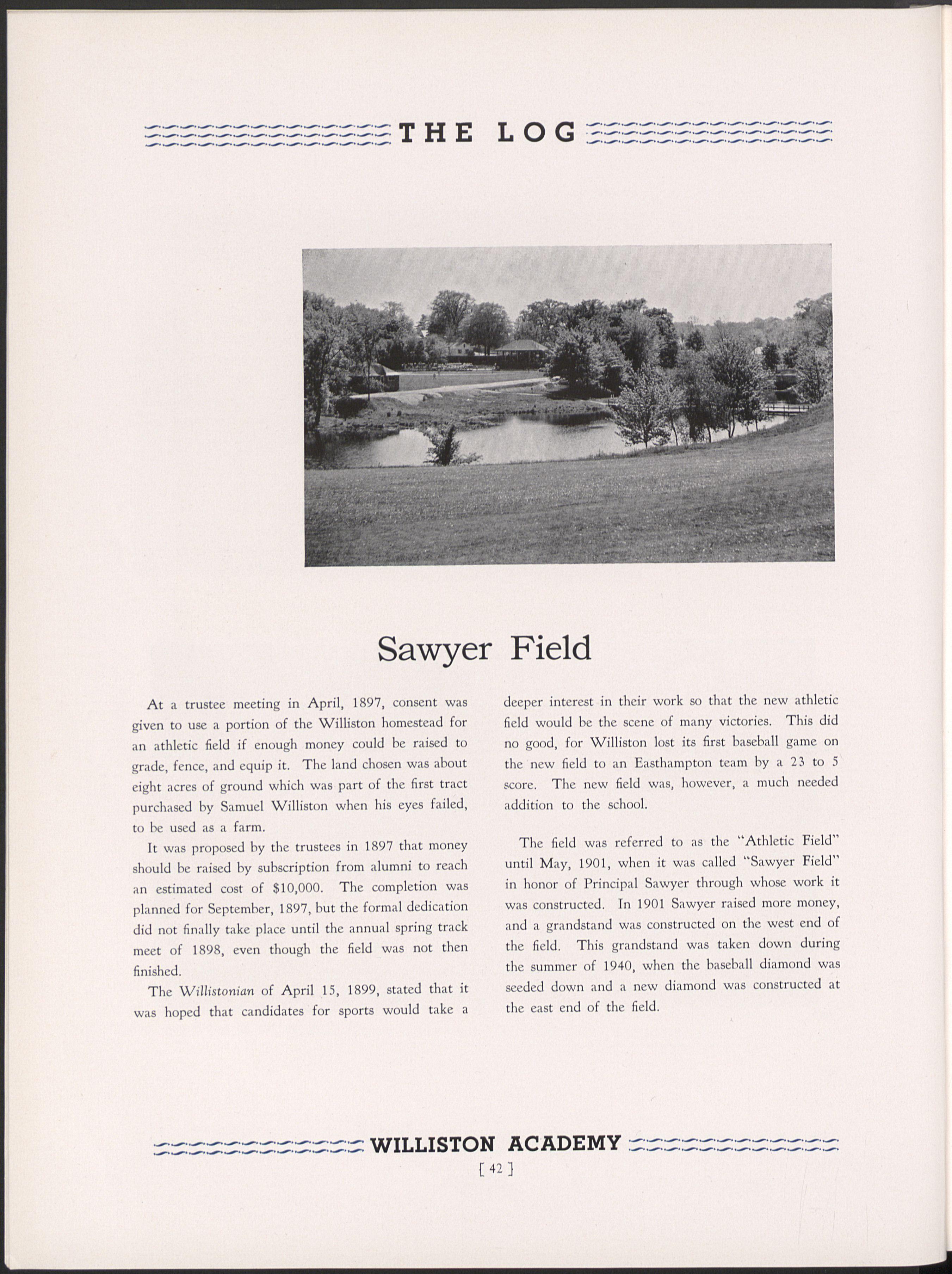
deeper interest in their work so that the new athletic field would be the scene of many victories. This did no good, for Williston lost its first baseball game on the new field to an Easthampton team by a 23 to 5 score. The new field was, however, a much needed addition to the school.
The field was referred to as the "Athletic Field" until May, 1901, when it was called "Sawyer Field" in honor of Principal Sawyer through whose work it was constructed. In 1901 Sawyer raised more money, and a grandstand was constructed on the west end of the field. This grandstand was taken down during the summer of 1940, when the baseball diamond was seeded down and a new diamond was constructed at the east end of the field.
As emphasized by Herbert B. Howe in his speech at the dedication of Galbraith Field, full credit for the foresight, planning,. and supervision necessary to complete such a field goes to Headmaster Galbraith for whom it was well named.
In June of 1938, work was started in the grading of eleven acres of land which was originally part of the Mahoney farm opposite Daley Field. Deep trenches for water drainage, with bridges to cross them, were dug between the playing fields, seeding was done, backstops were built, and lines were marked.
The result was three soccer fields, two football fields, and a baseball diamond. All home games of the first, second, and fencebusters soccer, canary and lightweight

football, and the canary baseball teams have been given the honor of making this their home field. The first game played was the Canary vs. Wilbraham played on May 27, 1939.
On Wednesday, October 4, 1939, Galbraith Field was formally and duly dedicated. William Avirett, a Deerfield Academy instructor, spoke on behalf of our athletic opponents. Herbert B. Howe, trustee of the school and member of the class of 1901, also spoke, giving full credit for such an accomplishment to Mr. Galbraith. After the speeches and dedication, Mr. Galbraith blew a whistle, starting the Williston vs. Hopkins Academy soccer game, and thus legally added one bit more to the development of the school.

In 1930, when Mr. Granniss and Mr. Putnam were looking through the countryside for a place to camp, they found a spot which they considered ideal in the Southampton woods. Through the hearty interests of these two men, the hut used by workmen in the building of the Recreation Center was dismantled and assembled again on this camping site by some of the students. Slabs were brought from the mills and attached to the sides of the cabin. The great masterpiece was completed in December, 1930, and was in constant use after January of the following year. The Academy contributed its share by adding on a back room with several bunks in 1937, but the students themselves had to do their part by getting the slabs of wood to cover this new section. Stoves were put in, outside fireplaces
built, a chimney was added, and a general fixing-up was done at this time.
Until a year ago, the land on which the cabin stands had been rented, but now the school owns 120 acres surrounding the cabin. This land includes a small bluff, overlooking a little valley, through which flows a brook. Trees shut out from the landscape all signs of civilization, although the cabin is not far from town.
An ideal place to spend a night and to really relax, the cabin holds eleven hunks with sufficient blankets for any kind of weather. Mr. Granniss, the co-founder and a true nature lover, has taken over the guidance of the cabin and has done an excellent job in keeping it up throughout the years.

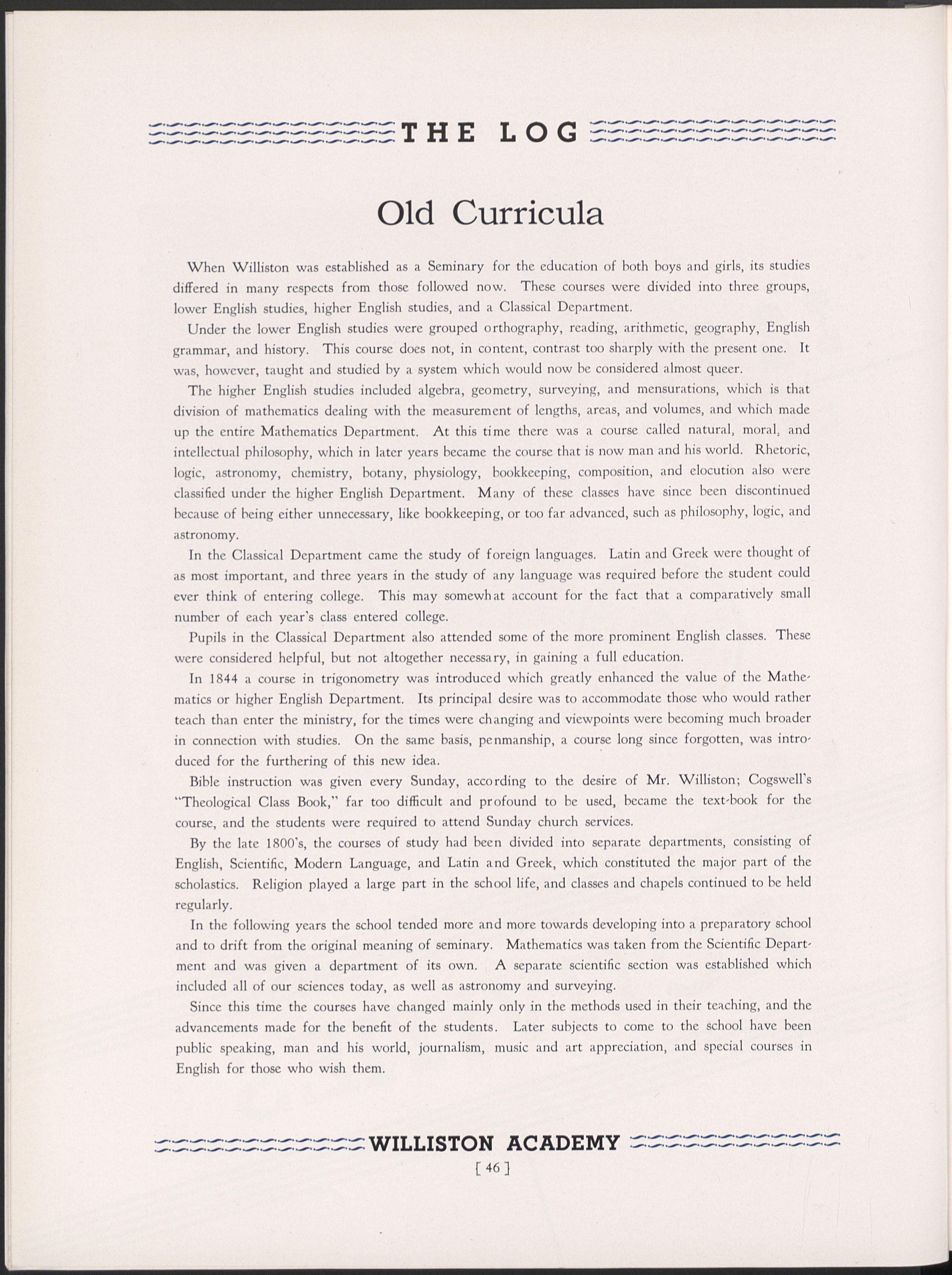
When Williston was established as a Seminary for the education of both boys and girls, its studies differed in many respects from those followed now. These courses were divided into three groups, lower English studies, higher English studies, and a Classical Department.
Under the lower English studies were grouped orthography, reading, arithmetic, geography, English grammar, and history. This course does not, in content, contrast too sharply with the present one. It was, however, taught and studied by a system which would now be considered almost queer.
The higher English studies included algebra, geometry, surveying, and mensurations, which is that division of mathematics dealing with the measurement of lengths, areas, and volumes, and which made up the entire Mathematics Department. At this ti me there was a course called natural, moral, and intellectual philosophy, which in later years became the course that is now man and his world. Rhetoric, logic, astronomy, chemistry, botany, physiology, bookkeeping, composition, and elocution also were classified under the higher English Department. Many of these classes have since been discontinued because of being either unnecessary, like bookkeeping, or too far advanced, such as philosophy, logic, and astronomy.
In the Classical Department came the study of foreign languages. Latin and Greek were thought of as most important, and three years in the study of any language was required before the student could ever think of entering college. This may somewh at account for the fact that a comparatively small number of each year's class entered college.
Pupils in the Classical Department also attended some of the more prominent English classes. These were considered helpful, but not altogether necessary, in gaining a full education.
In 1844 a course in trigonometry was introduced which greatly enhanced the value of the Mathematics or higher English Department. Its principal desire was to accommodate those who would rather teach than enter the ministry, for the times were changing and viewpoints were becoming much broader in connection with studies. On the same basis, pe nmanship, a course long since forgotten, was introduced for the furthering of this new idea.
Bible instruction was given every Sunday, according to the desire of Mr. Williston; Cogswell's "Theological Class Book," far too difficult and profound to be used, became the text-book for the course, and the students were required to attend Sunday church services.
By the late 1800's, the courses of study had been divided into separate departments, consisting of English, Scientific, Modern Language, and Latin and Greek, which constituted the major part of the scholastics. Religion played a large part in the school life, and classes and chapels continued to be held regularly.
In the following years the school tended more and more towards developing into a preparatory school and to drift from the original meaning of seminary. Mathematics was taken from the Scientific Department and was given a department of its own. A separate scientific section was established which included all of our sciences today, as well as astronomy and surveying.
Since this time the courses have changed mainly only in the methods used in their teaching, and the advancements made for the benefit of the students. Later subjects to come to the school have been public speaking, man and his world, journalism, music and art appreciation, and special courses in English for those who wish them.

The best way in which we may show just what the early Williston curricula was is to present to you quotations from the constitution of the school as it was written in 1841. Mr. Williston emphat ically states what he wishes taught at the school, and we find that his ideas were followed very closely for the first few years at least. Mr. Williston said:
"Attaching great importance to the formation of good intellectual and moral habits, as well as the acquisition of a minute and thorough knowledge of the elements of the English, Latin, and Greek Languages by those, who are in a course of preparation for College, the establishment of a Classical Academy in the valley of the Connecticut has been to me, for many years, the subject of much anxious and prayerful solicitude, and this has been a primary object in the founding of Williston Seminary. It is therefore my wish, that young men, who rep air to it for the purpose of fitting themselves for College, may be thoroughly drilled in all the preparatory subjects, particularly in the elements of accurate scholarship in the Latin and Greek Languages, and at the same time faithfully disciplined in all those habits, not only of study, but of thought, feeling and action, which are so easily formed at this early stage of their education, and yet so likely to follow them in all the intricate windings of their pathway through life, and even down the trackless ages of eternity.
"It is believed, that three years may advantageously, and should usually, be spent in studies preparatory to College, and it shall be the effort of the Trustees and Teachers to encourage by all suitable means the completion of a regular course of three years. To this end, certificates of graduation shall be given by the Principal to those students, and those only, who shall have completed the entire course to his satisfaction and at the same time have maintained an unblemished moral character. Certificates may be given to others, but they shall certify only to moral character and actual attainment of the individual student.
"My object in connecting an English Department with the classical has been, partly, to apply as aforesaid the deficiencies in the English education of the Classical Students, but chiefly, that those, who intend to pursue the various occupations.of business, and have not the time or the means, or the inclination to go through a regular Collegiate course, may obtain a better discipline and a wider acquaintance with the various branches of science and English Literature, than are now placed within their reach.
The design therefore embraces ample instruction in English Grammar, Geography and Arithmetic, together with Reading, Writing, Orthography, and Orthoepy; in Rhetoric, Logic, and intellectual and Moral Philosophy, and in the several branches of Mathematics and the Natural Sciences. Having made liberal provision for the illustration by apparatus, of the Natural Sciences, and believing them to be admirably suited to the purposes of mental and moral discipline, and particularly adapted to enlarge and elevate our conceptions of the ways and works of God, I desire that special attention should be paid, both by Lectures and Recitations, to Natural Philosophy, Astronomy, Chemistry, Botany, Mineralogy, and Geology. And I would have them taught in their proper relation to Natural and Revealed Religion, which they so strikingly illustrate.”

In 1841 Williston Seminary, as a whole, was divided into two main classes, the Classical section, which emphasized subjects such as Latin, Greek, and French, and the English division, which studied subjects much the same as those taught at Williston today. At that time each group had its quota of female students in addition to the males; the Ladies' Department, however, did not become a recognized part of the school until 1850.
According to the Williston Catalog of 1841, the Classical Department had 63 students; the English, 128. This number rose steadily until 1846, when it reached its highest total, 542. The Classical had 218 students; the English, 324. This number declined slightly after 1846.
Nine years after the founding of the school the males in the Classical Department were divided into the Senior, Middle, and Junior classes, this example being copied the following year by the English group. In 1869, four years after Williston had become entirely a boys' school, the Scientific Depart, ment became a division.
The Classical Department had the Junior Middler class added to it in 1873. The forward step of this division made it much like our present naming of classes. In 1877, after the discontinuation of the English Department, the Scientific and the Classical were the main classifications of the school. The former was expanded in 1879 to include our four present classes. These two most important groups in Williston were finally joined in 1894 to go under the heading of Senior, Middle, Junior Middle, and Junior. In spite of this formal unification, however, the classes were not nearly so well defined as they are today.
According to the Oracle and the Mirror, two of the first student publications, the former written by the Adelphi, the latter by the Gamma Sigma, the tendency was for the students to divide themselves into Greek letter secret societies and eating clubs, which correspond to today's college fraternities and other organizations. Prior to 1894, when the Scientific and the Classical Departments were the main divisions, there was much competition between them both on the field and in the classroom, since there was seasonal competition in basketball, baseball, and football.
The older classes and teams had higher averages than those of today. According to the Caldron, one of the first Senior publications, which was soon succeeded by the Rus, the average age of one of the football teams was 19 years. In 1877 most of the members of the Senior class were 20 or over. This was also true until the early part of the twentieth century, when the ages of the students became diminished.
It should here be stated that although young ladies were banned from the school in 1865, they did not entirely remain isolated from Williston. Even as late as 1918, three young ladies were students at the Seminary. For this reason, we believe that it may have only been for a very short period of time that the ban was enforced.
Thus, we have the story of the various classes at Williston. Like all other branches of the school, they have advanced rapidly, in this way keeping pace with the growth of the school itself.

Class of 1877, Scientific
Class of 1886, Middle Year r 4,1
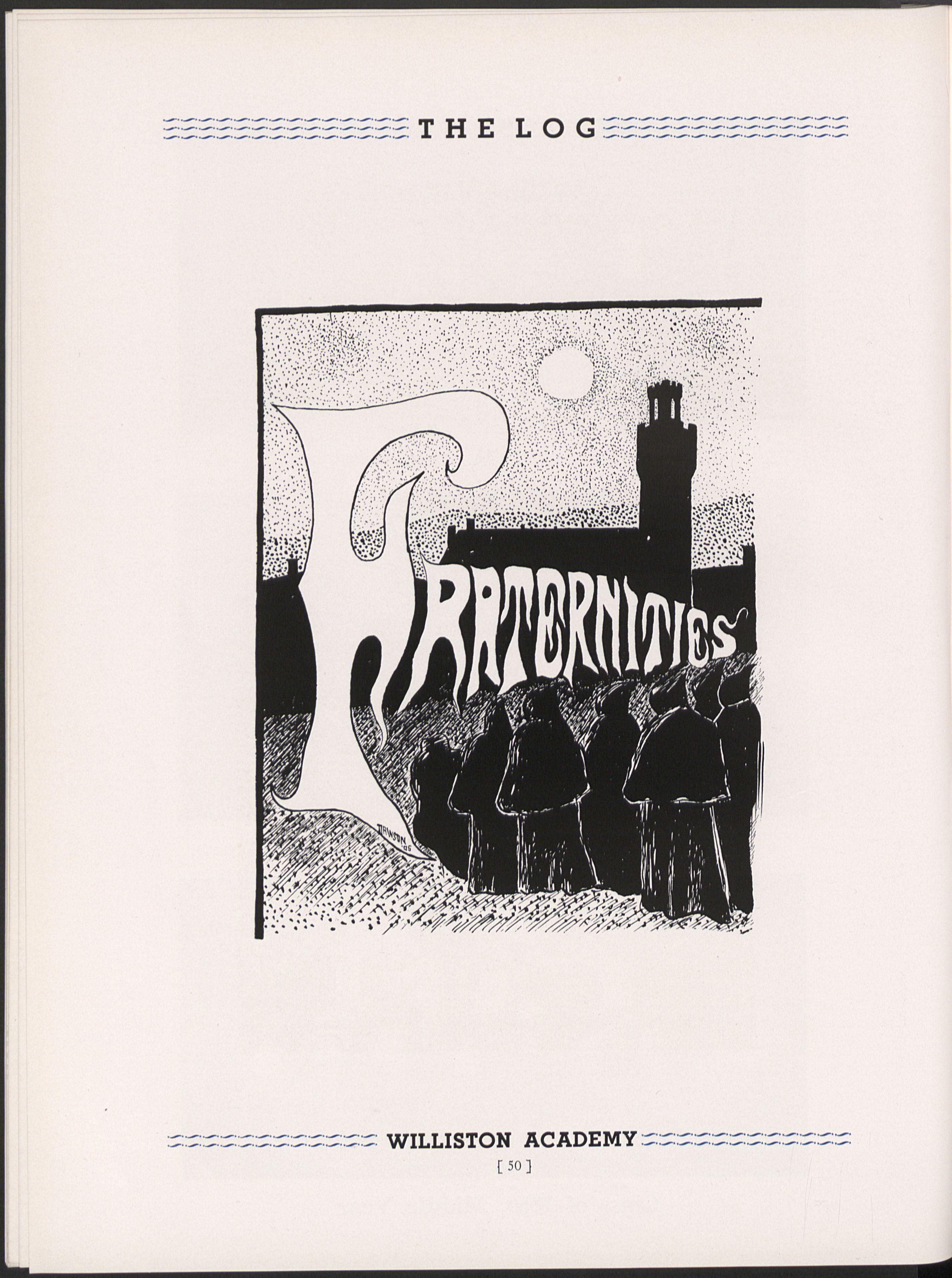
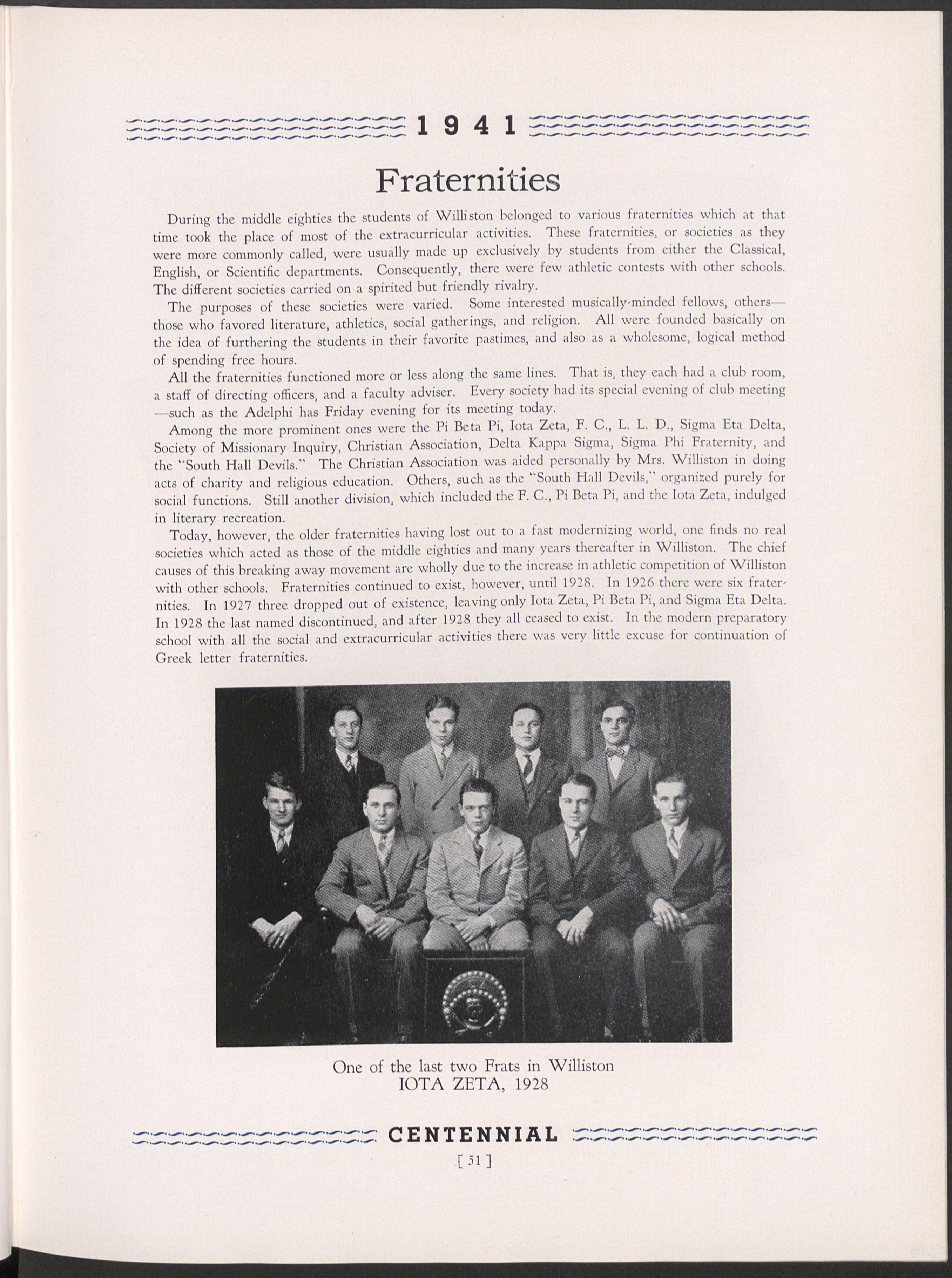
During the middle eighties the students of Williston belonged to various fraternities which at that time took the place of most of the extracurricular activities. These fraternities, or societies as they were more commonly called, were usually made up exclusively by students from either the Classical, English, or Scientific departments. Consequently, there were few athletic contests with other schools. The different societies carried on a spirited but friendly rivalry.
The purposes of these societies were varied. Some interested musically-minded fellows, others— those who favored literature, athletics, social gatherings, and religion. All were founded basically on the idea of furthering the students in their favorite pastimes, and also as a wholesome, logical method of spending free hours.
All the fraternities functioned more or less along the same lines. That is, they each had a club room, a staff of directing officers, and a faculty adviser. Every society had its special evening of club meeting —such as the Adelphi has Friday evening for its meeting today.
Among the more prominent ones were the Pi Beta Pi, Iota Zeta, F. C., L. L. D., Sigma Eta Delta, Society of Missionary Inquiry, Christian Association, Delta Kappa Sigma, Sigma Phi Fraternity, and the "South Hall Devils." The Christian Association was aided personally by Mrs. Williston in doing acts of charity and religious education. Others, such as the "South Hall Devils," organized purely for social functions. Still another division, which included the F. C., Pi Beta Pi, and the Iota Zeta, indulged in literary recreation.
Today, however, the older fraternities having lost out to a fast modernizing world, one finds no real societies which acted as those of the middle eighties and many years thereafter in Williston. The chief causes of this breaking away movement are wholly due to the increase in athletic competition of Williston with other schools. Fraternities continued to exist, however, until 1928. In 1926 there were six fraternities. In 1927 three dropped out of existence, leaving only Iota Zeta, Pi Beta Pi, and Sigma Eta Delta. In 1928 the last named discontinued, and after 1928 they all ceased to exist. In the modern preparatory school with all the social and extracurricular activities there was very little excuse for continuation of Greek letter fraternities.
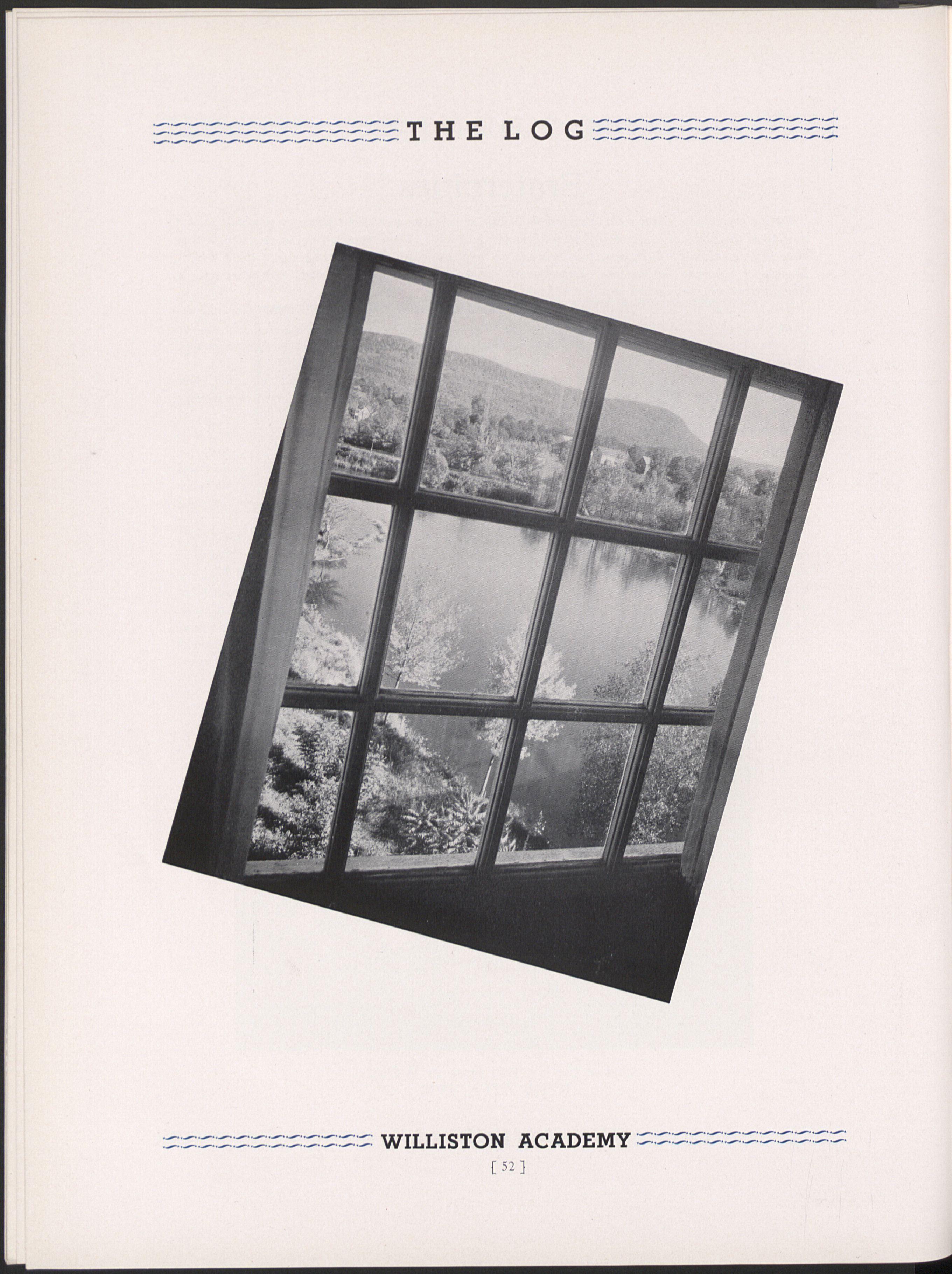

In the year 1849, just eight years after the found:ng of Williston Seminary, the first organized society of students was formed. This was at the beginning of Josiah Clark's principalship.
Principal Wright had opposed all such literary organizations because he feared they might depart from their original purpose and become subversive of school discipline. Principal Clark, in his first year as head of the school, granted permission for the formation of a literary society, called The Adelphi Society, and established it in 1849.
The society quickly gained prominence in the school in debate upon momentous questions of the period. In 1852, through the prank of one of the members, the society ceased to exist. At the end of one of the regular meetings one member, who was fond of parliamentary tricks, moved "that the society should now dissolve," The motion was so carried and recorded, for its unusual wording was not noticed. The members then found out that they had killed their society. A referee to whom the matter was submitted decided that the society had ceased to exist.
Near the close of the winter term in March, 1853, a meeting was held for reorganization, and officers were chosen. A committee of three was appointed to inform .the faculty of the reformation of the

society and to consult with them in matters of importance. It was voted that the society should be called "The Adelphi of Williston Seminary," and a committee of three was appointed to draw up a constitution, the preamble of which reads as follows:
We, the members of the Adelphi, in order to secure for ourselves and our successors the advantage of popular discussion; to acquaint ourselves with the rules of parliamentary practice; to obtain the benefits of practical reasoning; to grasp and hold the principles of oratory and of English composition, do ordain and establish this constitution for the Adelphi of Williston Seminary.
The first president of the newly-formed Adelphi was Homer Bemis Stevens, afterward a Westfield lawyer. A room was provided for this society in one of the halls and given free of rent. In the first decade of its existence the members procured a library of English classics and a piano, together with furniture for the hall. It was here that the first maxim was formed, which said: "Philosophy, wisdom, and liberty support each other. He who will not reason is a bigot; he who cannot is a fool; he who dares not is a slave."
When Dr. Henshaw became principal in 1863, the school had two literary societies: Adelphi, which since its reorganization had been prominent and had drawn to its membership much of the best of the student body (a catalogue issued in 1864 contained 844 names), and Delta Kappa Sigma, which had been organized in 1854. What Delta Kappa Sigma was, besides being literary, only the members knew, for it was a secret society. Probably its secrets were trivial, and for that reason important, even essential, to the members.
9 4 1

Dr. Henshaw objected to secret societies. He explained his objections to the trustees, who voted in 1864 that Delta Kappa Sigma must cease to exist.
The society was permitted to hold a public meeting followed by a banquet. The meeting was very dignified, the best talent of the society being secured for the literary program. The property of the society was sold, and the room which it had occupied became a recitation room.
Adelphi was left alone and its membership was made up from all parts of the school. The growth of the English Department introduced friction, for the Englishers demanded eligibility to the presidency, while the Classical section asserted their incapacity to govern. Trouble ensued. In the winter of 1870, by a skillful political combination, an Englisher was elected president. So serious was the condition thus created that appeal was made to the faculty to act as a court of appeals, although nothing in the constitution recognized such a court.
Since compromise was impossible under the circumstances, the faculty recommended that the society should be separated, and a second body organized. The new society should draw its membership exclusively from the English and Scientific Departments, and that no Classical boy should be eligible thereto.
Then the constitution of each society was changed to define eligibility to various offices, presidency being limited to the Senior class. Thus the Gamma Sigma Society came into existence, using those Greek letters of the Socratic maxim, "Know thyself."
In March, 1871, Adelphi gave a public exhibition in the town hall. The society paper was read; there was an original oration and music; and the question for discussion was: "Resolved, That San Domingo ought to be annexed to the United States." Prizes were offered for the best individual debate.
Each term a paper was issued by each of the societies. That of the Adelphi was called Oracle, and that of Gamma Sigma, Mirror.
In 1897 a silver cup was offered for contest in debate by the two societies, and this soon became an annual event. Later, in 1903, a silver cup was awarded for the best individual debates in the annual joint debates. These prizes have stimulated intense interest.
In later years the rules and regulations of the society became less strict, until finally any boy could enter either society regardless of his class. This called for much better relationship between the two societies until, in 1934, it was decided that the two societies should be joined as one, and should be called the Adelphi-Gamma Sigma Debating Society, with any student eligible for both membership and office.
In recent years this society, combined and acting as a unit, has entered into many interscholastic debates, outstanding among which have been those with Worcester and Deerfield. There has also been a great deal of the traditional interclass debates.
Under the guidance of Mr. Thomas, its present faculty adviser, the society has become one of the most popular and beneficial in the school. Rain or snow, it meets every Friday night at 9:00 to discuss the problems of our world today, just as in 1849 it met for the same purpose.

Standing—Battey, Chase, Burnett, Griesbach, Hutchinson, Brooks. Seated—Wright, Spellman, Messinger, Tyler, Chapman, Sanford, Layng.
Musical organizations have always been plentiful and popular at Williston. Mr. Williston, in founding the Seminary, expressed his desire to have music taught in the school when he said,"Nor can I forget the mention of sacred music, particularly vocal music, as a branch which I would always have taught by a well-qualified teacher, and would have every pupil urged to cultivate it, as an important means at once to improve the voice, to refine the feelings, and to soften the heart."
As far back as 1870 there are records of a glee club. There undoubtedly were clubs even before this, but the first written records and mention of a glee club occur in the Salamugundie of 1870. This club consisted of only nine members under the direction of Mr. A. B. Hallett. In 1869 a group of boys under the guidance of Mr. Augusta Jewett formed an orchestra called "The Grand Seminary Orchestra." This orchestra combined with the glee club to put on a series of concerts in the old town hall, and judging from the programs, there were really good concerts.
Later, several new musical clubs were formed. In 1871 mention is made not only of the glee club but of an Adelphi glee club and a chapel choir. These four organizations, plus an orchestra group, show a very definite interest in music.
The next year brought about the formation of a quartet which called itself "The Orphan Quartet." The derivation of such an odd name is unexplained, nevertheless the quartet made its debut and continued to sing under that name.
It was the custom for these musical clubs to band together once or twice a year and to present a combined concert. These concerts were evidently highly successful, for they were presented year after year. They were still given at the town hall and admission was charged.
Previous to 1876 the various music clubs were quite independent of each other and usually had different leaders or directors. According to the records, each club had its own schedule of concerts and engagements except for the one combined concert mentioned above.
In the 1914 "Log" there is an article on Williston musical organizations written by E. P. Guild, '77, in which he said, "The Williston /vpsical Association had its birth in the fall of 1876." Under the direction of this association were the many different clubs. In that first year they had a glee club, orchestra, chapel choir, and a string quartet. Mr. Guild was thc first president of the association, and Roswell Parish, master in science, became the leader of the glee club. F. B. Kellogg, an accomplished violinist, led the orchestra.
This association apparently continued as a permanent organization until about 1914 or 1915, after which music at Williston is referred to as music clubs.
1878 is a memorable year to all Willistonians. It was in that year that Irving Bruce composed the "Williston Hymn." This beautiful work is still sung today in the daily chapel services.
The general trend towards the glee club and the banjo clubs, which had started a bit later, continued on through the years. The annual concerts continued to he given with much success, and the students took part with great enthusiasm.
The next addition to the glee club occurred in 1886. It was in that year that we find mention of a double quartet. Quartets had been used before, but this double quartet was the first of its kind in the history of the school.
The string clubs seemed to alternate almost yearly between banjos and mandolins, but the interest in them continued, and they flourished from year to year without any loss of interest on the part of the students.
In the early 1900's musical organizations were still made up mostly of the glee club, the banjo or mandolin clubs, and a quartet. The fraternity glee clubs and the old chapel choir seemed to have dropped out of existence, as no,itior mention is found anywhere concerning them.


Standing—C. E. Rouse, Conductor, Piano; Cupp, Drums.
Seated—Richardson, Banjo; J. Garvey, Violin; Gallup, Saxophone; S. Williston, Tenor Banjo.
The class of 1905 have reason to be proud of themselves, and especially of one of their classmates. In that year a boy lying in the shade of one of the many elm trees which adorn the campus composed a tune which has come to be the song of Williston Academy. That song is "Sammy," and the composer is Paul "Pitt" Johnson. This year, 1941, the tune has been arranged, and for the first time &I down on paper, by Mr. Charles E. Rouse and Mr. Frederick B. Hyde.
Professor Innis was director of the glee club in 1906, during which time there was a quartet and a banjo club; the latter consisting of 10 members. In charge of the vocal organizations in 1909 was Professor Roberts, and C. E. Howe was the leader of a 10-man mandolin club. Professor Roberts continued as vocal director through 1913;when Professor Kelley took over the position. The 1909 quartet carried through an enthusiastic schedule of 10 appearances-5 in various parts of Easthampton, and one in Southampton, Northampton, Florence, Springfield, and at the alumni banquet in New York. The glee club made five appearances in that year. The interest in instrumental music at that time is shown by the size of the mandolin club consisting of 15 members.
In 1914 the association was very active at all times and had five different organizations: A glee club of twenty-five voices; a quartet; a stringed trio composed of Professor Kelley, violin, Fred Clark, 'cello, and H. U. Camp, '14, piano; a mandolin club of six members; and a small orchestra.
In 1915 and 1916 there was not so much enthusiasm for music in the school as had prevailed from 1905 to 1914. They had a glee club of about thirty voices, a quartet, and a small orchestra. Only two concerts were given during the year 1915-16. In 1916-17 there was, apparently, no glee club, and only a small orchestra under the direction of Professor H. P. Kelley.
In 1917,18 there was a revival of interest in music, and a glee club of thirty-five voices was organized and directed by Mr. McAllister, headmaster of the Junior School, and an orchestra and mandolin club was under the directorship of Professor Dickinson. Only one concert was given that winter. In 191819 it seems that no plans were made for a music director. Sergeant A. L. Graham, military instructor in the school at that time, attempted to organize a musical club, and composed a musical "Potpourri" for the annual concert at the town hall. Mr. Graham had had very little experience in directing music, so the club asked Mr. Earl N. Johnston, a new member of the faculty in the Science Department that year, to direct the music for the concert. William Barnes was leader of the orchestra which played in the concert and for the dance which followed. Mr. Johnston continued to direct the glee club for six years. There was some revival in the interests in music, and the clubs had some of the best voices ;rom 1921 to 1924 that it has ever had. Baron, Braunecker, Nelson, Aiken, Burke, Wood, and some others were very much better than the usual preparatory school singers. Boys came regularly to rehearsals and sang for the love of music, for there was very little other incentive offered with the exception of one or two concerts during the year.
The thing that really made the glee club the popular organization that it is today is due to the fact that in 1924-25 the club revived the practice of going to New York each year to sing before the alumni convention. Naturally this attracted many boys to the club who hitherto would have paid no attention to it whatsoever. These trips continued until the club grew too large to send as a unit. When this condition arose, quartets and double quartets were sent in place of the whole glee club. By 1930 the glee club was one of the most popular organizations in the school, as well as the largest. Orchestras, both popular and classical, continued to be formed yearly, and today they, too, have made a steady place for themselves.
In 1939 a real project was set under way by Mr. Charles E. Rouse, who took over the club in the fall of 1924. He wished to try something new and different in the glee club; namely, the presentation of a Gilbert and Sullivan operetta. Very ably assisted by Mr. Frederick B. Hyde, he directed the club in the production of "Trial by Jury." It was a complete success, and although it was quite expensive to present, it more than paid for itself. Henceforth, Gilbert and Sullivan operettas continue to be presented annually.

Standing: Nason, Sexton
Seated: Richards, Winslow, Ames Front: Arkell
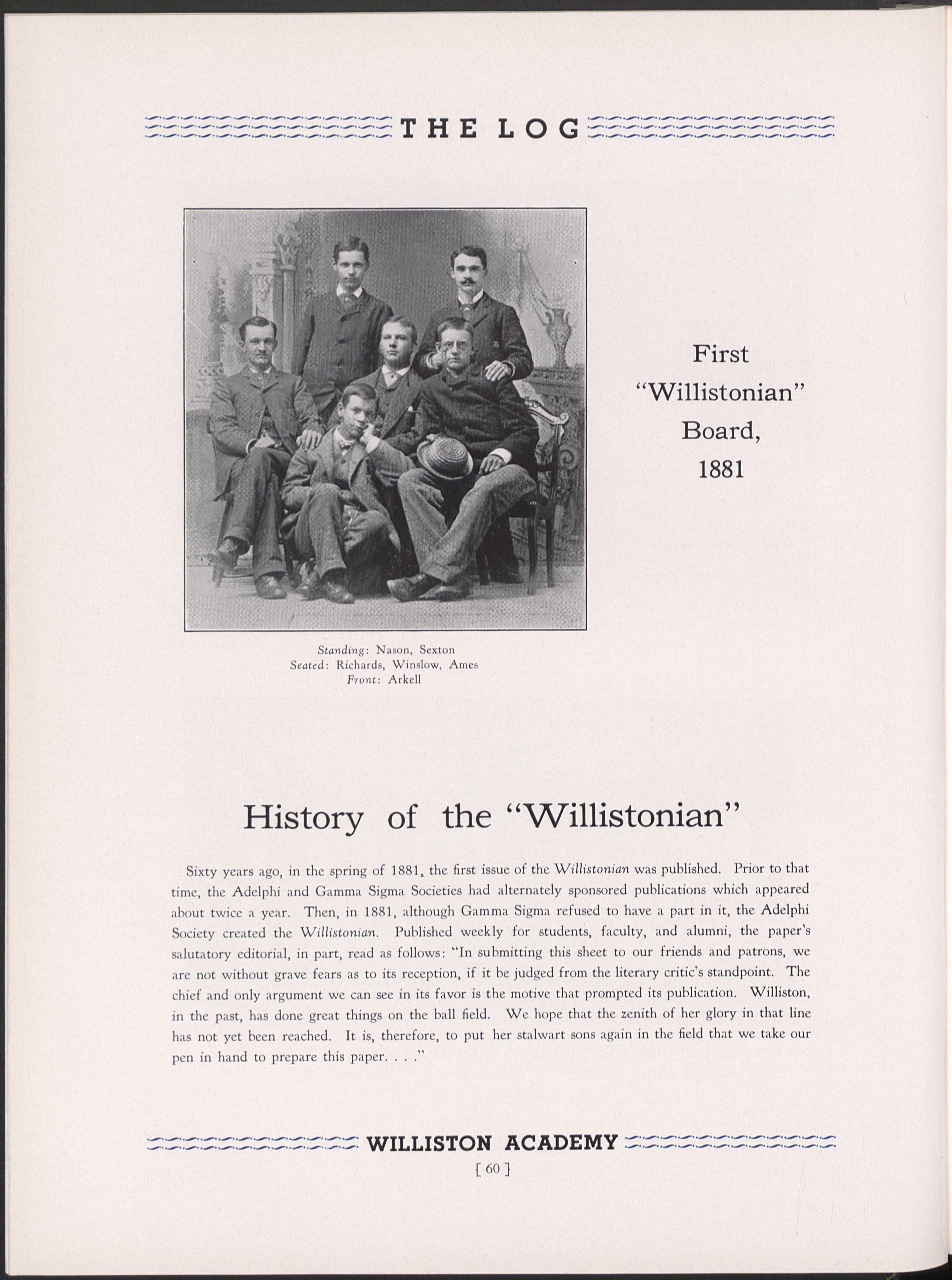
Sixty years ago, in the spring of 1881. the first issue of the Willistonian was published. Prior to that time, the Adelphi and Gamma Sigma Societies had alternately sponsored publications which appeared about twice a year. Then, in 1881, although Gamma Sigma refused to have a part in it, the Adelphi Society created the Willistonian. Published weekly for students, faculty, and alumni, the paper's salutatory editorial, in part, read as follows: "In submitting this sheet to our friends and patrons, we are not without grave fears as to its reception, if it be judged from the literary critic's standpoint. The chief and only argument we can see in its favor is the motive that prompted its publication. Williston, in the past, has done great things on the ball field. We hope that the zenith of her glory in that line has not yet been reached. It is, therefore, to put her stalwart sons again in the field that we take our pen in hand to prepare this paper. . . ."
1 9 4 1
WiNsLow,'81, RICHARDS,'81, AMES, '81, NASON,'82,

EDITORS:—
General Manager. Business Manager. ARKELL,'82. SEXTON,'83.
TIIE WILLISTONIAN is Published every SATURDAY during the school year, excepting vacations, by the Adelphi Society of Williston Seminary.
TERMS, $1.50 Per Year, - - 50 Cents Per Term. Single Copies, Five Cents. For Sale and Subscriptions taken at ALVORD'S News Rooms. Communications requested from Alumni and others interested. Subscriptions and Communications should be sent to THE WILLISTONIAN, EASTHAMPTON, MASS. Lock Box 120, Torrey Brothers, Bonk and Job Printers, Easthampton, Mom
EDITORIAL.
For many years Williston has held her own among the institutions of learning throughout the country; in the recitation room and on the campus she has ever been among the foremost of New England acade mies. But during these years she has • had no live organ through which to express her views on academic subjects; in fact her want of an active and wide awake chronicle has been not only sorely felt at home but widely. commented upon elsewhere. During these years our seminary has not been without literary talent, as some suppose, but various circumstances have united to render a regular paper a difficult accession. Till now the Faculty has held itself opposed to such a step, and not without good reason, as this school has suffered much from the pens of some of its students. This paper is undertaken by the Adelphi Society, not for any personal benefit to its members, but that there may be some responsible head from whence the publication may originate, some control and system under which it may be issued. It is undertaken for the good of the institution and right gladly will we welcome any worthy contributions to its columns. We desire it to be"published in the interests of the school"and to have it express the candid opinions of those in favor of law and or-
der among us.
Criticisms from exchanges will be gladly welcomed. It is our intention to keep on the best of terms with all; we shall be as careful as possible that there be nothing that can hurt the feelings or expose to ridicule any of our schoobnates and we hope it will be received in the spirit it is given. Other schools and colleges are all the sustainers of one or more papers, and why not we? The Society and the editors will strive to do their best, but without the hearty co-operation of the school their most earnest efforts can but fail. It may be stated here, that this is but. a trial; should it succeed Williston will yet take a stand in amateur journalism; should it fail we hope the disaster will not deter the coming generation from making the same attempt. We shall strive to do justice to all, and to give henceforth,each week,a correct account of all that is interesting to a student of this seminary. We hope these humble efforts of ours may be of benefit and pleasure, not only to ourselves but to our fellow students and friends.
The annual prize speaking exhibition of this seminary occurred on the 25th of March. The declamations throughout were excellent. Every gentleman had full command of his piece.and delivered it in his best style. The careful training under Professor Smith, in frequent rehearsals, had greatly improved the original talent of the speakers and a very commendable display was the result. The hall was filled with students, townspeople, and friends of the seminary from far and near. The judges, Judge William G. Bassett, of Easthampton, John A. Aiken, of Greenfield, Rev. Chas. 0. Day, of Williamsburg, after some deliberation awarded the first prize to Benjamin K. Heaton,'81, of Philadelphia, Pa., the second to Michael H. Sexton,'$3, of Waterville, N. Y., while Mr. W. G. Green was mentioned as entitled to especial praise. There was some slight dissatisfaction felt at the award of prizes, but we do not in the least question the ability

The Willistonian's first editorial staff was composed of Messrs. Heaton, Baldwin, Noye, and Ames. The last named was later knighted by the king of England for his outstanding work in raising funds for the relief of wives of Canadian soldiers. Sir Herbert Ames was also appointed the first treasurer of the League of Nations.
The first issue of the Willistonian, intended to appear weekly, was in the form of a small light-page newspaper. It contained a large amount of athletic news, including college notes from such institutions as Amherst, Yale, Williams, Princeton, and Harvard. The publication printed a certain amount of poetry, written by students of the Academy. It indeed resembled the type of newspaper that one might expect to see at that time in a New England preparatory school, small, sedate, and dignified.
Between the years 1881 and 1889 the Willistonian remained practically the same. The practice of changing the staff in early spring, which prevails to this day, was adopted, thus giving the incoming journalists a period of tutoring under the previous staff members.
The Willistonian made its initial change in form in the year 1890, when it enlarged the size of its pages and cut the number down to four. This was the paper's first step in following the standard set in the modernization of newspapers, and it pursued this form of issue for thirty-three years. It continued to appear weekly and adopted new features, slowly changing itself as newspaper styles fluctuated.
The return to a light-page issue came about in 1923. The paper retained the larger page which it had adopted in 1890, and continued to appear weekly. By this time such features as book reviews, short stories, a gossip column, and other modernistic developments were a regular part of the paper.

A radical change in the Willistonian's form took place in 1934, when the editors completely changed its style and published it as a monthly magazine. This type of issue presented a condensation of the month's athletic and extracurricular activities. It also contained student editorials and short stories.
In 1935 the Willistonian returned to its previous form, publishing a founpage issue which appeared bi,weekly. It has operated under these conditions since that date, save for the fact that in 1938 the period between publications was lengthened to three weeks.
The Willistonian has always belonged to the students. Although its faculty advisers have been indispensable for their advice and suggestions, the paper remains a publication completely dominated by Williston students. All literary material is gathered by the editorial staff; the entire problem of soliciting advertisements and handling finances is taken care of by the business staff.
And so, after a close analysis, one comes to the conclusion that, although it is sixty years old, the Willistonian has not really changed to any marked degree. It may have altered its appearance physically, but it still remains a publication mirroring the activities and student life in an old New England preparatory school.
The following is a review of the Willistonian and is copied from the first "Log" published in 1902:
The Willistonian may well be proud of its long and successful career. Without doubt it is one of the oldest "prep." school weeklies in existence. Its first issue appeared in 1880, published by Adelphi, which wisely foresaw the need of a weekly paper in Williston. It might be well to review the causes of its origin, for every good thing has a reason or motive behind it which pushes it to the front. Early in it existence the debating societies of Gamma Sigma and Adelphi were strong rivals, a feeling which has not at the present day totally disappeared. Gamma Sigma was accustomed to publish two or three times a year what was known as the "Campus and Hall," with the idea of raising money to refurnish its rooms, which purpose the paper accomplished and then ceased to exist. Adelphi then began publishing the Willistonian. From that time, 1880, to the present day this paper has been published weekly even though it has changed hands a number of times. We all realize its importance as a factor of our student life and look forward to receiving the Willistonian on Saturday evening of every week. Much credit is due to those who are spending and have spent so much time and thought in order that we may keep in touch with the interesting events of our life here at Williston. The Willistonian stands forth as a large item of our school life and deserves the hearty support it is receiving from the present student body as well as the alumni.
Hobson Hagar

THE FIRST "LOG" BOARD, 1902
Smith Weathers Gray White
Rogers
Until the time of the founding of the "Log," only a scattering of annuals were put forth by the students of Williston Seminary, the last of which was produced in 1886. A yearly summary of some sort was clearly in order, so in 1902 a few members of the faculty got together with a body of students to gather the material for such a book.
The "Log," as the name implies, was a resume of the year 1902, and on one of the first few pages appears a rather short, though concise, history of Williston up to the year 1902. This was probably one of the first, if not the first, histories produced in any of the annuals.
Track was probably the outstanding sport of this year, and several following it, proved by the space allotted to it in the first edition. Pictures of the first "Log" board reproduced in this book, also of the faculty, and of the various teams appeared. Résumés of the success of the football, basketball, baseball, and track teams are given.
A single picture of each member of the Senior class was included with a history of each boy's activities in Williston, and class pictures of the Middle, Junior Middle, and Junior classes. There appears, also, a picture of the class gift—a statue titled "The Niobe."
Then came a few pages concerned with the various fraternities, including "Iota Zeta," "Pi Beta Pi," L. L. D., and F. C.
In the last few pages there were anecdotes taken from the classrooms, and sayings about the school, the titles of the Senior theses, and lists of honor students, along with a large group of advertisements.
Looking through the "Logs" following the first, one can see marked changes for the better. The first book is decidedly different from those following it. In 1904 a new shape was created. It was long and rather narrow, and still thicker than the '02 book. In 1905, however, the book was returned to its original shape.
The book form of the "Log" was continued until 1915, when it was bound in paper cover and was much smaller. This was kept up until 1921, when once again the original form was continued. It is worth noting here that in the 1918 "Log," a list of the boys that enlisted for the great war was included.
In 1926, with Mr. Rouse as adviser, a decided change and improvement was made in the type of annual published. The chief difference was in general layout and content. All the activities of the school were covered both by description and picture. The general type of book established then has been continued up through 1940, the chief differences being in modernization of layout and cover.
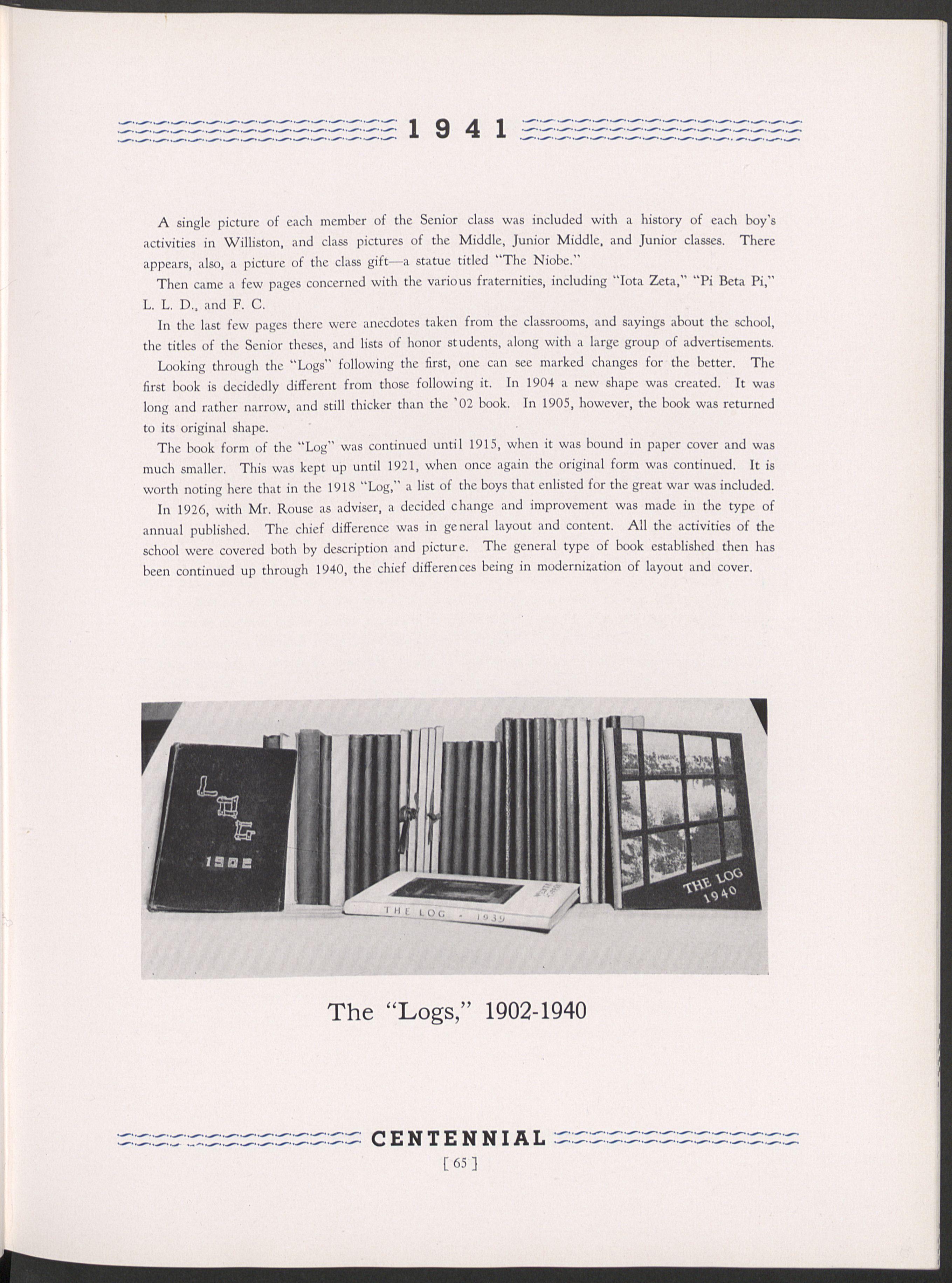
The "Logs," 1902-1940

Since 1934 the conventional, ready-made cover has been discontinued. During this time, under Mr. Johnston's advisership, the material for the cover has been selected and the design made by the "Log" board. This has added a local interest and has greatly improved the appearance of the book.
In 1929 an embossed cover appeared, and until 1934 this practice was continued in about the same manner.
As to the change of subject matter, let us compare the earlier "Logs" with those of more recent years. Instead of the group pictures of the faculty appearing in the earlier editions, now each member has a single photograph, and material concerning each, including date of elections to Williston. The single photographs of the Seniors are now accompanied by single photos of each member of the lower classes, with the names and addresses. Pictures, either singly or in groups, appear of the members of the extracurricular organizations with data concerning the activities of each. More informal pictures have been included in the recent "Logs," both of sports and of life at Williston. Reviews of the seasons in all the sports appear with lists of letter men. In the later years, a few pages have been left in the back for autographs.
That small group which produced the first edition of the "Log" in 1902 probably never realized that they had introduced a book which has been indispe nsable to Williston. The "Log" has a place of great importance in this centennial year of 1941, and in years to come will be one of the prime factors in preserving a written history of Williston Academy.
Medalist 1937

First 1938 Second 1939
First 1940
Since 1937 the "Log" has been a member of the Columbia Scholastic Press Association, an organization which sponsors annual contests among school yearbooks and newspapers, and awards medals to the best entries of either class.
Basing their opinions upon quality, originality, photography, cover design, workmanship in printing and engraving, set-up of pages, and general excellence in ideas and the way they are carried out, the judges of these contests leave no stone unturned in their criticisms. They are all well-qualified experts in some line dealing with the making and producing of such books or papers, and there is no doubt that their opinions are just.
Far more than being just another yearbook, the "Log" has won medals from these contests since her entrance in them. In 1937 our book was awarded a medalist grade, the highest honor which the association gives. The following year we won a first have won second and first places respectively.
Not only does this show the excellence of those the general co-operation and ability of each year's adviser.
place, and in the last two years, 1939 and 1940, we who actually print the book, hut also it is proof of staff as well as the superb influence of the faculty

The first organization that a boy comes in contact with when he arrives at Williston is the Young Men's Christian Association. It is this group which sponsors the reception of new boys in the fall of each year. For this reason alone, then, it seems that particular attention should be paid to this organization.
The Williston Y.M.C.A. was founded in the year 1880 by Doctor Fairchild, at the time when Marshall Henshaw was the headmaster of the school. At first the only purpose of the group was to promote growth in grace and Christian fellowship among its members." It was a purely religious organization, having the sole responsibility for the moral betterment of Williston students. Having charge of the Sunday chapel service, it was the duty of the "Y" to secure a speaker, arrange the service, and to assume all the responsibility of an undertaking of that type.
Soon, with the permission of Dr. Sawyer, the new headmaster, the Williston chapel services took the place of compulsory attendance at the morning church service. At the same time, Room 30 in
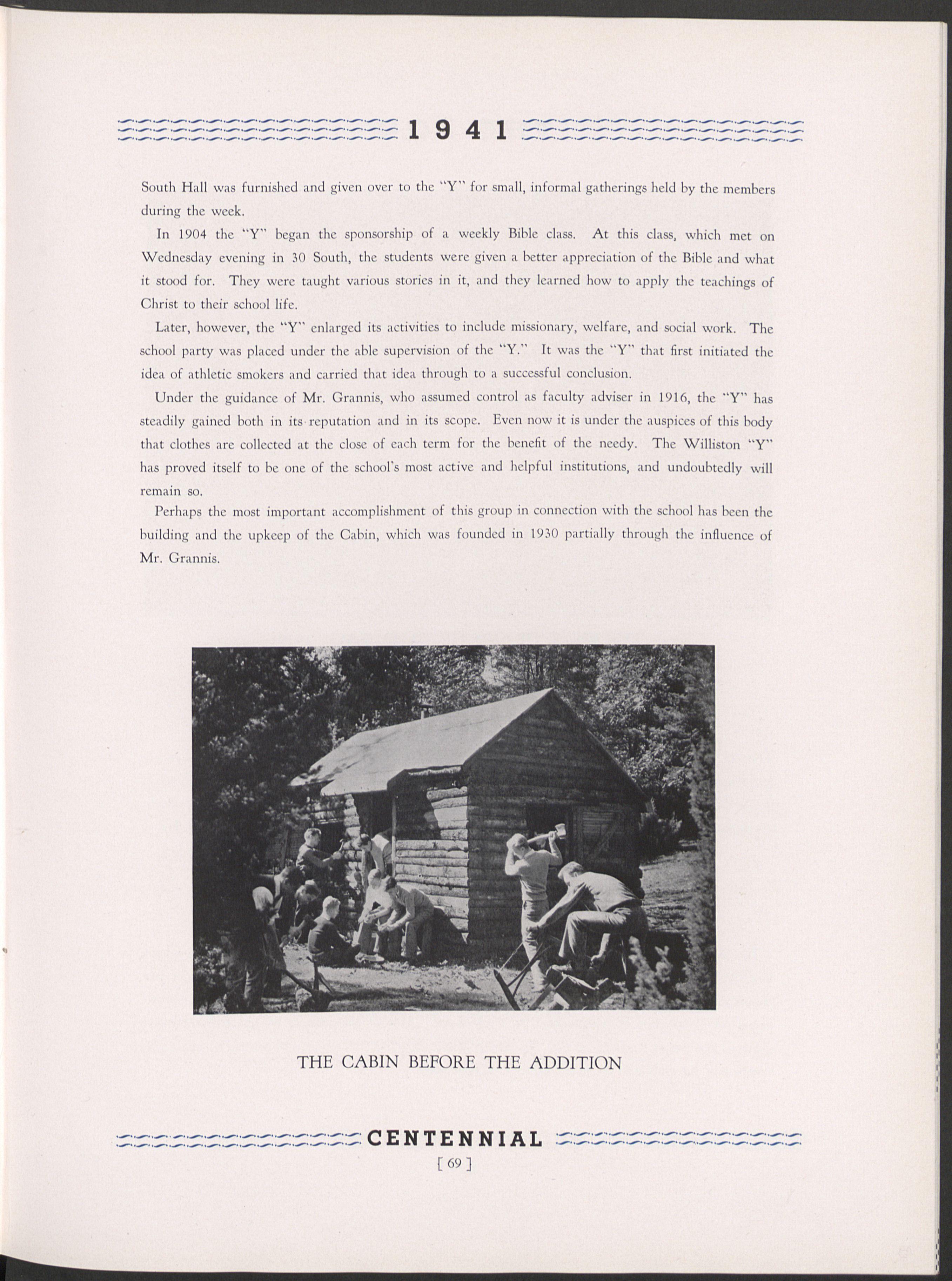
9 4 1
South Hall was furnished and given over to the "Y" for small, informal gatherings held by the members during the week.
In 1904 the "Y" began the sponsorship of a weekly Bible class. At this class, which met on Wednesday evening in 30 South, the students were given a better appreciation of the Bible and what it stood for. They were taught various stories in it, and they learned how to apply the teachings of Christ to their school life.
Later, however, the "Y" enlarged its activities to include missionary, welfare, and social work. The school party was placed under the able supervision of the "Y." It was the "Y" that first initiated the idea of athletic smokers and carried that idea through to a successful conclusion.
Under the guidance of Mr. Grannis, who assumed control as faculty adviser in 1916, the "Y" has steadily gained both in its reputation and in its scope. Even now it is under the auspices of this body that clothes are collected at the close of each term for the benefit of the needy. The Williston "Y" has proved itself to be one of the school's most active and helpful institutions, and undoubtedly will remain so.
Perhaps the most important accomplishment of this group in connection with the school has been the building and the upkeep of the Cabin, which was founded in 1930 partially through the influence of Mr. Grannis.
Top: Barnes, Outterson, Reed, Mayer, Landy, Sorton Center: N. Pike, N. Judd, S. Pike, Mr. L. J. Smith, Oechsner, Tackus First Row: Brown, Whitham, J. Dabney
Productions,

THIRTY MINUTES SWIMMIN' POOLS POOR OLD JIM OFFICER 666
FOR REFRESHMENTS Baker Forrest De Mills McHugh
The Williston Dramatic Club, which has long been one of the most active of the clubs in school, was first organized in the fall of 1919 by Laurence J. Smith, who served as its director. Under Mr. Howard Boardman, who assumed the directorship in 1921, the club has continued to grow and improve. It has for many years been subsidized by a school fee. Out of the receipts of this fund extensive electrical equipment has been added. The sets continue, however, to be built and painted by non•acting members of the club who do an extremely creditable job.
For the first few years of the club's existence, three productions a year were given: in the fall, in the winter, and at commencement time. The last was discontinued in 1923 because it was believed to be taking too much of the boys' school time. The other two productions, however, have been continuously presented except during a brief period between 1926-1929 when the winter full-length play was discontinued for the same reason. In their place, however, the club produced a series of one-act plays similar in number and type to three fall plays. Mr. Bard man felt that a higher degree of perfection could be reached in concentration on one-act plays.
In 1930 the club returned to its old policy of a three-act play. Mr. Boardman felt that the recognition of talent could be determined in the three fall productions, and that competence be concentrated in a three-act play for the winter term. That year — 1930 — the club produced the difficult "The Merchant of Venice," which will be remembered for the marvelous characterization of Shylock by Mr. Boardman. As given now, the fall and early spring productions offer a pleasant field of enjoyment and diversion during the school year.
Mr. Louis Palmer and Mr. Hervey Smith, who came to Williston in 1938 and 1939 respectively, have both since then directed one-act plays of their own in the fall, with Mr. Palmer directing the spring productions of 1939 and 1940.
Formerly the plays were produced in the Congregational Church vestry or in the town hall, but in 1930, with the completion of the Recreation Center, the plays have been presented on our own

Standing: Barnes, Dabney, N. Pike, Hartman, Reed, Blomfield Seated: Judd, Oechsner, Landy, Mr. L. J. Smith, Whitham, S. Pike, Cartmill
Front: Brown

Standing: Small, Bergen, Mr. H. G. Boardman, Coach; Whitham, Mariner Seated: Merian, Mayer, Chase, S. Pike, Doniger
(The first productions by Mr. Boardman)
Fall: Who Kissed Barbara?, The Highland Legacy, The Boob. Winter: Jane.
very adequate stage. This stage is assembled on the gymnasium floor and is replete with a curtain which reaches almost to the top of the gym. It has been rumored around the school that the assembling and dismantling of the rather complicated structure by the stage crew is something of an education in itself. The crew, it is said, operates with the rapidity and efficiency of circus workers. At any rate, a great deal of credit should go to these boys who have always worked behind the scenes.
Mr. Boardman, our director for the past 20 years, is eminently qualified to direct the school plays. He was, in 1921, president of the Colby College Dramatic Club and has had rather a varied career in summer stock companies and schools. In the summer of 1930, 1931, 1932, Mr. Boardman was theatre director of the "Ecole Champlain," a French camp for girls at Lake Champlain, Vt. He has continuously,
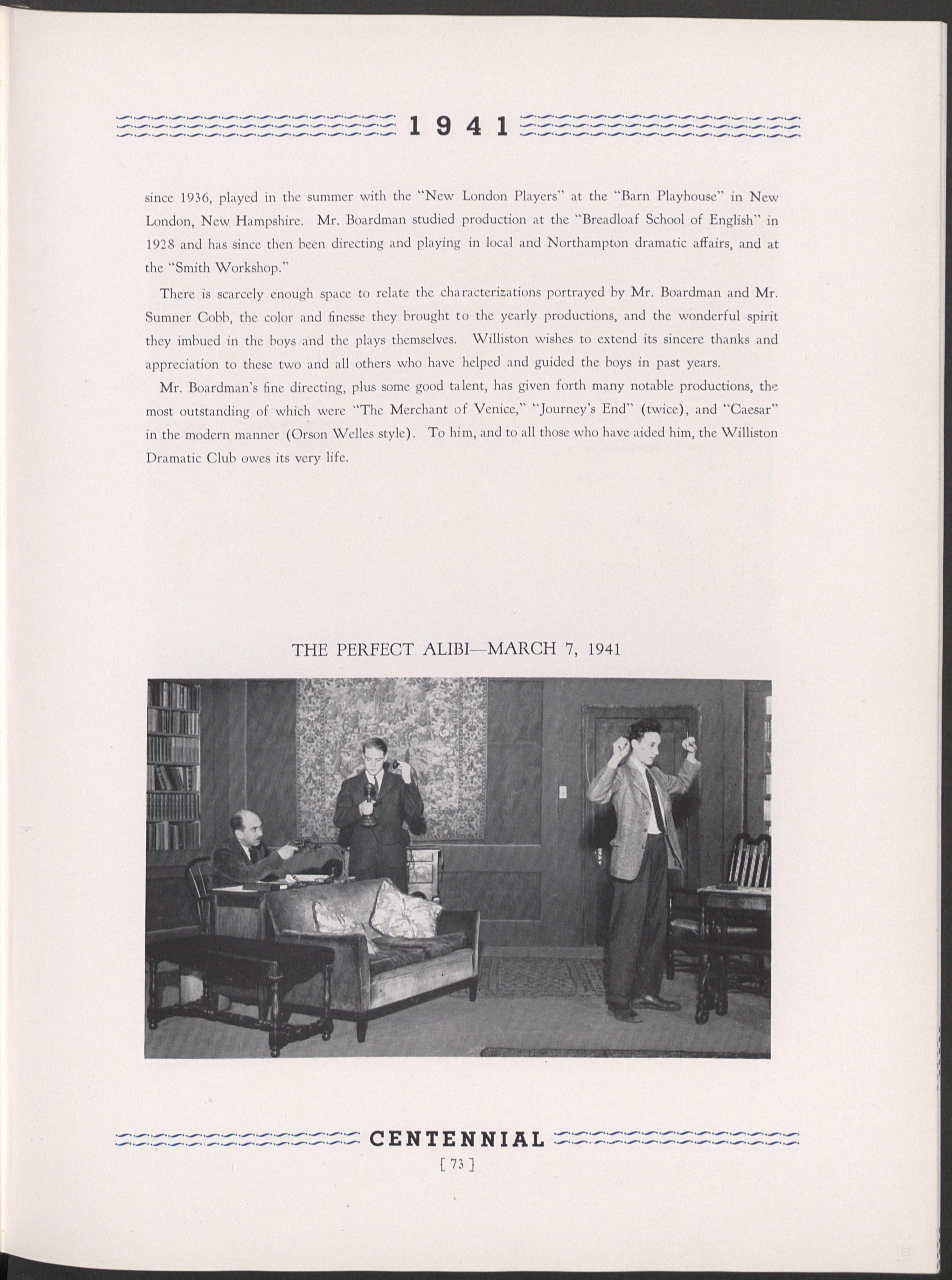
1 9 4 1
since 1936, played in the summer with the "New London Players" at the "Barn Playhouse" in New London, New Hampshire. Mr. Boardman studied production at the "Breadloaf School of English" in 1928 and has since then been directing and playing in local and Northampton dramatic affairs, and at the "Smith Workshop."
There is scarcely enough space to relate thc characterizations portrayed by Mr. Boardman and Mr. Sumner Cobb, the color and finesse they brought to the yearly productions, and the wonderful spirit they imbued in the boys and the plays themselves. Williston wishes to extend its sincere thanks and appreciation to these two and all others who have helped and guided the boys in past years.
Mr. Boardman's fine directing, plus some good talent, has given forth many notable productions, the most outstanding of which were "The Merchant of Venice," "Journey's End" (twice), and "Caesar" in the modern manner (Orson Welles style). To him,and to all those who have aided him,the Williston Dramatic Club owes its very life.

The Williston Student Council, founded in 1917, has survived to the centennial year to be one of the school's most respected organizations. It was first established as a small group of twelve students to represent the six fraternities and in that way to represent the student body as a whole. In the three years following its establishment it was made up of captains of the teams and presidents of the school's extracurricular organizations.
The Council, as it was first formed, proved to be unsatisfactory, for in 1922 the Student Council, realizing that it had no real authority, disbanded itself, calling for a complete reorganization of its powers and duties. This plan was carried out, and we now have an organization truly representative of the student body. The members are chosen by the Council itself from the student body with the ultimate sanction of the faculty, the representation being proportionate to the size of the dormitories. North Hall is represented by four members; Ford, by three; South, by two; Payson, by one; and the Day boys have one representative.

The Council's duties are of various kinds. It helps the faculty and the "Y" Cabinet in the supervision of morals and general conduct. It enforces various school rules, one of its most important duties being the enforcement of the honor system, begun by the Council's action in 1939. Among other activities of the Student Council was the planning of several tea-dances following football and basketball games..
The policy of the Student Council through the years has been the general improvement of the school. Being one of Williston's expressions of democracy, it has been of extreme importance in helping this school to a successful centennial.
In its twenty-four years of service the Student Council has been ably advised by various faculty representatives. The faculty advisers have been, in order, Mr. Hicks, Mr. Grannis, Mr. Godfrey, and Mr. Lossone. During this hundredth year in the existence of Williston Academy, Mr. W. J. Lossone has successfully presided over the organization in its Monday evening meetings.
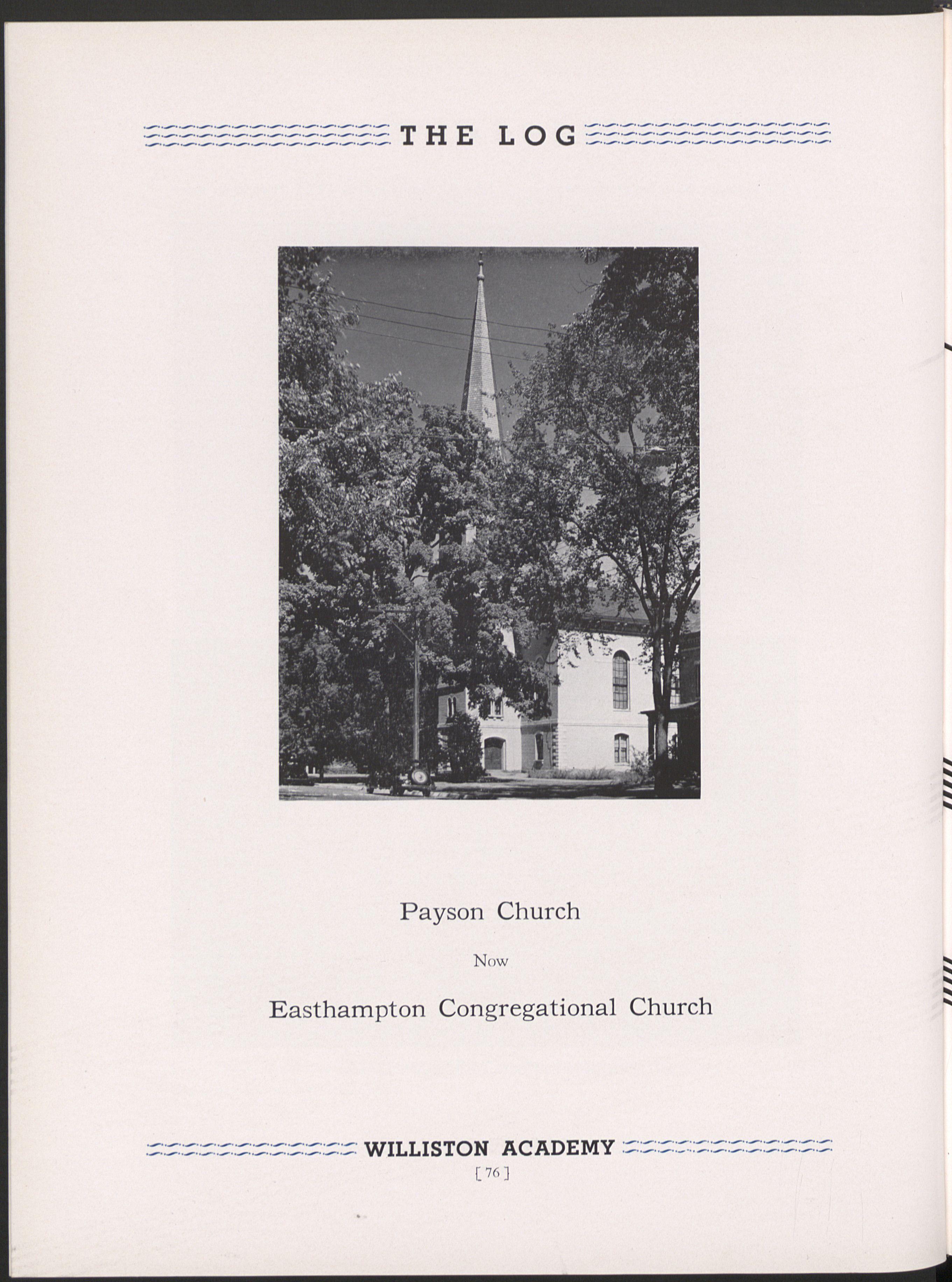


The athletic background of Williston is both long and notorious. Since 1841, when the school first opened its doors, there has been some form of sport or exercise which has held the interest of the students. Organized or unorganized, we gather from the history of the Seminary that athletics have always been an important, if not outstanding, part of the school life.
The first records known of Williston athletics are informal ones found during the first year of the school's existence, when the students spent the major part of their free time skating or fishing through the ice on Nonotuck Pond. Throughout that entire winter, this form of recreation was carried on under the advice, but not guidance, of Mr. Williston.
In the summer of 1842 athletic contests were formally entered into for the first time, and wicket and football became very popular. These games would seem very strange to us now, for they were no more than rough and tumble affairs in which the participants took a great deal more of the punishment than the ball did. Wicket, a game somewhat on the order of baseball, but far in arrears of it when finesse was called for, was played with any number of boys and with a ball similar to a rugby ball. Although these games might now be thought to have been detrimental to the health and physical well, being of the students, there were no reports of any serious injuries at any time. EARLY BASEBALL TEAM

Individual athletics and calisthenics were founded about the year 1845, just after the completion of Middle Hall. At the back of this building crossbars were raised, and a popular form of recreation became contests among the students. A large circular swing was built between Middle Hall and the Old White Seminary, four short bars were attached for hanging, and this form of sport became imme, diately popular. Evidently these diversions were the only form of sport participated in for more than five years, for no records can be found to prove otherwise.
An important change in athletics occurred in 1853, when the students of the Seminary instituted three boating clubs, and kept three boats, named Jris, Nereid, and Undine, at the Nashawaunuck Pond, where a boat club was built. Many contests were entered into with the three boats, and a spirited rivalry sprang up in the Seminary. No one seems to know what the outcome of these clashes was, for no records of any kind were kept. Very few outside contests were held, probably because of the difficulties involved in the transportation of the boats from pond to pond. Although this triangle club was successful it was short•lived, for the town boys, perhaps a bit envious of "those Willistons," demolished the boats and club house, bringing a close to the activities of the club for the time being.

as at any plat_
Any one having the above article for sale, will send it BY ExruEss,—"C. 0. D."—to
After several years, in 1877, the club reorganized, but the enthusiasm shown by the school as a whole was greatly diminished, and the club failed to become as popular by far as it had been before. Thus, in the following years, since absolutely no races were held, the club disbanded, and never again became prominent among the students.
From this time forward, athletics at Williston began to make transformations which would eventually lead to the compulsory sports which are such a fundamental part of the present school life. Football, as has been mentioned before, was one of the first of the athletics prominently known now, having been played since 1842. In its original state, football here, as at any other place at that time, was a game with no rules excepting those which the players wished to make, and these were few and very often not adhered to. There were no limits to the game whatsoever, and the rougher it became, the better the Willistonites seemed to like it.
In 1860 there was organized the first regular team in the school's history, which was called "The Williston Football Club," and about which little is known, with the exception that it lost to Wilbraham Academy in that first season. In 1864 all interest was seemingly lost in the sport, and it practically dropped out of the picture until 1879, when the country had swung in favor of it and Williston once more took it up actively.
After 1879 more and more enthusiasm and interest became centered around football, new rules were made, the game was almost completely organized in that it came under the guidance of coaches, and it became the most popular of all sports. At Williston, as at many other schools, this popularity has grown until today football is spoken of as the greatest game in the country.
The erection of the first preparatory school gym nasium in the country at Williston in 1864 made possible a much greater variety of activities in athletics. This building, then considered one of the finest in use in the East, was copied, at least as far as the tower was concerned, from the Palazio Vecchio in Florence, Italy, which assured the most beautiful architecture possible.

As the pictures show, the agitation for a new gymnasium had grown very strong from the year 1860 onward. At this time, more and more stress was being laid on the importance of physical exercise under the proper guidance and with regular organized equipment. For this reason, the gymnasium which was built was provided for in every possible way, affording for the first time ample space for the entire school body.

It was expected that the new building would prove very successful in it effort to build up the physical prowess of the school, and this soon was found to be true. Under compulsion, or in their own free time, the students flocked to the building which held the most interest and pleasure for them. Bars, chains, horses, mats, and all other imaginable equipment which could be used in a gymnasium, was always at the disposal of the students, who evidently took full advantage of this fact. For many, many years our Old Gymnasium has been the scene of all sorts of athletics, giving every student his chance to become a great athlete. For sixtrsix years it did its job well, a fact easily proved by glances into the records of various Williston teams in its time.
Although its actual duties are now taken over by the Recreation Center, the Old Gymnasium still sees a great deal of action, especially in the spring, when stage painting and carpentry interrupt its peace. In 1865, and for ten years after that, exhibitions of all kinds were held for the public, and these proved so popular that the school was forced to ex elude all those who did not have tickets from the
1 9 4 1

meets. It was at this time that prizes came into being, and these naturally caused a great deal more work and interest on the part of the students. Walking, leaping, running, rack bars, horizontal bars, pole and rope climbing, and Indian clubs formed the larger part of the show. Although these things may somehow seem trivial now, yet at that time it was one of the highest of school honors to excel in any one of the aforementioned. It is impossible to say just how many years this form of organized athletics was outstanding, but judging from the attention and audiences it drew, it must have been continued for many years.
Perhaps the introduction of baseball as a popular sport helped to speed the downfall of athletic exhibitions, for baseball has always held its position near the top in athletic fields. The first known form of baseball at Williston was called "round ball," and it was composed of as many fellows as wished to participate, with few rules and no "arbitrators," as our present referees were then called. This game reached its peak in about 1850, but very little was done towards organizing actual baseball before 1866 or 1867. From this period until somewhere in the eighties, however, it grew both in the finer points of the game, and in the everchanging interests of the students. In the middle eighties it was the most popular and honorable sport on the list, and throughout the years it has continued to be the main spring sport.
Athletic exhibitions as a whole have been spoken of before, but, while they were important in their time, they cannot be compared with our track and field events of today. The actual history of track is very vague, as far as the popularity of that sport was concerned. Perhaps there are those who are far better acquainted with its growth than we are. It is supposed, however, that track is one of the outgrowths of the annual Old Gym exhibitions, and that in some way it broke off from the others and became an organized outdoor activity. Sufficient to say that Williston men have always taken a great deal of pleasure in participating in it, as may be seen by the track and field records which follow:
100-yard dash
dash
880-yard run

seconds
R. H. King, '32 1932
R. H. King, '32 1932
L. N. Brown,'12
min. 3.3 sec. W. A. Gaylor,'40 1939 One-mile run
min. 34.2 sec.
Two-mile run 10 min. 32 sec.
120-yard high hurdles
220-yard low hurdles
seconds
H. A. Herzog, '16 1915
E. Leitch, '04 1903
E. A. Suck, '27
J. S. Balloch, '32 1927 1931
A. S. Perry, '27 1927 70-yard high hurdles
120-yard low hurdles
seconds
High jump 5 ft. 10 in.
J. H. MacNaughton, Jr., '41 1940
J. S. Balloch, '32 1931
D. E. Lewis,'29 1929 WILLISTON ACADEMY
Broad jump
Pole vault

J. S. Balloch, '32
T. O'Neil,'10
D. E. Lewis,'29
G. W. Bailey, Jr., '35 1931 1910 1929 1935 16-pound shot
H. Thomas, '04 1901
H. Thomas, '04 1903 16-pound hammer
12-pound hammer
Discus
One-mile relay
880-yard relay
H. Thomas, '04 1901
H. Thomas, '04 1903
G. M. Wharton,'36 1936
G G. M. Wharton,'36 1936
Team of 1901 1901
J. R. Barry,'37 1937
W. A. O'Hearn, Jr., '38
D. C. Frandsen, '37
S. M.Pond,'37

This, then, short and inefficient as it may be, is the history of Williston athletics as we find it at this time. Williston has long been ranked high scholastically as a preparatory school. Not quite as well known, but almost as important, is its athletic rating which is just as high and with which has always been associated fair play and good sportsmanship.
Thus we may see that in track; as in all other types of athletics, Williston students have won many honors, both in the school itself and in competition with outside teams. Track, although it is the last mentioned, is by no means any less popular or highly rated than any of the other sports functions of the school, and is classified today as a major spring sport.
Soccer, hockey, basketball, and tennis, although they have not the lengthy recorded history of these other sports, cannot be forgotten. All major sports, they have certainly played a large part in the building of better athletes at Williston. Their starting dates are for the most part either forgotten or never known, but this fact takes nothing away from their popularity or importance. In these sports, also, Williston has ever been able to compare honorably with any teams from schools of her class.
Always near the top in athletics as in scholastics, Williston should be proud of the teams which have represented her since she first opened her doors.




The Williston Alumni Office, under the supervision of Mr. Howard Boardman, has just completed the busiest season since its inauguration. With a mailing list of 3,200, it is no small task to edit, publish, and send out the Williston Alumni Bulletin four times a year. But this is only a small part of the work as alumni secretary.
This year, because of our centennial, this office has been especially active in the collection of historical data and pictures, many of which appear in this book. In addition to this, the usual reminders of commencement, dinners, various activities, and many other things must be sent to the alumni. Mr. Boardman, with the help of Miss Campbell, has done a great deal of work in an effort to make our celebration a complete success.
The Alumni Office itself has been recently remodeled and refitted. Splendid new furniture, a gift in memory of Sidney Nelson Morse, makes the room very attractive. Adorned on all sides by various pictures and gadgets of interest, it has this year been one of the most important parts of Williston.
In recording the history of Williston's first century, the "Log" has for forty years been an outstanding agency. No other single source has yielded so rich a record of the last four decades of Williston alumni. Should our complete files of the school's year book be destroyed, the efficacy of the Alumni Department would be irremediably impaired.
To the Class of 1941 who sponsors, to the Board which produces, and to the Adviser who guides this Centennial volume of the "Log," the Alumni Department extends cordial good wishes and congratulations.
Alumni Secretary.

The year 1891 was the fiftieth anniversary of the founding of Williston. In the annual business meeting of the trustees in April, 1890, the board had voted that this semi-centennial should be celebrated in June of the folloWing year, and a committee consisting of A. Lyman Williston, the president of the board; M. F. Dickinson, Esq., and Professor Henry M. Tyler, together with the principal, Dr. Gallagher, and Joseph H. Sawyer of the faculty, were appointed to make arrangements. During the summer and winter of 1890,1891 effort was made to learn the residence of former pupils of the school, and important additions to alumni records resulted.
In the early spring of 1891 school dinners were given and reunions held in convenient centers. At these dinners and reunions, many spoke not only cheerfully and hopefully, but with sincere confidence for the future of the school.
The semi-centennial celebration, in 1891, began on Sunday, June 14, with a sermon in Payson Church by Rev. Lyman Abbott, D.D. Monday and Tuesday, June 15 and 16, were occupied with various exercises of the closing school year. Wednesday, June 17, was the day chosen for the observance of the fiftieth anniversary in the life of the school. It was a day full of appointments and interest. The usual exercises of Founders' Day were set for nine o'clock. The school went in a body to Main Street Cemetery and decorated the graves of Mr. and Mrs. Williston. An ode, since adopted as the Williston hymn, was sung. The piece was written for the occasion by Irving Bruce, a member of faculty and class of 1878. At half past ten there were exercises at which the presiding officer was A. Lyman Williston, a nephew of the founder and president of the Board of Trustees, class of 1853. Other addresses were given, and the Germania Band of Boston furnished music for the day.
The dinner, served in the town hall, lacked nothing in quantity, quality, or in the number of guests. Five hundred were entertained, filling the hall to capacity. Various other receptions and reunions filled out the remainder of the day, which finally closed with a general reception in the Public Library from eight to ten o'clock in the evening.

Dr. Henshaw and some of his Toysat the semi -centennial, 1891
SATURDAY MAY 17
10:00 A.M.
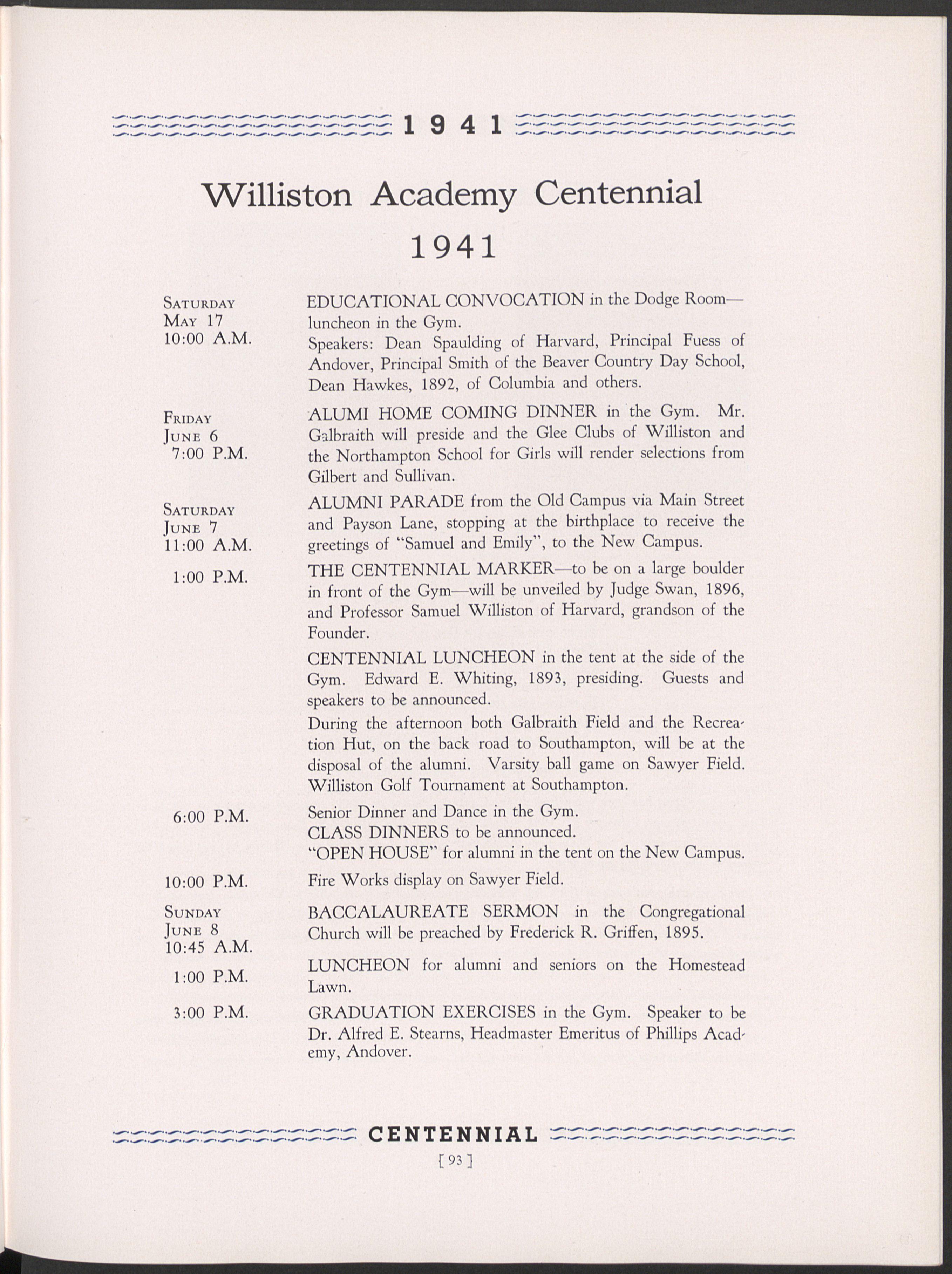
FRIDAY JUNE 6
7:00 P.M.
SATURDAY JUNE 7
11:00 A.M.
1:00 P.M.
EDUCATIONAL CONVOCATION in the Dodge Room— luncheon in the Gym.
Speakers: Dean Spaulding of Harvard, Principal Fuess of Andover, Principal Smith of the Beaver Country Day School, Dean Hawkes, 1892, of Columbia and others.
ALUMI HOME COMING DINNER in the Gym. Mr. Galbraith will preside and the Glee Clubs of Williston and the Northampton School for Girls will render selections from Gilbert and Sullivan.
ALUMNI PARADE from the Old Campus via Main Street and Payson Lane, stopping at the birthplace to receive the greetings of "Samuel and Emily", to the New Campus.
THE CENTENNIAL MARKER—to be on a large boulder in front of the Gym—will be unveiled by Judge Swan, 1896, and Professor Samuel Williston of Harvard, grandson of the Founder.
CENTENNIAL LUNCHEON in the tent at the side of the Gym. Edward E. Whiting, 1893, presiding. Guests and speakers to be announced.
During the afternoon both Galbraith Field and the Recreation Hut, on the back road to Southampton, will be at the disposal of the alumni. Varsity ball game on Sawyer Field. Williston Golf Tournament at Southampton.
6:00 P.M.
10:00 P.M.
SUNDAY JUNE 8
10:45 A.M.
1:00 P.M.
3:00 P.M.
Senior Dinner and Dance in the Gym.
CLASS DINNERS to be announced.
"OPEN HOUSE"for alumni in the tent on the New Campus.
Fire Works display on Sawyer Field.
BACCALAUREATE SERMON in the Congregational Church will be preached by Frederick R. Griffen, 1895.
LUNCHEON for alumni and seniors on the Homestead Lawn.
GRADUATION EXERCISES in the Gym. Speaker to be Dr. Alfred E. Stearns, Headmaster Emeritus of Phillips Academy, Andover.
"Semper Fidelis ad Scolam"
Verse 1 (Cornell Song Tune)
Hail our noble Alma Mater, Hear thy foster sons Who for fame would never barter, Dear old Williston. Here, our long lost classmates meeting, Joyfully we come. Here, thy sunlit campus greeting, Hail to Williston!

Verse 2
Thine, the homage Thine, the honor
Loyal sons are we Mindful of thy watchword ever "Christo et ecclesiae"
Love for thee our whole life lasting Till the setting sun
Midst its feasts, or prayerful fasting, Hail to Williston!
CHORUS:(Yale "Amici" Chorus Tune)
"Semper fidelis ad scolam,"
To old Sammy true Loyal hearts to Alma Mater Ever shall renew.
Verse 3
Manhan's waters gently flowing Hundred years agone Since our Founder left us owing Thee, 0 Williston God preserve thee for the future, As the years roll on Fortune fair, beyond comparing, Hail to Williston!
EDWARD R. EASTON, Williston '09.
Story of the Centennial Song
The above song has been submitted as the Centennial song of 1941, and was first sung at the New York annual dinner, February 21, 1941, where the author, Dr. Edward R. Easton, of the class of 1909, was elected president of the New York Association for the coming year. Dr. Easton has explained his sources in the following paragraph.
Just before the outbreak of the Civil War, an obscure song writer, H. S. Thompson, published in Boston a sentimental ballad of the Old South on the order of "Darling Nellie Gray," entitled "Annie Lisle." The music is traditional and probably originated in Merry England, the Emerald Isle, or Mittel-Europa. To the last three generations of Cornell and Yale men, this tune is quite familiar, to former as "Far Above Cayuga's Waters," and to the latter as "Amici." In writing this song for the Centennial Celebration, Dr. Easton felt that it was far preferable to select such a tune which has been adopted also by many other colleges and schools than to attempt in such a short time to introduce new and original music. The verses have been written to be sung to the music of the Cornell "Alma Mater," while the chorus was arranged for the more spirited music of the Yale song, "Amidi Usque Ad Aras."
Herbert B. Howe Class of 1901
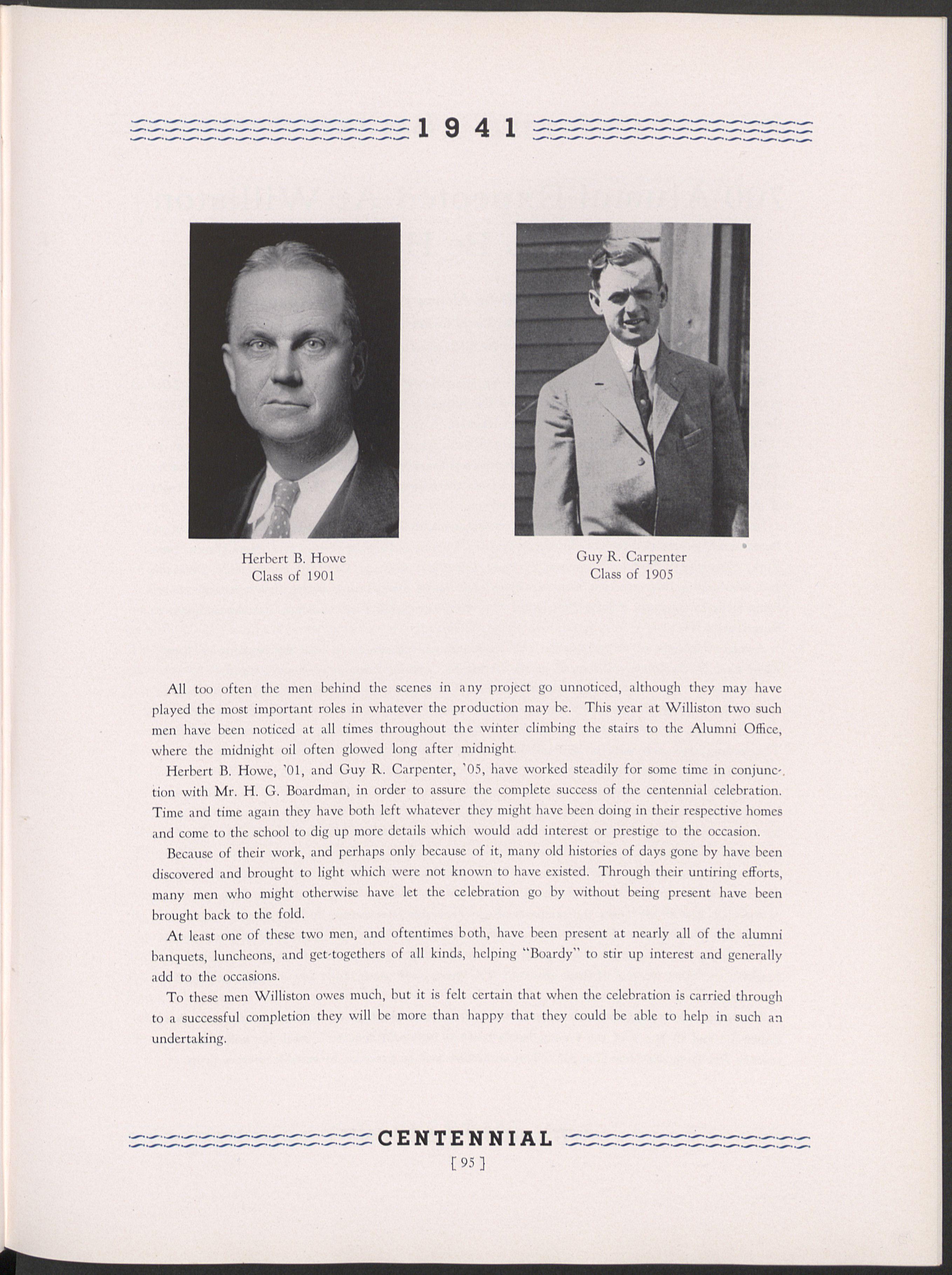
Guy R. Carpenter
of 1905
All too often the men behind the scenes in any project go unnoticed, although they may have played the most important roles in whatever the production may be. This year at Williston two such men have been noticed at all times throughout the winter climbing the stairs to the Alumni Office, where the midnight oil often glowed long after midnight.
Herbert B. Howe, '01, and Guy R. Carpenter, '05, have worked steadily for some time in conjunc-, tion with Mr. H. G. Boardman, in order to assure the complete success of the centennial celebration. Time and time again they have both left whatever they might have been doing in their respective homes and come to the school to dig up more details which would add interest or prestige to the occasion.
Because of their work, and perhaps only because of it, many old histories of days gone by have been discovered and brought to light which were not known to have existed. Through their untiring efforts, many men who might otherwise have let the celebration go by without being present have been brought back to the fold.
At least one of these two men, and oftentimes both, have been present at nearly all of the alumni banquets, luncheons, and get•togethers of all kinds, helping "Boardy" to stir up interest and generally add to the occasions.
To these men Williston owes much, but it is felt certain that when the celebration is carried through to a successful completion they will be more than happy that they could be able to help in such an undertaking.

Celebration Highlight Will Be Alumni Parade With Returning Classes Seeking To Outdo Each Other Thru Novel Features; Century Boulder To Be Unveiled on New Campus
Widespread response to invitations now being issued by Williston Academy for its Centennial Celebration next June 6, 7, and 8 already assures the success of another anniversary celebration for which the institutions of the Connecticut Valley are famous.
So great is the interest among the alumni and so many are the suggestions for "added features" to the program already announced that Easthampton's police officials are considering ways and means by which the usual heavy traffic can be diverted from the famous College Highway which passed in front of the campus of the famous old preparatory school.
In response to invitations from alumni representatives, the Board of Trustees and Alumni Secretary Boardman have attended reunion dinners in Boston, Worcester, Holyoke, Springfield, New Haven, New York, Philadelphia, Buffalo, Rochester, Syracuse, Cleveland, Chicago, Hartford, Schenectady, Pittsfield, and Washington during recent months. From enthusiastic pledges made at that time arrangements are being made to entertain at least 700 alumni who with their families will swell the attendance figures to more than 1,000.
A major highlight of the celebration will be the alumni parade to be held the morning of June 7 when staid Easthampton will see one of the largest of marching hosts in the town's history.
The class of 1905 will have the famous Nonotuck Drum Corps and it is believed that other organizations will be engaged before many weeks. At one point in the morning's program the paraders will witness a scene on an outdoor stage at the birthplace of Samuel Williston, founder of the Academy. The leading characters will be Mr. and Mrs. Williston to be played by prominent members of the community.
A boulder bearing a bronze plaque setting forth the completion of "One Hundred Years of Service" by the institution will be unveiled on the so-called "New Campus" by Professor Samuel Williston, for years dean of the faculty of Harvard Law School, and a descendant, through adoption, of the Academy's founders.
A somewhat more impressive feature will follow when the class of 1891, famous in school annals for the strenuous battle they waged in October, 1889, with the class of 1892, the occasion being the raising of the class flag of 1891 over the ramparts of the venerable Gymnasium Building, long a landmark of the town. This battle waged for hours, starting about 2:30 o'clock on the morning of October 26.
The class of '91 had designed a large flag of blue and gold,colors, the school colors, with cross-bats, a baseball, and other insignia of their prowess. The gymnasium tower is 101 feet in height and the battle was waged on the winding staircase.
This June the victorious class holds its 50th reunion celebration in connection with the school's centennial and in honor of the famous battle back in 1889 will dedicate a steel flag pole rising some seventy feet from the New Campus. This dedication will be preceded by suitable military drills.

The actual address of dedication will be delivered by one of Williston's best known orators, P. J. Garvey of Holyoke, a member of the class of 1892. William L. Pitcher, of Easthampton, of the class of '91, will direct the raising of the large American flag, to be followed with the raising of the original flag of '91, recently the subject of considerable repair work by one of Easthampton's better-known couturieres. One of those who will lend a hand on the ropes will be Harry Stoddard Williston of the class of '91, a descendant of one of Samuel Williston's brothers, J. P. Williston of Northampton, founder of the famous Payson Indelible Ink Co. It is also planned that Harry Stoddard Williston, 3rd, aged one year and seven months, will be a witness, being the youngest of the Williston line.
The week of the celebration will see the buildings of Williston decorated in special gold and blue hunting and special window decorations will be provided for business houses and residences. Every vacant bed in the town is being listed and as rapidly spoken for by some ardent alumnus who wants once more to sleep on the banks of the Manhan River and awaken to the songs of the June birds.
Williston is famous among preparatory schools for a number of traditions bearing upon the treatment of the new boys who arc known as "buckwheaters" or "bucks." The first record of the use of the term is in 1878. The word is good old American slang for a "green hand at lumbering," and it is believed that the word was picked up by students from lumbering crews floating logs down the Connecticut to the Holyoke mills.
The program will also feature alumni golf matches, alumni and school baseball game. The Boston alumni have challenged the New York alumni to a softball game and a number of classes will entertain at special headquarters.
The big day of the gathering, June 7, will be broken by a luncheon in a huge tent to be erected on the new campus. This luncheon, scheduled to begin at 1 P.M., will probably last most of the day as many alumni occupied in reminiscences will entirely forget the concluding half of the day's program. This tent, however, will be used as registration headquarters and a meeting place throughout the three days, so that the reunioners can reassemble there all day on Sunday, when the undergraduates will be busy with their graduation exercises.
Williston Academy has always been fortunate in having among its faculty one or more men who preserved the records of undergraduate life. A not able exhibition of old photographs and mementos of the olden days will be on exhibition and this collection is being augmented daily because alumni, roused by the approaching celebration, are searching attics for scrapbooks and other records which have long gathered dust.
A complete summary of the history of the school together with the events of the celebration will be printed by the Holyoke Transcript-Telegram. This will provide the visitors with a valuable memento of their trip to Easthampton and at the same time will combine the best of all that has been written in the past of the school. This year the Williston "Log," annual year book of the students, will contain more than 300 pages and by historical reviews will supplement the Anniversary Celebration Edition of the Transcript-Telegram.
Arrangements for the three-day outing are being planned by a committee of the Board of Trustees. The committee members are: Philip L. James, '93, chairman of New York; Herbert E. Hawkes, '92, also of New York; Carl A. Gray of Hartford; Ogden D. Miller, '26, of New Haven; and Herbert B. Howe,'01, secretary, and now of Mt. Kisco, N. Y.
This committee is assisted by a large committee of alumni serving in both active and honorary positions, every graduation from 1890 to 1937 being represented.

Annual Dinner of N. Y. Alumni Association, February 21, 1941
Commemoration of the 100th Anniversary of the Incorporation of Williston Seminary, February 22, 1841.
Chief speakers at head table: Dean H. C. Hawkes, '92, Toastmaster: Principal A. V. Galbraith: President -
Emeritus James R. Angell, Yale University.

Preparations for a celebration of any kind naturally involve a great deal of work from those upon whose shoulders rest the troublesome burdens of the planning, time, and effort necessary for the success of the occasion. Our centennial celebration is certainly no exception to this, and except ror the excellent co-operation of those in charge of the various branches, there could be no pos3ible chance of having anything but a complete failure. For this reason, then, we of the Senior class would like to extend our heartfelt thanks to the members of those committees who were so instrumental in carrying through our celebration in such a highly satisfactory manner. So that you may know who these men are, we print their names in recognition of the loyal service which they have shown to Williston.
New York Alumni Association
Henry H. Keough,'05, President
James L. Carpenter, '33, Secretary
Boston Alumni Association
Edward C. Bowen, '06, President
Joseph D. Harrington, '19, First Vice-President
John Ganley,'13, Second Vice-President
Benjamin Sands, '29, Secretary-Treasurer
Hartford Alumni Association
Charles S. Rust,'26, President
Edward H. Deming,'08, Vice-President
Alfred Gengras, '28, Secretary
Ernest P. Backofen,'20, Treasurer
Worcester Alumni Association
Frank B. Whittemore,'37, Co-Chairman
Lebbeus S. Case,'34, Co-Chairman
Harold T. Sargent, Jr., '37, Secretary
Alumni Associations are in process of organization in Philadelphia, Pittsfield, and the Connecticut Valley.
12'C'Stand-UP Song of WILLISTON ACADEMY Easthampton, Mass.

Gymnasium Tower Built 1863-65
Words and MUJiC by Paul H. Johnson, Class of 1905
Johnson
Arrangement by C. E. Rouse and F. B. Hyde
of Williston Faculty

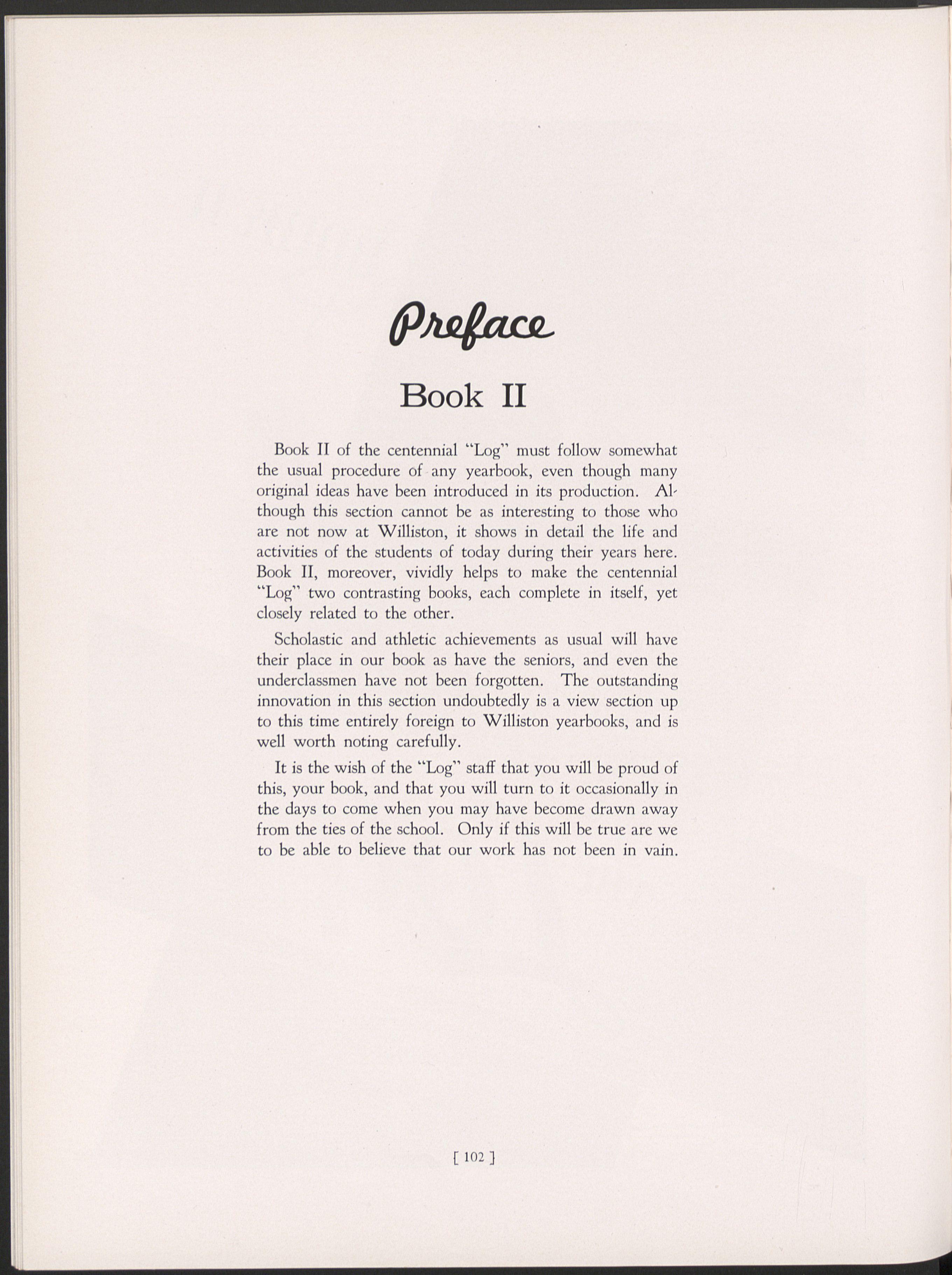
Book II of the centennial "Log" must follow somewhat the usual procedure of any yearbook, even though many original ideas have been introduced in its production. Al, though this section cannot be as interesting to those who are not now at Williston, it shows in detail the life and activities of the students of today during their years here. Book II, moreover, vividly helps to make the centennial "Log" two contrasting books, each complete in itself, yet closely related to the other.
Scholastic and athletic achievements as usual will have their place in our book as have the seniors, and even the underclassmen have not been forgotten. The outstanding innovation in this section undoubtedly is a view section up to this time entirely foreign to Williston yearbooks, and is well worth noting carefully.
It is the wish of the "Log" staff that you will be proud of this, your book, and that you will turn to it occasionally in the days to come when you may have become drawn away from the ties of the school. Only if this will be true are we to be able to believe that our work has not been in vain.


This book is affectionately dedicated to Headmaster
In admiration of his character, which has ever been an inspiration to the members of this class,
In gratitude for his influence, which has made our stay at Williston a pleasant one,
In appreciation of his deep and loyal interest in all of our school activities,
In our belief that under his guidance Williston has advanced in every respect.


Attractive in Summer

Decorated in Winter
ADMINISTRATION LABORATORIES
— BUSINESS RECITATIONS
The Walk
Back Door
Debating

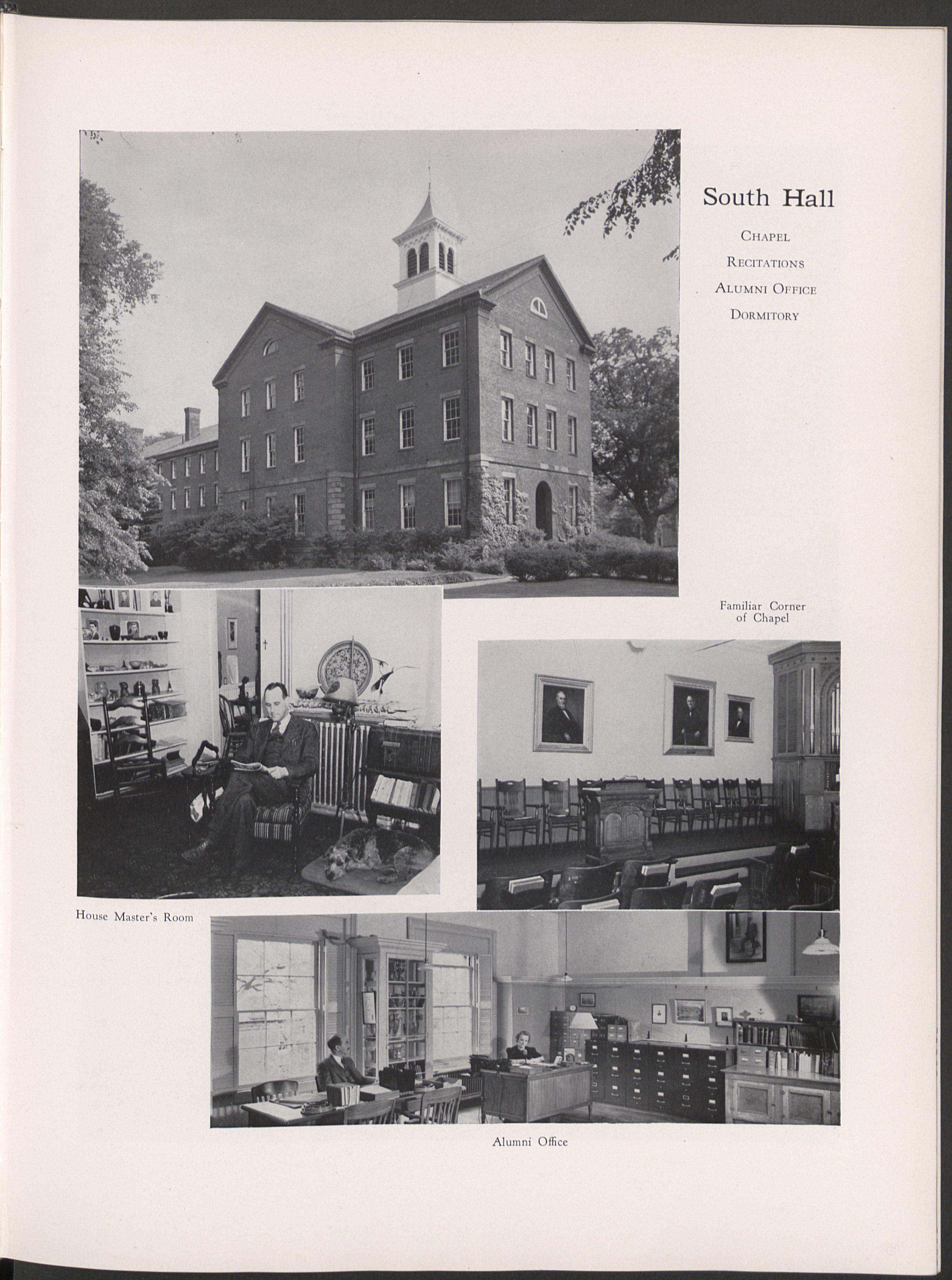
South Hall CHAPEL
RECITATIONS
ALUMNI OFFICE
DORMITORY



DORMITORY
Old Campus Landmark

New Campus
Reflections


May 17, 1941 in celebration of
Williston Centennial at Recreation Center
Williston Academy
Easthampton, Massachusetts

Morning Session, 10:30
Presiding—HERBERT B. HOWE, Trustee of Williston Academy and Secretary of the Centennial Committee.
SPEAKERS
DR. CLAUDE M.FUESS, Headmaster, Phillips Academy, Andover. As the Twig Is Bent
DR.EUGENE RANDOLPH SMITH,Headmaster, Beaver Country Day School, Brookline. So the Tree Inclines
Luncheon, 12:30
Presiding — ARCHIBALD V. GALBRAITH, Headmaster, Williston Academy.
SPEAKER
DR. WILLIAM C. HILL, Principal, Classical High School, Springfield. Gold Is Where You Find It
Afternoon Session, 2:30
Presiding—JUDGE THOMAS W.SWAN, President of the Board of Trustees of Williston Academy.
SPEAKERS
DR. FRANCIS T. SPAULDING, Dean, Graduate School of Education, Harvard University. The Liberation of the Preparatory School
DR. HERBERT E. HAWKES, Dean, Columbia College, Trustee of Williston Academy. From School to College

INCORPORATED FEBRUARY 22, 1841
SAMUEL WILLISTON EMILY GRAVES WILLISTON
Born June 17, 1795. Died July 17, 1874
Born June 5, 1797. Died April 12, 1885

JUDGE THOMAS W. SWAN, LL.B., '96, President . New York
WILLIAM L. PITCHER,'91, Treasurer Easthampton
JOHN L. HALL, LL.B., '90 . Boston
PHILIP L. JAMES, A.B., '93 ▪ . New York
EDWARD L. SHAW, LL.B.,'95 . . Northampton
DEAN HERBERT E. HAWKES, PH.D., 192 ▪ . New York
JUDGE THOMAS J. HAMMOND, LL.B.,'96 ▪ Northampton
REVEREND JAMES GORDON GILKEY, D.D. Springfield
EDWARD E. WHITING, A.B.,'93 Newtonville
WALLACE R. LANE, LL.B., '96 . . Chicago
PROFESSOR JULIUS SEELYE BIXLER, PH.D. Cambridge
CHARLES W. WALKER, A.B., '96 Northampton
HERBERT B. HOWE, M.A.,'01 . Mount Kisco
OGDEN D. MILLER, PH.D.,'26 . . New Haven
GEORGE S. STEVENSON, A.M. . Hartford
CARL A. GRAY, B.S. . Farmington
LAUREN D. LYMAN,'12 . New York
JAMES H. MACNAUGHTON,'09 . Boston
DANIEL MUNGALL, J.D., '06 . Philadelphia
FRANK J. SCRIBNER,B.D.,'05 . . New York
ARCHIBALD V. GALBRAITH, A.B., Secretary Easthampton
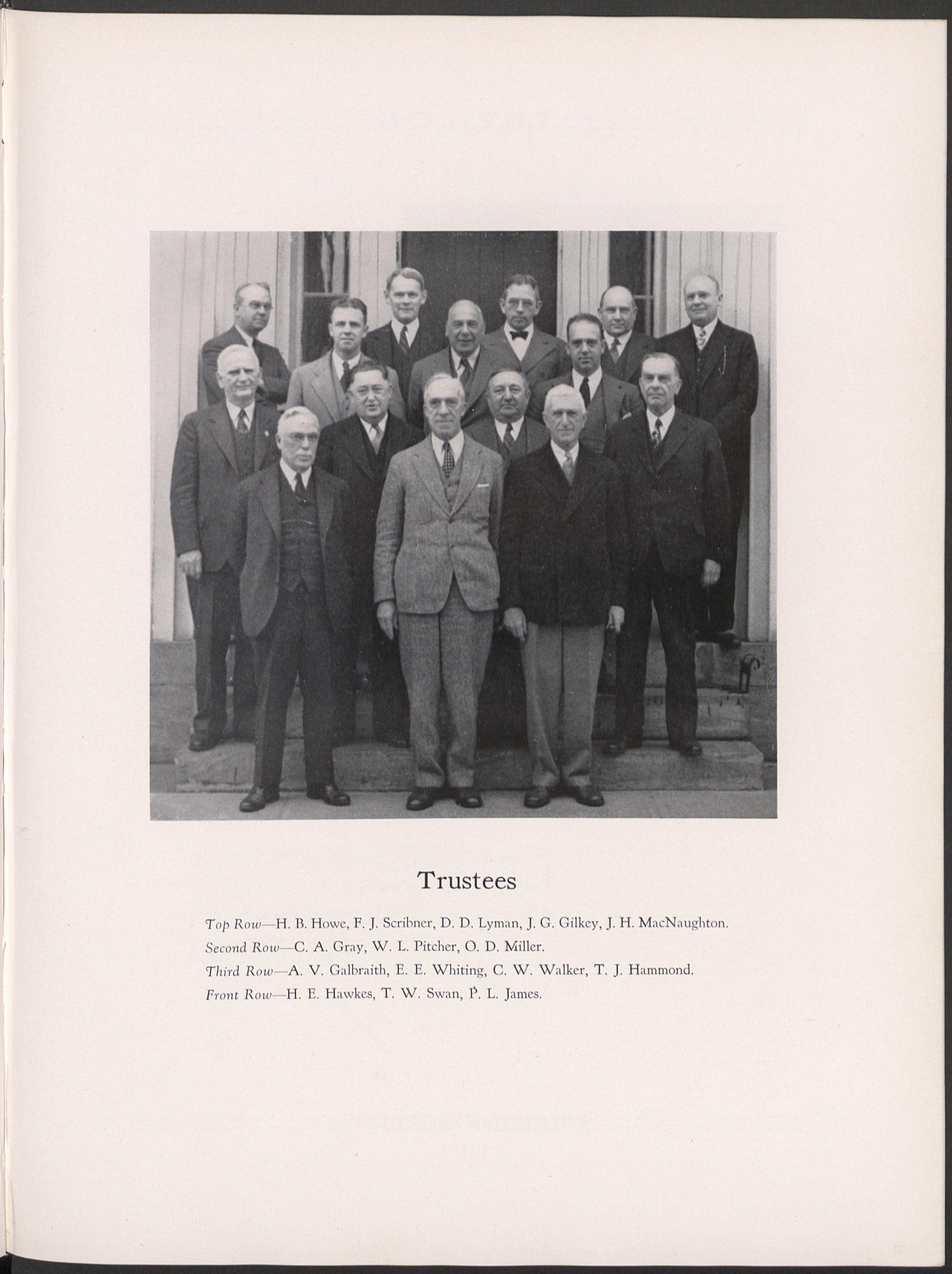
Top Row—H.B. Howc,F. J. Scribner, D. D. Lyman, J. G. Gilkey, J. H. MacNaughton.
Second Row—C. A. Gray, W. L. Pitcher,0. D. Miller.
Third Row—A. V. Galbraith, E. E. Whiting, C. W. Walker, T. J. Hammond.
Front Row—H. E. Hawkes, T. W. Swan, P. L. James.
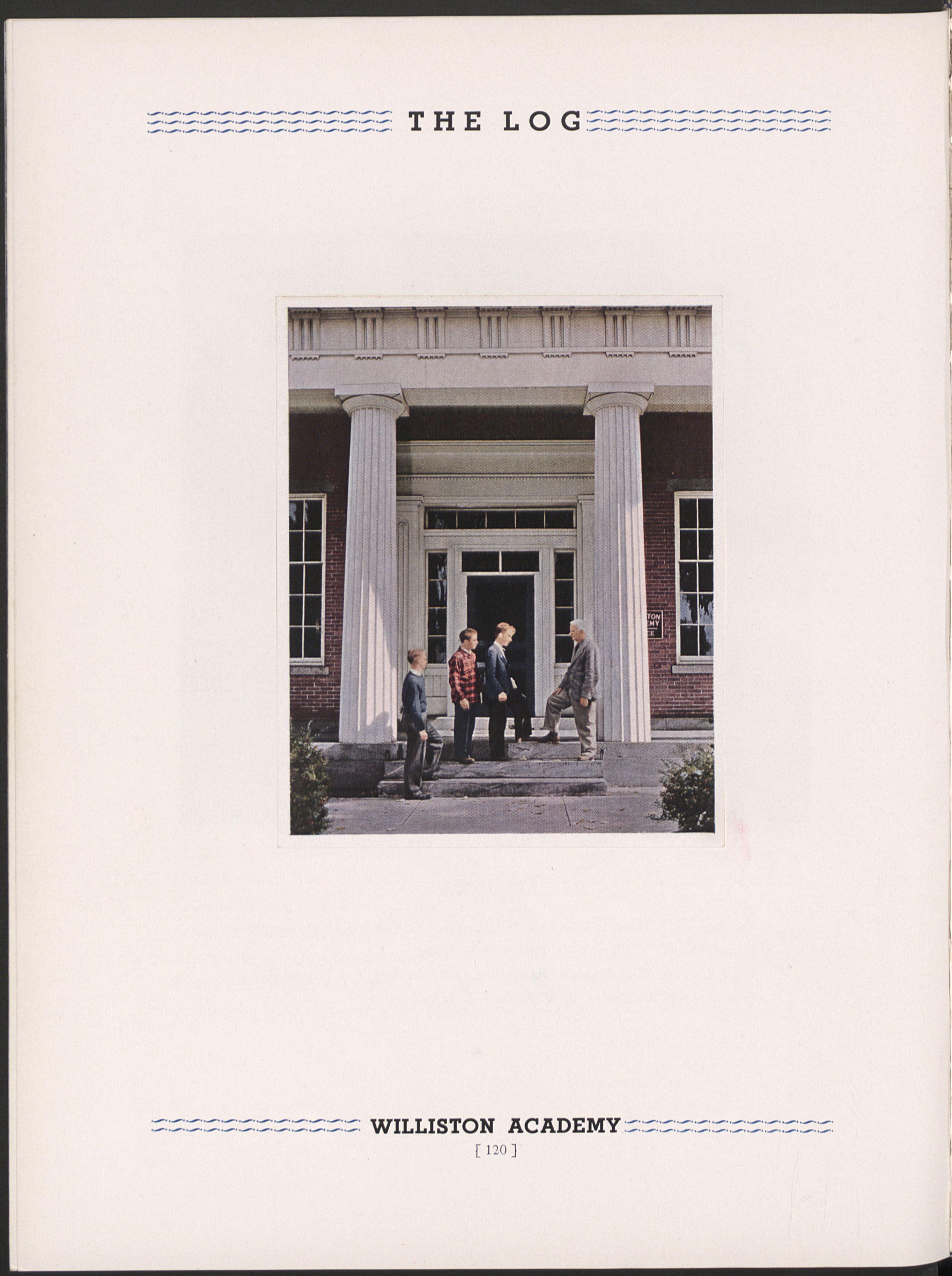
Archibald Victor Galbraith, A.B. Principal

IN making preparations for the Williston Centennial, it has been borne in upon me with new force how valuable is the record of contemporary school life which the "Log" presents so fully and so attractively. I offer my congratula, tions to all those who have participated in making this Centennial issue the admirable volume it is.


LINCOLN DEPEW GRANNIS, M.A.
Latin "Granny"
Graduated Yale, B.A., 1906;Yale, 1925, M.A.;Cincinnati University Teachers' College, 1908,09; Principal of Milford High School, Milford, Ohio, 1906,09; Summer Course, Berlin, Germany, 1913; served in the Y.M.C.A. overseas 1918,19; Director of School Y.M.C.A. since 1915; member of the Classical Association of New England; member of the Classical League; studied at Yale first half year 1938,39 in Classified Depart, ment; elected to Williston 1910.
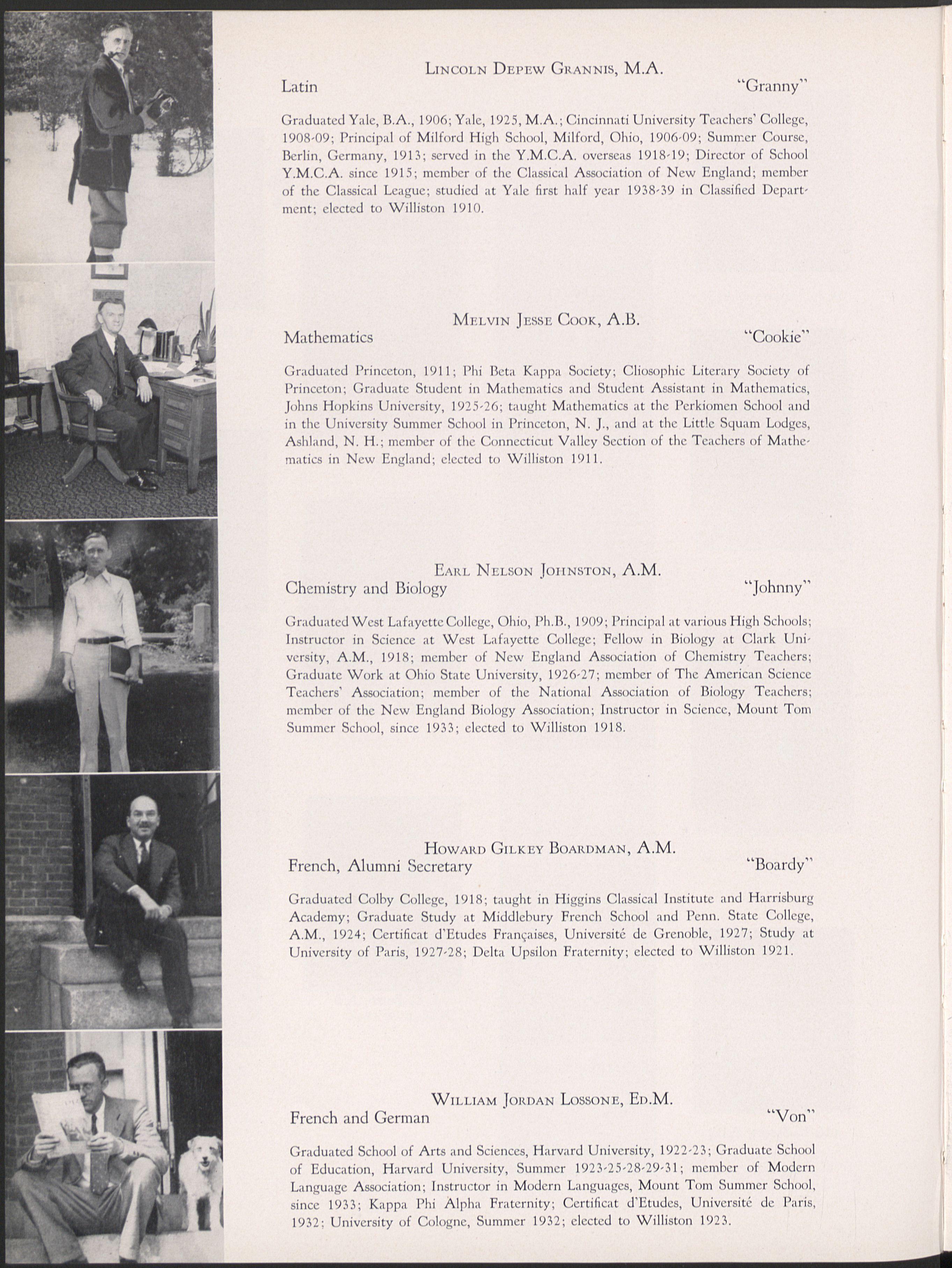
MELVIN JESSE COOK, A.B. Mathematics "Cookie"
Graduated Princeton, 1911; Phi Beta Kappa Society; Cliosophic Literary Society of Princeton; Graduate Student in Mathematics and Student Assistant in Mathematics, Johns Hopkins University, 1925,26; taught Mathematics at the Perkiomen School and in the University Summer School in Princeton, N. J., and at the Little Squam Lodges, Ashland, N. H.; member of the Connecticut Valley Section of the Teachers of Mathe, matics in New England; elected to Williston 1911.
EARL NELSON JOHNSTON, A.M. Chemistry and Biology
61.Johnny,
Graduated West Lafayette College, Ohio, Ph.B., 1909; Principal at various High Schools; Instructor in Science at West Lafayette College; Fellow in Biology at Clark Uni, versity, A.M., 1918; member of New England Association of Chemistry Teachers; Graduate Work at Ohio State University, 1926,27; member of The American Science Teachers' Association; member of the National Association of Biology Teachers; member of the New England Biology Association; Instructor in Science, Mount Toni Summer School, since 1933; elected to Williston 1918.
HOWARD GILKEY BOARDMAN, A.M.
French, Alumni Secretary "Boardy"
Graduated Colby College, 1918; taught in Higgins Classical Institute and Harrisburg Academy; Graduate Study at Middlebury French School and Penn. State College, A.M., 1924; Certificat d'Etudes Francaises, Universite de Grenoble, 1927; Study at University of Paris, 1927,28; Delta Upsilon Fraternity; elected to Williston 1921.
WILLIAM JORDAN LOSSONE, ED.M.
French and German "Von"
Graduated School of Arts and Sciences, Harvard University, 1922,23; Graduate School of Education, Harvard University, Summer 1923-25,28-29,31; member of Modern Language Association; Instructor in Modern Languages, Mount Tom Summer School, since 1933; Kappa Phi Alpha Fraternity; Certificat d'Etudes, Universite de Paris, 1932; University of Cologne, Summer 1932; elected to Williston 1923.
CHARLES EDWARD ROUSE, A.B.
English "Chuck"
Graduated Clark University, 1922; Harvard Graduate School, Summer 1926-27,28; Alpha Epsilon Upsilon Fraternity (Scholarship); taught at Blair Academy, 1922,23; University of Pennsylvania Graduate School, 1930; studied at Oxford, 1931; Alpha Sigma Alpha Fraternity; Instructor in English, Mount Tom Summer School, since 1933; elected to Williston 1923.
German and Algebra "Put"
Graduated Wcsleyan University, 1922; Delta Upsilon Fraternity; taught at Traip Academy; Graduate School of Education, Harvard University Summer School, 192526; University of Chicago.Summer School, 1927; University of Munich, Summer 1928, Winter Semester 1933; Graduate Study at Middlebury German School, M.A., 1933; elected to Williston 1925.

LAWRENCE TUCKER WINSHIP, LL.B.
English "Winnie"
Graduated Albany Academy, 1907; Harvard College, 1905; Harvard Law School, 1926; Sigma Alpha Epsilon Fraternity; taught at Albany Academy, 190'7-17: elected to Williston 1926.
ARCHII3ALD L. HEPWORTH, M.A.
History "Heppie"
Graduated Bowdoin, 1925; Springfield Summer School, 1929-30; Harvard University, Second Semester, 1936, A.M.; Harvard Summer School, 1927-34; Bonn University, Germany, Summer 1936; taught at Colby Academy, 1925-26; Wassookeag School Camp, 1931,32; Instructor History and Latin, Mount Tom Summer School, since 1933; member of National Council for Social Studies; member of New England History Teachers' Association; Sigma Nu Fraternity; elected to Williston 1926.
DAVID H. THOMAS, A.B.
Spanish and French "Dave"
Graduated Upsala, 1927; Graduate Work at Rutgers University 1927-28; taught at New Brunswick High School, New Brunswick, New Jersey; Sigma Chi Fraternity; Centro de Estudios Historicos at Madrid, Summer 1931,32; studied at the University of Mexico, Spring and Summer 1939; elected to Williston 1929.
WARREN WILLIAM WATTERS, B.P.E.
Business Manager and Athletic Director • "Coach"
Graduated South Bend, Indiana, High School, 1918; Assistant Physical Director of South Bend High School, 1918-19; Assistant Physical Director of South Bend Y.M.C.A., 1919-20; Graduated Springfield College, 1924; Director of Community House, Community Recreation, and Athletic Director of the High School in Springfield, Vt., 192430;Athletic Director Summer Camps for seven years; Graduate Work Boston University, 1931-32; elected to Williston 1930.
Physical Geography and Drawing "Bink"
Graduated Deerfield Acadamy, 1926; Harvard University, 1930; Harvard Glee Club and Choir;elected to Williston 1930.

DANIEL D. TEST, JR., M.A.
English "Danny"
Graduated Haverford College, A.B., 1929; taught at Westtown High School, 1929,32; T. Wistar Brown Scholarship for study at Cambridge University, 1932-33; Columbia University, M.A., 1933-34; member National Council and New England Association of Teachers of English; elected to Williston 1934.
ROBERT BLYTHE CUNNINGHAM, A.M. Mathematics unny 11
Graduated Lafayette College, 1902, A.B.; A.M., 1908; Sigma Nu Fraternity; Graduate Work at University of Pennsylvania, 1906-07; N. Y. University, 1908-09; taught at Boys' Latin School, Baltimore; Stevens School, Hoboken, N. J.; Instructor in Mathematics, Mount Tom Summer School, since 1933; elected to Williston 1918.
JAMES HUBERT SHEPARDSON Registrar "Hubie"
Graduated Pittsfield, Mass., High School, 1920; Graduated Harvard College, 1925; Alpha Sigma Phi Fraternity; taught at Wilbraham Academy, 1929-31; Director of Admissions at Wilbraham, 1931-36; elected to Williston 1936.
JOSEPH EDWARD TERRAL, B.S.
English "Ned"
Graduated Columbia University, 1935; Columbia Summer School, 1936-37; taught at Klamath Union High School, Klamath Falls, Oregon, 1935-37; member Phi Kappa Sigma Fraternity; elected to Williston 1937.

RALPH HODGKINSON, B.S.
Physics "Hodgie"
Graduated Worcester Polytechnic Institute, 193,1; Phi Sigma Kappa Fraternity; Senior Honorary Society,"Skull;" taught at Montclair Academy, 1936-37; elected to Williston 1932.
FRANK ELLWOOD BELL, B.S.
Mathematics "Frank"
Princeton, 1931; Graduated University of Illinois, 1938; Phi Kappa Sigma Fraternity; elected to Williston 1938.
OSBORN PREBLE NASH, II, A.
French and Latin "Pep"
Graduated Williston, 1924; Graduated Harvard University, 1928; Sorbonne, Summer 1932; taught at Tilton School, 1928-29; Governor Dummer Academy, 1929-38; elected to Williston 1938.
RALPII HARRISON PLUMB, B.S.
Mathematics and Biology "Plumbie"
Graduated Williston, 1934; Graduated Springfield College, 1938; Kappa Delta Honor Society; Director of Athletics and Aquatics, Summer Camps, 1934-38; elected to Williston 1938.
LOUIS HOOKER PALMER, JR., B.A.
English "Lou"
Williams College, 1922-26; Sigma Phi Fraternity; Exeter College, Oxford, 1936-38; elected to Williston 1938.

HERVEY LEWIS SMITH, A.B.
History "Smitty"
Graduated Harvard University, 1935-, Trinity College, Cambridge, 1937; Munich Summer School, 1934; Harvard Graduate School, 1937-38; Delta Upsilon Fraternity; elected to Williston 1939.
WEIANT WATHEN•DUNN, B.A.
Physics "Whitey"
Graduated Wesleyan, 1934; M.A., 1936; Sigma Xi, Honor Fraternity for Science; taught Physics and Mathematics at Robert College, Istanbul, Turkey, 1936-40; University of Munich, 1937; Beta Theta Pi; elected to Williston 1940.
GEORGE GORDON BARTLETT, JR.
French "George"
Graduated Amherst College, 1939; Theta Delta Chi Fraternity; studied at Harvard Graduate School of Romance Languages; elected to Williston 1940.
JOHN CONNER BAIRD
English "Coach"
Graduated Oberlin College, 1940; taught at Culver Military Academy as Naval Instructor Summers of 1939 and 1940; elected to Williston 1940.
Mr. Buffum graduated from Amherst College in 1875 and is a member of the Phi Beta Kappa Society. He studied at the University of Berlin in 1894-1895. When he was called to Williston in 1878, he was teaching in a Worcester High School. When Mr. Buffum first came to Williston, he taught history and Latin, but for the last three decades he was in charge of the Latin Department. He retired at the end of the school year in 1922, and for several years following he was head of the book store. At the present time he is living in retirement in Wellesley, Mass. Mr. Buffum's services to the school have been varied and valuable, and certainly no measure of salary received ever represents the work done and influence exerted by such a man.

Mr. Hero attended Willow Park Seminary, a school conducted by his father, and then he went to Worcester Academy. He graduated from Tufts College in 1889 and is a member of the Phi Beta Kappa Society. For four years he was in business in Westboro. He studied abroad for several years and taught in St. Paul's School and Newton High School before coming to Williston in 1908. When Mr. Hero first came, he taught Greek, but when it was discontinued, he taught history. He was housemaster of Payson Hall and later Ford Hall. Mr. Hero retired at the end of the school year in 1934, and he is living on his family farm in Westboro. Those who studied under him shall never forget his geniality, his wit, and his mature wisdom.

President, James Quinn
Vice-President, Vincent Forkey Secretary, Roger Van de Carr
SENIOR ADVISER
Mr. Lincoln Depew Grannis

GEORGE RUSSELL ADAM
12 Spring Street Leeds, Northampton, Mass. College: Mass. State
Entered '39; Football 3, 4; Basketball 3, 4, Cocaptain 4; Baseball 3, 4.
"Pork," co-captain of the basketball team and star passer on the gridiron, hails from the fair city of Northampton. Noted for his passing on the basketball court, he does not lose this attribute when he leaves the Recreation Center. A man with the women, a man with the men; that's the "Pork."
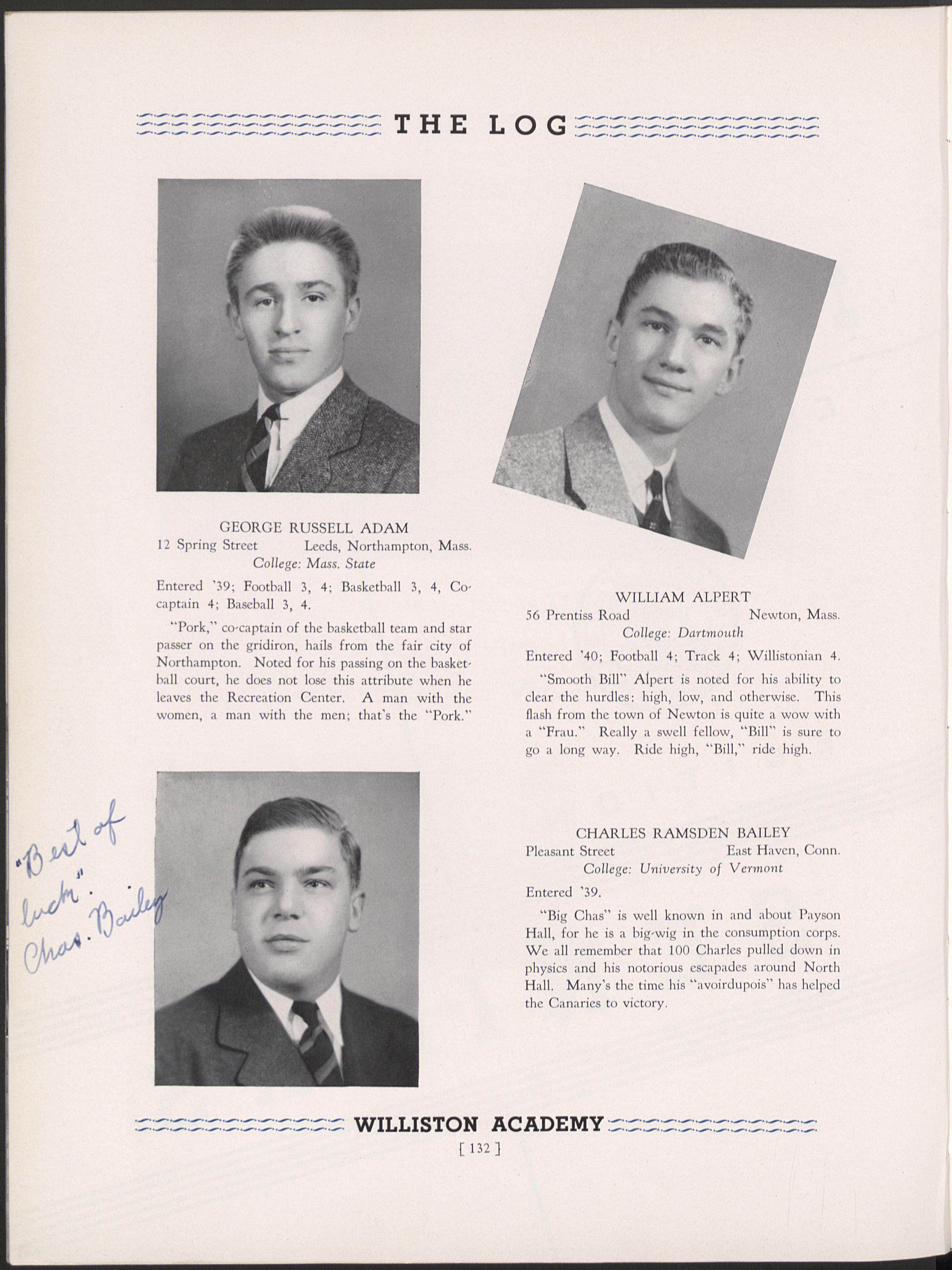
WILLIAM ALPERT
56 Prentiss Road Newton, Mass. College: Dartmouth
Entered '40; Football 4; Track 4; Willistonian 4.
"Smooth Bill" Alpert is noted for his ability to clear the hurdles: high, low, and otherwise. This flash from the town of Newton is quite a wow with a "Frau." Really a swell fellow, "Bill" is sure to go a long way. Ride high, "Bill," ride high.
CHARLES RAMSDEN BAILEY
Pleasant Street East Haven, Conn. College: University of Vermont Entered '39.
"Big Chas" is well known in and about Payson Hall, for he is a big-wig in the consumption corps. We all remember that 100 Charles pulled down in physics and his notorious escapades around North Hall. Many's the time his "avoirdupois" has helped the Canaries to victory.
JOSEPH CARR BEHAN, II
174 Belvidere Street Springfield, Mass. College: Dartmouth
Entered '39; Soccer 4; Hockey 3; Golf 3, 4; Willistonian 3, 4, Make-up Editor 4; Student Council 3, 4; Prom Committee 4.
Here's one of Ford Hall's top-floor men. Joe is always to be found when there's something afoot, especially if it's a jam session. If the old cry "Who's got a butt?" goes out, Joe is sure to be right behind it. Joe will surely be a leading man in college— here's wishing luck to a swell sport.
GEORGE STRONG BENHAM, JR. 6 Cherry Street Ansonia, Conn. College: Wesleyan
Entered '39; Football 4; Tennis 3, 4; Glee Club 4; Operetta 4.
"Smooth George" Benham is another one of Ford Hall's stand-bys. Always a hard worker, until the vie starts rolling out hot boogie-woogie rhythm, then George is sure to be there "jitterbugging" with the rest of the boys. "Brains" is one of Mr. Bell's protégés in advanced algebra. Good luck in college, George.

630 Olympia Road Pittsburgh, Penna. College: Dartmouth
Entered '40; Glee Club 4; Football 4; Track 4; Operetta 4.
"Chuck" is one of those happy-go-lucky guys who seems to let nothing bother him. He has the gift of really good humor, which makes him well liked by all. He is an athlete of no mean ability; he proved that last fall on the gridiron. We think he's rather a playboy at heart, though we've all seen him slave at the books.
GEORGE NORMAN BISSELL, III
160 Brookview Avenue Bridgeport, Conn. College: University of Pennsylvania
Entered '39; Football 3; Soccer 4; Hockey 3; Dramatic Club 3; Glee Club 4; Executive Comm. 4; Willistonian 4, Assistant Editor 4; Ring Comm. 4.
Wherever there is a bridge game, there you can find "Bis," who will sit in on any gathering. We venture that George has not missed a "bull" in North, or a weekly phone call to Skidmore in years. He is one swell fellow, whom nobody can accuse of anti-sociability.

ROBERT WILLIAM BRAUTIGAM
Edgerton Road Jamaica, N. Y. College: Dartmouth
Entered '37; Soccer 4; Willistonian 2, 3, 4; Log 3, 4, Advertising Manager 4; Track 4.
When the cry of "firecracker" goes out, Brautigam is always to be found sitting peacefully in his room, but those who know better realize that the "Hun" has been sabotaging again. A famed member of the 9:20, 10:10, and 11 o'clock clubs, "Brau" has never had a lateness yet. Efficient business manager of the Log,"Brau" is really a swell fellow and a sincere friend.
STEVENS DEXTER BROWN
120 Cambridge Street Winchester, Mass. College: Brown
Entered '37; Soccer 3, 4; Hockey 3, 4; Track 3, 4; Willistonian 2, 3, 4, Make-up Editor 4; Log Board 3, 4, Managing Editor 4; Dramatic Club 2, 3, 4, Stage Manager 3, 4;"Y" Cabinet 2, 3, 4, Secretary 4; Gift Comm. 4.
"Steve," the big boy with the big kick on the soccer field and a bigger kick on the dance floor, will always be remembered for his wit and all-around good humor. A dependable manager on the Log staff, he starred on this year's fast hockey team, polevaulted for the track team, and was a big gun on the soccer varsity. Good luck, "Steve."
DANIEL TORREY BUCKINGHAM
59 High Street Milford, Conn.
College: Dartmouth •
Entered '38; Football 2, 3, 4; Track 2, 3, 4, Co' Captain 4; Dramatic Club 2, 3; Glee Club 2, 3, 4, Executive Comm. 4; Willistonian 2, 3; Log Board 3, 4, Literary Editor 4; Prom Comm. Chairman 4; Operetta 3, 4.
Who is that tall, dark, and handsome lad seen around North Hall? Who is the literary editor of the Log? Who plays center on the football team? What man shows the rest of the field his heels in the mile? Why, that's easy; we refer to the North Hall flash, the paragon of the pencil, "Torrey" Buckingham.
RUSSELL CAMERON
3 Newtown Terrace Norwalk, Conn.
College: Amherst
Entered '38; Soccer 4; Baseball 3, 4; Willistonian 4, News Editor 4; Glee Club 2, 3, 4; Student Council 3, 4, President 4.
The president of the Student Council, "Russ" Cameron, is not only a swell president, he is a real fellow as well. Many a heart in Northampton will cease beating when "Russ" returns to his old haunts in Norwalk. "Russ" is the living proof of the old saying, "You can't tell a book by its cover."

WALTER ALDRICH CARD
1'70 North Street Willimantic, Conn.
College: University of North Carolina
Entered '39; Football Manager 4; Basketball 4; Baseball 3, 4; Glee Club 3, 4; Executive Comm. 4; Triple Quartet 3, 4; Operetta 3, 4.
Ford Hall's "Dapper Dan" and "Don Juan" all rolled into one. Wherever there are women, there's "Walt." The originator of that great game, "seven and a half"—and the guy who cleaned up on it. "Walt," a good basketball and baseball player, has an eye for the weaker sex that Casanova himself could have used.
JAMES EDWARD CARROLL, JR.
31 Garfield Place Poughkeepsie, N. Y. College: Duke
Entered '37; Glee Club 1; Adelphi Gamma Sigma 3, 4; Football 3.
"Long Jim," the smooth boy of South Hall, from whom we hear tales of the New York night spots, is one of the swellest fellows in South. In the interdormitory competition, James displays his swimming prowess; and we hear he is a recognized sailor in the vicinity of Nantucket.

MORTIMER THOMAS CAVANAUGH, JR.
252 Main Street Great Barrington, Mass. College: Williams
Entered '40; Football 4; Basketball 4; Track 4. "Mort," admired for his outstanding prowess on the gridiron, loses none of his skill when he steps into civilian clothes. A basketeer of no mean ability, "Mort" excels on weight lifting and may be seen up in the boxing room with Peden anytime. "Cavvy," may you succeed in life the smashing way you did on the football field.
LINDSAY MATHEWSON COLLINS
425 Lenox Avenue Westfield, N. J. College: Rensselaer
Entered '39; Soccer 3, 4; Willistonian 3, 4, Business Manager 4; Log 4; Dramatic Club 3, 4.
Lindsay, star center-forward on the soccer team, is also a consistent repeater on the honor roll. His quiet manner, his splendid sense of humor, and his well-known antics in "Mac's" give him the title of "Number One Glamour Boy of Williston." Good luck at R. P. I., Lindsay.
JOHN JOSEPH COSTELLO, JR.
53 Eton Strcct Springfield, Mass. College: Wesleyan
Entered '39; Student Council 3, 4; Glee Club 3, 4; Willistonian 3, 4.
Onc of Springfield's favorite sons who has made a mark for himself at Williston carved in big letters on Ford Hall. "Cos" is one of the members of that great second-floor council which decides the fate of the first floor. "Long Jack" is an ace behind a rifle, and a sensible fellow who keeps his little black book of phone numbers to himself.
BRUCE WALLACE CRONMILLER, JR.
39 Lamb Street South Hadley, Mass. College: Harvard
Entered '37; Log 3, 4, Art Editor 4; Willistonian 3, 4; Dramatic Club 1, 2, 3, 4.
"Bruce" is one of the more intellectual members of the Williston student body. Noted for his ability with the oils and with an art pencil, Bruce is certain to make his mark at Harvard. A splendid art editor on the Log, it is to "Crow" that we owe the credit for the cover design on the calendar this year, as well as our inside cover designs.

North Chestnut Street New Paltz, N. Y. College: Undecided
Entered '37; Class President 1; Willistonian 2, 3, 4, Exchange Editor 4; Tennis Manager 3; Log 3, 4, Business Manager 4; Dramatic Club 1.
It takes a mighty man to hob-nob with Supreme Court Justice Hugo Black, but "Phil" is equal to it. The heart-throb of Hamp School and all points west, "Phil" is really a lady killer. It is through his efforts as business manager of the Log that this book has maintained such a high financial standing.
ROBERT DIAMOND
12 McKinley Avenue Easthampton, Mass. College: Holy Cross
Entered '37; Glee Club 1; Willistonian 2, 3, 4; Adelphi 3, 4, President 4; Baseball Manager 3, 4.
"Big Bob" is well known for his good nature, his curly red hair, and his ability in not carrying his blue history work-book. A permanent source of joy to "Hep," "Bullet" will always be remembered for his lengthy, if meaningless, history outlines. He is able to laugh at himself, a trait which will stand him in good stead in the future.

CLAUDE ELMER DOUGLAS, JR.
16 Forbes Avenue Northampton, Mass. College: Undecided
Entered '39.
"Just yesterday, I was talking to the guy," says "Doug" at every occasion. "Claude" is noted for his prompt(?) remittance of English papers, often evinced by the words, "I'll hand it in before supper, Mr. Terral." He may be found any afternoon in 13 South Hall pouring forth with vivid dissertations on those illustrious Hamp girls.
RICHARD KNOWLES DOUGLAS
69 Broad Street Westfield, Mass. College: Amherst
Entered '37; Glee Club 4; Log 1, 4, Photography Editor 4; Soccer 4; Dramatic Club 1.
"Red" is known throughout Williston as a quiet, reserved man-about-town, a follower of the "appear quiet and get 'em that way" school of thought. A fast outside on "Boardy's" second soccer team, the "flying Dutchman" should become a great dentist some day. Many of the snaps in this book are due to his fine photography.
BRADFORD FRANK DUNBAR
43 Amherst Street Worcester, Mass. College: W. P. I.
Entered '40.
"Brad" is the quiet type, but when he takes his place at the bridge table, watch out—Dunbar bids again. "Brad" is aiming at W.P. I. for college, and he usually gets what be goes after. This time, considering that he's something of a math genius, there is no doubt that he will be successful. But remember,"Brad," don't get mixed up in any English tests.
ROBERT EPSTEIN
37 Davis Road Port Washington, N. Y. College: Cornell
Entered '39; Dramatic Club 3, 4; Track 4.
Who's that fellow beating the drumsticks with his tongue hanging out? Who's that guy who's yelling about Brooklyn's chances for the pennant every year? Whose name appears first on the bounds list every week? None other than "Bob" Epstein. His room is the center for every "jam" session, hot or cold. Altogether, he is a swell fellow always on the hunt for a good time.

GEORGE DONALD FERREE
22 Lexington Road West Hartford, Conn. College: Undecided
Entered '38; Willistonian 2, 3, 4; Log 2, 3, 4; Adelphi 2, 3, 4; Soccer Manager 4.
"Sas" is a likeable chap who hails from Hartford. Renowned for his ability in photography and radio, "Sas" is intent on the finer things in life. A prodigious scholar with a gift of gab and a happy-golucky air, he is well liked by all.
ROBERT ATCHESON FINSTHWAIT
42 Cherry Avenue New Rochelle, N. Y. College: Amherst
Entered '38; Glee Club 4; Log 4; Willistonian 2, 3, 4; Adelphi 2; Operetta 4.
"Fin the Din," one of the elite of Ford Hall, is well known as Princeton's "machine gunner" who pops them up from midcourt any day in the week. An old standby of the Glee Club,"Bob" carried off his part in the operetta with great success. He has become the shining example of how to win friends and influence teachers.

FREDERICK GEORGE FISCHER
289 Kneeland Road New Haven, Conn. College: Wharton
Entered '37; Log 4, Literary Editor 4; Dramatic Club 2, 3, 4; Cheer Leader 3; Willistonian 2, 3, 4, Copy Editor 4; Tennis 4.
We all admire Fred for his consistent first honors and his work as literary editor of the Log. "Freddie" is still batting out the 98's in history and chemistry and tossing in the swish(?) shots for the famous Princeton Club. Any day at one o'clock he may be seen making the trek to the post office to receive his many perfumed letters.
VINCENT HERBERT FORKEY
Taft Avenue Easthampton, Mass. College: University of Pennsylvania
Entered '39; Baseball 3, 4, Captain 4; Basketball 3, 4, Co-captain 4; Football 3, 4; Class Vice-President 4; Student Council 3, 4;"Y" Cabinet 3, 4; Athletic Advisory Board 3, 4.
"Vinney," star in football, flash in basketball, and whiz in baseball, is also known as the "cowboy of the snack shop." The home-town boy who made good is an honor student as well as an athletic titan. We shall miss his sharpshooting in the future; our loss is U. of Penn.'s gain.
JOHN MURRAY GIBBONS
Maple Street Granville, Mass.
College: Undecided
Entered '37; Student Council 3, 4;"Y" Cabinet 3, 4; Track 2, 3, 4.
"Gibby," one of Payson's few well-known athletes, is a member in high standing in both the Student Council and the"Y"Cabinet. His good-natured comradery is one of the backbones of the fellowship at school. In class, as in the dining hall, "Gibby" is a hard working fellow who is sure to make out all right. Don't let all your lady friends get in your way, "Gibby."
JAMES DEGOULARD GWATKIN
169 North Beacon Street Hartford, Conn. College: V. M. 1.
Entered '38; Tennis 4.
A Southern drawl, a toothpaste smile, and a carefree air at all times just about describes Ford Hall's No. 1 Casanova. "Gwat" has conquered just about everything in the North as far as the fairer sex is concerned. When a jam session is in progress,"Goo" is always on hand to see that things keep moving. It's a sure thing that he will wow them at V. M. I.
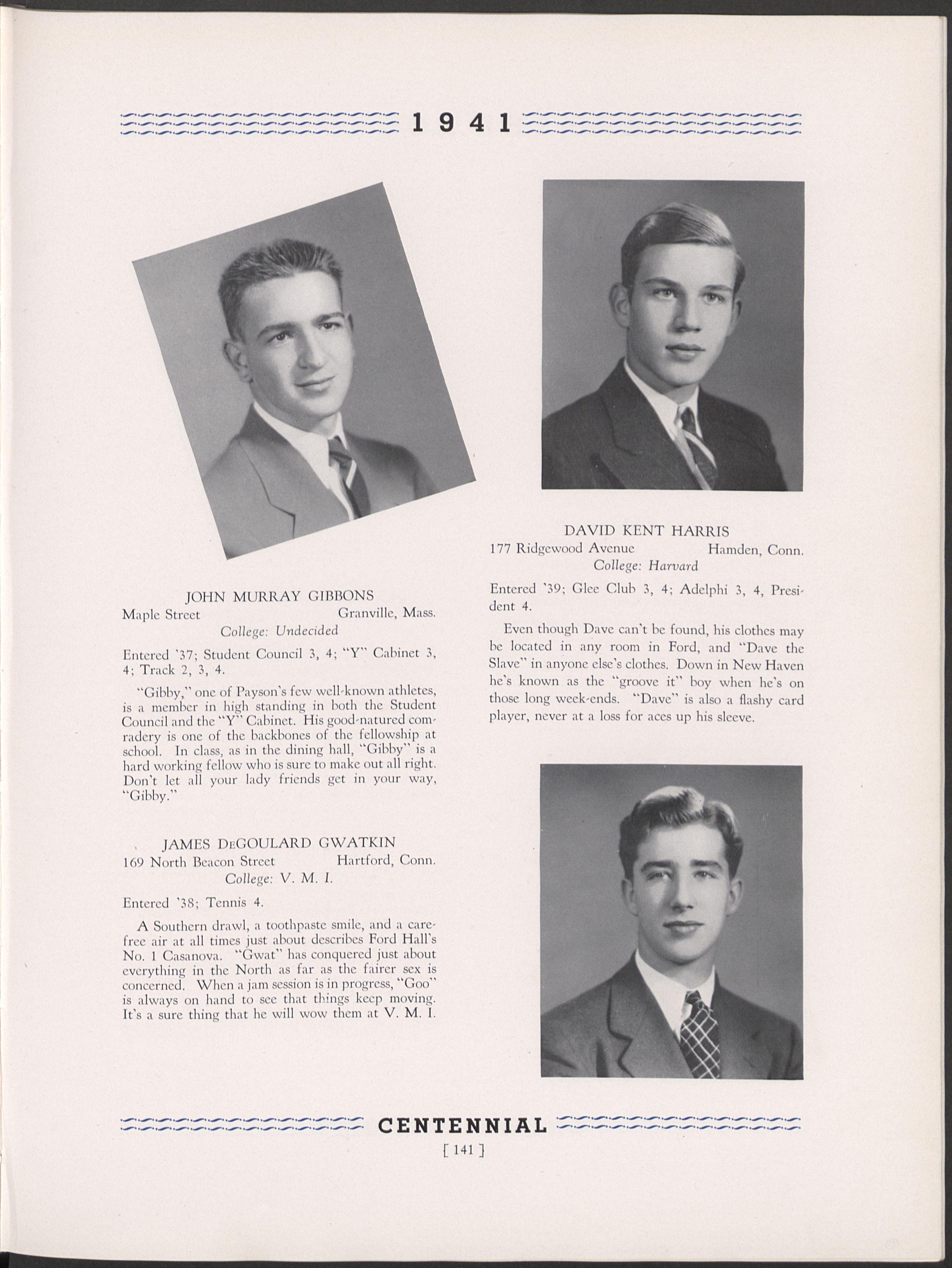
DAVID KENT HARRIS
177 Ridgewood Avenue Hamden, Conn. College: Harvard
Entered '39; Glee Club 3, 4; Adelphi 3, 4, President 4.
Even though Dave can't be found, his clothes may be located in any room in Ford, and "Dave the Slave" in anyone else's clothes. Down in New Haven he's known as the "groove it" boy when he's on those long week-ends. "Dave" is also a flashy card player, never at a loss for aces up his sleeve.
CARL JOHNSON HART
310 Lincoln Street New Britain, Conn. College: University of Virginia
Entered '37; Soccer 1, 2, 3, 4; Hockey 2; Track 3, 4;Co-Captain 4; Dramatic Club 2; Willistonian 3, 4.
"Nig," that lady killer from New Britain, is an outstanding athlete. This big little man, who has a keen interest in the Conn. College for Women, treats the Easthampton women often to his dynamic personality. His ability in soccer, combined with his prowess on the cinders, has won him a place of honor at Williston.

DON WOOD HAWLEY
Batavia Avenue Geneva, N. Y. College: Dartmouth
Entered '40; Football 4; Dramatic Club 4; Glee Club 4; Operetta 4.
The boy who came East and made good following the slogan "you have to be a football hero to get a beautiful girl." Don seems to be commuting to Burnham every week-end, so there must be something in it. In fact, it is well known that he has interests in nearly every city from Chicago to Boston. Besides being an athlete and a Romeo, Don is really good in his marks.
PHILIP DEARBORN HOLMES
23 Stetson Street Whitman, Mass. College: M. I. T.
Entered '40; Football 4; Athletic Advisory Board 4; Student Council 4.
This dashing lad from Ford Hall is an outstanding figure on the football field, on the Student Council, and abroad in Northampton. Phil is a typical hard working Williston fellow who is destined to do well at M. I. T., or any place else. He is really a student, nearly always claiming honors of some kind.
RAYMOND MORGAN HOLMES, JR.
101 Park Avenue
College: Cornell
New York, N. Y.
Entered '38; Football 4; Track 2, 3; Log 2, 3, 4, Photography Editor 4; Willistonian 3, 4; Basketball Manager 4.
This "jive digger" from North, with a gift of lo, quaciousness, is a familiar figure at McGowan's bar. "Killer's" biggest joy and pastime, that of discuss, ing the latest events of the day, has brought many a laugh from his audience. He is a fighter on the second football team, an ardent basketball fan and player, and a supporter of the track squad, all of which is proof of his athletic ability.
RICHARD HAZARD HULL
888 Ridge Road Hamden, Conn.
College: Purdue
Entered '40; Glee Club 4.
"Dick" is a "Ham" radio operator who really knows his "Q.S.0." His beaming countenance is always a joy, and makes him a well,likcd member of "Dave's" dorm. His many excursions to Smith have earned for him the job of dish washing.

OWEN WILLIAMS KENNEDY, JR.
Central Street Boylston, Mass.
College: W. P. I.
Entered '38; Soccer 4; Hockey 3; Willistonian 3, 4, News Editor 4; Dramatic Club 3, 4.
Well known for his poker face at all times, Owen has made an enviable name for himself in both sports and scholastics. He will long be remembered for his excellent work on the Willistonian as well as for his prowess on the soccer team. W. P. I. is certainly getting a break when "O.K." arrives.
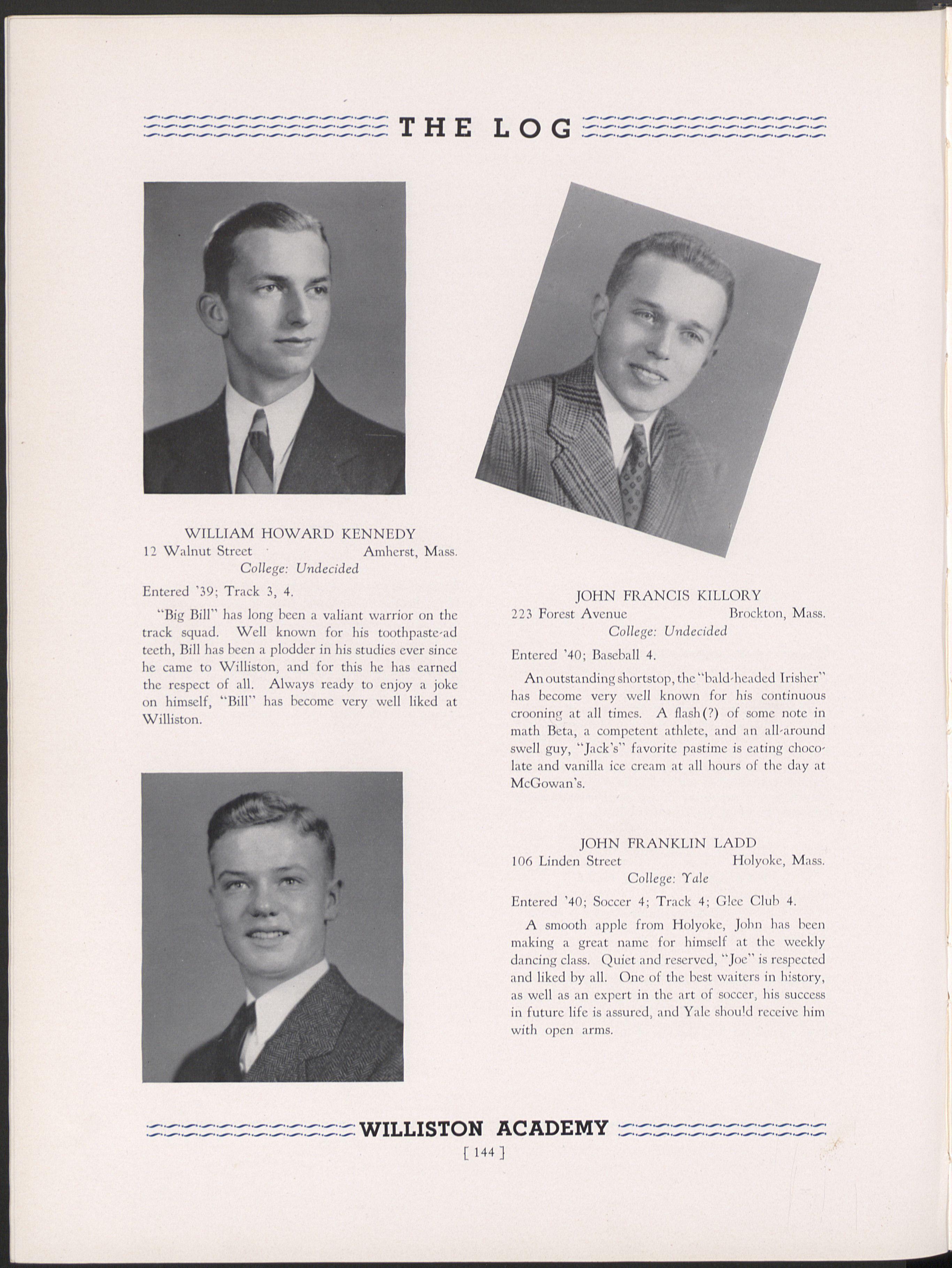
WILLIAM HOWARD KENNEDY
12 Walnut Street
Amherst, Mass. College: Undecided
Entered '39; Track 3, 4.
"Big Bill" has long been a valiant warrior on the track squad. Well known for his toothpaste-ad teeth, Bill has been a plodder in his studies ever since he came to Williston, and for this he has earned the respect of all. Always ready to enjoy a joke on himself, "Bill" has become very well liked at Williston.
JOHN FRANCIS KILLORY
223 Forest Avenue Brockton, Mass. College: Undecided
Entered '40; Baseball 4.
An outstanding shortstop,the"bald-headed Irisher" has become very well known for his continuous crooning at all times. A flash(?) of some note in math Beta, a competent athlete, and an all-around swell guy, "Jack's" favorite pastime is eating chocolate and vanilla ice cream at all hours of thc day at McGowan's.
JOHN FRANKLIN LADD
106 Linden Street Holyoke, Mass. College: Yale
Entered '40; Soccer 4; Track 4; Glee Club 4.
A smooth apple from Holyoke, John has been making a great name for himself at the weekly dancing class. Quiet and reserved,"Joe" is respected and liked by all. One of the best waiters in history, as well as an expert in the art of soccer, his success in future life is assured, and Yale shou!d receive him with open arms.
ARNAUD JULIAN LAPIERRE, JR.
14 Elm Street Norwichtown, Conn.
College: Dartmouth
Entered '38; Football 4; Track 3, 4; Glee Club 4.
Who leads the Ford Hall "jam sessions?" Who is always to be seen with "Killer" in the Mystic Diner? Who sneaks into the classrooms between numbers at the Burnham dances? It is none other than "LapEars." Too bad the girl friend from Norwich moved to Chicago, but where "La" is there will always be another one with him.
NEALE EDWARD LEETE
5718 Kenmore Avenue Chicago, Ill.
College: Annapolis
Entered '38; Tennis 3; Cheer Leader 3, 4; Glee Club 2, 3, 4; Classical Orchestra 3, 4.
Neale is God's gift to Hamp school. His Thursday night escapades in the dancing class have been a deep, dark secret. Who is the lucky girl? Neale was the potent center on the lightweight eleven and really knows his football. A consecutive first-honor man, Neale should have a grand time with Annapolis "life-savers." 0•0",10..../...••••

FISHER LIKINS, JR.
Sunaire, Pilgrim Road Marblehead, Mass. College: Undecided
Entered '39.
"Duke" is the school's connoisseur on the fairer sex. This mighty man of the Canary football team was also a better than average member of"Plumbic's" ski squad. The mustache king of the campus, the most troublesome protege of Mr. Cunningham's geometry class, is a well liked and popular man at school. Take care of B. A. M.;she deserves the best.
JAMES HAYDEN LORD
182 Hillside Avenue Englewood, N. J.
College: Undecided
Entered '37; Dramatic Club 3; Operetta 2.
James Hayden—he of the lofty tongue. Intel. lectual discussion a favorite pastime. One of the intelligensia of Williston. At Easter, "Jim" always appears disguised as Lucius Beebe. If you wish to hear all about the latest play running on Broadway, speak to "Jim." He also knows most of the inside "dope" on what's what around the campus. We will all miss him when he leaves.

FRANCIS WILLIAM LOVETT, JR.
Main Street Hatfield, Mass, College: Wesleyan
Entered '39; Glee Club 3, 4; Double Quartet 4; Operetta 3, 4; Classical Orchestra 4; Student Colin, cil 4.
"Bud," the illustrious inhabitant of No. 14 South Hall, has the reputation for being a "Beau Brum. met" from way back. With a voice like his it is no wonder that he holds topmost position in all musical productions. "Bud" has a quick wit and a biting tongue, both of which bring out the "fighting Irish" in him. He is one of the few fellows to our knowledge who can hold a girl for more than a month.
WILLIAM EUGENE McCARTHY
117 South Street Northampton, Mass. College: Fordham
Entered '38; Glee Club 4; Willistonian 4; Log 4; Operetta 4.
"Mac," another of the "fighting Irish" troupe, is the Pepsi•Cola king of the campus. He can he seen any day in Hamp driving his Chevy (vintage 1910) or sitting on the steps in front of the Music House. His cheerful smile and general good humor have really made him Northampton's Casanova ("I Dream of Jeanie with the Light Brown Hair").
WILLIAM KELSEY McCLELLAND
347 Madison Avenue New York, N. Y. College: Oberlin
Entered '39; Soccer 3, 4; Tennis 3, 4; Glee Club 3, 4; Operetta 3, 4; Classical Orchestra 3, 4; Log 4.
The flute player from India, and the protege of Mr. Hyde. Bill is an excellent student, the answer to a chemistry teacher's prayer. He is no slouch as a soccer player. Bill is the fellow who tolls forth the call to classes on "ye olde school belle." He has really done it well.
JAMES HIRAM MAcNAUGHTON, JR. 238 Grove Street Auburndale, Mass. College: Syracuse
Entered '37; Glee Club 1, 2, 3, 4; Executive Comm. 4; Operetta 3, 4; Log 4; Soccer 2, 3, 4; Hockey 4; Track 3, 4; Baseball 2; Athletic Advisory Board 4; Popular Orchestra.
"Smooth Jim." Drummer boy par excellence, jam and jive kid, and track man exceptional. Jim is a Boston boy who knows his women. As seen by his statistics he is an all-around athlete. True to the Scotch, he plays an outstanding game of soccer. His good nature makes him one of Williston's best.

ROBERT WINSLOW MARTIN
2 Princeton Street Holyoke, Mass. College: Mass. State
Entered '39; Football 3, 4; Hockey 4.
Bob graces the dances in both Holyoke and Burnham with his charming personality and a smile which spreads from ear to ear. He is one of those dashing waiters in Ford Hall who always amuses "Baron" Smith and his table. He works hard, too, if not at his studies, at his famous Saturday nights in 'Hamp.
ROBERT HENRY MATTHIAS
1 Bridgman Lane South Hadley, Mass. College: Amherst
Entercd '39.
A mighty mite, the backbone of the lightweight team, a stalwart on the basketball floor, and an allaround swell fellow, "McTeevey" is bound to succeed. His ability in math and chemistry is envied by many of the less fortunates. Following in his brother's footsteps, Bob is heading for Amherst, where he should be well received.

WALTER RAYMOND MILLER
8 Virginia Road Bellerose, L. I. College: Undecided
Entered '37; Football 3, 4, Captain 4; Baseball 1, 2, 3, 4; Basketball 4; "Y" Cabinet 3, 4; Willistonian 4, Sports Editor 4; Athletic Advisory Board.
Walt, football captain, basketball ace, and baseball's star second baseman, is a popular fellow with both sexes up and down the Atlantic Seaboard. A student as well as a fun lover, Walt should go far in college. He will leave a great gap here this June which will really be. hard to fill.
JOHN COLLIER MONTGOMERY, JR. 33 Guild Road Worcester, Mass. College: Williams
Entered '39; Tennis 3; Hockey Manager 4; Willistonian 3, 4; Log 3, 4, Editor-in-chief 4.
"Monty," Mr. Johnston's right-hand man on the Log as editor-in-chief (and according to Mr. Johnston the best editor in ten years), is the business man of the school. A great admirer of the opposite sex, Monty has more than a keen interest in one of Easthampton's elite. One of Lang's biggest Pepsi-Cola customers, Monty can be seen any night trudging that familiar path. A better-than-average hockey manager, he is sure to be successful at Williams. WILLISTON

DONALD MILTON MOORE
53 River Street Arlington, Mass. College: Dartmouth
Entered '40; Football 4; Hockey 4; Baschall 4; Glee Club 4.
Don, better known as the "Arlington flash," is one of Williston's finer hockey players. New to the school this year, Don has made himself popular with everyone. Noted especially for his ability to coin expressions, he is expected to do as well at Dart mouth as he has here.
MACE MOULTON, III
108 Yale Street Springfield, Mass. College: M. I. T.
Entered '39; Glee Club 4; Operetta 4.
"Mace the Ace" is not only the whiz in Cookie's advanced math, where he as yet has not tried his homework, hut he is also one of the old reliables of the Glee Club, where his voice is heard strongly from the first bass section. No matter what time of the day or night you may look for him, you can always find him reclining in a haze of smoke reading P. G. Wodehouse.
1471 Regent Street Schenectady, N. Y. College: Undecided
Entered '41; Glee Club 4; Adelphi 4.
Here is a likeable chap whose daring at instigating hull sessions is well known throughout North Hall. He likes his chemistry and sings a good bass in the Glee Club, in spite of all the kidding we give him on his "Nocked" notes. "Ned" is an enthusiastic skier, and, as far as we have been able to find out, he is just an enthusiastic a "she-er."
Fillow Street
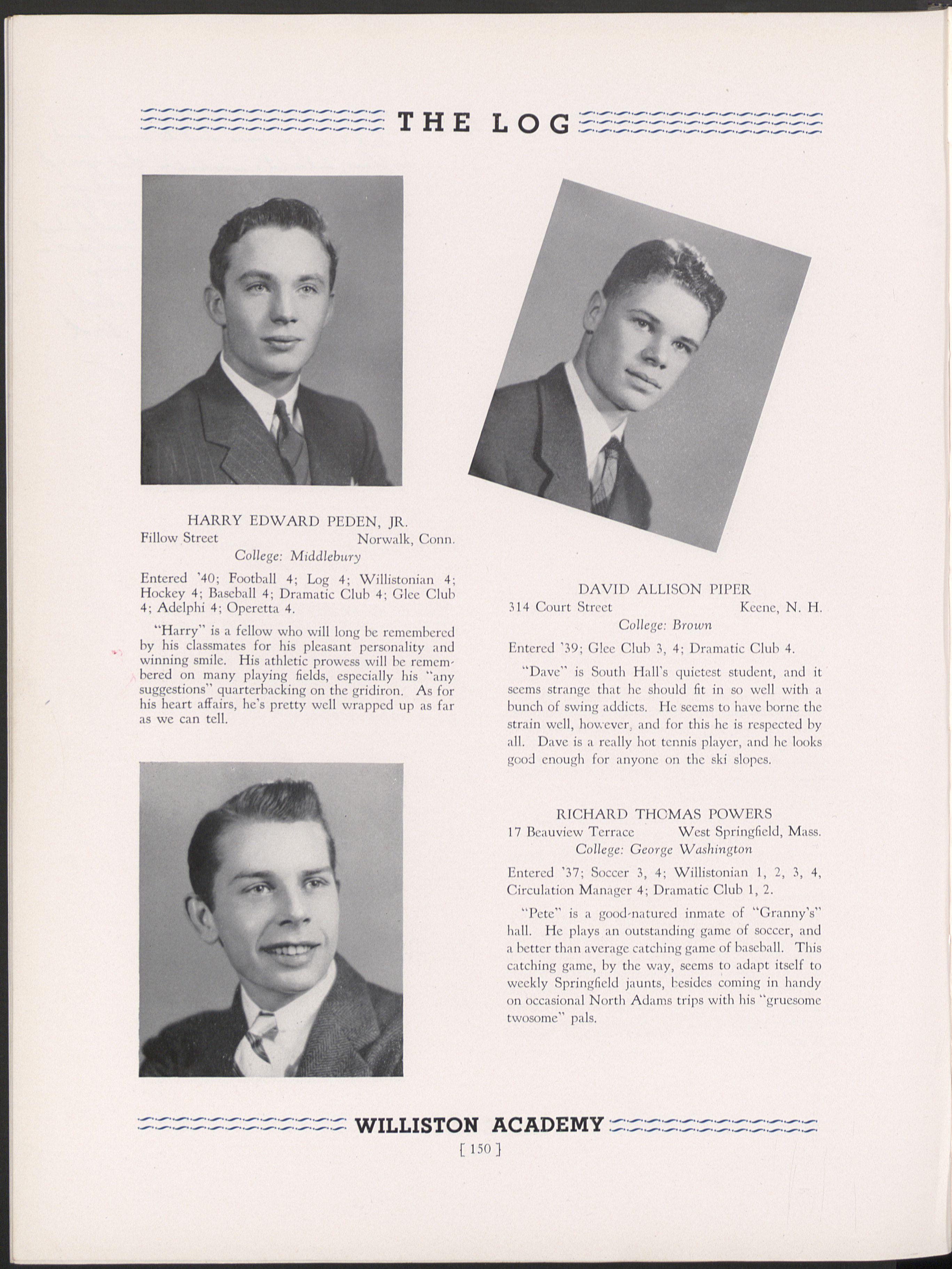
Norwalk, Conn.
College: Middlebury
Entered '40; Football 4; Log 4; Willistonian 4; Hockey 4; Baseball 4; Dramatic Club 4; Glee Club 4; Adelphi 4; Operetta 4.
"Harry" is a fellow who will long be remembered by his classmates for his pleasant personality and winning smile. His athletic prowess will be remembered on many playing fields, especially his "any suggestions" quarterbacking on the gridiron. As for his heart affairs, he's pretty well wrapped up as far as we can tell.
DAVID ALLISON PIPER
314 Court Street Keene, N. H. College: Brown
Entered '39; Glee Club 3, 4; Dramatic Club 4.
"Dave" is South Hall's quietest student, and it seems strange that he should fit in so well with a bunch of swing addicts. He seems to have borne the strain well, however, and for this he is respected by all. Dave is a really hot tennis player, and he looks good enough for anyone on the ski slopes.
RICHARD THOMAS POWERS
17 Beauview Terrace West Springfield, Mass. College: George Washington
Entered '37; Soccer 3, 4; Willistonian 1, 2, 3, 4, Circulation Manager 4; Dramatic Club 1, 2.
"Pete" is a good-natured inmate of "Granny's" hall. He plays an outstanding game of soccer, and a better than average catching game of baseball. This catching game, by the way, seems to adapt itself to weekly Springfield jaunts, besides coming in handy on occasional North Adams trips with his "gruesome twosome" pals.
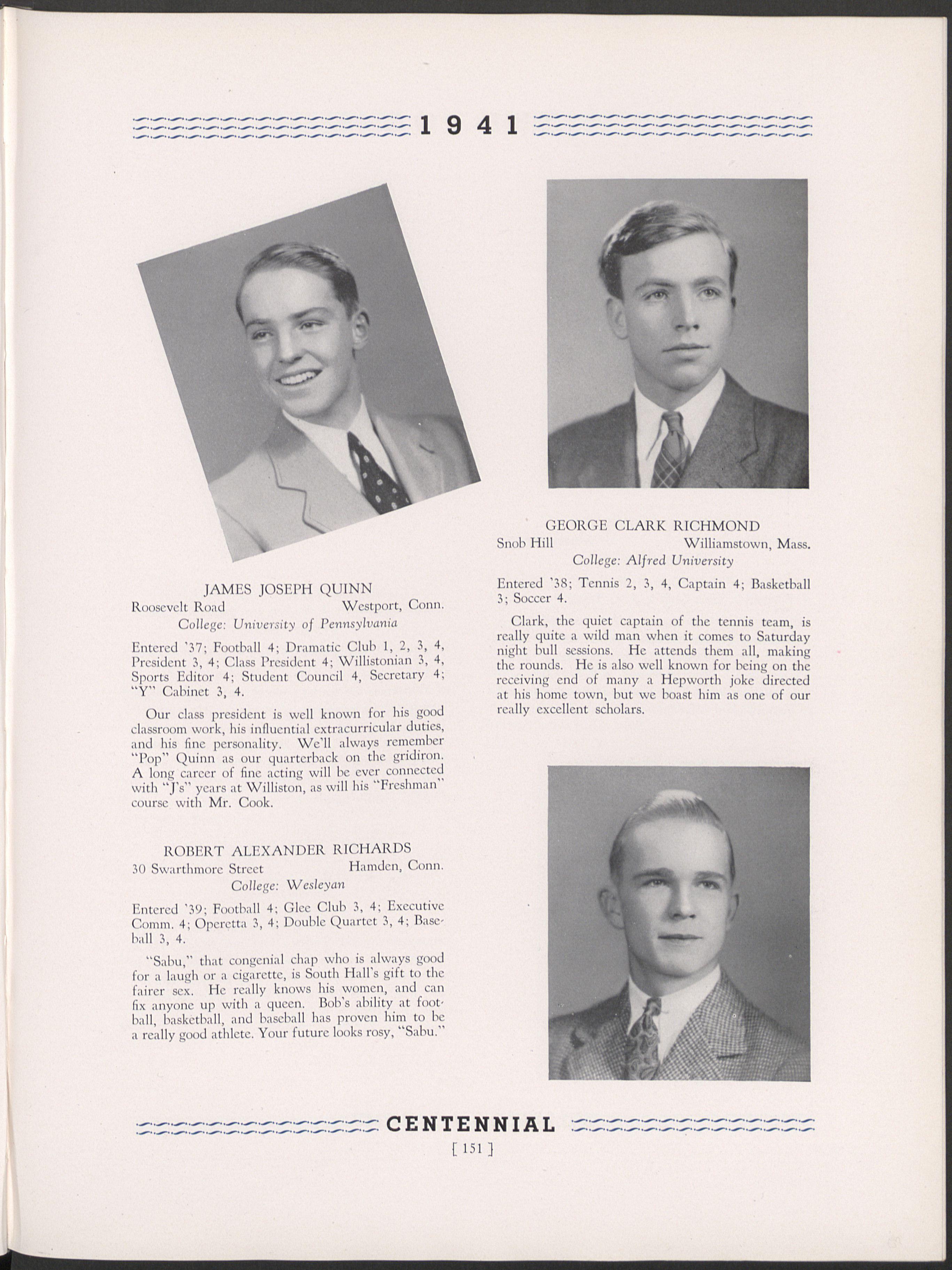
JAMES JOSEPH QUINN
Roosevelt Road Westport, Conn.
College: University of Pennsylvania
Entered '37; Football 4; Dramatic Club 1, 2, 3, 4, President 3, 4; Class President 4; Willistonian 3, 4, Sports Editor 4; Student Council 4, Secretary 4; "Y" Cabinet 3, 4.
Our class president is well known for his good classroom work, his influential extracurricular duties, and his fine personality. We'll always remember "Pop" Quinn as our quarterback on the gridiron. A long career of fine acting will be ever connected with "J's" years at Williston, as will his "Freshman" course with Mr. Cook.
ROBERT ALEXANDER RICHARDS
30 Swarthmore Street Hamden, Conn. College: Wesleyan
Entered '39; Football 4; Glee Club 3, 4; Executive Comm. 4; Operetta 3, 4; Double Quartet 3, 4; Base, ball 3, 4.
"Sabu," that congenial chap who is always good for a laugh or a cigarette, is South Hall's gift to the fairer sex. He really knows his women, and can fix anyone up with a queen. Bob's ability at foot, ball, basketball, and baseball has proven him to be a really good athlete. Your future looks rosy,"Sabu." 9 4 1
Snob Hill Williamstown, Mass. College: Alfred University
Entered '38; Tennis 2, 3, 4, Captain 4; Basketball 3; Soccer 4.
Clark, the quiet captain of the tennis team, is really quite a wild man when it comes to Saturday night bull sessions. He attends them all, making the rounds. He is also well known for being on the receiving end of many a Hepworth joke directed at his home town, but we boast him as one of our really excellent scholars.
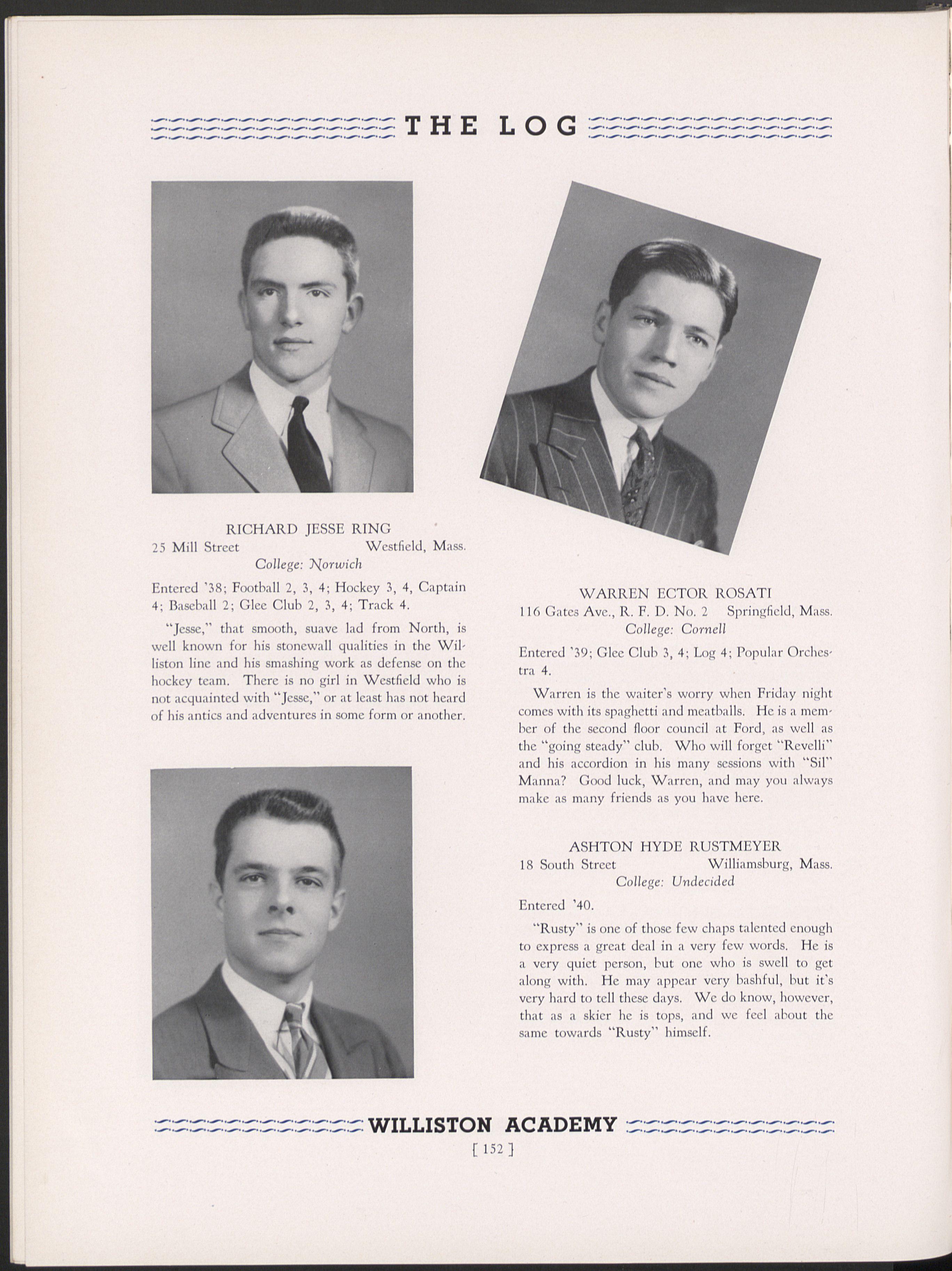
RICHARD JESSE RING
25 Mill Street Westfield, Mass. College: Norwich
Entered '38; Football 2, 3, 4; Hockey 3, 4, Captain 4; Baseball 2; Glee Club 2, 3, 4; Track 4.
"Jesse," that smooth, suave lad from North, is well known for his stonewall qualities in the Wil, liston line and his smashing work as defense on the hockey team. There is no girl in Westfield who is not acquainted with "Jesse," or at least has not heard of his antics and adventures in some form or another.
WARREN ECTOR ROSATI
116 Gates Ave., R. F. D. No. 2 Springfield, Mass. College: Cornell
Entered '39; Glee Club 3, 4; Log 4; Popular Orches, tra 4.
Warren is the waiter's worry when Friday night comes with its spaghetti and meatballs. He is a mem, her of the second floor council at Ford, as well as the "going steady" club. Who will forget "Revelli" and his accordion in his many sessions with "Sil" Manna? Good luck, Warren, and may you always make as many friends as you have here.
ASHTON HYDE RUSTMEYER
18 South Street Williamsburg, Mass. College: Undecided
Entered '40.
"Rusty" is one of those few chaps talented enough to express a great deal in a very few words. He is a very quiet person, but one who is swell to get along with. He may appear very bashful, but it's very hard to tell these days. We do know, however, that as a skier he is tops, and we feel about the same towards "Rusty" himself.
JOSIAH JAMES LINSLY SIMPSON
Northford, New Haven County, Conn. College: Undecided
Entered '37; Soccer 1, 2, 3, 4, Captain 4; Hockey 2, 3, 4; Dramatic Club 2, 3, 4; Willistonian 2, 3, 4; Log 2, 3, 4.
When we think of "Simp," we think especially of the soccer field and his successful 1940 team. "Jim" has his own ideas about things, and will stick by them through thick and thin. He has worked hard—we think. As for his romance, who knows? Not Jim. Right now, it has worked into a four' place tie. Watch out, Jim.
JOHN SLATTERY
728 Hampden Street Holyoke, Mass. College: Undecided
Entered '39; Glee Club 3; Adelphi 3, 4.
"Slats" is another of our Irish clique, hailing from Holyoke and possessing a sarcastic tongue. To those who don't know him,"Slats" appears very quiet and reserved, but his friends have found out quite differently. Although he is not a member of the Glee Club, it is rumored that he has a powerful voice (in the showers).

379 Main Street Winchester, Mass. College: Dartmouth
Entered 39; Football 4; Track 3, 4; Willistonian 3, 4, Editor-in-chief 4.
"Jock" is liked and respected for his will to win on the gridiron or on the cinders. Editor-in-chief of the Willistonian, "Jock" has created a paper to do him credit. "You ain't lyin'," says "Jock" when the conversation turns to a girl at Walnut Hill School. And those in the know will remember how "Nony's" Pearson acquired his name.
JOSEPH HENRY SWINDELLS, JR.
6 McAuley Avenue Windsor Locks, Conn. College: Undecided
Entered '37; Track 3, 4; Soccer 3, 4.
I think we shall all agree that "Joe" is one of the hardest pluggers that we've seen in a long time. The time has come when "Plumbie" himself must look to his laurels when "Joe" goes out on the ski slopes of our fair countryside. And incidentally, "Joe" has been known to heave a really mean javelin around here. You deserve the best, "Joe."

ROBERT STANTON SYMINGTON
60 Middle Road Hamden, Conn. College: Williams
Entered '37; Dramatic Club 4; Football 3, 4; Tennis 3; Hockey 3, 4; Athletic Advisory Board 3.
One of the finest athletes of the year, a loyal ping, pong fan, and an all,around Romeo from the vicinity of New Haven,"Sy's" Lake Placid exploits are well known to all. A diligent student (especially in physics) a handsome lad, and an all•around swell fellow, he ranks high in the eyes of all who know him.
DONALD RAYMOND TENCH
202 East 43rd Street Brooklyn, N. Y. College: Undecided
Entered '37; Glee Club 1, 2, 3, 4, President 4; Ms, sical Orchestra 1, 2, 3, 4; Double Quartet 3, 4; Operetta 2, 3, 4; Willistonian 3, 4.
"Don's" pleasing ways make him the friend of all. When he's not studying history he's getting his "outside reading" done via a fat little address book. "Donny's" most outstanding work has been in the Glee Club, where his booming voice has led many a successful concert. His splendid work in our operettas will long be remembered.
WILLIAM TRYON TYRREL
671 East 19th Street Brooklyn, N. Y. College: Rochester Athenian
Entered '37; Log 3, 4; Glee Club 3, 4; Adelphi 3, 4; Dramatic Club 3, 4; Operetta 4.
"Big Bill," the electrical genius, the mechanical master mind of South Hall. Freckles, glasses, a big grin, and double-breasted suits—that's "Bill." The "swing and sway kid" who really loves "Sammy." Who can ever forget that clarinet and saxophone? Keep playing, "Bill;" you'll be playing first sax in "Kaye's" band yet.
ROGER COE VAN DE CARR
46 Sunny Brook Bronxville, N. Y. College: Wesleyan
Entered '37; Glee Club 1, 2, 3, 4; Class Secretary 4; Basketball Manager 3; Tennis 3, 4; Soccer 3, 4.
A Dutchman from New York State, more commonly known as "Roger the Starver." A reader of some note, "Van" can discourse for hours on any book (especially little black ones). "Van" belongs to that illustrious group known as "closet studiers," especially when it comes to English. He's a nice guy, and a swell soccer goalie.

••••"*.s•-••••••,..41.
JAMES HOWE WHEELER, II
45 Daniel Street Newton Center, Mass. College: University of Virginia
Entered '39; Glee Club 3, 4; Track 4.
Drummer man, fun lover, and friend of all is "Big Jim," one of Ford's few real gifts to Burnham. "Pinkey" has been a loyal(?) supporter of the Canary squad, and one of those stars on "Put's" track squad. One of those second-floor card sharps, "Jim" has been well liked by everyone at school. It will be really hard to get along without him.

84 Van.Horn Street West Springfield, Mass. College: Wharton
Entered '39; Football 3, 4; Basketball 4; Log 4; Willistonian 3, 4; Glee Club 4; Dramatic Club 4.
"Stu" is a fellow who has gained a great many friends at Williston. His fine personality and pleasant humor have enlivened many a midnight session. He seems very popular with the ladies, too, for it's not many of us whose girl friends come to school to take us out. But don't get the wrong impression. He's also a swell athlete.
1 9 4 1 .••••
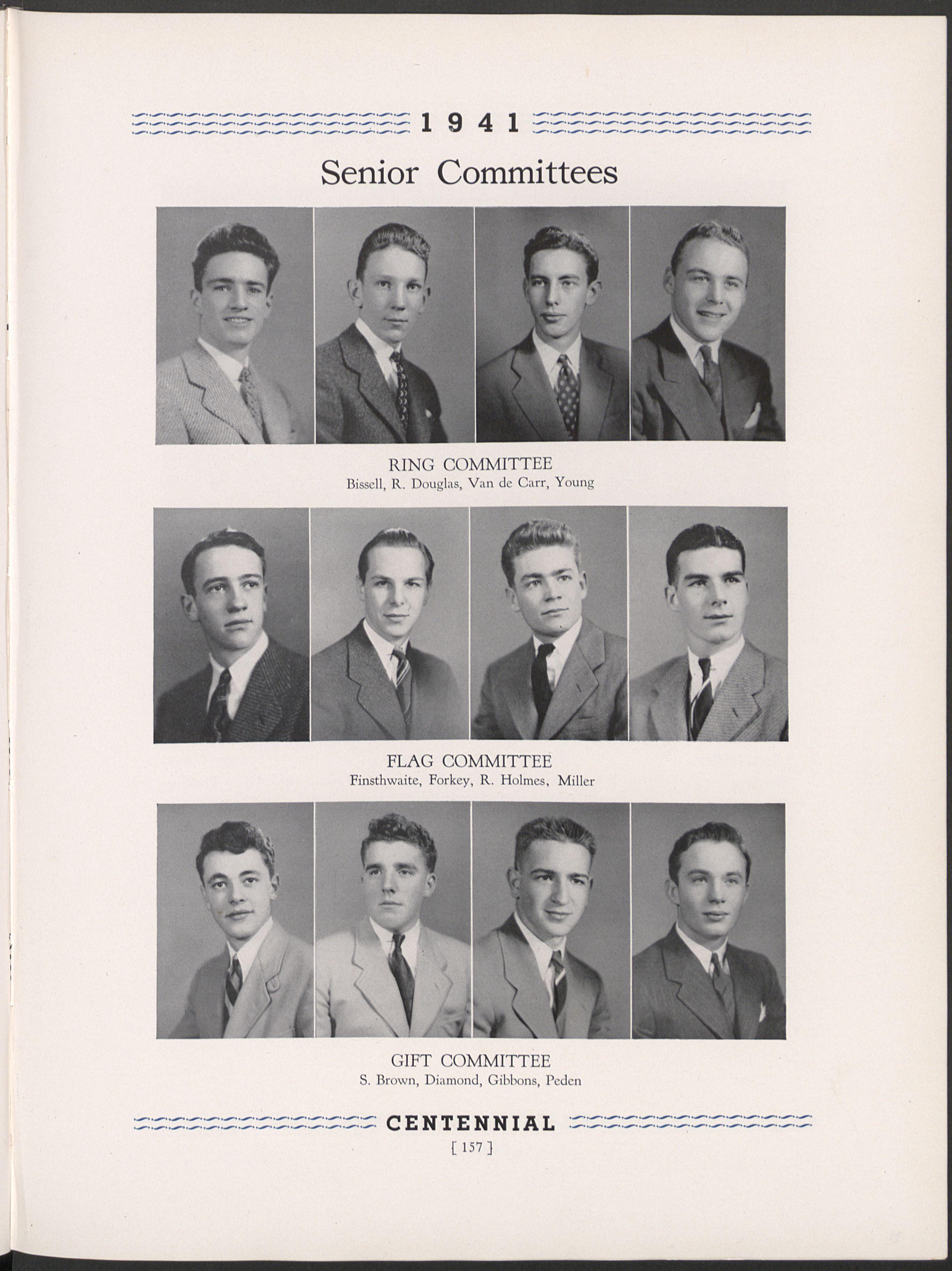
Quinn
Quinn
Forkey
Forkey
Cronmiller
Peden
Denniston
Cronmiller
Cameron
F. Fischer
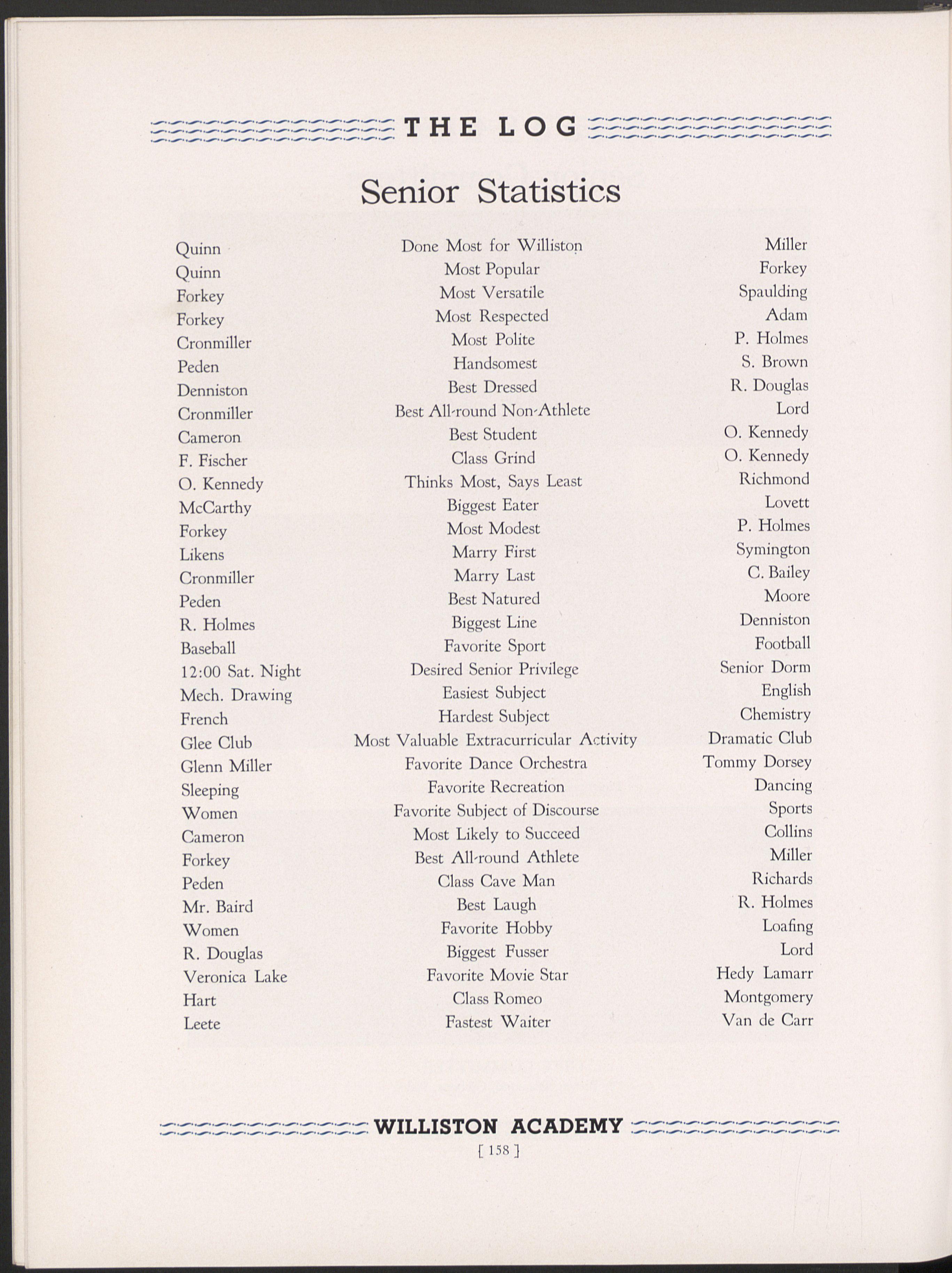
Done Most for Williston Miller
Most Popular Forkey
Most Versatile Spaulding
Most Respected Adam
Most Polite P. Holmes
Handsomest S. Brown
Best Dressed R. Douglas
Best All-round Non-Athlete Lord
Best Student 0. Kennedy
Class Grind 0. Kennedy
0. Kennedy Thinks Most, Says Least Richmond
McCarthy
Forkey
Likens
Cronmiller
Peden
R. Holmes
Biggest Eater Lovett
Most Modest P. Holmes
Marry First Symington
Marry Last C.Bailey
Best Natured Moore
Biggest Line Denniston
Baseball Favorite Sport Football
12:00 Sat. Night
Mech. Drawing
French
Glee Club
Desired Senior Privilege Senior Dorm
Easiest Subject English
Hardest Subject Chemistry
Most Valuable Extracurricular Activity Dramatic Club
Glenn Miller Favorite Dance Orchestra Tommy Dorsey
Sleeping Favorite Recreation Dancing
Women
Favorite Subject of Discourse Sports
Cameron Most Likely to Succeed Collins
Forkey
Best All-round Athlete Miller
Peden Class Cave Man Richards
Mr. Baird
Women
R. Douglas
Veronica Lake
Best Laugh R. Holmes
Favorite Hobby Loafing
Biggest Fusser Lord
Favorite Movie Star Hedy Lamarr
Hart Class Romeo Montgomery
Leete
Fastest Waiter Van de Carr

The Williston Cum Laude Society, a chapter of the national Cum Laude Society, is an active organi• zation to which only those students who have attained the best are elected.
The members are appointed not only for their scholastic standings, but also for their high moral character and their ability in other fields as well. They are perhaps exceptional students, but they must surely represent the school's highest grade work, and for this reason they are sure to continue through life as successfully as they have culminated their years af Williston.
Perhaps a better guarantee of this is the fact that the Williston Cum Laude Society is under the guidance of three of our outstanding teachers and our headmaster, whose judgment and foresight regarding these elections has so far been proven practically faultless.
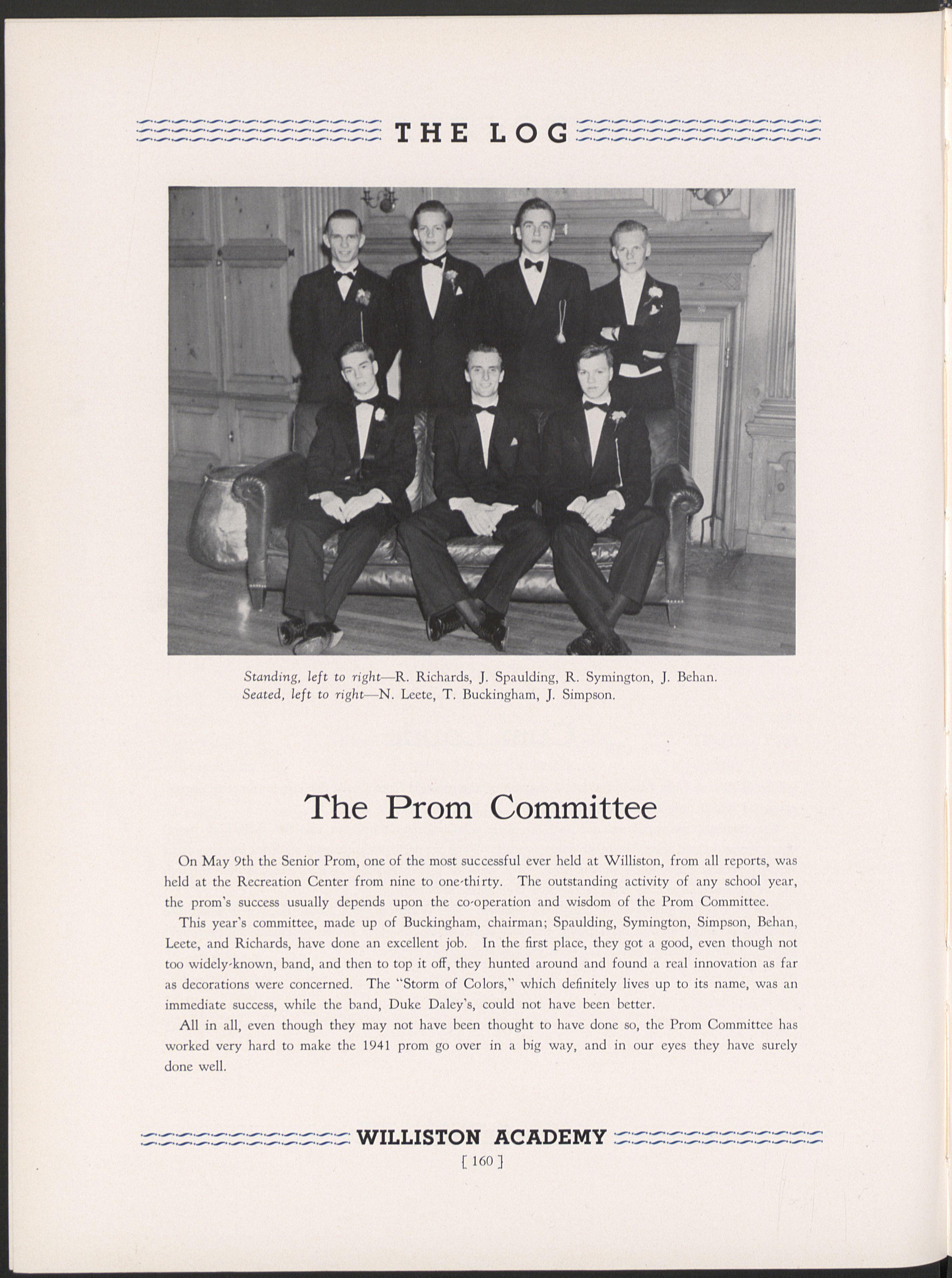
On May 9th the Senior Prom,one of the most successful ever held at Williston, from all reports, was held at the Recreation Center from nine to one-thirty. The outstanding activity of any school year, the prom's success usually depends upon the co-operation and wisdom of the Prom Committee.
This year's committee, made up of Buckingham, chairman; Spaulding, Symington, Simpson, Behan, Leete, and Richards, have done an excellent job. In the first place, they got a good, even though not too widely-known, band, and then to top it off, they hunted around and found a real innovation as far as decorations were concerned. The "Storm of Colors," which definitely lives up to its name, was an immediate success, while the band, Duke Daley's, could not have been better.
All in all, even though they may not have been thought to have done so, the Prom Committee has worked very hard to make the 1941 prom go over in a big way, and in our eyes they have surely done well.

This year's Senior Prom was the best in the history of Williston. Attended by Seniors and lower classmen alike, the prom was undoubtedly the outstanding event of the Senior year. The music was furnished by Duke Daley and his orchestra, a re ally smooth band whose music furnished a fitting background for a romantic occasion. This year's lighting effect, "The Storm of Colors," was the outstanding feature of the prom. Much credit should be given to the Prom Committee for their work in planning such a splendid promenade.
To Mr. Grannis, the Senior adviser, whose excellent guidance and work throughout greatly aided in making the prom an entire success, those who attended the prom should give a great deal of thanks, and we of the Senior class express our gratitude to him by saying that May 9, 1941, was the date of the best prom ever held.
Mr. and Mrs. A. V. Galbraith
Mr. and Mrs. R. B. Cunningham
Mr. and Mrs. M. J. Cook
Mr. and Mrs. F. W. Putnam
Mr. and Mrs. W. W. Watters
Mr. and Mrs. C. E. Rouse
Mr. and Mrs. A. L. Hepworth
Alpert
C. Barnard

Mr. and Mrs. D. D. Test, Jr.
Mr. and Mrs. J. E. Terral
Mr. and Mrs. 0. P Nash, 2nd
Mrs. E. C. Harper
Mrs. J. K. Johnston
Miss Martha Dickinson
Miss Grace E. Bascome
Constance Quint Lee
Sally Lamson Leete
Behan Marian MacTurk Lovett
D. Benham
G. Benham
Bernhard
Birnie
Burnett
Brennan Brown
Cadle
Cameron
Camp
Card
Cavanaugh
Costello
Cronmiller
Crowell
Mildred Sternberger MacNaughton
Elizabeth Baldwin R. Martin
Constance Moulton McCarthy
Joan Birnie McClelland
Virginia Meauville
Jennifer Turner
Barbara Peabody
McDonald Miquelle Montgomery
Shirley Plaice Moriarty
Eileen Sullivan Moulton
Elizabeth White Neale
Roberta Johnston Newton
Shirley Forkey Nicholls
Virginia Tiffany Nock
Cynthia Green Peden
Virginia Starr R. Perkins
Dayton Sally Bliss Peters
Denniston
Diamond
C. Douglas
R. Douglas
Ely
Farr
Ferree
F. Fischer
Forkey
Galbraith
Gibbons
Glenney
Goodrich
Gridley
Gwatkin
Hart
Hawley
P. Holmes
Hull
Keene
LaPierre
Leary
Cynthia Dalrymple Pickett
Ruth Ewing Piper
Dorothy Samms R. Powers
Barbara Ghent Reemsnyder
Nancy Weiser Richards
Norma Harlow W. Riddle
Susan Hyde Ring
Jeanne Powers Rosati
Betty Affhauser Sanders
Marie Bauer Shumway
Ernestine Welcome Simpson
Shirley Fraser Skurnik
Dorothy Wheeler N Smith
Constance Clark Spaulding
Jane Strong Sweet
Jane Lewis Symington
Mary Lou Sunter Tator
Rita Reilley Tench
Marian Babbitt R. Waite
Theodora Stover Wheeler
Mary Whiting Whitney
Adele Athana Young
Ruth Forbes
Barbara Miller
Janet Race
Sylvia Conant
Barbara Conant
Jean Adams
Elizabeth Wilson
Dorothy Masse
Elizabeth Sherman
Helen Iler
June Cary
Claire LaRose
Lorraine Hollerman
Joan Simmonds
Marguerite Cutler
Marjory Dielon
Natalie Englander
Katherine Hume
Joan Johnson
Peg McConnell
Margaret Faulkner
Muriel Woodward
Jane Bergwall
Eleanor Willard
Marian Perkins
Janet Poulin
Doris Gaviorno
Dorothy Speer
Shirley Hobbs
Polly Perkins
Thelma Grover
Marie Kragt
Marian Osgood
Nancy Archambault
Gloria Nichols
Elizabeth Tucker
Frances Perkins
Jane Cowles
Molly Bernhard
Jeanne Miller
Helen Marchese




Ailing, Charles Truman Arnold, Hugh Chalmers Avery, Maurice Elliott Bailey, Irving Clarence Barnard, Mason, Jr. Birnie, Benjamin Bridges, Ralph Proctor Browne, Quentin Geoffrey Burnett, Wallace Moreau Camp, Gilbert Powers
Catok, Morton Donald
Clair, John Vail . Cooke, David Francis Crowell, Eldon Hubbard
• 39 Vista Terrace, New Haven, Conn.
894 Myrtle Avenue, Albany, N. Y.
• 19 Glen Street, Williamstown, Mass.
149 Summer Street, Kingston, Mass.
• 8 Barnard Road, Worcester, Mass.
166 Atwater Terrace, Springfield, Mass.
264 Main Street, Easthampton, Mass.
180 Main Street, Easthampton, Mass.
50 Marengo Park, Springfield, Mass.
28 Highland Street, Reading, Mass.
41 Farmington Avenue, Longmeadow, Mass.
132 Park Street, Easthampton, Mass.
31 Maple Street, Bristol, Conn.
20 Mansfield Terrace, Middletown, Conn.
Culver, Homer Madison
Curran, Charles Edward
Denslow, Allan
Ewing, David Wesley
Farr, Robert Webster
Fisher, Theodore . Galbraith, Robert Thomas Garretson, George Armstrong
Gittins, Robert Bruce . Goodrich, William Miles
Grant, Richard Babson
Hess, Emmett Walter Hopkins, Bruce Anderson Jay, Robert Ravenell
Johnson, Robert Ogden
Johnston, Evan Vincent
Kingsbury, Keith . Knowland, Andrew Richardson Krohn, James Raymond Leary, George Whiton . Lee, John Ferguson
Lehman, Roger Clifford
McDonald, James Francis, Jr. Mason, Herbert Preston, Jr.
Messenger, Richard Gwyn
Miquelle, Claude Hector
Newton, John Milton . Nicholls, George Alton
Patchen, Theodore Briscoe, Jr. Peters, Andrew, Jr.
Petricca, Peter
Prendergast, Clovis Andrew . Riesman, Martin Leon . Russell, Charles Benjamin, Jr. Ryan, Donald Francis . Schneider, Richard William Shumway, Philip Earl
Skurnik, Alan Milton
Smith, Howard Bruce, Jr. Smith, Norman Edward Steffen, Roscoe Turner . Szewczynski, Richard Waclaw
Tator, Robert Burton . Waite,Richard Everett . Walker, Walter Herbert, Jr. Walter, Gilmore Anton
Waskiewicz, Leon Edward . Whitney, Theodore Green S. Williams, John Hilton
Worthen, William Wyman
1 9 4 1

Park Street, Easthampton, Mass.
170 Pleasant Street, North Adams, Mass.
227 Grant Avenue, Nutley, N.J.
. Pine Grove, Easthampton, Mass.
107 Lincoln Street, Holyoke, Mass.
54 South Lenox Street, Worcester, Mass.
Rose Hill Avenue, New Rochelle, Mass.
. 1571 East 115 Street, Cleveland, Ohio 1563 Union Guardian Bldg., Detroit, Mich.
39 Melrose Avenue, East Orange, N. J
• Lynde Lane, Williamstown, Mass.
12 Waldron Avenue, Summit, N. J. 562 Trapelo Road, Belmont, Mass. 1148 West Broadway, Hewlett, N. Y. 474 South Main Street, West Hartford, Conn.
18 Main Street, Easthampton, Mass.
27 Wellesley Street, Weston, Mass.
120 Monterey Avenue, Pelham, N. Y. 1402 Owen Street, Saginaw, Mich.
. 16 Eton Street, Springfield, Mass.
367 Main Street, Schoharie, N. Y.
550 Ellsworth Avenue, New Haven, Conn.
. 65 Sycamore Street, Springfield, Mass.
• . 21 Myrtle Street, Saugus, Mass.
41 Four Mile Road, West Hartford, Conn, 1812 Spruce Street, Philadelphia, Penn.
. 53 Chase Avenue, Springfield, Mass.
77 Elm Street, Pittsfield, Mass.
125 Eastwood Road, Torrington, Conn.
36 Converse Street, Longmeadow, Mass.
203 Pomeroy Avenue, Pittsfield, Mass.
27 Revell Avenue, Northampton, Mass.
21 Wolcott Road Ext., Brookline, Mass.
796 Main Street, Newington, Conn.
. 761 Main Street, Southbridge, Mass.
20 Hancock Hill Drive, Worcester, Mass.
24 Hallock Street, Amherst, Mass.
94 Clements Road, Newton, Mass. Grove Street, Easthampton, Mass.
3 McKinley Avenue, Easthampton, Mass.
. 975 Ridge Road, Hamden, Conn.
1151 Northampton Street, Holyoke, Mass.
50 Morris Cove Road, New Haven, Conn.
67 Halcyon Road, Newton Center, Mass.
12 Pleham Road, Weston, Conn.
. R. F. D. No. 3, Brattleboro, Vt.
Hadley, Mass.
Hollow Tree Ridge Road, Darien, Conn.
2 Read Street, New Haven, Conn.
43 Firglade Avenue, Springfield, Mass.
Arnold, Robert Thomas, Jr.
Benham, Donald Cushman
Bernhard, George Klee, Jr.
Cadle, Hubert Haskell . Cowan, William Robertson, III
Dayton, William Alan Ely, Joseph Houston . Gans, John David . Georgi, Edwin Albert, III
Glenney, William George, Jr.
Gridley, Philip Appleton
Hayes, Warren Edward
Kennedy, Alan . Langdon, George Woodward, III
Morrow, William Dudley, II
Neale, Thomas DeWitt
Perkins, Rowan Penrose, II . Pickett, Richard Davies
Powers, William Edward Prescott, John Willard
Rainaud, Henry Edward, Jr. . Reemsnyder, Harding Eugene
Riddle, William Cathcart, Jr.
Sanders, Robert Wallace
Starr, William Condon
Teall, John Leland Van Cott, Waldemar, II
Works, John Booth, III
Zinc, John Malcolm

15 Summer Street, Adams, Mass.
44 San Gabriel Drive, Rochester, N. Y.
6 Overlook Road, Scarsdale, N. Y.
80 Western Avenue, Westfield, Mass.
• 493 Main Street, Wethersfield, Conn.
• 405 West 23rd Street, New York City
158 Morgan Street, Holyoke, Mass.
. 27 Baker Hill Road, Great Neck, L. I.
James Street, Norwalk, Conn.
North Main Street, Manchester, Conn.
127 Madison Avenue, Holyoke, Mass.
. Rutland, Mass.
. Central Street, Boylston, Mass.
170 Mill Street, Haverhill, Mass.
579 Providence Street, Albany, N. Y.
28 Maple Hill Drive, Larchmont, N. Y.
. Mountain Rest, Lithia, Mass.
. 42 Harrison Avenue, Northampton, Mass.
. 429 Appleton Street, Holyoke, Mass.
. . Keesville, N. Y.
61 Lambert Avenue, Meriden, Conn.
185 Kneeland Road, New Haven, Conn.
28 Birch Road, Hartford, Conn.
. 32 Tudor Lane, Scarsdale, N. Y.
15 Westland Avenue, West Hartford, Conn.
. 51 Howe Street, New Haven, Conn.
. . . Suffern, N. Y.
130 East First Street, Hinsdale, Ill.
. 83 Laurel Street, Longmeadow, Mass.
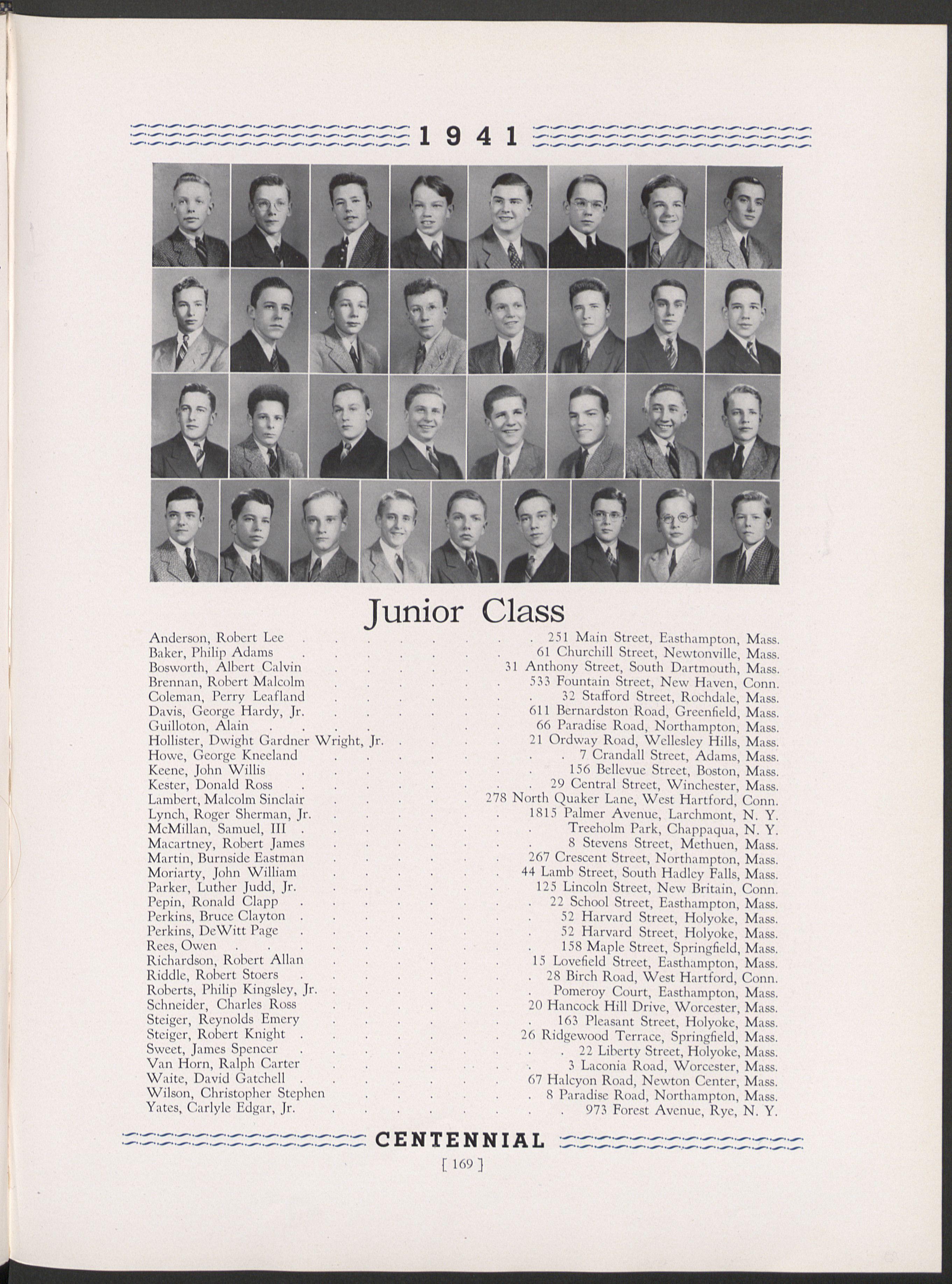
Anderson, Robert Lee . Baker, Philip Adams . Bosworth, Albert Calvin Brennan, Robert Malcolm Coleman, Perry Leafland Davis, George Hardy, Jr. Guilloton, Alain . . . . Hollister, Dwight Gardner Wright, Jr. Howe, George Kneeland Keene, John Willis . Kester, Donald Ross Lambert,Malcolm Sinclair Lynch, Roger Sherman, Jr. McMillan, Samuel, HI Macartney, Robert James Martin, Burnside Eastman Moriarty, John William Parker, Luther Judd, Jr. Pepin, Ronald Clapp . Perkins, Bruce Clayton Perkins, DeWitt Page . Rees, Owen Richardson, Robert Allan Riddle, Robert Stoers . . Roberts, Philip Kingsley, Jr. Schneider, Charles Ross Steiger, Reynolds Emery . Steiger, Robert Knight Sweet, James Spencer . Van Horn, Ralph Carter Waite, David Gatchell Wilson, Christopher Stephen Yates, Carlyle Edgar, Jr.
• 251 Main Street, Easthampton, Mass.
61 Churchill Street, Newtonville, Mass.
31 Anthony Street, South Dartmouth, Mass. 533 Fountain Street, New Haven, Conn.
32 Stafford Street, Rochdale, Mass. 611 Bernardston Road, Greenfield, Mass.
66 Paradise Road, Northampton, Mass.
21 Ordway Road, Wellesley Hills, Mass.
7 Crandall Street, Adams, Mass.
. 156 Bellevue Street, Boston, Mass.
. 29 Central Street, Winchester, Mass.
278 North Quaker Lane, West Hartford, Conn. 1815 Palmer Avenue, Larchmont, N. Y.
Treeholm Park, Chappaqua, N. Y.
. 8 Stevens Street, Methuen, Mass.
267 Crescent Street, Northampton, Mass.
44 Lamb Street, South Hadley Falls, Mass.
• 125 Lincoln Street, New Britain, Conn.
. 22 School Street, Easthampton, Mass.
. 52 Harvard Street, Holyoke, Mass.
52 Harvard Street, Holyoke, Mass.
. 158 Maple Street, Springfield, Mass.
15 Lovefield Street, Easthampton, Mass.
. 28 Birch Road, West Hartford, Conn.
. Pomeroy Court, Easthampton, Mass.
20 Hancock Hill Drive, Worcester, Mass.
. 163 Pleasant Street, Holyoke, Mass.
. 26 Ridgewood Terrace, Springfield, Mass.
. 22 Liberty Street, Holyoke, Mass.
. 3 Laconia Road, Worcester, Mass.
67 Halcyon Road, Newton Center, Mass.
g Paradise Road, Northampton, Mass.
973 Forest Avenue, Rye, N. Y.

We,the Seniors of Williston Academy, do hereby bequeath all of our good—well, pretty good—points to the lower classmen of the above-mentioned institution.
To Maurice Avery does George Adam leave his ability on the basketball court.
"Bill" Alpert gladly leaves his hurdling ability to Walter Walker.
"Three Acre" Bailey leaves his abundant poundage to little Carlysle Yates.
"Chuck" Barnard gives his ability to get into trouble to anyone who wants the darned gift.
"Joe" Behan asks us to give his quizzical expression to "Tex" Works—if he gets back.
To the mighty John Teall go the excellent tennis strokes of George "Brains" Benham.
George Bissell bequeaths his aptitude in the chem. lab. to the youthful scientist, Warren Hayes.
"Bob' Brautigam leaves his drag with Mr. Hepworth to "Big Bob" Jay.
To the ambitious "Kelley" Krohn goes the newspaper business of that Williston magnate, Stevens Brown.
"Buck" Buckingham gladly wills his smooth features to the already handsome Perry Coleman.
"Russ" Cameron leaves his prominent influence with the faculty to "Mort" Catok.
Walter Card leaves his Casanova personality to the ever-sosmooth Bruce Perkins.
"Jim" Carroll gladly wills and bequeaths his blank but "intellient" stare to Dick Grant.
"Mort' Cavanaugh leaves his mighty muscles to husky Rey. Steiger; may he bulge in peace.
Lindsay Collins leaves the women of Easthampton to a very worthy successor, James Sweet.
To "Bill" Goodrich goes Jack Costello's Saturday night activities.
Bruce W.—that stands for Wallace—Cronmiller leaves his artistic talent to "Walt" Van Cott.
"Phil" Denniston gives his friendship with Justice Black to our eminent historian, Mr. Itepworth.
"Extinct Volcano" Diamond leaves his deep and philosophical history outlines to John Gans.
Claude "Have you done your lesson today" Douglas bequeaths "Hamp" to Clovis Prendergast.
"The Flying Dutchman," Richard Douglas, wills his red hair to'Bill" Glenney.
To Mr. Bell does "Brad" Dunbar bequeath his ability at the bridge table.
"Bob" Epstein gladly leaves Ford Hall to Mr. Winship, or anybody else who will take it away.
"Big Don" Ferree, the genius of geometry, gladly wills the darned stuff to "Bob" Gittins.
"Bob" Finsthwait gladly donates his radiant good nature to A. Kennedy.
"Fred" Fischer asks us to give his position on the tennis team (right next to Mr. Hepworth) to Charlie Russell.
John "Gibby" Gibbons leaves his headwaiter's post to Mrs. Harper; she can do as she wishes with it.
The pride of the South, the rebel of Ford Hall, Jim Gwatkin, leaves his drawl to posterity.
Dave Harris wills his knowledge of history to Warren Hayes.
"Nig" Hart leaves his speed on the track, and other places, to "Dick" Waite.
"Don" Hawley bequeaths Burnham to "Bob" Brennan. May he use it to good advantage.
"Phil" Holmes leaves his handsome profile to the already smooth "Bill" Powers.
"Killer" Holmes wills his garrulity to the already loquacious Rey. Steiger.
To "Pete" Petricca does "Dick" Hull donate his everlasting good humor.
Owen Kennedy bestows his ability to "raise cain" and get away with it to Carl Yates.
"Bill" Kennedy donates his splendid voice to the Glee Club for future use.
To the baseball team goes "Sparrow" Killory's .500 batting average.
To Reemsnyder goes "Johnny" Ladd's speed as a tray ,juggler.
"Arnie" LaPierre gladly bestows his "Master of Dress' degree upon the smooth Mason Barnard.
Neale Leete donates his North Hall shower to "Dapper Dan" Denslow.
Vance Likins, the coke killer, leaves "Mac's" and Janet to Roscoe Steffen.
"Jim" Lord bestows his artistic intellect and pictorial abilities to "Jeff" Leary.
"Fran" Lovett leaves his bear grease to Henry Rainaud.
"Bill" McCarthy asks us to donate his good humor to R. 0. Johnson.
The 1942 tennis team receives the No. 2 spot from Bill McClelland.
"Jim" MacNaughton donates his hurdles and his power to win to "Gil" Camp.
"Bbb" Martin reluctantly leaves Williston, all of it, to posterity.
"Mac" Matthias donates his Junior School table to Claude Miquelle.
"Walt" Miller asks us to give his baseball team to the embryo star, "Chuck" Curran.
"Monty" Montgomery leaves us this best of all "Logs" to remember him by.
"Don" Moore leaves his snow-white complexion to smooth Keith Kingsbury.
Maz..e Moulton bequeaths the U. S. Navy to Irving Bailey.
"Ned' Nock gladly bestows his ability to play tennis upon Dick Grant.
Harry "Cave Man" Peden gives his Sunday School class to the religious element in school.
David Piper gladly gives his happy smile to the grim Hugh Cadle.
To Bruce Hopkins does "Pete" Powers donate the Canaries.
"Pittsburgh Phil" Quinn bestows his ethereal dramatic powers upon the sentimental Leon Waskiewicz.
"Bob" Richards bestows his mathematical ingenuity upon the intellectual Charlie Russell.
Clarke Richmond bestows Curran upon anybody he can get to take him.
"Jesse" Ring, haircut and all, gives his collegiate attitude to Don Benham.
Warren Rosati leaves his slim figure to the husky Allan Denslow.
"Rusty" Rustemeyer gives his quiet attitude to "Bob" Jay.
J. J. L. Simpson throws his names out upon the seas of fraternity.
John Slattery gives South Hall back to Mr. Thomas.
"Jock" Spaulding, the driving editor of the Willistonian, gives his half-mile ability to the future star, David Waite.
Joe Swindells leaves his javelin to Howe, a worthy successor.
To John Newton does Symington bequeath the football team.
"Don" Tench gladly gives his splendid voice to Keith Kingsbury.
"Bill" Tyrrel leaves his ethereal figure to the "suave" George Garretson.
Roger Van de Carr donates his tennis ability to the smooth "Andy" Knowland.
Jim Wheeler gives his chemistry books to a large fire.
"Stu" Young bestows his wavy hair to the curly-haired "Bill" Glenney.
And so the class of 1940-41 passes on into the ranks of alum ni. With them, however, goes the memory of Williston—something which they never will give away. Phooey!


The purpose of any student. council is to establish a sense of honor and good fellowship among the members of the student body. Our Student Council this year has done this difficult work smoothly and effectively, with very little fuss or advertisement of any kind. The members of this council have really done a good job.
As usual, this year the council has fulfilled all the duties which were expected of it, including whatever social events were held after the football games, and informal dances after the basketball games. This year, however, they went one step further, and,really organized a Saturday evening informal dance which was an immediate success, and toward which we may look forward again.
The main upholders of the honor system, the members have done their best to see that the policies involved in that system were carried out to the best advantages of the students. The Student Council is not a group of fellows picked from the school merely because of high moral standards, but rather because they are the ones who seem better able to handle any difficulties which might arise. They are the direct medium between the whole student body and the faculty, petitioning when petitions are felt necessary by the majority. Theirs is the task not only of setting things right after wrongs have been done, but also of doing their best to prevent recurrences.
Guided by Mr. Lossone, they are an intricate and necessary part of Williston in themselves, and in their governing, which should be and is just and impartial.
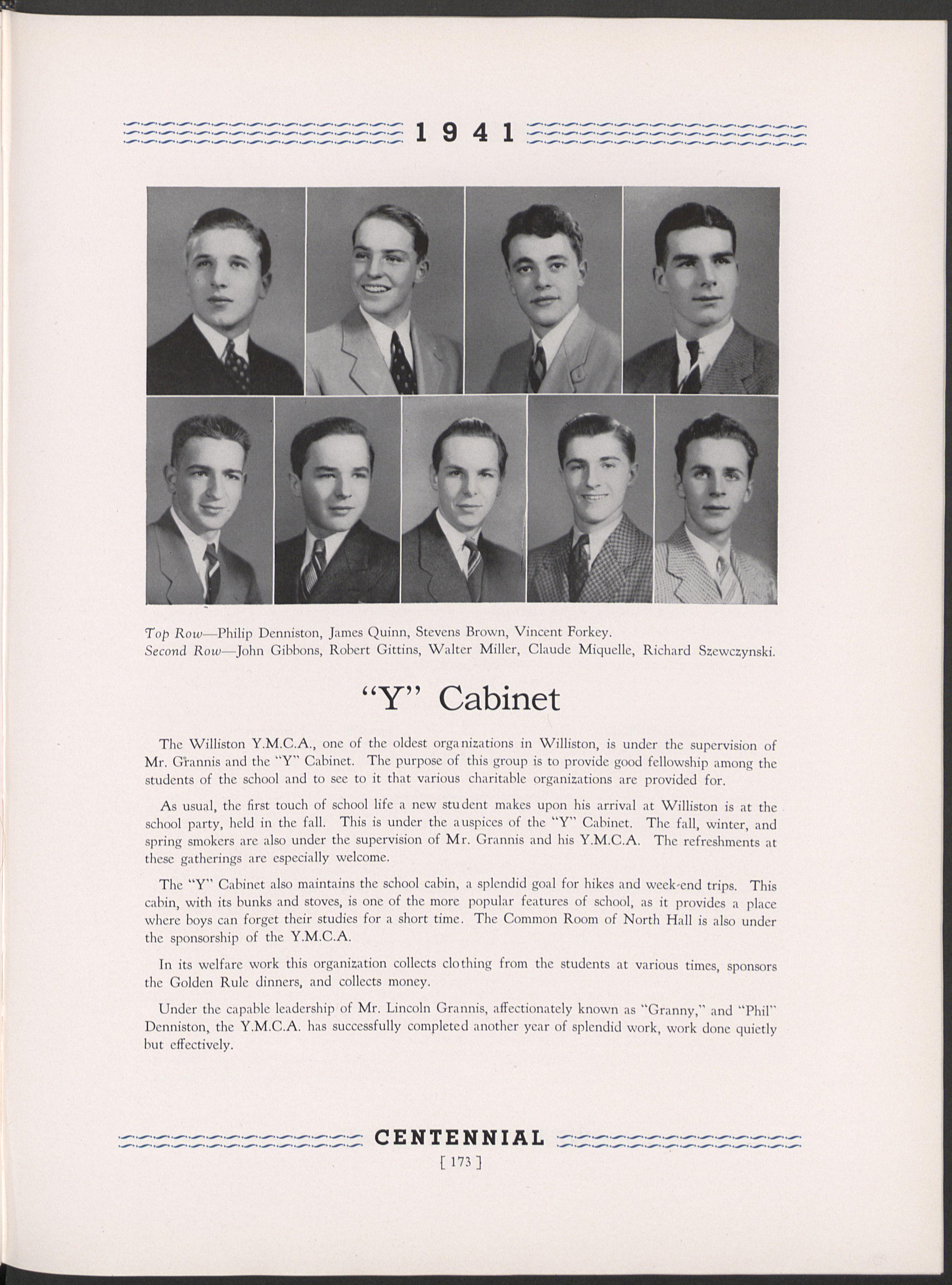
Top Row—Philip Denniston, James Quinn, Stevens Brown, Vincent Forkey. Second Row—John Gibbons, Robert Gittins, Walter Miller, Claude Miquelle, Richard Szewczynski.
The Williston Y.M.C.A., one of the oldest organizations in Williston, is under the supervision of Mr. Grannis and the "Y" Cabinet. The purpose of this group is to provide good fellowship among the students of the school and to see to it that various charitable organizations are provided for.
As usual, the first touch of school life a new student makes upon his arrival at Williston is at the school party, held in the fall. This is under the auspices of the "Y" Cabinet. The fall, winter, and spring smokers are also under the supervision of Mr. Grannis and his Y.M.C.A. The refreshments at these gatherings are especially welcome.
The "Y" Cabinet also maintains the school cabin, a splendid goal for hikcs and week-end trips. This cabin, with its bunks and stoves, is one of the more popular features of school, as it provides a place where boys can forget their studies for a short time. The Common Room of North Hall is also under the sponsorship of the Y.M.C.A.
In its welfare work this organization collects clothing from the students at various times, sponsors the Golden Rule dinners, and collects money.
Under the capable leadership of Mr. Lincoln Grannis, affectionately known as "Granny," and "Phil" Denniston,. the Y.M.C.A. has successfully completed another year of splendid work, work done quietly but effectively.
Every year the five student representatives of the Athletic Advisory Board, in conjunction with the four faculty members, do much in guiding the athletic activities during our school year. The five student members are fellows who are usually prominent in athletics. Four are chosen by their respective dorms, and the fifth by the day students. The faculty representation tends to voice opinions in the different branches of Williston sports, and thus aid the student members in making wiser decisions.
At the close of the three athletic seasons the board performs its two principal duties: it awards letters to the fellows who have shown creditable and satisfactory performance in one of the seven major sports, and then chooses the succeeding managers for the next year. We feel that this year's board has been exceptionally important, for it put through the plan of giving letters to graduating Seniors who have been on any varsity squad for two years or more.
STUDENT MEMBERS
Vincent H. Forkey
Philip D. Holmes
Mr. Boardman, Chairman
Mr. Lossone

Donald F. Ryan
FACULTY MEMBERS
James H. MacNaughton
Walter R. Miller
Mr. Putnam
Mr. Watters
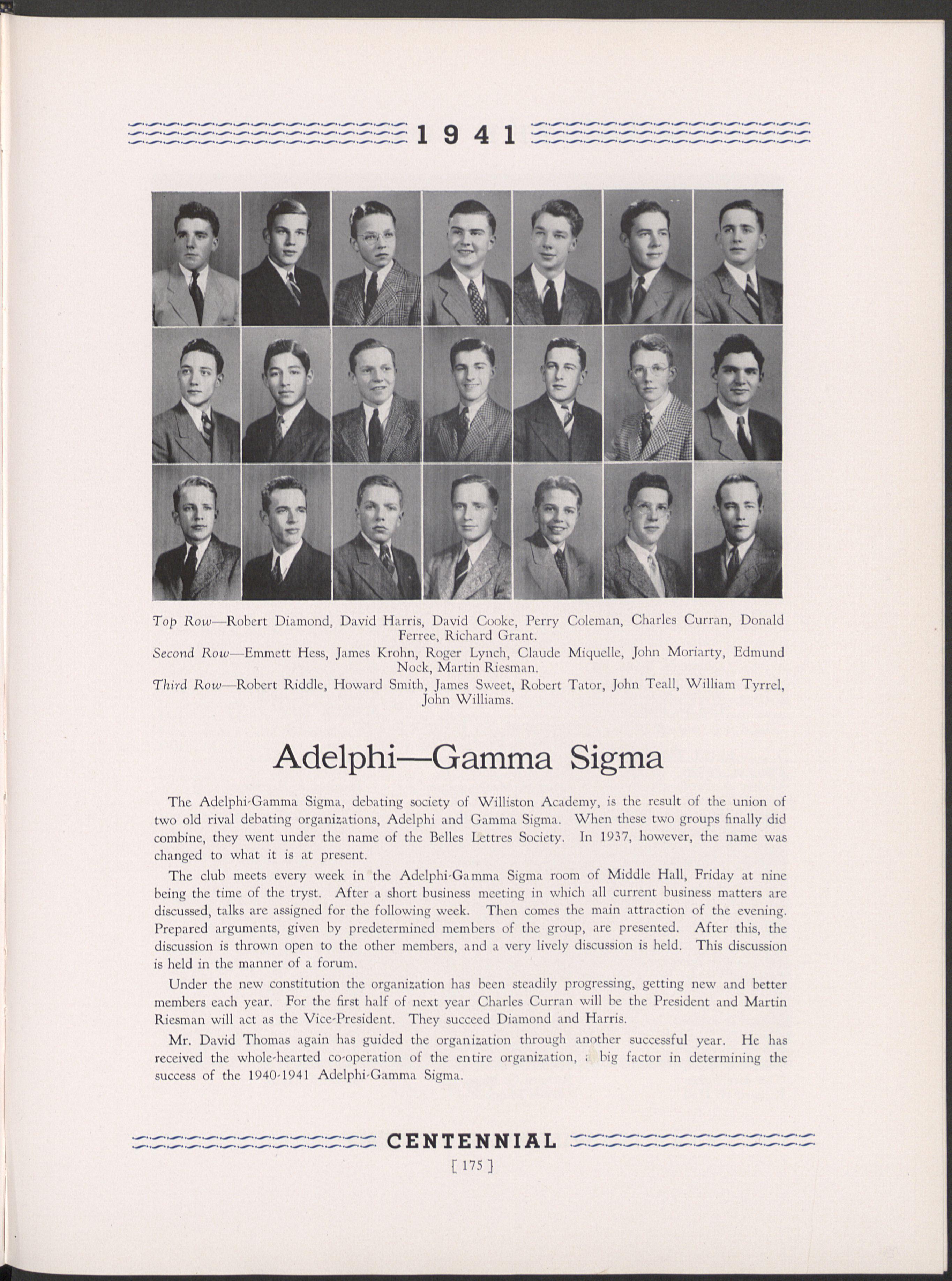
Top Row—Robert Diamond, David Harris, David Cooke, Perry Coleman, Charles Curran, Donald Ferree, Richard Grant.
Second Row—Emmett Hess, James Krohn, Roger Lynch, Claude Miquelle, John Moriarty, Edmund Nock, Martin Riesman.
Third Row—Robert Riddle, Howard Smith, James Sweet, Robert Tator, John Teall, William Tyrrel, John Williams.
The Adelphi-Gamma Sigma, debating society of Williston Academy, is the result of the union of two old rival debating organizations, Adelphi and Gamma Sigma. When these two groups finally did combine, they went under the name of the Belles Lettres Society. In 1937, however, the name was changed to what it is at present.
The club meets every week in the Adelphi-Ga mma Sigma room of Middle Hall, Friday at nine being the time of the tryst. After a short business meeting in which all current business matters are discussed, talks are assigned for the following week. Then comes the main attraction of the evening. Prepared arguments, given by predetermined members of the group, are presented. After this, the discussion is thrown open to the other members, and a very lively discussion is held. This discussion is held in the manner of a forum.
Under the new constitution the organization has been steadily progressing, getting new and better members each year. For the first half of next year Charles Curran will be the President and Martin Riesman will act as the Vice-President. They succeed Diamond and Harris.
Mr. David Thomas again has guided the organization through another successful year. He has received the whole-hearted co-operation of the en tire organization, big factor in determining the success of the 1940-1941 Adelphi-Gamma Sigma.
President, Donald R. Tench

Vice•President, Francis W. Lovett, Jr.
Manager, Bruce A. Hopkins
Assistant Manager, William K. McClelland
George N. Bissell, III
D. Torrey Buckingham
Walter A. Card
Don W. Hawley
FIRST TENORS
Philip A. Baker
Walter A. Card
John J. Costello, Jr.
Philip L. Denniston
Robert W. Farr
Robert A. Finsthwait
George A. Garretson
Richard B. Grant
Don W. Hawley
George K. Howe
Robert 0. Johnson
Rowan P. Perkins, 2nd
William C. Riddle, Jr.
Richard W. Szewczynski
Robert B. Tator
James H. Wheeler, 2nd
FIRST BASSES
Robert T. Arnold, Jr.
Charles T. Barnard, Jr.
Hubert H. Cadle
Gilbert P. Camp
Theodore Fisher
Richard H. Hull
Neale E. Leete
James H. MacNaughton, Jr.
Robert A. Richards
Robert B. Tator
Accompanist, Mr. Frederick B. Hyde
Director, Mr. Charles E. Rouse
Robert R. Jay
Francis W. Lovett, Jr.
James H. MacNaughton, Jr.
William K. McClelland
Mace Moulton, III
John M. Newton, Jr.
Harry E. Peden, Jr.
William E. Powers
Richard J. Ring
Warren E. Rosati
Robert W. Sanders
SECOND TENORS
Irving C. Bailey
George S. Benham, Jr.
George N. Bissell, III
Wallace M. Burnett
Richard K. Douglas
Bruce A. Hopkins
John F. Ladd
George W.Leary
Neale E. Leete
Herbert P. Mason, Jr.
Richard G. Messenger
Claude Miquelle
Donald M. Moore
David A. Piper
Harding E. Reemsnyder
Reynolds E. Steiger
William T. Tyrrel
Waldemar Van Cott, II
SECOND BASSES
D. Torrey Buckingham
Russell Cameron
Eldon H. Crowell
David K. Harris
Arnaud J. LaPierre, Jr.
William E. McCarthy
James F. McDonald, Jr. G. Alton Nicholls
Edmund K. Nock
John W. Prescott
Robert A. Richards
Donald F. Ryan
Norman E. Smith
Roscoe T. Steffen
Donald R. Tench
Stuart F. Young
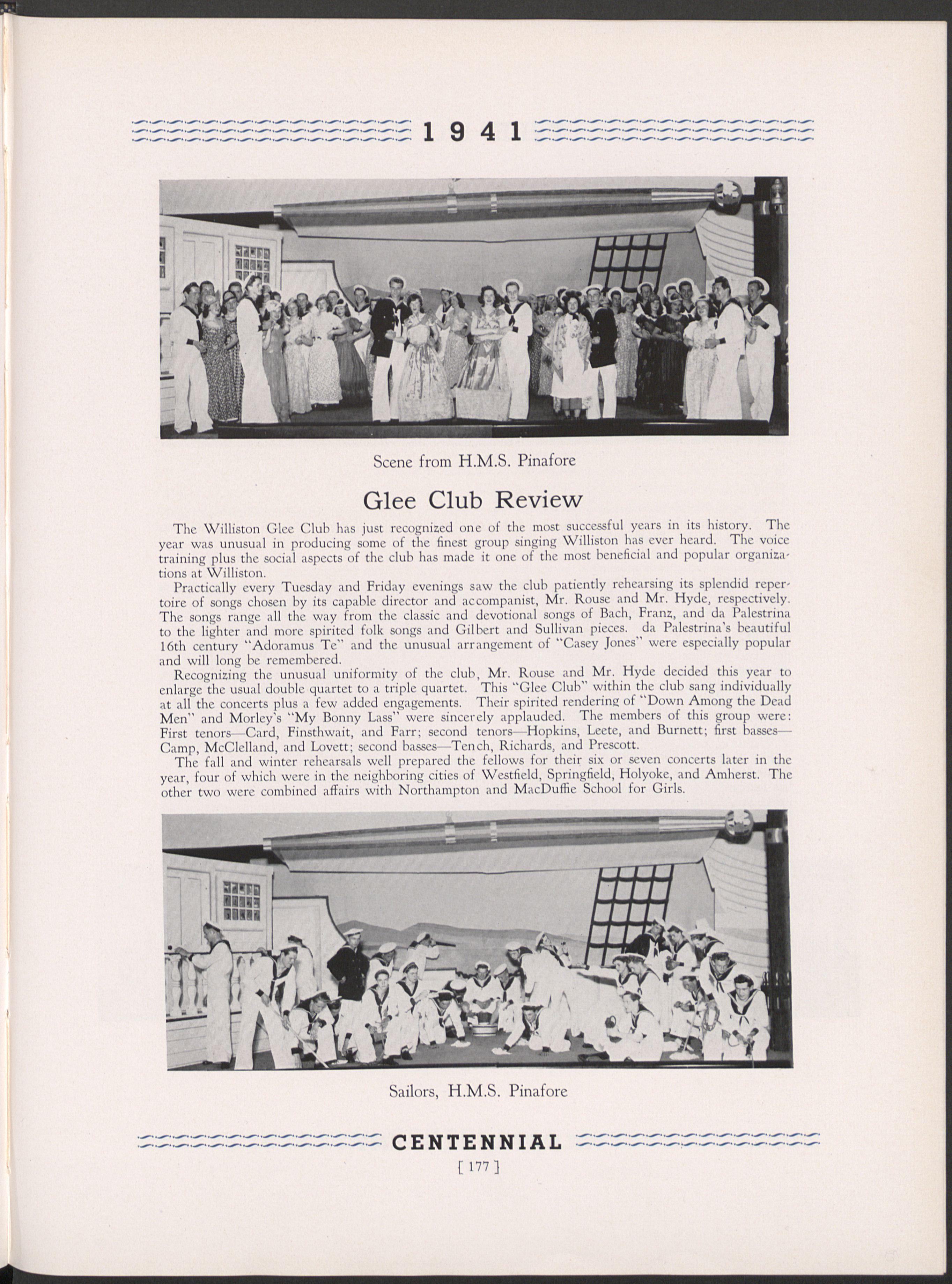
The Williston Glee Club has just recognized one of the most successful years in its history. The year was unusual in producing some of the finest group singing Williston has ever heard. The voice training plus the social aspects of the club has made it one of the most beneficial and popular organizations at Williston.
Practically every Tuesday and Friday evenings saw the club patiently rehearsing its splendid repertoire of songs chosen by its capable director and accompanist, Mr. Rouse and Mr. Hyde, respectively. The songs range all the way from the classic and devotional songs of Bach, Franz, and da Palestrina to the lighter and more spirited folk songs and Gilbert and Sullivan pieces. da Palestrina's beautiful 16th century "Adoramus Te" and the unusual arrangement of "Casey Jones" were especially popular and will long be remembered.
Recognizing the unusual uniformity of the club, Mr. Rouse and Mr. Hyde decided this year to enlarge the usual double quartet to a triple quartet. This "Glee Club" within the club sang individually at all the concerts plus a few added engagements. Their spirited rendering of"Down Among the Dead Men" and Morley's "My Bonny Lass" were sincerely applauded. The members of this group were: First tenors—Card, Finsthwait, and Farr; second tenors—Hopkins, Leete, and Burnett; first basses— Camp, McClelland, and Lovett; second basses—Tench, Richards, and Prescott.
The fall and winter rehearsals well prepared the fellows for their six or seven concerts later in the year, four of which were in the neighboring cities of Westfield, Springfield, Holyoke, and Amherst. The other two were combined affairs with Northampton and MacDuffie School for Girls.

The annual combined concert on March 16, 1941, with the Northampton School for Girls was highly successful both musically and socially, as a dance was held after the singing. The same procedure was followed at the MacDuffie School, where an equally pleasant evening was had by all.
Shortly after the Christmas holidays, the directors of both clubs, Williston and Northampton School for Girls, started chorus rehearsals for the yearly Gilbert and Sullivan presentations. These spectacular productions, especially for amateurs, are fast becoming a tradition at Williston. The operetta chosen this year was "H. M. S. Pinafore," a comic opera well adapted for school production.
After weeks of prodigious practicing, the cast put on its show May 2 and 3, again on Parents' Day, May 24, and finally June 6. The principals were all in character and gave splendid performances. Ruth Jeffers and Elizabeth Tucker were the feminine leads. Ruth's splendid voice and "Tuck's" fine portrayal of "Buttercup, the Bumboat Woman" will long be remembered. Donald Tench, the club's president, as Sir Joseph Porter, was the outstanding comical personage of the show, yet he held back enough to truly impersonate a real "ruler of the Queen's Navy." Francis Lovett, as Captain Corcoran, did a splendid job both vocally and in acting his difficult part. Robert Tator did creditable work as the "sailor in love—Ralph Rackstraw."
This group with the more than able choruses, plus some of the best scenery and costuming ever seen at Williston, produced a thoroughly enjoyable performance.
The "Log" and the student body here wish to give their sincere thanks and appreciation to Mr. Rouse and Mr. Hyde for their devoted work in directing and leading the Glee Club to the success it has recognized in recent years. The patient persistence of Mr. Rouse in his directing, plus Mr. Hyde's priceless aid and knowledge in constructing the "Pinafore's" scenery, were the true foundations of the operetta's success.
September 2-11

September 30-October 9
Modern American Paintings (color reproductions), Living American Art, Inc. Selection C,Twentieth Annual Competition, American Photographic Pub. Co.
October 9-23
October 23-Novcmher 5
November 4-11
November 11-20
November 20-December 4
December 4-18
January 6-18 Drypoints
of Yale
January 18-February 3
February 3-17
February 19-March 5
March 5-19
April 3-17
April 21-May 10
May 15-28
June 1-10
Arts Association Exhibit: Goya and Daumier
Etchings and Lithographs from Mr. Galbraith's collection
Arts Association Exhibit: Figures in Bronze Exhibition of Photographs of the School, taken by Rittase
Arts Association Exhibit: Prints on Sale I
• Arts Association Exhibit: Mediaeval Church University by Samuel Chamberlain and others in copperplate Smith College Faculty Exhibition
• • . Arts Association Exhibit: Color
Arts Association Exhibit: Structure in Architecture
• Arts Association Exhibit: Prints on Sale II
Arts Association Exhibit: American Indian Painting Arts Association Exhibit: Painting a Mural
• Paintings by Robert Strong Woodward Williston Historical Exhibit

Standing: Mr. Johnston, Gittins, Fischer, Buckingham, R. Douglas, R. Holmes
Seated: Brautigam, S. Brown, Montgomery, Denniston
In this, the centennial year of Williston Academy, the "Log" staff has attempted to present a book which has covered the growth of Williston from its infancy to its present state. The book also gives a concise resume of the past year's activities on the playing fields, on the campus, and in the halls.
This year's "Log" is larger and, we hope, better than any of its predecessors. It is impossible to thank everyone connected with its publication, but we should like to take this opportunity to express our gratitude to all those who have in any way assisted in any capacity whatever. The keynote in the production of the 1941 book has been the co,operation shown by the various departments of the staff.
A great deal of work is necessary to place a book of this type before the student body. It is working on a project like this which really proves the mettle of a fellow's character, for there is no applause, no glory, only work, hard work. There are pictures to be taken, editorials to be written, histories to be compiled, captions to be made, paste•ups to be done, and statistics to be obtained. All this must be done, and it is chiefly on the shoulders of eight or nine fellows that this work falls. It is up to the heads of the various departments to organize the staffs under them, to hand out and collect assign, ments, and, above all, to assume the responsibility of having the material on hand when it is called for.
But all this could never have been accomplished without the able leadership of our editonin,chief and the steadying influence of an experienced faculty adviser.
"Monty" has taken his editorship very seriously, and has given a great deal of time and energy to the work: thus to him should go a great deal of the credit for the success of this year's "Log."
The job of aiding and encouraging the "Log" staff over the rough places has fallen for the tenth successive time into the hands of Mr. Johnston, who has spared no one, including himself, in order that this year the "Log" might be supreme.

John C. Montgomery, Jr., Editopin-Chief
Stevens D. Brown
Mason Barnard, Jr.
Charles E. Curran
Bruce A. Hopkins
EDITORS
ASSISTANTS
Evan V. Johnston
Keith Kingsbury
Samuel McMillan, Jr.
Robert B. Gittins
Herbert P. Mason, Jr.
William K. McClelland
Josiah J. L. Simpson
Daniel T. Buckingham
Eldon H. Crowell
Lindsay M. Collins
Robert A. Finsthwait 1
EDITORS
ASSISTANTS
Frederick G. Fischer
James H.MacNaughton John P. Spaulding
William E. McCarthy John L. Teall
Harry E. Peden, Jr. • Stuart F. Young
MANAGERS
Philip L. Denniston
Albert C. Bosworth
David A. Piper
Warren E. Rosati
Robert W. Brautigam
ASSISTANTS
Howard B. Smith, Jr.
William T. Tyrrel
Waldemar Van Cott, II
V. F. Likins, Jr.
EDITORS
Raymond M. Holmes, Jr.
ASSISTANTS
George K. Barnhard, Jr.
Allan Denslow
G. Donald Ferree
Bruce W.Cronmiller, Art Editor
Richard K. Douglas
Carl T. Harris, Jr.
John F. Lee
Edwin A. Georgi
Earl N. Johnston, Faculty Adviser
DITOR IA I, STA IT
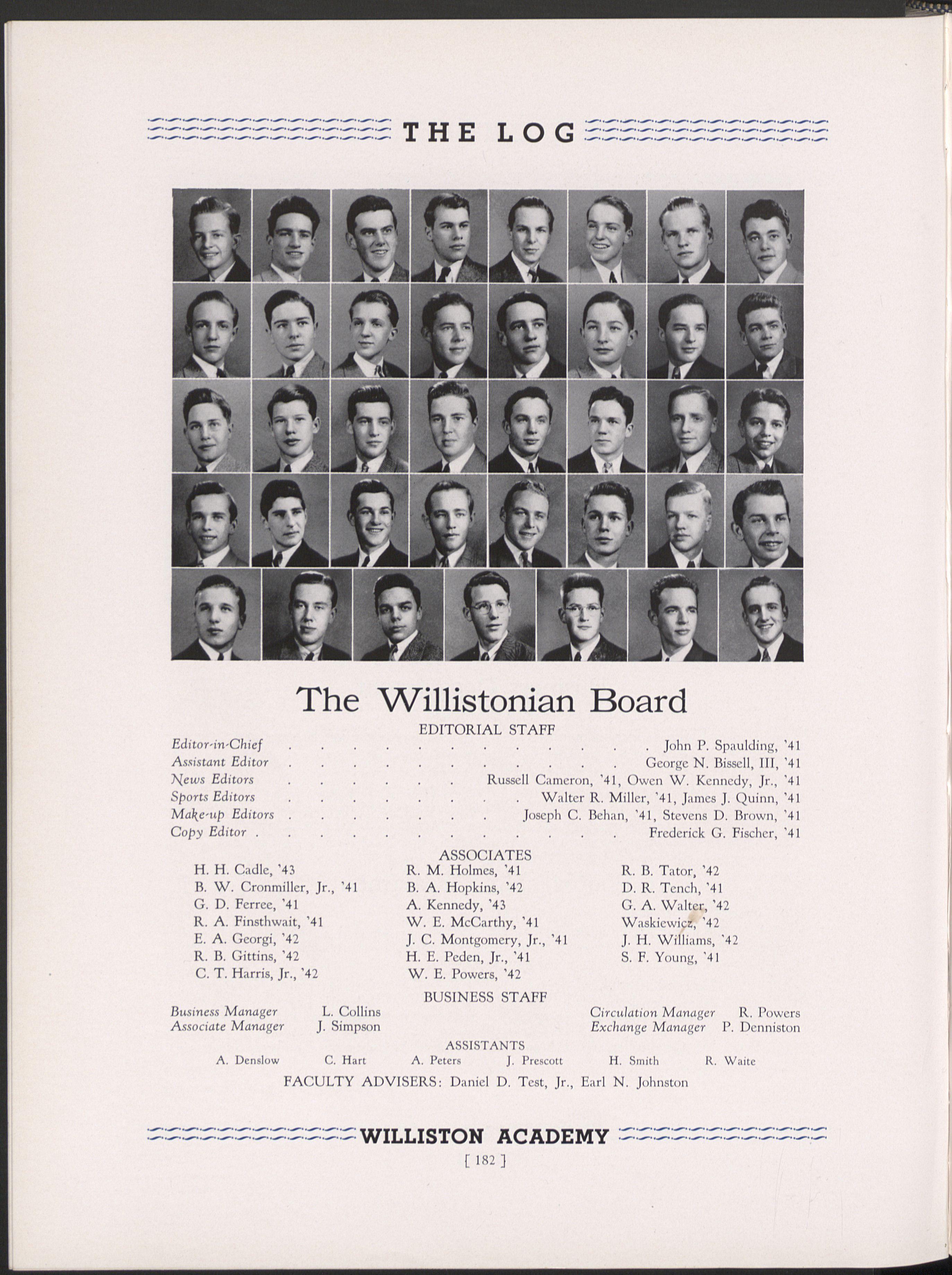
Editor-in-Chief
Assistant Editor
News Editors
Sports Editors
Make-up Editors
Copy Editor
H. H. Cadle,'43
B. W. Cronmiller, Jr., '41
G. D. Ferree, '41
R. A. Finsthwait,'41
E. A. Georgi,'42
R. B. Gittins,'42
C. T. Harris, Jr.,'42
Business Manager
Associate Manager L. Collins J. Simpson
A. Denslow C. Hart
John P. Spaulding, '41
George N. Bissell, III, '41
Russell Cameron, '41, Owen W. Kennedy, Jr., '41
Walter R. Miller,'41, James J. Quinn,'41
Joseph C. Behan, '41, Stevens D. Brown, '41
ASSOCIATES
R. M. Holmes, '41
B. A. Hopkins, '42
A. Kennedy,'43
W. E. McCarthy,'41
J. C. Montgomery, Jr., '41
H. E. Peden, Jr., '41
W. E. Powers,'42
BUSINESS STAFF
ASSISTANTS
A. Peters J. Prescott
Frederick G. Fischer, '41
R. B. Tator,'42
D. R. Tench,'41
G. A. Waltex,'42
Waskiewipt '42
J. H. Williams, '42
S. F. Young,'41
Circulation Manager R. Powers
Exchange Manager P. Denniston
H. Smith R. Waite
FACULTY ADVISERS: Daniel D. Test, Jr., Earl N. Johnston

9 4 1
For sixty years a most important extracurricular activity at Williston has been the Willistonian. This year was no exception, and, under the capable editorship of John Spaulding, the Willistonian was issued twelve times.
Made up every third Sunday after a special breakfast at ten o'clock for the staff, the Willistonian features editorial columns, and also contains write-ups of all first-team games and many minor-team games. These write-ups, together with general school news and an "Idle Rumor" column, have been handled by the many and efficient associates. Indeed, one of the outstanding points concerning this year's Willistonian has been the excellent co-operation shown by the members of a board which has earned the praise of being one of the smoothest working boards in the history of the paper.
Among several new changes in the school paper this year was the interchanging of heavy type for the column heads. Another change in the general make-up of the paper was the incorporation of more pictures per issue than had so far been seen in any previous Willistonian. These pictures for the most part concerned first-team games, although pictures of the Dramatic Club plays, the Glee Club, "Y" Cabinet, and the Student Council were also included.
Much credit must also be given to the business department. This vital, but unnoticed, half of the Willistonian was this year headed by Lindsay Collins, who has done an excellent job as business manager. Aided by his associate and several assistants, he contrived successfully to make the Willistonian pay for itself. In fact, so successfully did the business department function that at the end of the year it partially financed a banquet for all the members of the Willistonian staff at the Roger Smith Hotel in Holyoke.
To the Willistonian's two faculty advisers, Mr. Johnston and Mr. Test, this year's staff wishes to give many thanks for their guidance and assistance during the past year. And to next year's editor and staff we offer our best wishes for a successful year.
October 16 . The Significance of the Selective Service Bill
November 11 Gaylord W. Douglass,"After the War—What?"
November 16 . . Fathers' Day
December 13
Dramatic Club Plays, "The Mouse," "The Trysting Place," "The Crow's Nest"
December 16 . Athletic Get-Together
January 28 Time Current Affairs Test
February 16 Glee Club Concert at Springfield Art Museum
February 21 New York Alumni Banquet
February 27 Chicago Alumni Banquet
March 1 Dance
March 5

Dramatic Club Play, "The Perfect Alibi"—Southampton performance
March 7 . Dramatic Club Play,"The Perfect Alibi"
March 9 Glee Club Concert at Jones Library, Amherst
March 10 Washington Alumni Banquet
March 15
Williston-Northampton School for Girls Combined Glee Club Concert
March 17 Athletic Get-Together
March 24 Pittsfield Alumni Banquet
March 25 Philadelphia Alumni Banquet
April 2 . Boston Alumni Banquet
April 3 . Worcester Alumni Banquet
April 4 Glee Club Concert at Westfield Congregational Church
April 11 New Haven Alumni Banquet
April 15 Springfield Alumni Banquet
April 22 . Hartford Alumni Banquet
April 25 . Glee Club Concert at First Congregational Church, Holyoke
May 2 and 3 "Pinafore"
May 9 Prom
May 17 Educational Convocation
May 17 Williston-MacDuffie School for Girls Combined Glee Club Concert, Springfield
May 24 Parents' Day
May 24 "Pinafore"
June 6 "Pinafore"
September 22 Rev. Owen Whitman Eames
September 29 Bishop W. Appleton Lawrence
October 6 Dr. S. Ralph Harlow
October 13 Dr. John Homer Miller
October 20 Dean Rockwell Harmon Potter
October 27 Rev. Robert M. Bartlett
November 3 Dean Percy T. Edrop
November 10 Rev. Ray Gibbons
November 17 Rev. Albert J. Penner
November 24 Dr. James Gordon Gilkey
December 8 Dr. Hugh Black
December 15 Dr. Henry H. Tweedy
January 12 Dr. Frederick M. Eliot
January 19 Rev. Stephen F. Bayne, Jr.
January 26 Dr. Ashley Day Leavitt
February 2 Mr. James T. Clelland
February 16 Rev. Frederick H. Thompson
February 23 Rev. Frank J. Scribner
March 2 Rev. William E. Park
March 9 Mr. Erdman Harris
March 16 Dr. Henry P. Van Dusen
April 6 Dean Charles R. Brown
April 13 Mr. Roy B. Chamberlain
April 20 Rev. J. Burford Parry
April 27 Rev. A. Grant Noble
May 4 Rev. Francis T. Cooke
May 18 Dr. James Gordon Gilkey
May 25 Dr. Remsen B. Ogilby
June 1 Rev. 0. W. Eames
June 8 Dr. Frederick R. Griffin

• Church of Unity, Springfield, Mass. Diocese of Western Massachusetts
. Smith College, Northampton, Mass.
The Hope Congregational Church, Springfield, Mass.
The Hartford Theological Seminary, Hartford, Conn.
The First Church of Christ, Longmeadow, Mass.
• Christ Church Cathedral, Springfield, Mass.
The First Church of Christ, Northampton, Mass.
Second Church, Holyoke, Mass.
South Congregational Church, Springfield, Mass.
Union Theological Seminary, New York, N. Y.
Yale University Divinity School, New Haven, Conn.
. American Unitarian Association, Boston, Mass.
St. John's Episcopal Church, Northampton, Mass.
• Harvard Church, Brookline, Mass.
• Amherst College, Amherst, Mass. Congregational Church, Easthampton, Mass.
Gen. Secretary, Congregational Pension Boards, New York, N. Y.
• The Northfield Schools, E. Northfield, Mass.
• Lawrenceville School, Lawrenceville, N. J.
Union Theological Seminary, New York, N. Y.
• . Yale Divinity School, New Haven, Conn.
Dartmouth College, Hanover, N. H.
Wellesley Congregational Church, Wellesley, Mass.
• Chaplain, Williams College, Williamstown, Mass.
The First Congregational Church, Bristol, Conn.
South Congregational Church, Springfield, Mass.
President, Trinity College, Hartford, Conn.
Chaplain, 104th Infantry, Camp Edwards, Mass.
First Unitarian Church, Philadelphia, Penn.
James Quinn, President
Robert Anderson
Charles Barnard
Lindsay Collins
Donald Benham
Robert Epstein
Stevens Brown
Bruce Cronmiller
Allan Denslow
Alan Kennedy

Frederick Fischer
Donald Hawley
Emmett Hess
Harry Peden
Martin Riesman
Robert Symington
Owen Kennedy
Andrew Knowland
Malcolm Lambert
Richard Messenger
John Teall
Robert Tator
Gilmore Walter
Theodore Whitney
Stuart Young
David Piper
Josiah Simpson
James Sweet

1 9 4 1
With many new members, the Williston Dramatic Club ably presented three one-act plays in the fall. Louis Palmer produced Manley's "The Crow's Nest." The small cast composed of Robert Anderson, Frederick Fischer, and Martin Riesman portrayed well the action on a boat engaged in the dangerous trade of smuggling rifles to revolutionary forces.
Howard Boardman directed Tarkington's comedy,"The Trysting Place." The plot was a perplexing situation arising from three different couples making love in one hotel room. The cast will be remembered for their fine acting. They were Charles Barnard, Lindsay Collins, Robert Epstein, Donald Hawley, Robert Tator, Gilmore Walter, and Theodore Whitney.
The third play was "The Mouse," by Armstrong. Hervey Smith directed Jay Quinn, Harry Peden, John Tcall, Robert Symington, and Stuart Young in an amusing performance of this play concerning coastal pirates. The moral of the play is "Mice and women are all the same."
Around came March 8 and talk of the previous fine performances of the Dramatic Club before curtain time. When the curtain rose, the audience looked into the study of Arthur Ludgrove's home.
In the first act the characters were introduced in an efficient manner. Then Arthur Ludgrove, in the person of Howard Boardman, was murdered by two week-end guests. Jay Quinn, the club's president, and Emmett Hess committed the murder and concocted alibis which made the case appear a suicide.
In the second act Martin Riesman appeared on the scene as Sergeant Mallet. He, with the help of his town constable father, collected data and gave a verdict of suicide. Susan Cunningham and Jimmy Ludgrove had a few theories of their own.
In the third act these two, played by John Teall and Lindsay Collins, pondered over the case, hit upon a clue, and evolved the solution. The next day Susan drew thz whole story from Quinn.
Laurel wreaths should go to Jay Quinn and Emmett Hess for their fine portrayal as murderers.
John Tcall and Lindsay Collins acted convincing roles as young lovers. Mr. Hervey Smith, as Major Fothergill, gave an excellent performance. Humor was added by Robert Symington, Donald Benham as

Jane West, Donald Hawley as Mrs. Fulverton-Fane, and Theodore Whitney as Tom Adams. This performance by the Williston Dramatic Club will not be forgotten, along with the unparalleled directing of Louis Palmer.
This, however, is not the whole story of the Dramatic Club. A great many people see and hear those who appear on the stage, but at times forget those working behind the scenes, without whom the productions would not be a success. For this reason, we now take off our hats to the stage crew, one and all, for their splendid work in making this year's club a complete success.

George R. Adam
Hugh C. Arnold
Charles T. Barnard
Ralph P. Bridges
D. Torrey Buckingham
Wallace M. Burnett
Mortimer T. Cavanaugh, Jr.
Vincent H. Forkey
Don W.Hawley
October 12 Away
October 19 Home
October 26 Away
November 4 Away
November 9 Home
November 12 Home
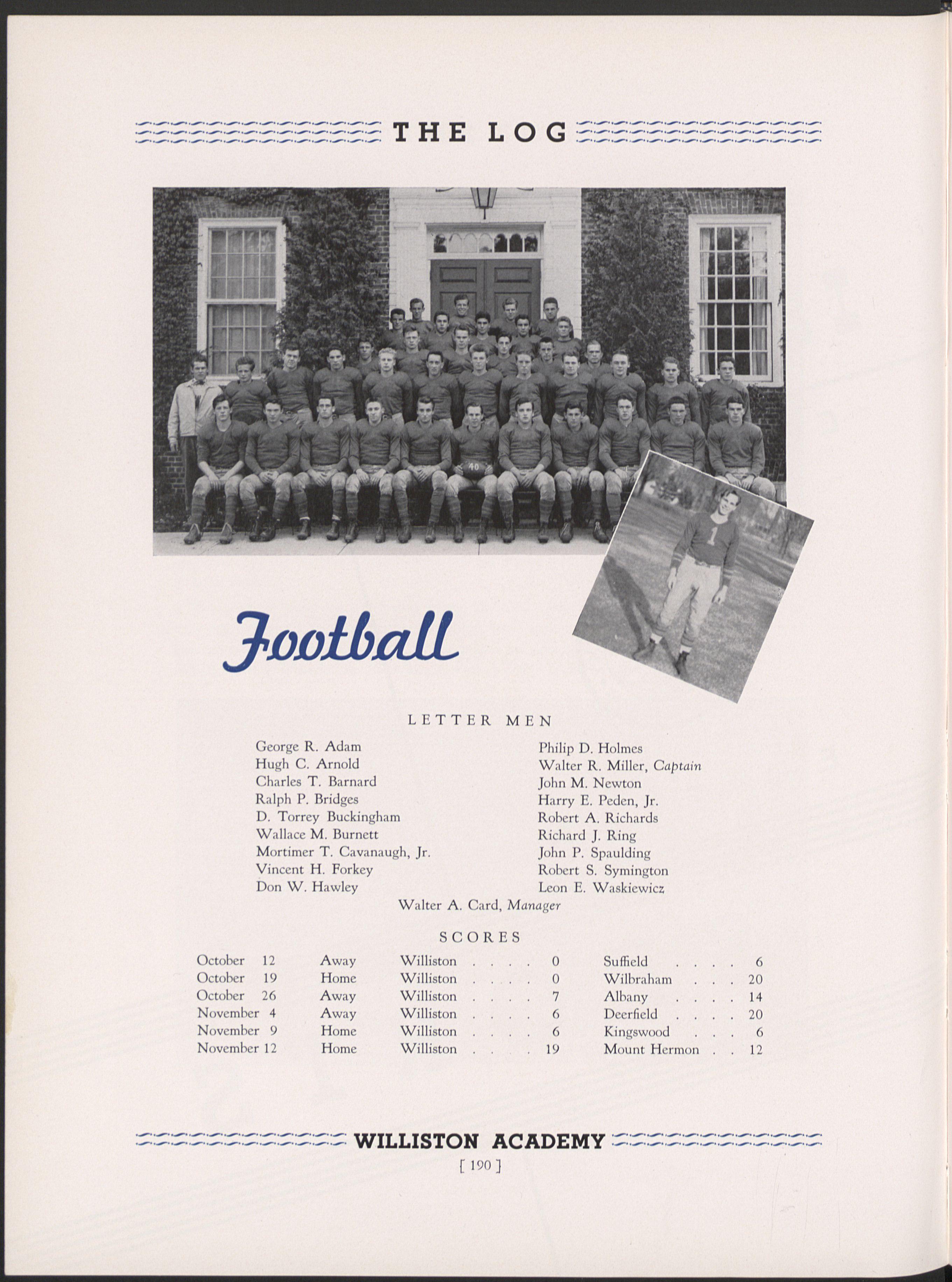
Philip D. Holmes
Walter R. Miller, Captain
John M. Newton
Harry E. Peden, Jr.
Robert A. Richards
Richard J. Ring
John P. Spaulding
Robert S. Symington
Leon E. Waskiewicz
Walter A. Card, Manager SCORES Williston Williston Williston
An entirely untested and unproven team took the gridiron this fall for Williston. A quick glance at the record reveals four defeats, one tie, and one victory, but the season can be regarded as almost successful in that our inexperienced warriors in the latter half of the season finally found their stride.
The season opened on October 12th with a journey to Suffield, where we lacked only the necessary experience to overcome a powerful Suffield aggregation. Because of a slight let-down on our part during a brief minute in a hectic fourth quarter, Suffield was able to push over the only touchdown of the game.
The following week the "Wildcats" played their first home game against a powerful array from Wilbraham. Our opponents overshadowed us in every phase of the game, although our line showed great possibilities in Dick Ring and Mort Cavanaugh.
On October 26th the "Sammy Boys" traveled to Albany, and it was plain to see that it was an off day for Williston. Spirit was lacking and a light but hard-hitting Albany Academy team came off the field on the long end of a 14-7 score.
At Deerfield on November 4th our ancient rival displayed too much power for a stubborn Williston eleven. Our opponents, however, were forced to take to the air to score. The "Wildcats" also tried their luck at passing, but only a blocked kick finally led to a Williston touchdown. Special

praise goes to the line play of John Newton and Dick Ring, while George Adam was exceptional in the backfield.
With the team yet to taste victory, the Kingswood game began. Our opponents drove across a quick score, but there they stalled. The "Sammy Boys" hammered away at the Kingswood forward wall for three periods but could not cross the enemy goal line. With but two minutes to play remaining, Kingswood quick-kicked to the Williston eight-yard line. At this point, with Adam passing to Miller and Peden,the team tied the game in a thrilling finish as the final whistle blew. The try for the extra point missed, but it was clear to see that the team had found its stride.
On Parents' Day the team closed the season with a smashing 19-12 victory over Mount Hermon. Early first period scores marked the encounter, and with the score tied at 12-12, the entire Williston second team entered the fray and tallied the deciding marker.
Stevens D.Brown
Quentin G. Browne
Lindsay M. Collins
Robert B. Gittins
Carl J. Hart
Bruce A. Hopkins
Owen W.Kennedy
John F. Ladd

James H. MacNaughton
William K. McClelland
Claude Miquelle
Richard T. Powers
Josiah J. L. Simpson, Captain
Norman E. Smith
Roger C. Van de Carr
Joseph H. Swindells, Jr. G. Donald Ferree, Manager
This year a well-coached soccer team fought for Captain Simpson to show a fine record of four victories, one tie, and five defeats. Although this record is not impressive in itself, the spirit and sportsmanship shown against better teams was outstanding.
The team started the season by swamping Suffield Academy by a score of eight to one. Next came the best game played by the squad. It was against the blue and white freshman team from Yale, who fought a stiff battle and finally nosed out our booters by a one-to-nothing score.
A game of important note was that with the Amherst Freshmen, when Williston, after having been two goals behind at the half, spurted to tie the score in the third quarter only to be nosed out by an Amherst goal near the end of the game.
Worcester Academy, which has beaten Williston for a number of years, was defeated in an exciting game. Both teams had one try for a penalty shot. Hopkins scored Williston's, while the Worcester bootcr failed to make his goal because of an exceptionally fine save by Van de Carr.

Springfield's College Freshmen and Deerfield's team, our next opponents, both surpassed us in ability, and each of these teams won by three goals. The Mount Hermon School game showed a hard-fighting Williston team, both as a whole and individually, but the best we could do was to come out with a tie after two overtime periods.
The result of the coach's stress on passing this year can be plainly shown in our four victories. Skill in the all-important art of passing was obtained by constant practice on the apparatus used in ability tests for a Springfield College survey.
Praise for such a successful season goes to Coach Test and his fighting team. Special merit is deserved by three of last year's returning lettermen, fullback Dick Powers, halfback Captain Jim Simpson, and forward Carl Hart. The team sorely felt the loss of Bob Gittins this year because of leg injuries which he received early in the season, hut it is hoped that he will be playing next year with about five returning lettermen.

The 1941 Williston basketball team ended its season this winter after establishing only a mediocre record of wins and defeats. This record of eight wins with the same number of losses is rather deceptive to our attempting to judge the true merit of the team.
They started out as a green team, with the exception of Co-captains Adam and Forkey, whose play was brilliant throughout the year. Their first opponents were undeniably strong: Stockbridge, Amherst Freshmen, and Mass. State Freshmen; but even in these battles a really stiff fighting spirit was shown. Towards the end of the schedule a smooth-working unit was developed, and the quintet finished in an impressive manner by winning four out of the last five games.
Outstanding during the season was the double win over Suffield, a strong team which had conquered many of our opponents. Another glowing performance was the first victory over Deerfield, which had to be marred in the return game with them by a defeat. But perhaps the real victory was over Loomis, whom we soundly trounced 48-14.

All of the team members played exceedingly hard basketball, with that old Williston spirit foremost in win or defeat. There were, however, three players who deserve credit for truly excellent play: Co-captains Adam and Forkey, and captain-elect for next year, Leon Waskiewicz. Leon was high individual scorer for the season and held the record for the best percentage of foul shots, for which he received a gold basketball. Adam and Forkey will be remembered for their frequent fast breaks and spectacular fancy shots. Walt Miller, Walt Van Cott,Walt Card,and Mort Cavanaugh all deserve praise for their individual playing as well as their teamwork under the mcntorship of Coach Bell.
On glancing into the future it is well to note that the prospects for next year's quintet are exceptionally bright. Several members of this year's second team who have played fine basketball this winter are returning. We close with wishing next year's captain, coach, and team the best of luck for a successful season.

Peden Ring, Captain Simpson R. Steiger
J. Montgomery, Manager
SCORES
January 8 Home Williston . 3 Holyoke High .
January 11 Away Williston . 2 Albany Academy • 3
January 15 Home Williston • 3 Deerfield . 2
January 20 Home Williston . 3 Monson Academy 2
January 22 Home Williston • 4 Stockbridge School . 8
January 25 Away Williston . 4 Mt. Hermon 1
January 29 Away Williston • 9 Springfield College . 2
February 1 Away Williston • 4 Worcester Academy . 5
February 3 Home Williston • 7 Wilbraham Academy.
February 8 Home Williston . 3 Worcester North H.S.
AT LAKE PLACID
January 2 Williston . . 0 Choate School 2
January 3 Williston Lawrenceville School . 1
January 4 Williston Albany Academy 0
Silently prophesying an especially successful season, the Williston sextet first cut the ice this year with a three-to-nothing victory over the Holyoke High School varsity. The team made a good showing for itself, and the members of the squad worked well together.
Next on the list came Albany Academy, whom we had already beaten at Lake Placid, but who edged us out 3-2 on very poor ice. Not dejected by this act of fate,"Sammy's" men came through in the following game to beat Deerfield 3-2, with the whole squad showing marked improvement in both passing and shooting.
The Stockbridge game should not be deemed quite as bad as it may look on the record, for at the time the "flu" was with us. Our opponents, however, to give them due credit, were a good team with a fast and powerful offensive drive.
Mount Hermon loomed ahead, but the "Wildcats" stayed in their usual stride, worked hard and smoothly, and came out on the long side of 4-1.
And then came our Waterloo had ice, poor rink, and just plain poor luck lost the wildest skate-running race ever staged by our boys. Just seconds before the final
1 9 4 1

whistle, Worcester threw a lucky one past "Hop," and that did it.
The last game on our centennial hockey program was a well-earned reward for all that we had gone through. Playing Worcester North High School, the champion team of that fair city, our boys came through with a 3-1 victory. Hopkins,doing a superb job of defending a popular cage, deserves much credit for keeping the opponents'score down, not only in this game, but throughout the season.
The Lake Placid trip, a memorable experience for all, does not require a write-up here. Its history has passed throughout the United States and all its possessions long before this. In case one part of the trip is not known about, however, let us tell you this. We garnered a second place, losing one and winning two.
Let us close, then, by wishing all the luck in the world to "Jeff" and Ralph for next season, and to congratulate "Jesse" and Mr. Lossone on one of Williston's finer hockey teams.

April 19 Here
April 23 Here
April 26
April 30
May 3 Here
May
May 14 Here
May 17 Here
May 21 There
May 24 Here
May 28 Here Williston
May 31 There
June 4 There
June '7 Here
Williston
Williston
Williston
Williston, with one of the best baseball teams it has ever had, has come a long way this season. Starting out on April 19th, they lost the first game to a weak fielding Amherst Freshman team, who played heads up baseball behind Bob O'Connor, Deerfield's former fast ball pitcher. The Williston nine was handcuffed in this contest as far as hitting went, but they came back the following Wednesday determined to beat Deerfield, the big rival.
Behind good pitching and timely hitting, including a home run by Walter Miller, the Blue and Gold downed a fighting Deerfield nine 10-6.
The following Saturday the Williston contingent entertained Albany Academy at Sawyer Field and set the Red and Black baseball squad back 4-3.
On Wednesday, April 30th, the Blue and Gold nine showed its mett!e and ability by drubbing a good Suffield squad by the score of 34-5 to establish a new preparatory school record for Western Mass. During the game, Coach Wattcr's boys garnered 22 base hits, phenomenal in itself.
1 9 4 1

Next came a highly-tooted Monson team with a pitcher renowned for his remarkable feats on the mound. Williston promptly proceeded, from the outset, to swing from the heels against such foes. When the game was over we had collected 18 hits and a well-earned 14-2 victory.
Having set the pace, the boys traveled to Hartford to encounter Kingswood School, whom we efficiently handcuffed to the tune of 9-4, again driving out 18 base hits.
Coach Watters is now steadily grooming the boys for an all-important WillistonWorcester Academy game. Although Worcester has won for the past ten years, the fellows claim that this year things are going to be different.
To date the team has won four games and lost two, but with six more games on the program, the squad is fairly certain to end up high in the win column. According to the coaches, the prospects for another team of this sort for the coming year are very good. With such veterans of this year's squad as Bridges, Shumway, Hopkins, and Waskiewicz, all stars of the 1941 season, the future of the 1941 baseball squad is practically assured.
April
April
April
April
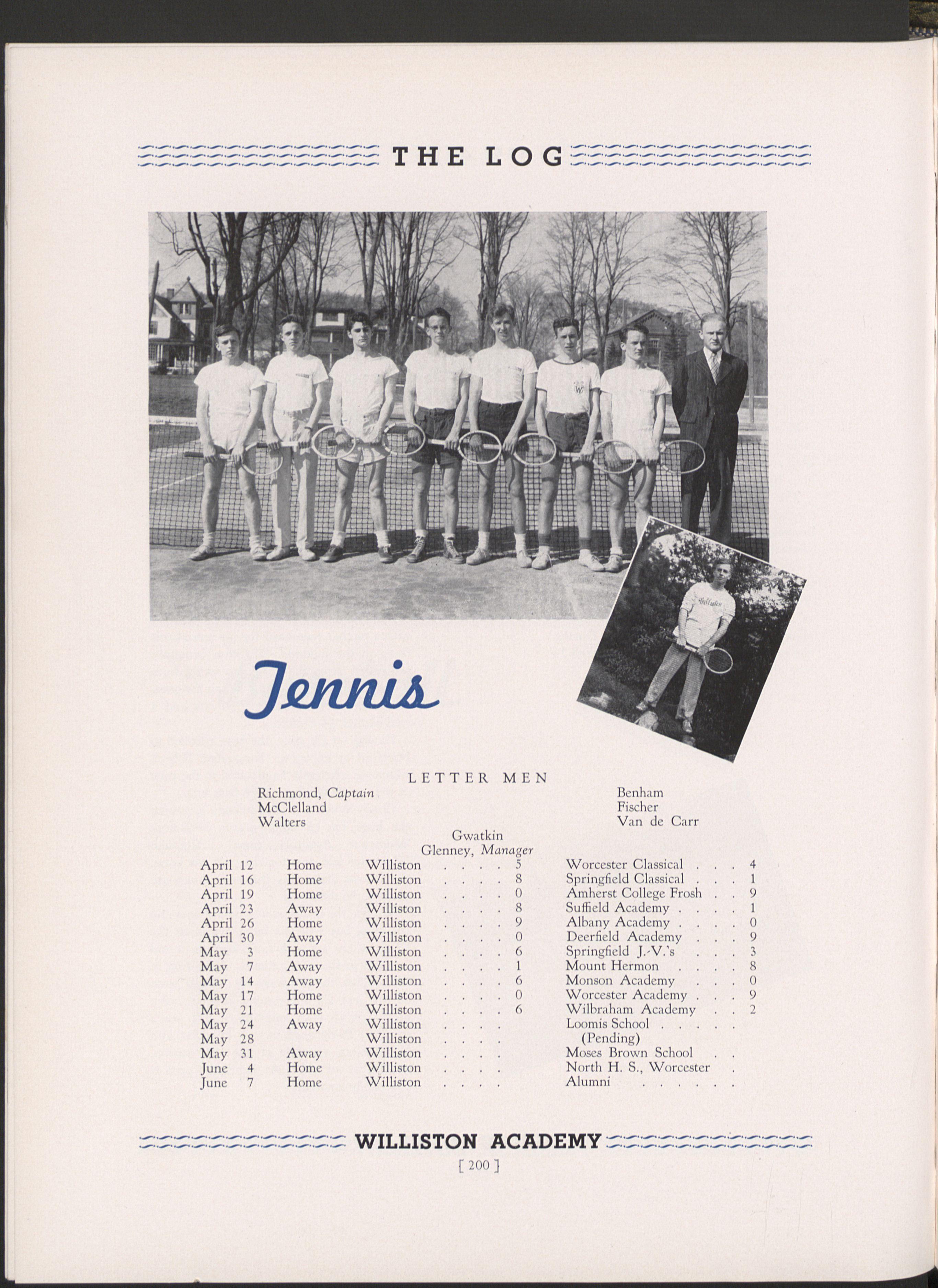
May
May
May
May
June
June
Having four lettermen as a nucleus around which to build, Coach Hepworth has molded a formidable tennis team. Led by a stellar veteran, Captain Clark Richmond, the team has won five out of their first seven matches. McClelland, Walter, G. Benham, F. Fischer, Van de Carr, and Gwatkin compose the rest of the squad. Bill Glenney is the able manager.
The season opened with a hard-fought 5-4 victory over Worcester Classical High. Next on the list was Springfield Classical by the score of 8-1. The team was then overpowered by a splendid Amherst Frosh team by a 9-0 score. Coming back strong, the racket wielders defeated Suffield and Albany by the scores of 8-1 and 9-0. Coach Hepworth took his players to Deerfield, where they were overwhelmed by 9-0 score. The following Saturday the squad avenged itself by defeating a strong Springfield College Frosh team by a 6-3 score. With this splendid start it is very probable that 1941 will he a victorious season.

Captain Richmond, much improved over last year, has held down the number 1 position with case. McClelland, Van de Carr, and Benham,three much-improved veterans, have maintained their high standard of play. Walter, a newcomer, has proved his worth as a singles and doubles player. Fischer and Gwatkin, members of last year's second team, have greatly improved, winning a majority of their matches.
As this edition goes to press, the future looks far better than just plain bright. As the record so far shows, the boys have really made a name for themselves and for the team. For this reason, we predict an ending for the 1940 tennis squad which will be just as successful, if not more so, than the beginning has been.
Next year Coaches Hepworth, Lossone, Smith, and Baird will have to build anew, as the entire first team is composed of Seniors. But with the proper luck,"Heppie" and his cohorts can and will build a team worthy of the name Williston.
Hart, Co-Captain
Brautigam
Howe
S. Brown
Ring
Ladd
Van Cott
Miquelle
April 26 Here
May 3 Here
May 7 Here
May 17 There
May 24 at Loomis
May 30

LETTER MEN (Partial List)
Buckingham, Co-Captain
Spaulding
Williams
MacNaughton
Gibbons
Alpert
Camp
Kingsbury
N. Smith, Manager
Williston
Williston
Williston
Williston
Williston
Williston . 1051/2 62 60 23
Albany Academy 161 / 2
Mass. State Frosh • 51
S Suffield 16 / Wilbraham 41
Vermont Academy S Deerfield 551 / 2 / Loomis 331/2
Mt. Hermon Interscholastics
The 1941 track season started with only a few hold-overs from last year's undefeated squad. But there were quite a few newcomers who showed considerable promise and thus far have proved their ability. Among these arc Camp, Alpert, Howe, Ladd, Van Cott, and Kingsbury, all of whom showed up well in the Kennedy meet. Buckingham won the high scorer's medal in this meet, which showed good promise for the future season.
The team's first taste of outside competition was with Albany Academy. In this meet, which was a walk-away for the Blue and Gold, Williston scored 1051 / 2points to Albany's mere 101 / 2. Captain Hart scored two first places, one in the hundred-yard dash, and one in the two-hundred-twentyyard dash, while Captain Buckingham ran a 4:55.4 mile, which is excellent for the first meet. Williston captured every first place and won the relay.
The team encountered some real competition in the next meet with the Mass. State Freshmen and won by a score of 62-51. In this meet Howe garnered 11 points, winning the high jump and the javelin and placing third in the discus. Brown tied for first in the pole vault at 10 feet and also took second place in the shot put. MacNaughton won both hurdles with ease.
1 9 4 1

Four days later the team won a triangular meet over Wilbraham and Suffield by a score of 60-41-16 respectively. Jim Mac. Naughton again won both the high and low hurdles. Howe and Kingsbury won the javelin and discus, Brown won the pole vault, Buckingham was second in a fast mile, and "Jock" Spaulding took a second in the half mile.
As this edition goes to press, the Blue and Gold squad is after its fourth consecutive win, the prospective victims being Vermont Academy. The following week comes the all-important Williston • Deerfield • Loomis meet, the acid test for our squad. If the two meets are Williston victories, the team should be heartily congratulated. Even if they are not, the coaches, and especially Mr. Putnam, deserve the highest praise for bringing the boys through another great season.

\V. W. Waters Athletic Supervisor, Football, Baseball
F. E. Bell Assistant Athletic Supervisor, Football, Basketball, Baseball
W. J. Lossone Hockey
A. L. Hepworth Tennis
F. L. Putnam Track
H. G. Boardman Soccer
D. D. Test, Jr Soccer, Track
F. B. Hyde Track
R. H. Plumb Football, Track
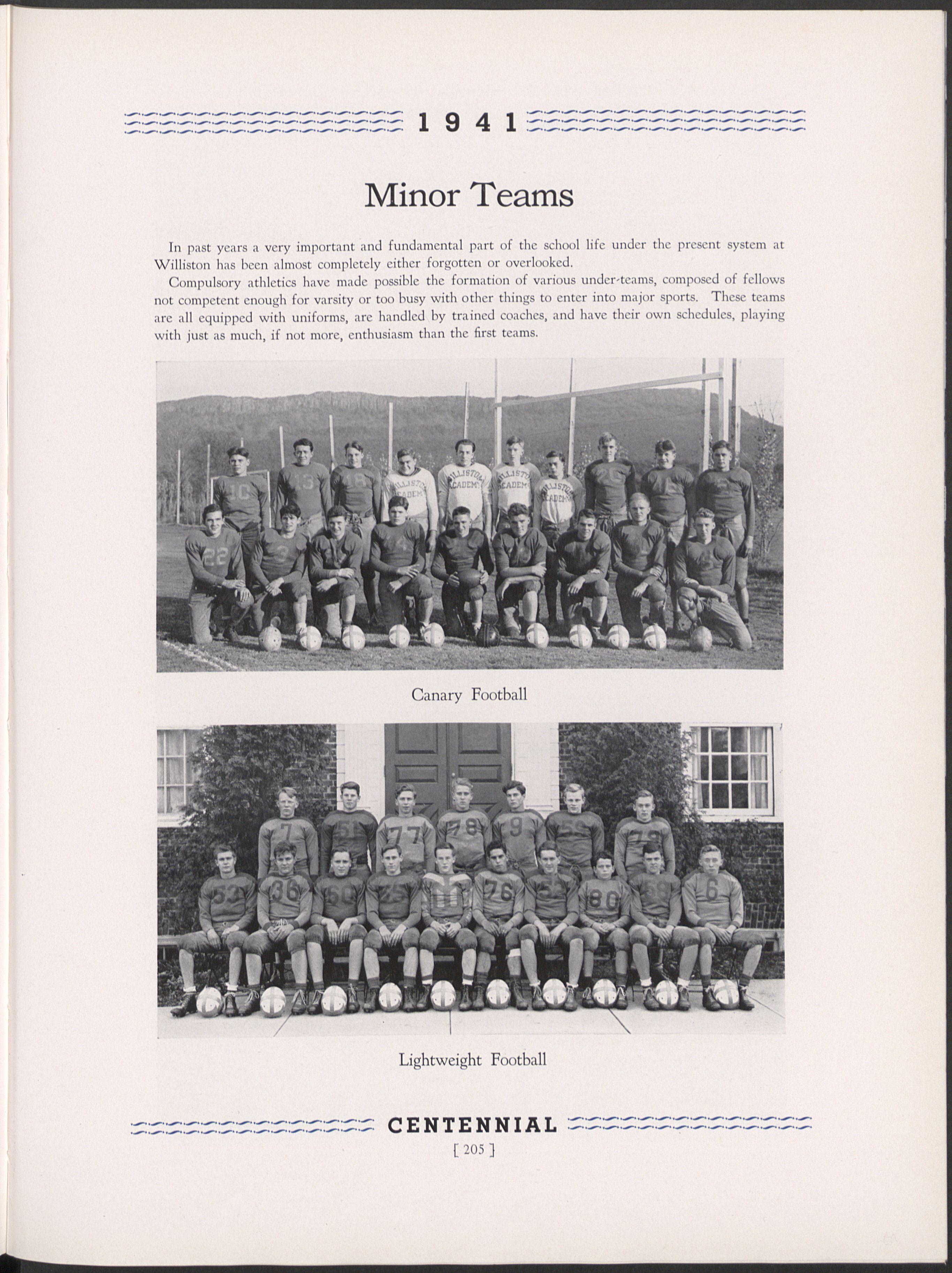
In past years a very important and fundamental part of the school life under the present system at Williston has been almost completely either forgotten or overlooked.
Compulsory athletics have made possible the formation of various under•teams, composed of fellows not competent enough for varsity or too busy with other things to enter into major sports. These teams are all equipped with uniforms, are handled by trained coaches, and have their own schedules, playing with just as much, if not more, enthusiasm than the first teams.

This year, then, it has been decided that under•teams, since they are so valuable to a large number of the fellows in the school, should be presented in a section of their own, so that you may be shown just as much of our school teams as possible.
Although it is impossible here, due to a lack of space, to summarize the records of each of these teams in their individual contests, it should be stated that Williston undenteams, as a whole, continually show a superb record, and for this reason the fellows playing on them deserve a great deal of praise which is usually not meted out to them.
Assuring every fellow in school a chance to enter into athletics, these nine different squads play at various times during their respective seasons. They arc, namely: Canary Football, Lightweight Football, Fencebuster Soccers, Tong Basketball, League Basketball, Special Exercise, Canary Hockey, Second Tennis, Canary Baseball, and Lightweight Baseball.
Also at this time, perhaps, should be mentioned the intendormitory contests held in the spring each year, and participated in by every student. This is a contest between the four dormitories for a large banner which is presented to the winning dorm.


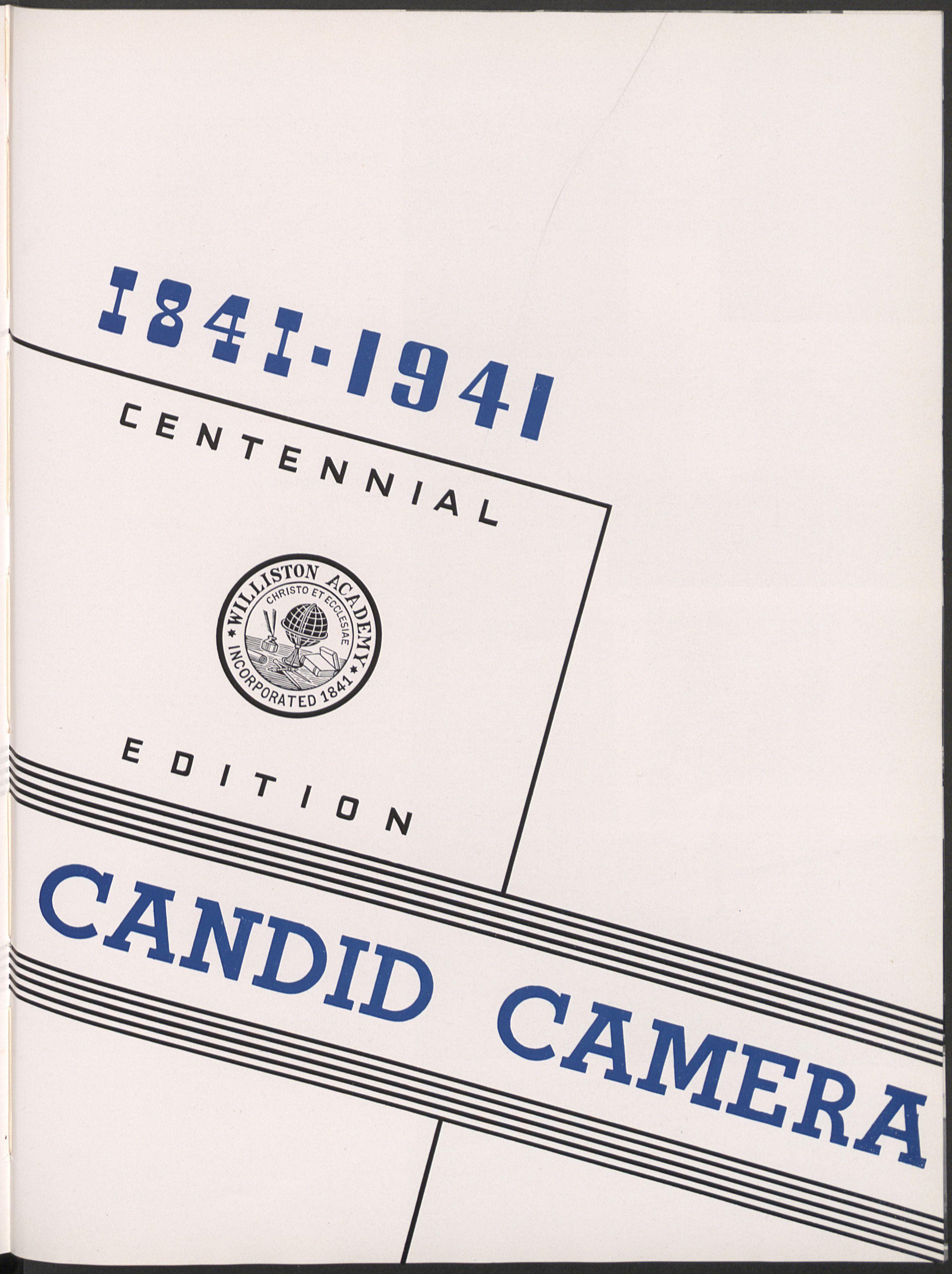


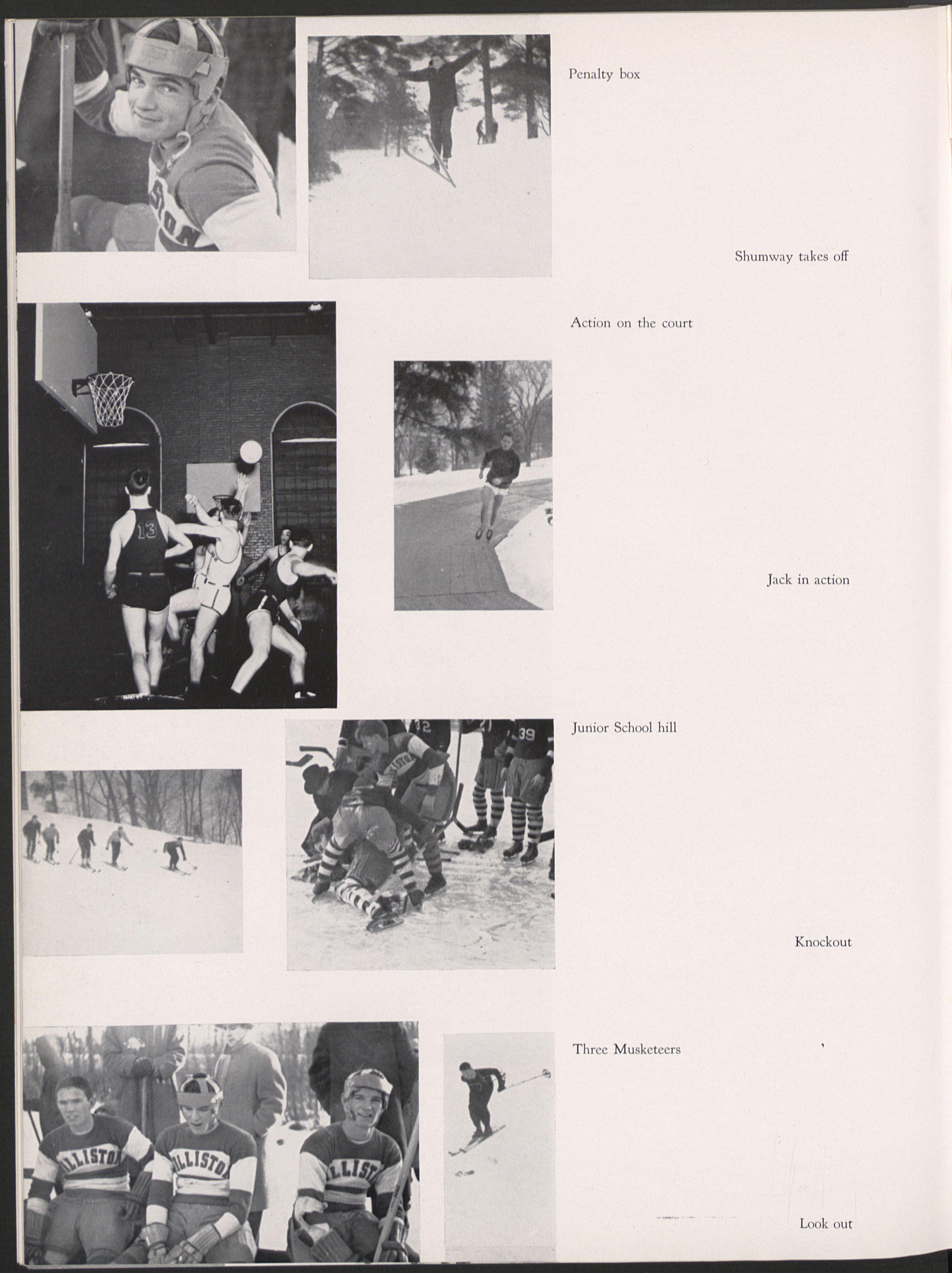
Mathematical interest

Disappointment
Nothing today
Must be interesting
All-stirs

Oh, yeah!
Daily jaunt
The Captain speaks
Why we wanted the flu!
Pre•centennial Dinner

Beauties(?)
Dud(e)s
Monday night at 8
With electric eye

Hot competition
Developing Cholesterol ueen"
Anxiety
See Mrs. Browne
Sunny South
Deep thought(?)
The women
Monty rolls the log
Hold that line
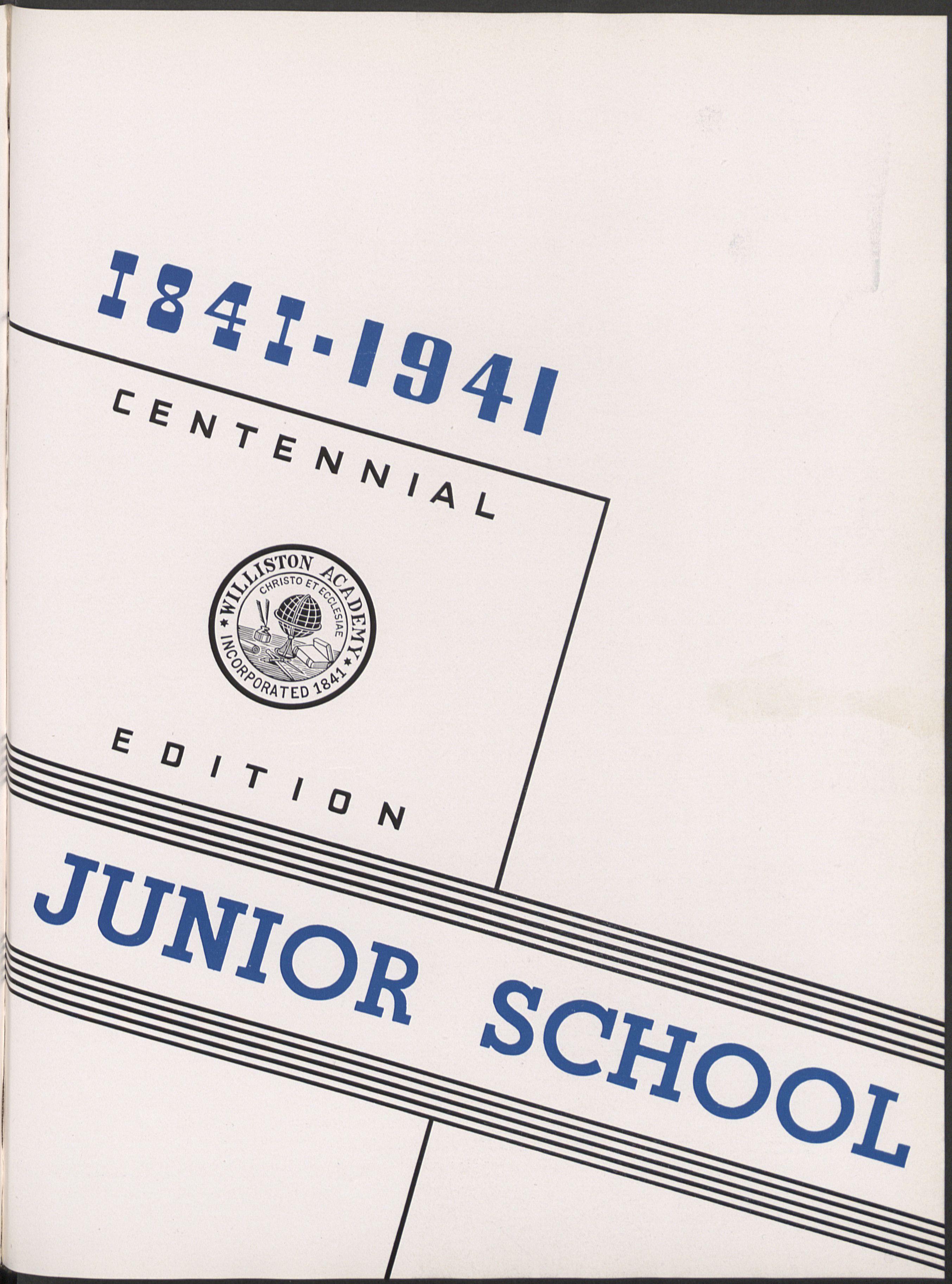

Until 1916, Payson Hall, formerly Hill's Mansion House, had been used as a dormitory for the students of Williston Academy. In that year, however, Mr. John Howard Ford donated a large amount of money to the school so that a new dormitory might be erected. The boys formerly residing in Payson Hall occupied this new dormitory. Inasmuch as there was an extra building, Mr. Sawyer, the headmaster, founded the Williston Junior School as an experiment in order to occupy Payson Hall.
Mr. McAllister, A.B., a graduate of Amherst College in 1898, was appointed as the headmaster of the Junior School in 1916. Payson Hall was divided into three sections—the infirmary, the classrooms, and the sleeping quarters. There was also a room set aside for the visitors. Mr. McAllister remained with the Junior School for two years, at which time Mr. Robert B. Cunningham was appointed.
Mr. Cunningham received his A.B. degree at Lafayette in 1902 and six years later he received his A.M. degree at the University of Pennsylvania. Mrs. Cunningham also joined the school as a music teacher. In 1928 the school had almost doubled its enrollment due to the fact that a new dormitory, the Williston Cottage, became part of the institution. This new dormitory could accommodate ten boys. Mr. Edward R. Clare, a student at Trinity, was elected to Williston as the active master of the Cottage. In the following year, moreover, a new house, holding thirteen students, became the Williston Cottage II; the name was later changed to Sawyer House in honor of the founder of the school. The Junior School then forfeited Payson Hall to the expanding Academy in order that the latter might use it as a dining-room and a dormitory with the Junior School sharing the dining hall. A small schoolhouse was built back of the Cottage so that the grounds might be complete. The new campus is well situated on the top of a small hill, which is used for skiing in the winter.
Mr. Edward R. Clare was appointed as headmaster of the Junior School in 1937 and has served ever since. Recently the dormitories were expanded in order to accommodate thirty boys. An extra classroom was also added to the quaint schoolhouse. The Junior School has been spontaneous in its growth ever since it was founded and will continue to expand through the coming years, as its present enrollment of more than forty boys proves.

The Williston Junior School, an entirely separate unit from the Academy, prepares the attending students for Williston and other preparatory schools. The school has its own headmaster, Mr. Edward Clare, under whose able guidance the boys, ranging from ten to fifteen years of age, are prepared for future education. The Junior School is, however, under the supervision of Mr. Galbraith and the Williston Board of Trustees.
The Junior School uses Payson Hall, dining hall of the upper school, as its eating place, and it also has the use of the Williston Recreation Center. Baseball, football, soccer, basketball, hockey, and skiing take up a goodly portion of the life of a Junior School student. On Thursdays the boys attend a dancing school held in the Recreation Center. At the end of the school year a semi-formal dance is held for the enjoyment of the boys. The Junior School has its own class rooms and work shop in which many hours are whiled away.
It is indeed true to say that a Junior School graduate will make a success of himself in the upper school, for he has received the training so necessary for one to get ahead in school and in the life yet to come.
Intent

A study in Aerodynamics
Watching the game
Batter out!

ARCHIBALD VICTOR GALBRAITH, A.B. Harvard; Elected 1919
EDWARD RICHMOND CLARE . Trinity College; Elected 1925
DAVID TURNER DEANE, B.S. Bowdoin; Elected 1938
JOHN ALEXANDER JOHNSTON, B.A. University of South; Elected 1939
ELLIOTT EARL BABB, B.S. Springfield College; Elected 1940
LEONARD FORDYCE SWIFT, M.A. Harvard; Elected 1940
MRS. E. R.CLARE,B.A. . Smith
HARRY C. DURYEE
MRS. E. R. CLARE . .
MR. AND MRS. MATTHEW MOONEY
Allen, Covington Barnard, Robert Fuller Browne, Clement George Burt, Stuart Edward Chase, Ralph Westcott Curtis, James Harvey, Jr. Dembinski, Jan Adrzag Eaton, Gregory Stone Erickson, Howard Nyman Foster, Peter . Groden, Eugene, Jr. Groden, Gerald Hazen, Henry Andreas Jackson, Winslow Loring Lazzerin, Robert Paul Long, Richard Dale Loomis,John McLanahan McConnell, Archie McConnell, James Richmond Martin, Stanley Burr Mason, Jeremy Eldridge O'Connor, James Richard . Poillon, John Jacob, 3rd Powers, James Sherwood . Pratt, Stewart Marquand, Jr. Randall, Burton Ellsworth, Jr. Robins, Edward George . Roorbach, George Brett Rouse, Robert Sumner Seiler, John Andrew Shaw, Gerald Leonard Shaw, Robert Murray Steiger, Ralph Allen, 2nd Steiner, Paul Miller . Turner, James Charles Robin Whiting, George Fowler Willard, Roger Henry Wood,Theodore Crane, 3rd

. Director
Headmaster, English, Latin Mathematics
English, French . Science,
Social Studies, Music
. Housemother
Manual Training Drawing Dancing
Holyoke, Mass.
. Worcester, Mass. New York, N. Y. Westport, Mass. Saylesville, R. I.
. Worcester, Mass. New York, N. Y. Belmont, Mass. Brooklyn, N. Y.
. Westboro, Mass. Medford, Mass.
. Medford, Mass. Milton-on-Hudson, N. Y.
. . . Chicago, Ill.
. Stafford Springs, Conn.
. Farnams, Mass.
. Lenox, Mass. Northampton, Mass. Northampton, Mass.
. Holyoke, Mass. Greens Farms, Conn.
. Boston, Mass.
. New York, N. Y.
West Springfield, Mass.
. . Brooklyn, N. Y. Easthampton, Mass.
. New York, N. Y.
. Cambridge, Mass.
. Easthampton, Mass.
. Newton Centre, Mass.
• New York, N. Y. New York, N. Y.
. Springfield, Mass. New York, N. Y.
. Cambridge, England Holyoke, Mass.
. Worcester, Mass. Mamaroneck, N. Y.

In preparation for a bigger and better "Log" for the celebration of our centennial, the"Log" board of 1938 hit upon the idea of producing and selling a Williston pictorial calendar, the funds of which to go towards this year's book.
This plan has proved so successful that at the present time a total sum of three hundred and twenty, five dollars has been raised, this amount including the money brought in from the sale of the 1941 calendars.
As members of the centennial "Log" board, we wish to thank all those who have had any part in the raising of this fund, which is being used, we believe, to good advantage in our book. We are deeply appreciative of the effort through which this sum was made possible, and we hope that the fruits of your labor may he shown in a ripened state in the 1941 "Log."
MR.AND MRS.JAMES ADAM
MR. AND MRS. CHARLES A.ANDERSON
MR.AND MRS.HUGH A.ARNOLD
MR. AND MRS. MAURICE W.AVERY
MR.AND MRS. MAURICE S. BAILEY
MR.AND MRS. MASON BARNARD
MR.AND MRS. CHARLES BENHAM
MR.AND MRS. GEORGE S. BENHAM
MR. AND MRS. GEORGE K. BERNHARD
MRS. ELIZABETH S. BOSWORTH
MR.ROBERT H.BRAUTIGAM
MRS. MARGUERITE BROWN
MR.AND MRS. GORDON CAMERON
MR.AND MRS.HARRY U.CAMP
MR.AND MRS.HERBERT A.CARD
MR.AND MRS.JAMES E. CARROLL
DR. AND MRS. MORTIMER T.CAVANAUGH
MR. AND MRS.JAMES H.COBURN
DR. AND MRS.JOSEPH E. COLEMAN
MR.AND MRS.JOHN J. COSTELLO
MRS. CHARLOTTE C.COWAN
REV. AND MRS.BRUCE W.CRONMILLER
DR.ELDON L. CROWELL
MRS. GEORGE L. CURRAN
PRES. HERBERT DAVIS
MR. AND MRS. GEORGE H.DAVIS
MRS. EUGENE B.DENNISTON
MR.ROY R.DENSLOW
MR.AND MRS.EDWARD L.DIAMOND
MR.AND MRS.CLAUDE E. DOUGLAS
DR. AND MRS. A.J. DOUGLAS
MR.AND MRS. NATHANIEN B. DUN BAR
MR. AND MRS.JOSEPH H.ELY
DR. AND MRS. MICHAEL EPSTEIN
MR. AND MRS. ALEXANDER T. GALBRAITH
MR.GEORGE E. GARRETSON
MR.AND MRS.EDWIN A.GEORGI
MR. AND MRS.PHILIP W.GRIDLEY
MRS. B. M.HARRIS
MR. AND MRS.DON M.HAWLEY

REV. AND MRS. WALLACE HAYES
MR.AND MRS. ALFRED M.HESS
MR.R. M.HOLMES
DR. AND MRS. BYRON HOWE
MR. AND MRS. CHARLES G.KEENE
MR.AND MRS.OWEN W.KENNEDY
MRS. ALICE M.KENNEDY
MR.AND MRS. RICHARD G.KNOWLAND
MR. AND MRS.RAYMOND KROHN
MR. AND MRS. WILBUR C.LAMBERT
DR. AND MRS. ARNOLD J. LAPIERRE
JUDGE AND MRS. GEORGE F.LEARY
MR.AND MRS. JAMES F. MCDONALD
MR.AND MRS.SAMUEL MCMILLAN
MR.AND MRS.JAMES H.MACNAUGHTON
MR. AND MRS. R. AMHERST MACARTNEY
MR. AND MRS.HAROLD T. MESSENGER
MR. AND MRS.JOHN C. MONTGOMERY
MR. AND MRS.JOHN M. NEWTON
MR. AND MRS.SAMUEL N.NICHOLLS
MR.AND MRS.HARRY E.PEDEN
MRS. MARION PERKINS
DR. AND MRS. ANDREW PETERS
MR.AND MRS. BASILIO PETRICCA
MR.AND MRS.JOHN C.PICKETT
MR. AND MRS. ALLISON N.PIPER
DR. RICHARD T.POWERS
MR. AND MRS. RUFUS A.PRESCOTT
DR. AND MRS. EDWARD L. RICHARDS
MR. AND MRS.JOSEPH G.RIESMAN
MR. AND MRS.HERBERT F. RYAN
MR. AND MRS. ANTON W.SCHNEIDER
MR.FRANK V.SLACK
MR. AND MRS. WILLIAM F. SPAULDING
MR. AND MRS. MORTON P. TIBBALS
MR. AND MRS. W.RAYMOND TENCH
MR. AND MRS. R.TRYON TYRREL
MR. AND MRS.DONALD B. WHEELER
MR. AND MRS. CARLYLE E. YATES ACADEMY
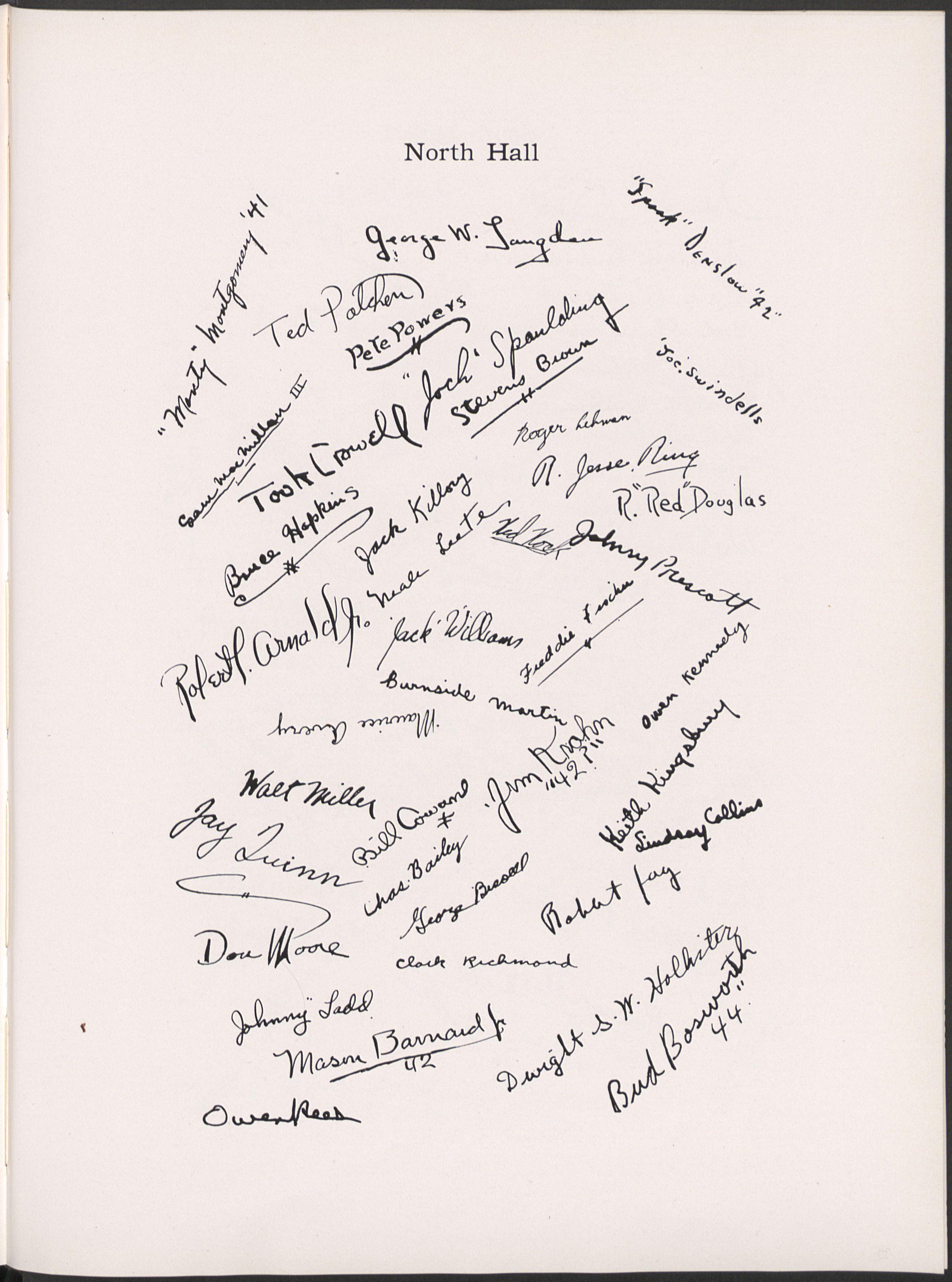
North Hall 6\ / r \11° /6J' a°1/71 6)1M6 el41,,Lc„, 1 Cfe III ILL J4crQ 0_,.81_,J/421,-,

(3 0-6
D.,0,94. Q. fa Jui-9, leCAA-
Pe R c. Cot'e777 AN zidT-trzc41621c_41L44 (&z," rnt
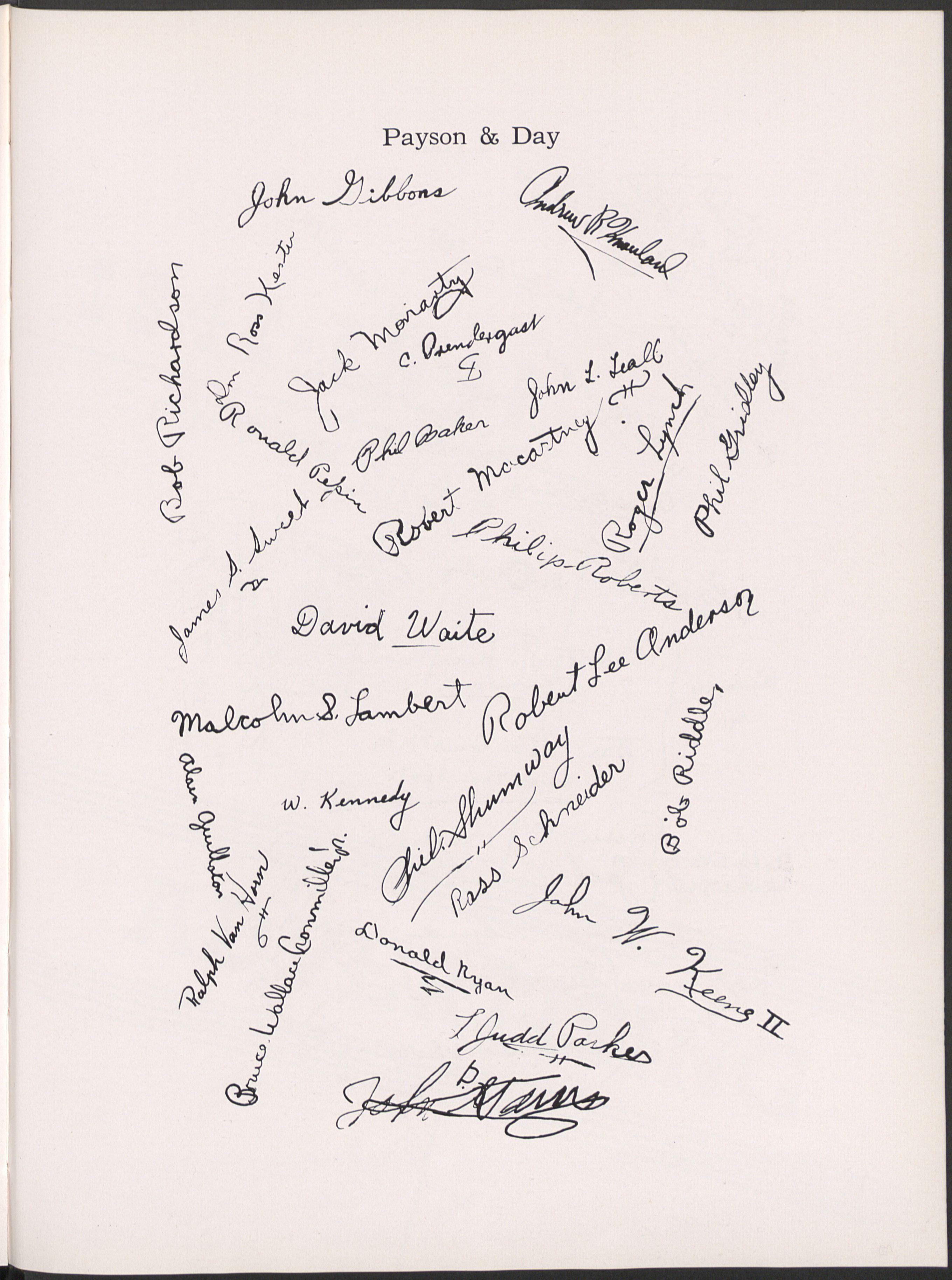
Payson 85 Day
Ford Hall
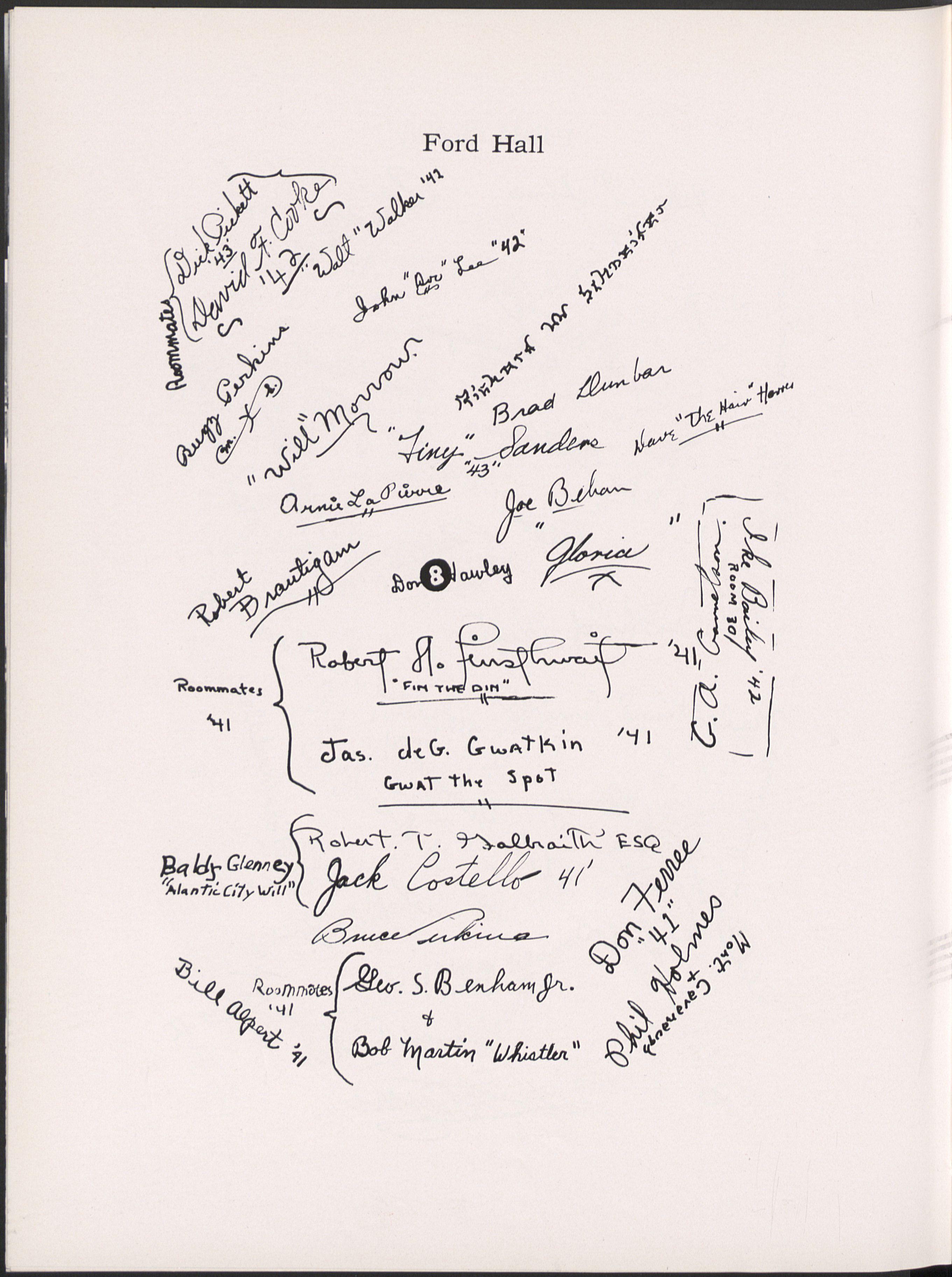
rYt'4' i.Pk0-1/A6vt-r3A, A91 ora-gAeo?t,
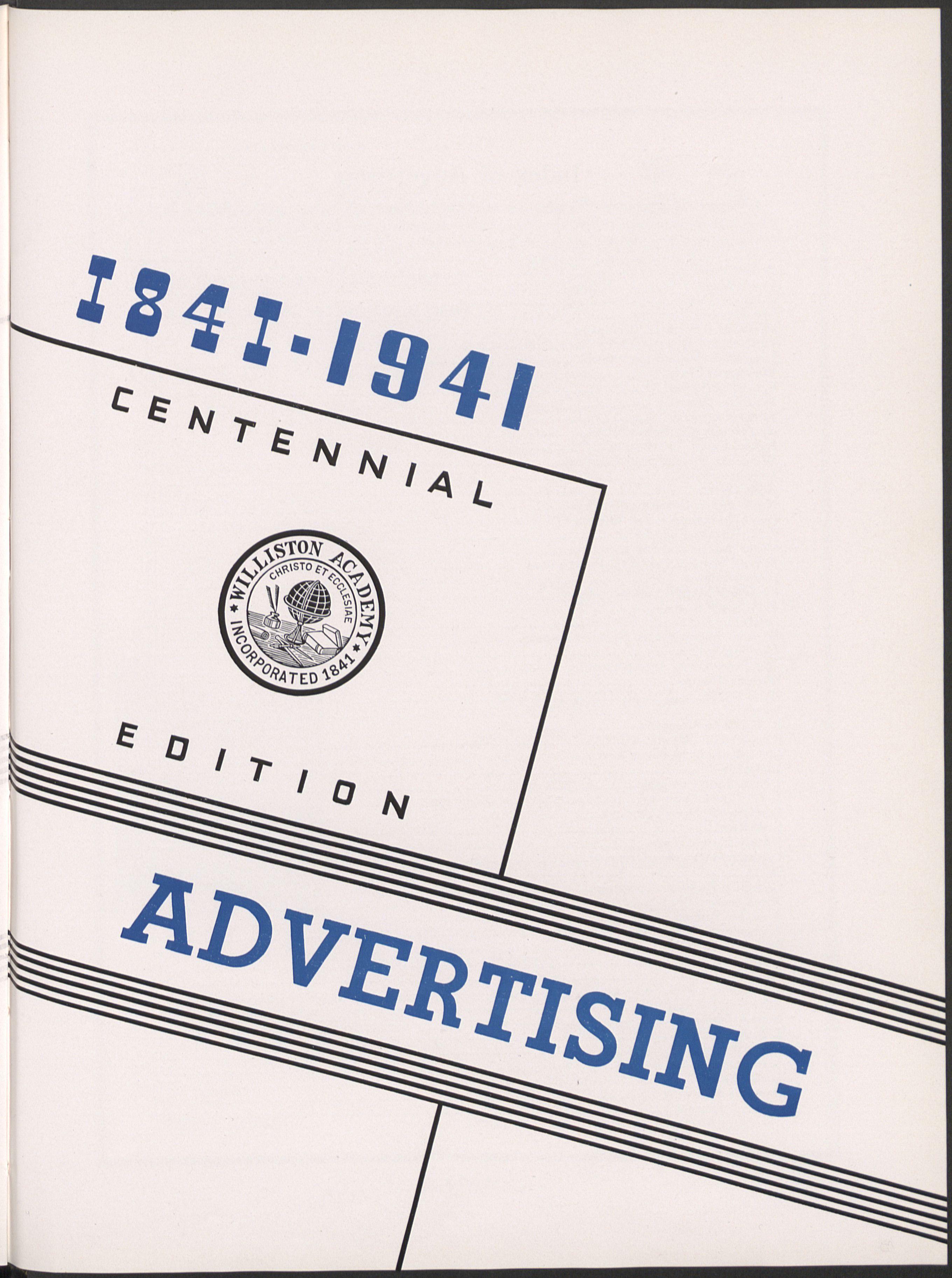
In the following pages numerous business firms have contributed their share in the publication of the "Log." These merchants represent houses of approved standing, and they will merit the patronage of Williston
and the students individually.

E.
Company
R. F. Mutter Company
Beckmann's J.
and Company F. C. Taplin Company
addition to our Clothes and Accessories for Younger Boys
Our Young M en's Department carries Suits up to size 44 at $42 to $52
Odd ackets, Flan nels, Shirts Furnishings, etc. it proportionate prices

BRANCHES Q
NEW YORK: ONE WALL STREET
BOSTON: NEWBURY COR. BERKELEY STREET
SODA AND CANDY SHOP
651/2 UNION STREET
Congratulations on the completion of 100 years of educational service.
Founded in 1921 and located on Park Hill, this establishment has expanded to one of the most modern dairies in this vicinity.
The herd consists of 65 head of some of the finest purebred Holsteins in the State. These animals have taken many awards at the Fairs.
In collaboration with these fine animals is a complete modern dairy plant. Our grade A, high quality pasteurized dairy products are widely distributed and always available.
Phone 103,W Visitors Welcome Phone 458-M
Williston students will find it to their advantage to send their laundry to
HOLYOKE • MASS.

Compliments of The
Westfield River Paper Co., Inc.
Compliments of THE EASTHAMPTON BUSINESS
MEN'S ASSOCIATION
EASTHAMPTON . MASS.
MANCHESTER CO.
Hardware and Sporting Goods
69 Union Street
EASTHAMPTON • • MASS.
LANG MOTOR SALES, INC.
DODGE — PLYMOUTH
Expert Repairs on All Makes of Cars
9 Northampton St., Easthampton 84 Maple St., Northampton
F. L. C. McGOWAN
DRUGGIST
Main Street
Easthampton . Mass. 31 years of advertising in the "Log"
[232)
CENTENNIAL YEAR
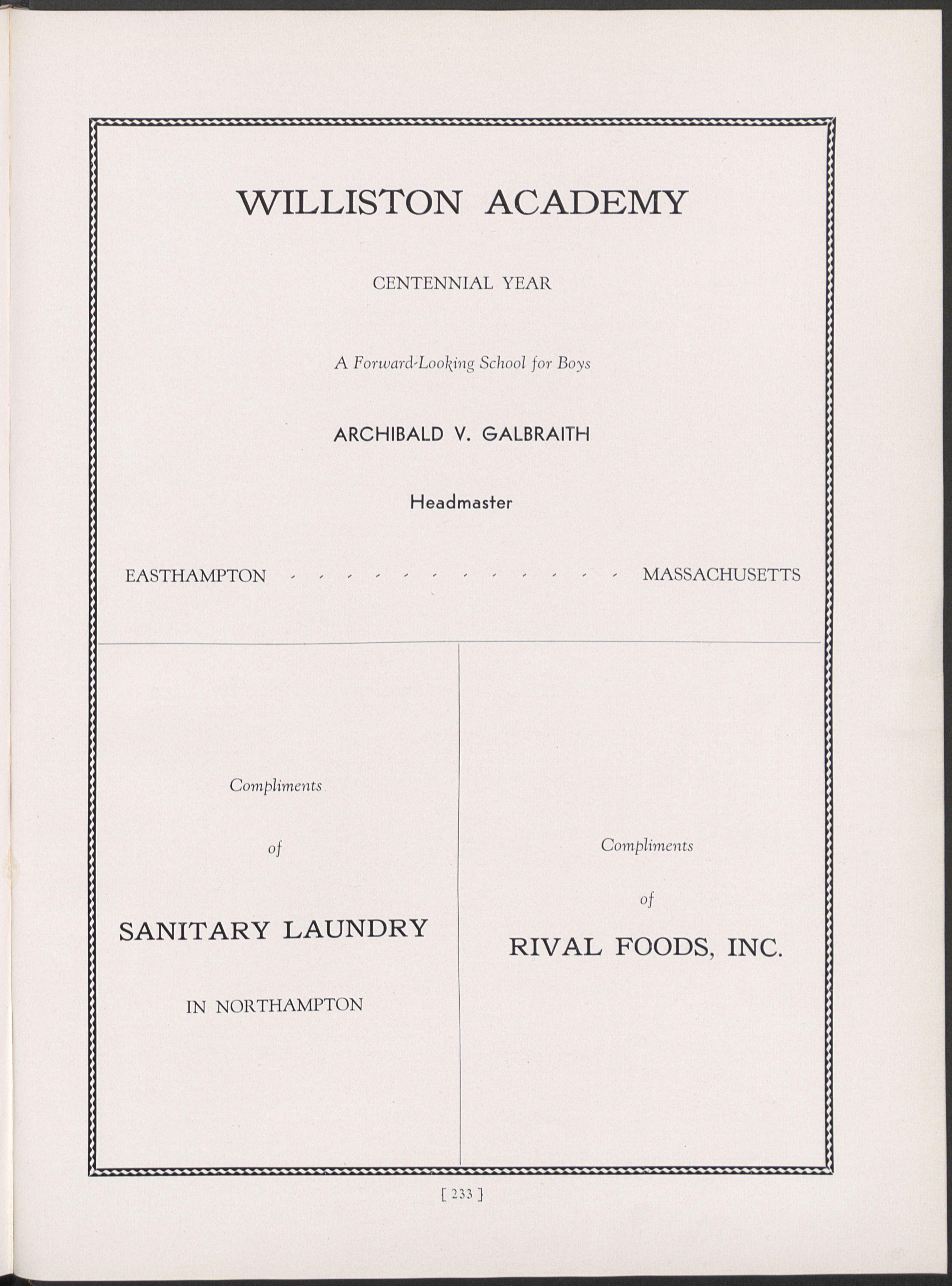
EASTHAMPTON •
A Forward Looking School for Boys
Headmaster
• MASSACHUSETTS
Compliments of
IN NORTHAMPTON
Compliments of RIVAL FOODS, INC. [ 233]
Compliments of .
141 MILK STREET •

Manufacturers of
(Colloidal Paints) • BOSTON, MASS.
With genuine pleasure we offer our congratulations on 100 years of outstanding educational progress to one of our most valued customers: Williston Academy.
Cabot Paint Products used at the Academy include:
DOUBLE-WHITE---
Gloss Collopakes
Pastel Collopakes
Interior Semi-Gloss Collopakcs
Deck and Floor Collopakes Colopake Combiner
SHEET METAL STAMPINGS and COLD ROLLED STRIP STEEL
Worcester Pressed Steel Company
WORCESTER, MASSACHUSETTS
N. B. DUNBAR, Southern New England Sales Representative
Compliments of . . .
Home-way Laundry Service
As one New England institution to another, we are honored to extend our sincere good wishes to Williston Academy on the occasion of its 100th anniversary. May it continue to be true to the best traditions of New England scholarship and education.

46th year --1()t h
Business training was never so essential and so immedi, ately useful, hut the training must he THOROUGH.
NORTHAMPTON COMMERCIAL COLLEGE
-The School of Thoroughness"
John C. Pickett, Principal
Williston '96 — Yale '00
NORTHAMPTON MASSACHUSETTS
Excellent Food
Popular Prices
HOTEL NORTHAMPTON AND WIGGINS OLD TAVERN
NORTHAMPTON, MASS.
"An Inn of Colonial Charm"
125 Modern Fireproof Rooms $2 Up
Guest Parking in Rear by Country Store LEWIS N. WIC;GINS, Landlord
Fall Seeding of Lawns Is Recommended

WOODRUFF'S
Lawn Seeds
Gro-sod Lawn Food
Your Dealer Probably Sells Woodruff's Seeds.
Oliver Walker 85 Son
Established 1870
cm, INSURANCE
REAL ESTATE

NORTHAMPTON •
FELLOWS, GAMAGE CO.
Incorporated
Commission and Wholesale Dealers in Meats, Provisions and Poultry
1 South Street Boston, Mass. Telephone Capitol 4291-4292 - MASSACHUSETTS
PREP MEN! Come to
HAYNES' STUDENT LOUNGE for smarter styles in PREP CLOTHES FOR SPRING AND SUMMER
1502 Main Street Springfield
Kingsbury Manufacturing Co.
KEENE, N. H.
Makers of motor-driven American toys for over fifty years.
E. 0. SMITH SALES CO.
WHOLESALE GROCERS
Distributors of Plee-Zing Grocery Products
Springfield, Mass.
BATCHELDER & SNYDER COMPANY
Producers and Distributors of Fine Foods (0.
Blackstone, North and N. Center Sts. BOSTON • MASSACHUSETTS
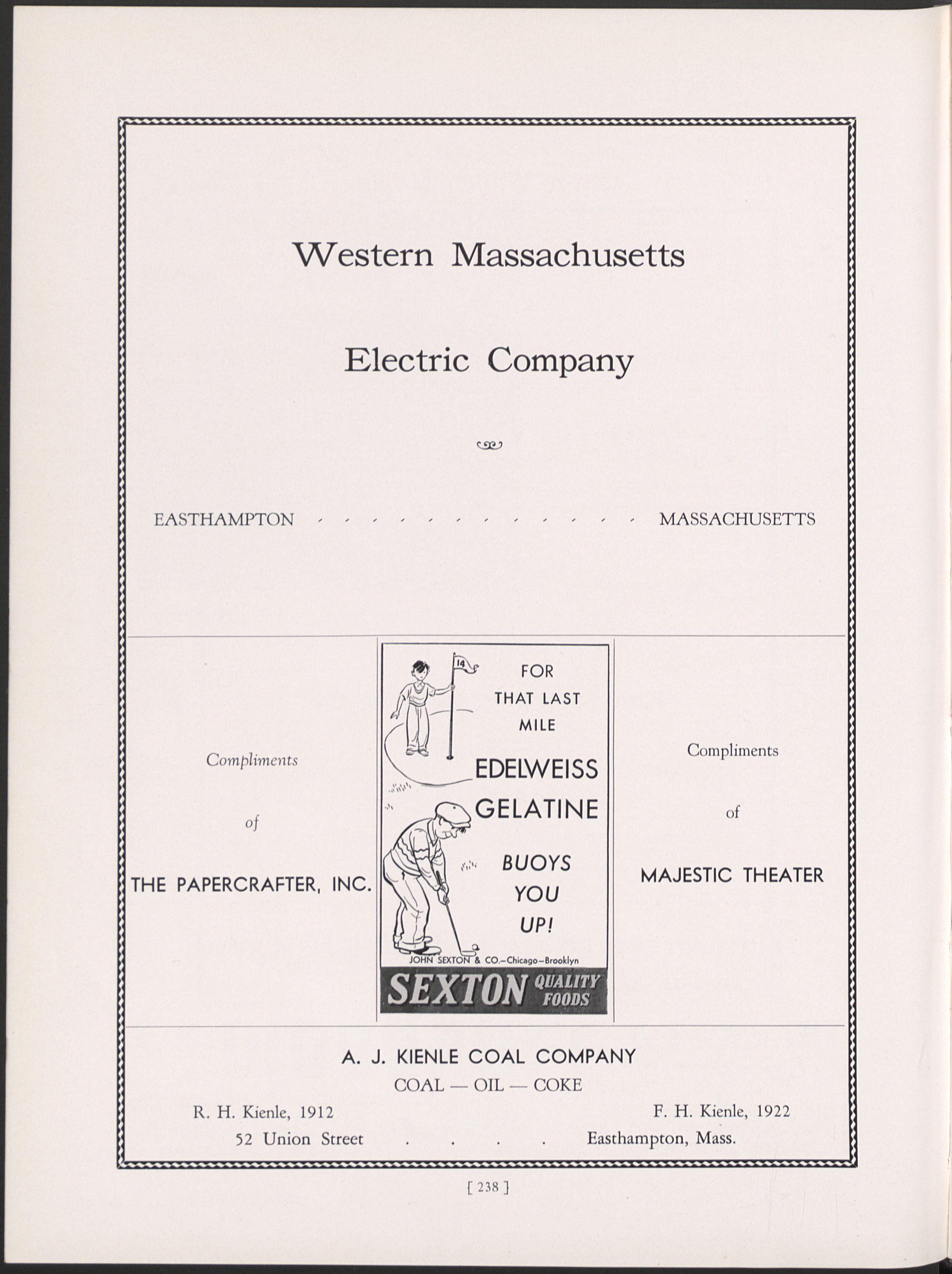
Compliments of THE PAPERCRAFTER, INC.
JOHN SEXTO FOR THAT LAST MILE EDELWEISS GELATINE BUOYS YOU UP! & CO.—Chicago—Brooklyn
Compliments of MAJESTIC THEATER
R. H. Kienle, 1912
A. J. KIENLE COAL COMPANY COAL — OIL — COKE
F. H. Kienle, 1922 52 Union Street Easthampton, Mass.
Good things to cat at . .
LANG'S
95 Main Street
Opposite Williston Academy
Easthampton . Mass.

R. F. MUTTER CO.
GLENWOOD RANGES OIL BURNERS
Oil — Gas — Coal
Plumbing and Heating
•
Phones: Office 481W—Res. 481R
Easthampton • • • Massachusetts
Congratulations to Williston Academy for 100 years of Service to Youth. The Prospect Hill Dairy serves the school with quality milk, and has also served this community for more than 100 years.
Joining with Williston in its Centennial Anniversary. We trust our pleasant associations of the past will continue into the future.
Good things to eat at
BECKMANN'S
NORTHAMPTON, MASS.
Delicious Foods at Reasonable Prices
Candy and Pastry Mailed
J. RUSSELL & CO.
HARDWARE
341 Dwight Street Holyoke, h/1:1,, 239j
GRAVELY TRACTORS, MOWERS AND GARDEN TOOLS
COOPER POWER LAWN MOWERS
DEMING PUMPS AND WATER SYSTEMS
DELCO'LIGHT ELECTRIC PLANTS
472 BRIDGE STREET
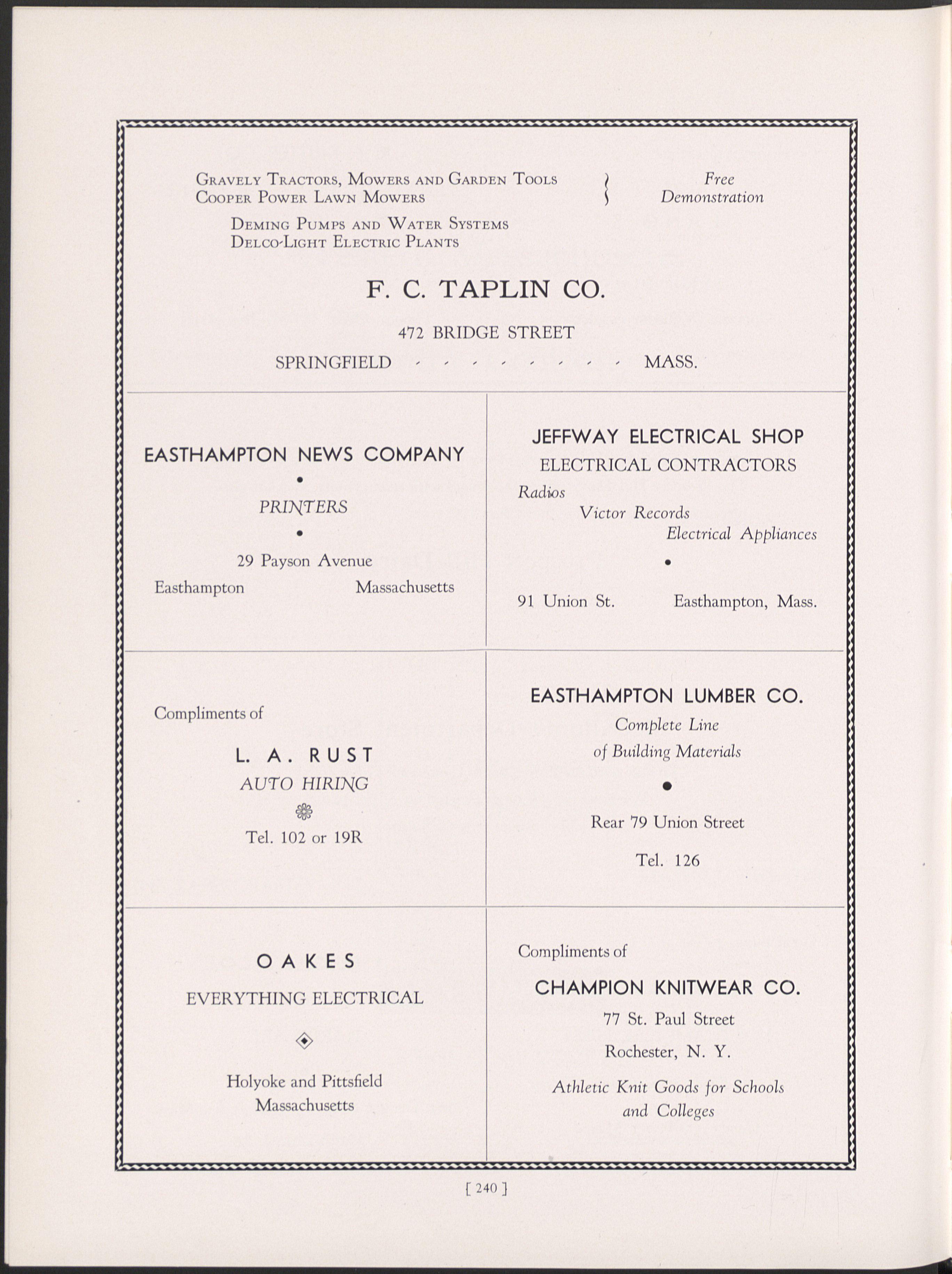
Free Demonstration
SPRINGFIELD • • , , MASS.
EASTHAMPTON NEWS COMPANY
PRINTERS
29 Payson Avenue
Easthampton Massachusetts
Compliments of
L. A. RUST AUTO HIRING
Tel. 102 or 19R
OAKES
EVERYTHING ELECTRICAL
Holyoke and Pittsfield
Massachusetts
JEFFWAY ELECTRICAL SHOP
ELECTRICAL CONTRACTORS
Radios
Victor Records Electrical Appliances •
91 Union St. Easthampton, Mass.
EASTHAMPTON LUMBER CO.
Complete Line of Building Materials •
Rear 79 Union Street Tel. 126
Compliments of CHAMPION KNITWEAR CO.
77 St. Paul Street Rochester, N. Y.
Athletic Knit Goods for Schools and Colleges
THE KRAUSHAR PRESS
205 Main St. (Rear)
Phone 910
NORTHAMPTON, MASS.

Best Wishes
WM. M. RITTASE
PHOTOGRAPHERS
kv"
247 South 15th Street Philadelphia, Pa.
Manufacturers of
Rubber Threads and Elastic Web
Easthampton - Massachusetts
Compliments of FRARY MOTOR COMPANY 51 HOLYOKE STREET
EASTHAMPTON
Compliments of F. R. CLARK CALUMET TEA AND COFFEE CO.
Compliments of
SCHERMERHORN FISH CO.
HOLYOKE • MASS.

ADVERTISING CORPORATION OF AMERICA
Easthampton
Chapel Street
New Haven, Conn.
Compliments of T. E. ADAMS
PLUMBING AND HEATING
151 Park Street Telephone 763
Compliments of THE POMEROY DAIRY
369 MAIN STREET
We Furnish Quality Milk to the Academy [2421
191 Chestnut St.
Sprincifield,Mass.
Color Printing Catalogs., yearBooks
Dbra MailiTterature Commercial Stationery
PRINTERS OF THE LOG"-CENTENNIAL EDITION

COMPLIMENTS
EASTHAMPTON, MASS.
Modern

UP-TO,DATE EQUIPMENT
AGGRESSIVE ORGANIZATION
SERVICE AT YOUR COMMAND
Official photographer to over one hundred and fifty school and college annuals for the year 1941.
Our representative will be glad to call on you.
LE us piclurt y our froduci"

made the three standards of modern plate makinci... $ztyle, Qua/ter and Service..
of the products of +kis
The work necessary in the production of any yearbook is difficult, and our Centennial edition of the "LOG" has shown that it is no exception to the rule. The collecting of material, the writing of all the articles, whether large or small, the uncovering of historical things which were not even known to have existed before, and the actual compilation of the book could never have been accomplished had it not been for the splendid co-operation of many different people, both outside and within the school.
At this time, then, as the book is actually finished and legally published, it is the express wish of the "LOG" Board to give thanks and appreciation to the photographers, the printers, the engravers, the patrons, the advertisers, and to all others who have in any way assisted us in making the 1941 Centennial "LOG" a successful venture.






